Dragon Warriors by Traveller
Introduction
Original SA postDer Waffle Mous posted:
That really makes me think of the Elite games.
Especially the wedge-shaped trading ships.
The default Commander name in Elite was the name of the sample character in the chargen section. The trade goods also come from Traveller.
And, since InShaneee already got to Delta Green, this frees me to do:
Dragon Warriors: Book 1
Dragon Warriors!
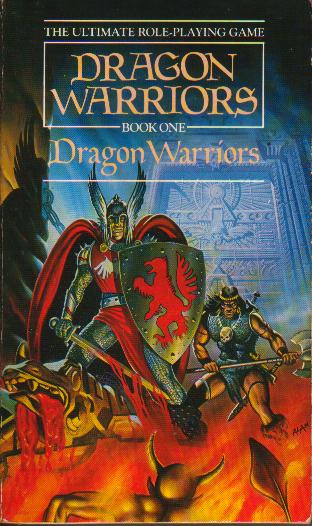
What happened to winged helmets? They used to be all the rage. Also, if you have the newer edition, pay attention to the skull.
Dragon Warriors (no relation to the console games) is a British RPG from the mid-eighties, set in the same world as the Blood Sword multiplayer CYOA books. In this writeup, we'll be covering the original six books by Corgi, not the newer edition by Mongoose/Flaming Cobra/Serpent King/whoever the fuck publishes it now. DW was probably better known in the UK and Australia than in the States, but nonetheless it's still a cool little RPG that could use more exposure. Onwards!
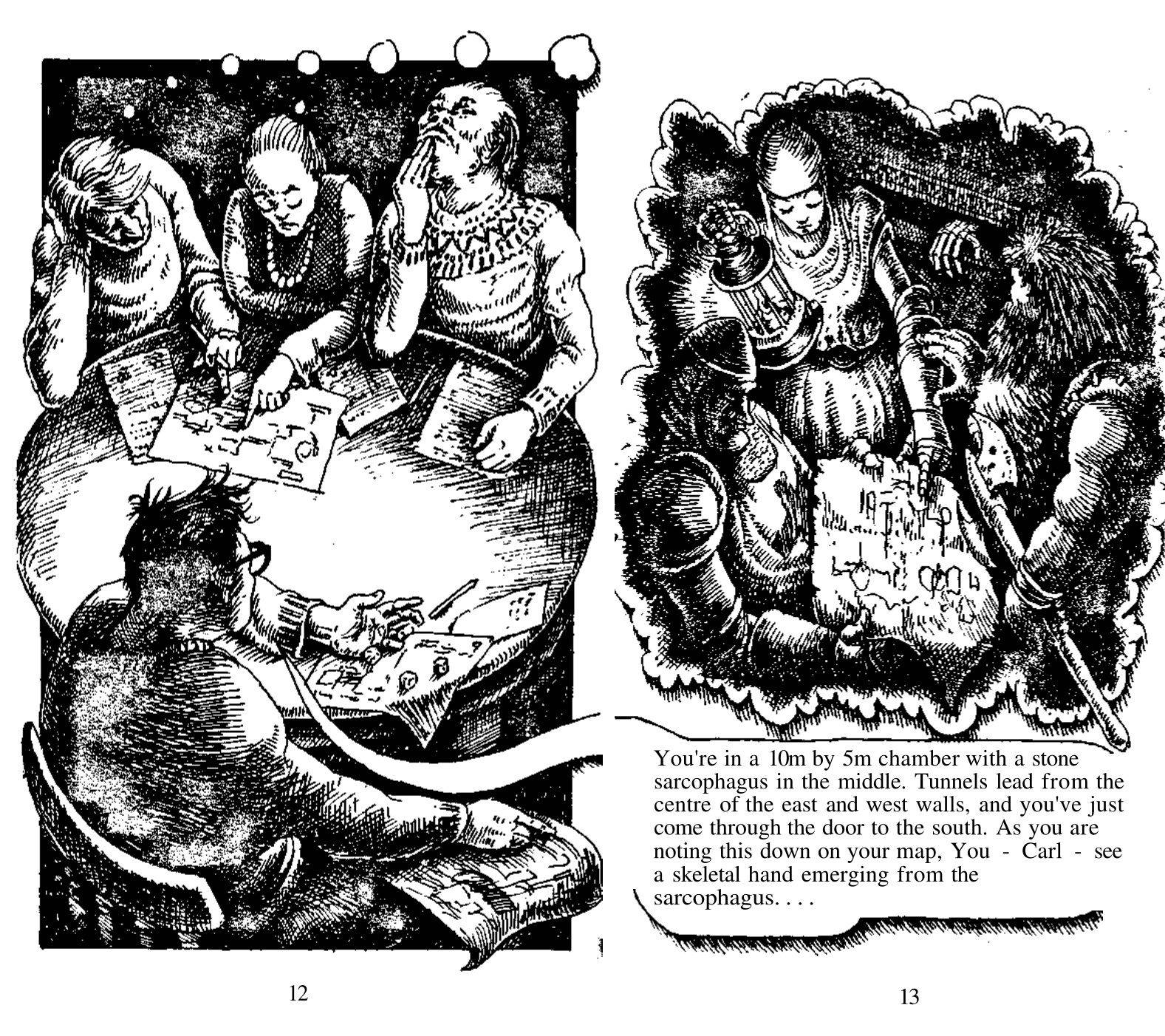
Dig the sweaters.
The system is spread across the six books. The first one, Dragon Warriors , covers the basic rules of the game. It begins with a standard "what is an RPG" section, referencing Tolkien's Mines of Moria sequence in Fellowship of the Ring, then gives us an example of play, where three knights gather at a small shrine. The game world, Legend, is not detailed in full until the final book in the series, but here we can see that it's medieval fantasy Europe of sorts, complete with a knight coming back from the Crusades, very unpleased at one of his new companions for not paying proper respects to the shrine priest ("newfangled gods, not better than the old ones") Fortunately, before PvP may occur, the priest sets them off on a quest! Hopefully the first of many. This section ends with a description of dice and how to order them, including the post address of none other than Games Workshop (back when they were a general supplier of gaming material, I guess). We should also not fret if we can't get the funky dice, as on the back of the book we can find instructions for making spinnerets that will give us the random numbers we need. That's cool!
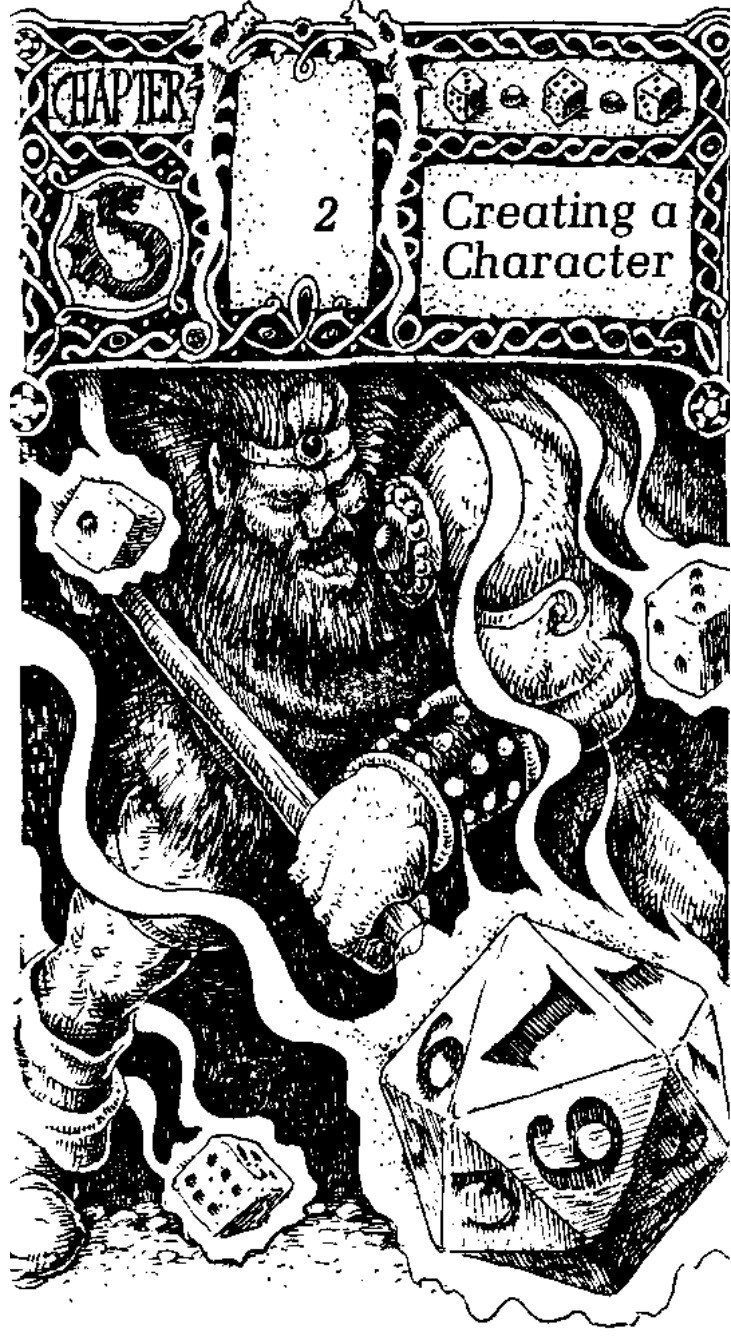
THE POSSESSED POLYHEDRA ARE UPON US
Character creation! As proper RPGs do, we roll 3d6 down the line for each of the five stats: Strength , Reflexes , Intelligence , Psychic Talent and Looks . They're pretty self explanatory, though the game admits that Looks has no real bearing on adventuring skills. It should still be taken into account when dealing with NPCs, of course. Since this is the very first book, only two of the initial four classes are available to us: Knights , all-round fighters able to wear heavy armor without penalties, and Barbarians , not as good in defense but more mobile and able to go berserk. Knights get 1d6+7 Health Points, while Barbarians get 1d6+9. Then, we calculate their combat factors, Attack and Defence (yes, yes, UK spelling): Knights start with an Attack of 13 and a Defence of 7, while Barbarians get one more point of Attack and one less point of Defence. These are further modified by the character's Strength, Reflexes and surprisingly enough Intelligencem though only a real high or real low Intelligence matters in this case. It's interesting to note that while obviously Strength initially helps or hinders only Attack and Reflexes does the same for Defence, getting them very high or low will also end up affecting both stats, so there's a reason to have more rounded characters. Magic also gets analogue combat factors, though since we're only dealing with warriors here only Magic Defence is calculated (base of 3 for both classes), with Psychic Talent and Intelligence being the relevant stats. Evasion starts at 4 for a Knight and 5 for a Barbarian, further modified by Reflexes. Finally, characters start with some gear: Knights get plate armor, a sword or morning star, a shield, a dagger, a lantern and flint-and-tinder, a backpack and 25 Silver Florins, while Barbarians get a suit of chainmail, a battleaxe or two-handed sword, a dagger, a lantern and flint-and-tinder, a backpack and 6d6 Silver Florins. At least they don't start with just their clothes on like some D&D games I could care to mention. Characters made with these rules start at Rank (level) 1, but as the game points out, it doesn't mean they're novices - they've already gone through some adventures and risked their lives already. We are then walked through the generation of a sample character we'll see more of later, Sir Balin the Bloodthirsty, who only has a Strength of 7 despite his nickname. Also, Balin's GM is kind of a dick as when he wants to get a bow, the GM also forces him to buy a freaking quiver for the arrows. Verisimilitude! The chargen chapter ends with a summary of the rules for Knights and Barbarians, handy when you need to get a character up and ready quickly.
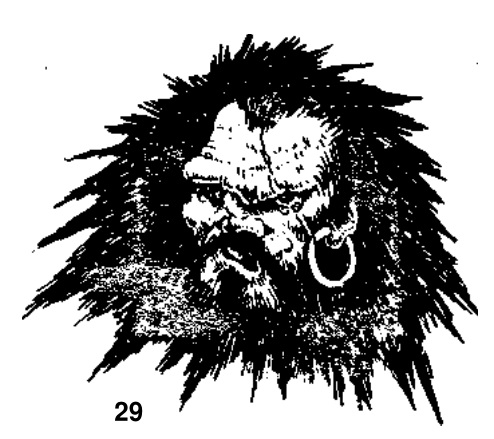
Wanna make something out of it, punk?
Rules! Let's start with combat because, as the book tells us, the rules of combat are the most fundamental part of a fantasy role playing game.
 The basic structure of combat is as follows: first, the attacker substracts their target's Defence from their own Attack, then tries to roll under that in a d20, with a natural 20 being an automatic failure and a 1 being an automatic hit that always gets through armor. Next, they make an
Armour Bypass Roll
: each weapon has an Armour Bypass die they roll, and the attacker must roll higher than the target's Armour Factor in order to deal damage. This means that some weapons have no chance at all of penetrating certain armor except on crits - daggers against plate, for instance. Finally, damage is dealt, and notably enough, damage is fixed per weapon: a sword has an Armor Bypass die of d8 and deals 4 points of damage. Of course, superior Strength will give you bonuses to Armour Bypass and damage, though fortunately the opposite does not occur. Missile combat works similarly, though the target's Defence doesn't enter into it (but see javelins later): instead, there is a list of modifiers added to the to-hit roll depending on lighting, range, whether the target is moving or not, and so on.
Damage
is substracted from HP: at 0, a character is unconscious, and at -3, they're dead. Unconscious characters roll 1d6 every minute (10 combat rounds), waking up on a roll of 1 with only 1 HP. Magic healing is faster, but it's the province of the second book, so here we'll only detail natural healing - the character must rest for four days, then recover a number of HP equal to their Rank every day of rest after that.
The basic structure of combat is as follows: first, the attacker substracts their target's Defence from their own Attack, then tries to roll under that in a d20, with a natural 20 being an automatic failure and a 1 being an automatic hit that always gets through armor. Next, they make an
Armour Bypass Roll
: each weapon has an Armour Bypass die they roll, and the attacker must roll higher than the target's Armour Factor in order to deal damage. This means that some weapons have no chance at all of penetrating certain armor except on crits - daggers against plate, for instance. Finally, damage is dealt, and notably enough, damage is fixed per weapon: a sword has an Armor Bypass die of d8 and deals 4 points of damage. Of course, superior Strength will give you bonuses to Armour Bypass and damage, though fortunately the opposite does not occur. Missile combat works similarly, though the target's Defence doesn't enter into it (but see javelins later): instead, there is a list of modifiers added to the to-hit roll depending on lighting, range, whether the target is moving or not, and so on.
Damage
is substracted from HP: at 0, a character is unconscious, and at -3, they're dead. Unconscious characters roll 1d6 every minute (10 combat rounds), waking up on a roll of 1 with only 1 HP. Magic healing is faster, but it's the province of the second book, so here we'll only detail natural healing - the character must rest for four days, then recover a number of HP equal to their Rank every day of rest after that.
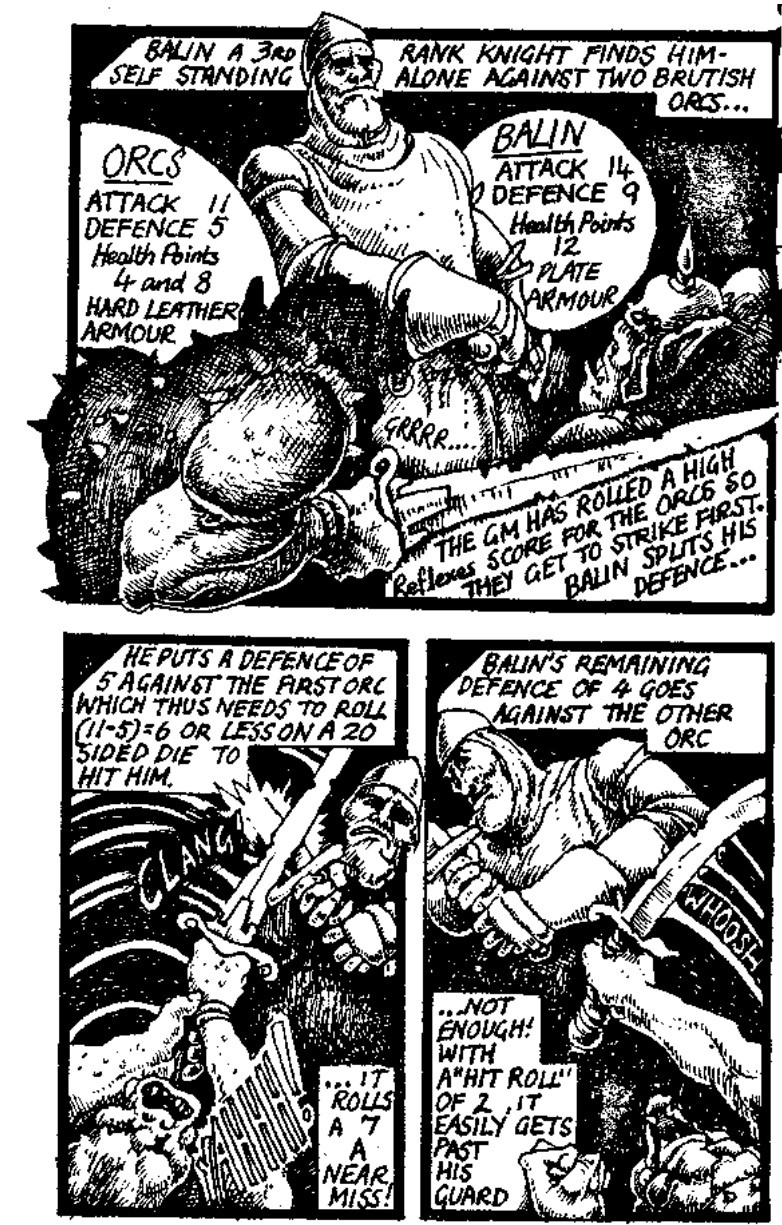
More games need to have comics for their combat examples.
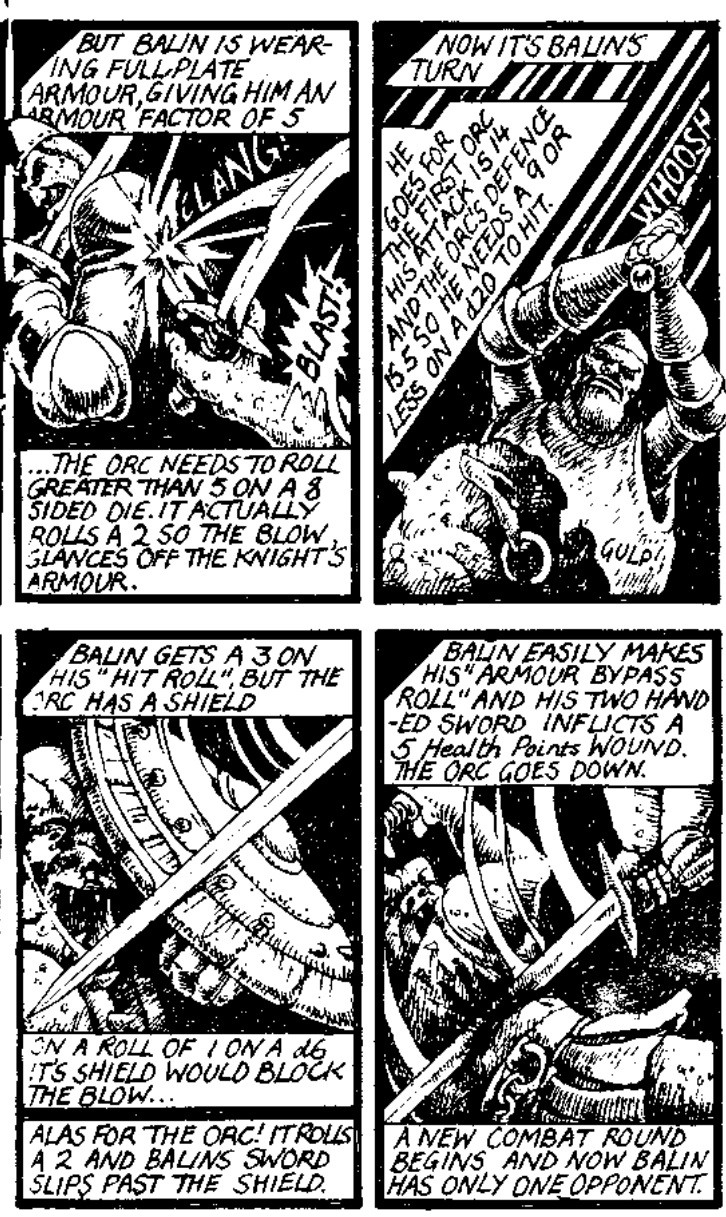

Characters can move 1/4 of their normal combat movement (10 meters for humans) and attack in the same round: when retreating, they can move at the same speed, or just turn and run their full movement (giving enemies a free shot at their unprotected back, with zero Defence) Shields, as the comic showed us above, negate a succesful hit on a roll of 1 in 1d6. If attacked by more than one opponent, characters may divide their Defence between them, up to a maximum of three opponents. Barbarians can also go berserk to improve their chances to hit, giving up three points of Defence per bonus point of Attack. Oh, and don't wear armor if you're not trained for it: characters will accrue penalties to Attack and Defence for armor over their limit. In the case of Barbarians, they get -2 to Attack and Defence for wearing plate. The arcane professions, Sorcerers and Mystics, fare even worse, but we'll see what happens to them in their own book. In combat, characters act in order of Reflexes, with the option to delay an action if the character wishes so, and they get one of the actions mentioned above per round, or anything else they could potentially get done in six seconds. For some reason the game declares that, for instance, unstoppering a potion and drinking it are two separate actions. Why? Because!
Evasion! It's used to dodge traps and certain attacks (like the aforementioned javelins). Like Attack/Defence, Evasion is substracted from the attack's Speed , but again, just because, this roll is made on 2d10 instead of 1d20, with a natural 2 indicating that the attack was successful and a natural 20 indicating that the character managed to dodge. Magic Defence works in a similar manner, substracting it from the spell's Magical Attack , then rolling under it with 2d10.
Experience! Characters need 30 XP to progress in Rank up to Rank 4, after which they need a total of 130 XP (Rank 5), then 200 (Rank 6), 300 (Rank 7), 450 (Rank 8) and 650 (Rank 9), with an extra 250 XP needed for every Rank above that. Knights and Barbarians get the same bonuses upon leveling up: Attack and Defence increase in 1, HP increases in 1 too (and these guys are on the fast track for HP, remember that), Magical Defence increases in 1, and Evasion increases in 1 at 5th Rank, then again at 9th Rank. The other two classes, Sorcerers and Mystics, get +1 to Attack and Defence when they hit 4th Rank, then every three Ranks after that; +1 to HP at 2nd Rank, then every two Ranks after that; +1 to both Magical Attack and Magical Defence every rank, with an extra +1 at 7th and 12th Rank; Evasion works just like with the warrior classes. XP is awarded by surviving adventures (the game suggest 5 XP per adventure survived, up to 10 if it was particularly dangerous), and defeating monsters (1XP per Rank or rank-equivalent of the foe, to be divided among PCs as the GM deems fit). So yeah, progress can be kind of slow.
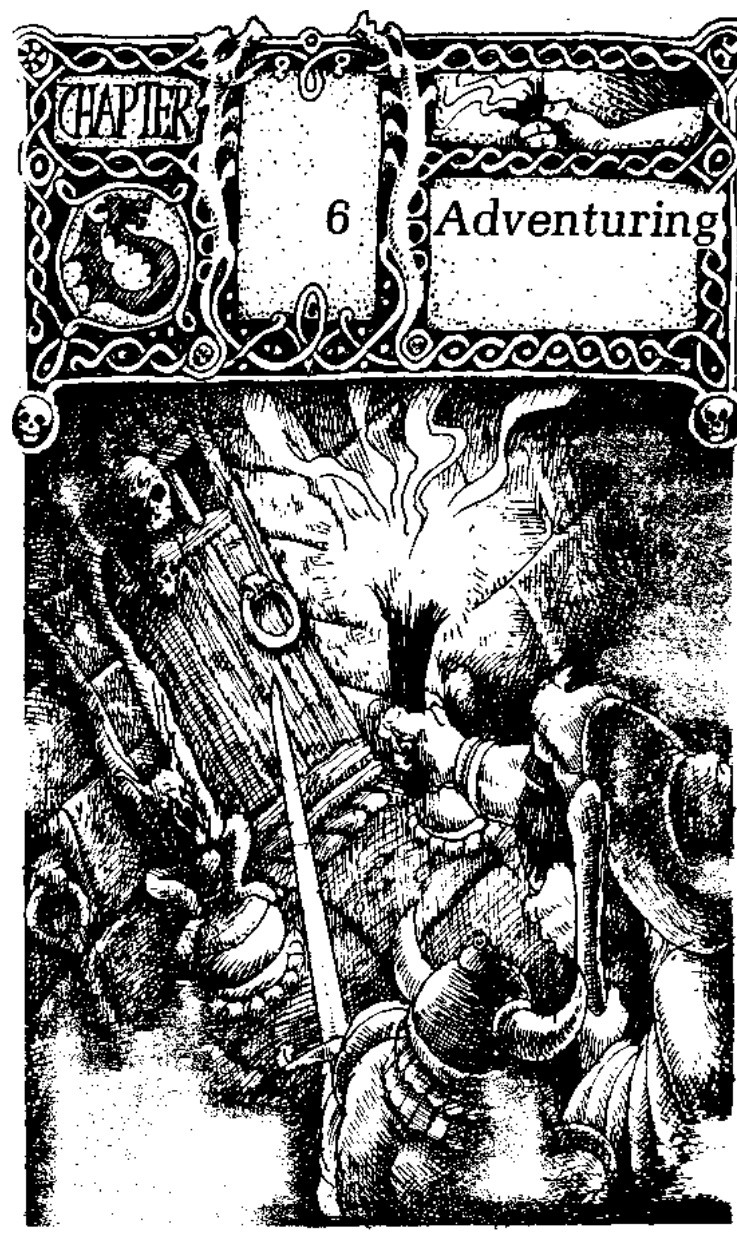
That's not even a torch, that's like, some hay the barbarian found by the road.
Miscellaneous rules! We have lighting rules here, and the fact that everyone starts with a lantern is brought to our attention - as most popular fantasy adventures take place in underworlds, of course! Fighting in the dark carries a penalty of -4 to Attack and -8 to Defence, and most monsters (not to mention all undead) can see in the dark. Monsters can also surprise a party in a roll of 1 in 1d6, though fortunately characters can set up ambushes of their own as well. Surprised characters get no action on the first round, and the ambushers can move up to half their combat move and attack in the same round. Let's see, battle order, escaping from a fight... locked doors! They can be forced open by a character with a Strength of 16+, otherwise the character has to roll under their Strength in 1d20 to succeed. Any attempt, succesful or not, costs 1 HP. Encumbrance! Oh, no... wait. Instead of bothering with specific weights and such, DW simply says that characters may carry up to ten objects roughly equivalent to a weapon in size and weight, modified as appropriate by Strength. Small items don't count against this limit, and neither does worn armor as its encumbrance is covered by the penalties given to characters not trained in its use. We also get some rules on buying stuff, and availability rolls for items based on whether the character is searching for it in a city, town or village. We also get some rules on food and lodging, and here is where the Medieval European setting pops up again: we are told that monasteries won't charge for lodging, but will expect characters to attend services with the monks and help with chores if they stay for a long period of time, and that Sorcerers will rarely be taken in if their profession is made known, as "rightly or wrongly" they are deemed pagans. Climbing , because no RPG is a RPG without climbing rules, works by assigning a difficulty to the climb between 3 and 18: if the character's Reflexes are equal or better than this difficulty, they can perform it automatically, otherwise they have to roll under their Reflexes or fall and take damage. Combining the climbing and locked doors rules gives us the basic stat roll for the game: assign a difficulty between 3 and 18, compare to relevant stat, then roll under it if necessary. Percentile rolls can also be used by the GM if they feel like it: will the orc sentry wake up when the characters try sneaking past him? I don't know, let's give him a 30% chance.
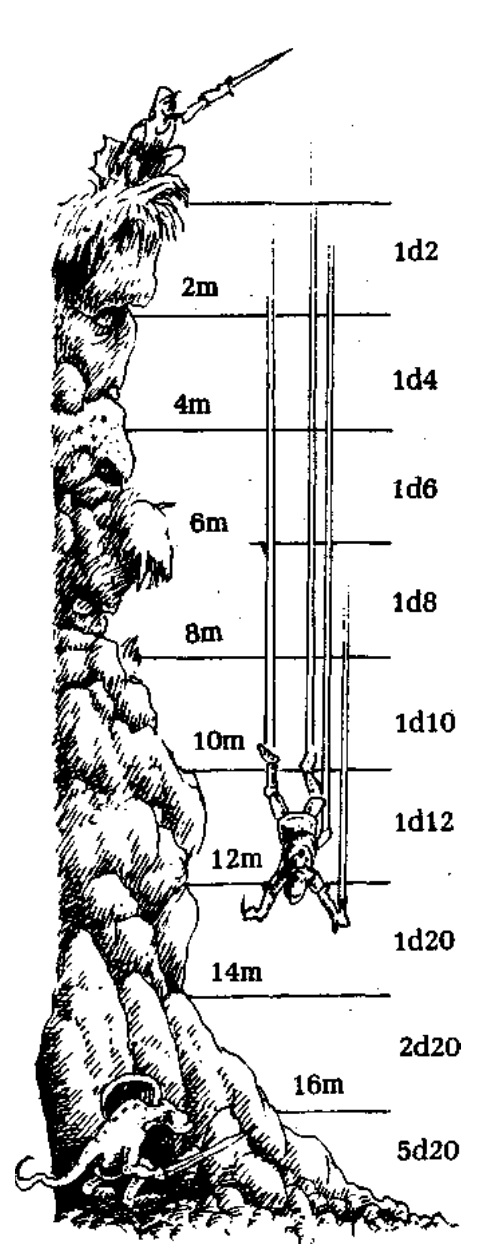
IT KEEPS HAPPENING
Next: dickass birdmen, tactical advice, and King NotArthur.
Over the hills, through the woods
Original SA post Dragon Warriors: Book 1Over the hills, through the woods
Let's move on to the Creatures chapter, shall we? The usual staples are here, orcs and giant spiders and whatnot, so I'll only detail some of the more interesting entries. The general tone of the section is quite Ravenloftian, all murky woods and red eyes in the dark, and does a lot for getting a GM into the DW mindset. Also, GMs should roll 3d6 for each group of monsters characters find in order to determine their Reflexes for combat round order purposes.
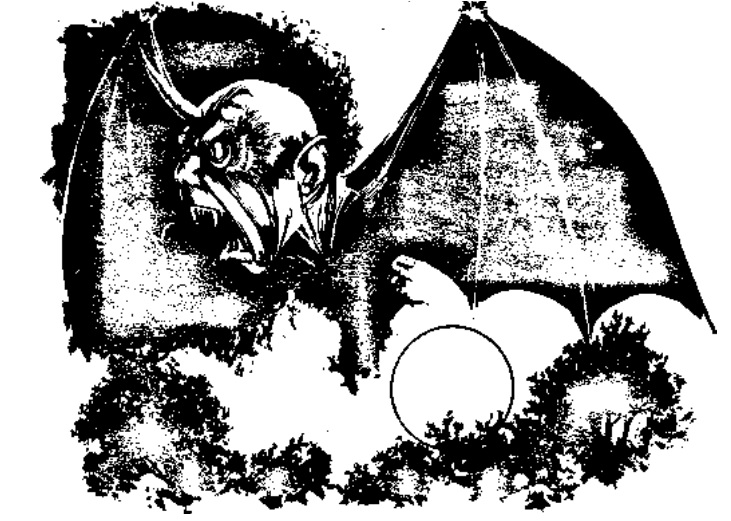
SKREEEEE
-
*
Adventurers
: not exactly monsters, but they do count as bizarre, dangerous adversaries. Most of them will be human, though there are also elf and dwarf adventurers. There are a couple of tables to determine the race, profession and Rank of NPC adventurers, though GMs are advised to exercise judgement: if they bring novice players against a gaggle of 8th Rank Barbarians, they'll hardly want to play the game again. HEAR THAT GROGNARDS
* Death's Heads : These are flying human heads with wings and a long horn sprouting from the forehead. They're very hard to hit, but cannot fly during the day. Which is just as well, as they can cast a spell to render a person immobile, kill them, devour their head and then ride their body as if it were their own.
 They can then walk around during the day, but will always be on the lookout for a new host as the dead body decomposes. The body itself counts as a zombie, with appropriate stats.
They can then walk around during the day, but will always be on the lookout for a new host as the dead body decomposes. The body itself counts as a zombie, with appropriate stats.
* Dwarves : short, stocky, bearded, etc. They rarely grow taller than 1.4 m, "and perhaps this is one reason why they can be so short-tempered." GODDAMMIT GAME. They're single-minded and pedantic, and if they have a sense of humor it is something other races cannot comprehend. Dwarves can be PCs, but they cannot use magic; however, they can forge magic weapons and armor as a Mystic can upon reaching 7th Rank. A character must roll at least a Strength of 12 and no more than 11 on Psychic Talent or Looks to qualify as a dwarf.
* Elves : elegant woodland creatures, frail in appearance but just as tough as a human. All elves have the additional senses of a Mystic, can camouflage themselves so that no being below 5th Rank can spot them, and they get +2 to Attack with a bow. They live for centuries, but lack souls: this means they cannot be resurrected, but on the other hand they are also immune to sorceries that target the soul. Elf PCs must have a Strength not greater than 13 and Reflexes, Psychic Talent and Looks of at least 12, and they cannot be Barbarians.
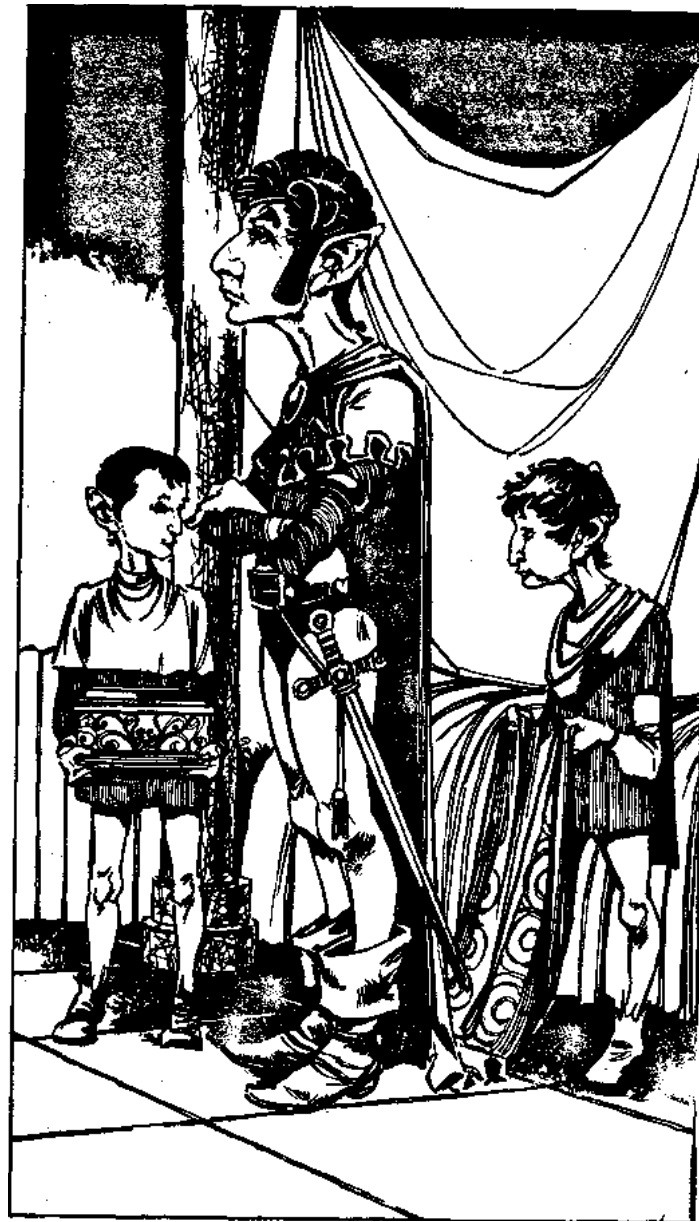
Cheeky, aren't we.
-
*
Ghosts
: ghosts get no stats, but automatically cause a
fright attack
when encountering the living: roll 1d12, substract the victim's Rank from that, and then roll 2d10 to see if the ghost literally scares their victim to death. Survivors of a fright attack are inured to that particular ghost, so they usually vanish quickly after that, but they may also choose to haunt a party, fritzing Mystic danger senses and bringing bad luck (-1 to Attack and Defence) until exorcised.
* Gnomes : they're more fairy tale creatures than the common D&D-style short tinkerers. They react violently against anyone intruding in their domain, with the exception of elf parties. Gnomes can camouflage themselves to be invisible to anyone below 8th Rank (3rd for elves) in their woods, and may cast a spell turning a patch of ground into a boggy mire that reduces movement to only 1/10th of normal.
* Goblins : again, more of a fairy tale bent here. They favor confusing parties with sorcerous pranks like making bats fly into a rider's face so that they fall from the saddle, then ambush them with swords made of icicles and sharp flint flakes thrown from their slings. A promise wrung from a captured goblin will always be followed, however, but they will always try to twist the wording for their own purposes. Hobgoblins are even greater assholes, always invisible to normal mortals (not adventurers), throwing poisonous puffballs that cause death in 1d8 rounds unless victims get a Cure Disease spell or roll under Reflexes to avoid breathing the spores, and have a number of asshole spells, as well as the capabilities of a 3rd Rank Sorcerer.
* Halflings : not much to say here other than, in Gygaxian tradition, they're not PC material as they can never go beyond 4th Rank.
* Pazuzu : creatures from warmer southern climates, some of them have made their way back north on the bilges of ships returning from the Crusades. They're winged humanoids with leonine features and claws, and they will usually disguise themselves as wounded Knights or lazars to approach a party and size them up before attacking. They can also breath flame and cast the Image spell, and when fighting on the desert or mountains, it will attempt grappling a foe, fly up then drop them from a great height.
* Sufiriad : sufiriad are invisible frost demons, though their position can be determined by the whirlwinds they generate and their unnatural screeching. They attack by moving up to a character and imploding their whirlwind on him (1d10 damage, minus armor, plus a save-or-die Strength roll) Fire attack causes +2 extra damage against them. If characters can see in the ultraviolet spectrum, sufiriad look like snakes with a human skull wreathed in cold fire.
* Volucreths : powerfully built birdman slavers from the jungles to the south, Volucreths are dicks. Fortunately, they require the southern heat and rarely venture into the north. 90% of all Volucreths encountered are warriors (Barbarians), while the rest are non-fighting observers, possibly nobles or priests. Some exhibit the powers of a Mystic, but they work in ways that baffle human or elf Mystics. The stats given are for a 1st Rank Volucreth, and GMs are expected to extrapolate higher Ranks and other professions.
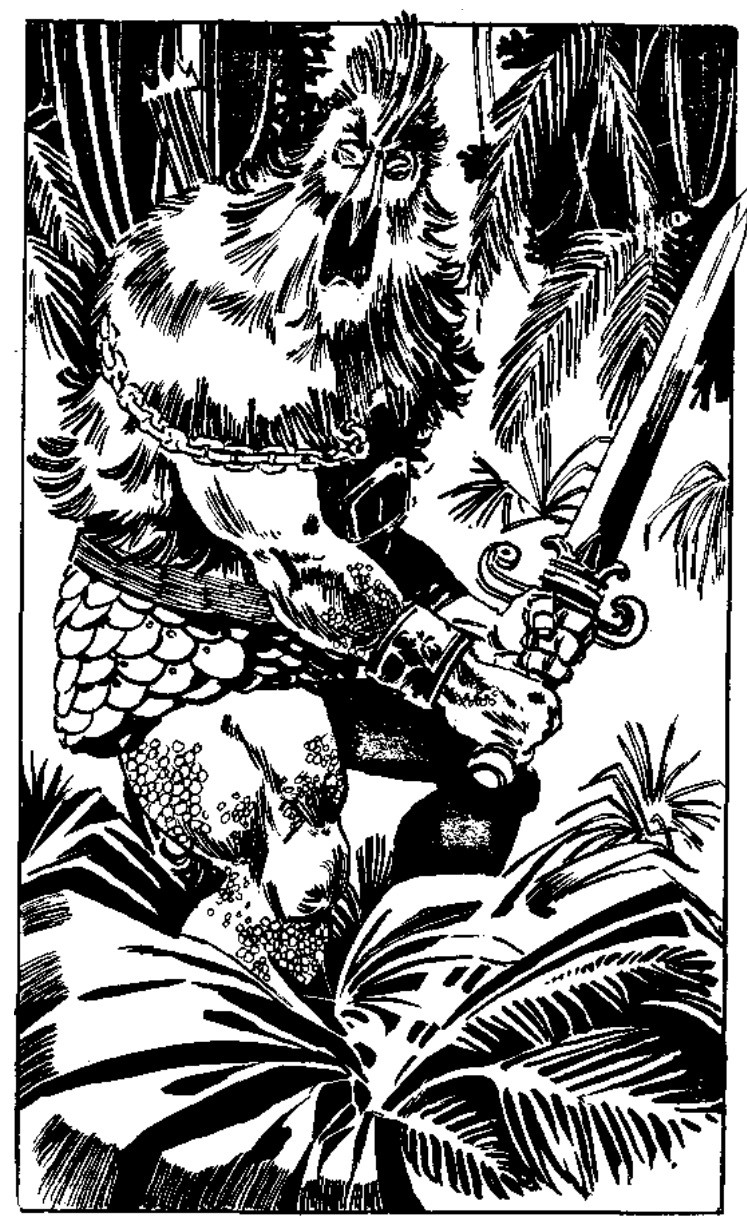
SKREEEEEARRRRGH
A GM section comes up later, detailing how to run the game. Random encounter tables are given, with the caveat that they are to be used only to jostle the GM's imagination and not followed slavishly. There is advice on how to deal with travel, character death, NPCs, hirelings and such. One interesting feature is that PCs may encounter Knights or Sorcerers in "disputation": these NPCs will set up shop at a crossroads or ford and challenge all comers. Knights will be from 4th to 6th Rank (lower ranks are too weak, higher ranks have better things to do) and will duel only Knights and Barbarians. Knightly duels are not to the death, and the loser may surrender honorably, but the encounter will only grant half XP. They will fight to the death against Barbarians for full XP. Sorcerers only seek other Sorcerers to dispute against, and the duel will take the form of a grudge spell match to the death (full XP) or a scholarly argument (1XP for the lesser ranked Sorcerer, 20% of 1XP for the higher ranked one, and it can only take place once between the same characters.)
And now, the adventure! The King under the Forest is a simple scenario meant to bring new players into the game, and can be played with just Knights and Barbarians. Characters are new arrivals to the village of Axbridge, which is part of Baron Aldred's fief. We'll see more of the Baron in later adventures. The party may stay at the house of Odo, an old man that claims to have adventured in his younger days - he never did, and PCs may suspect this, but Odo just likes telling tall tales and won't mind. In fact, if they tell him of their adventures, he'll later change some details and start tell the stories as his own.

The adventure beings as the harvest festivities begin. They are approached by the village priest, Bretwald , who invites the party into the house after commenting on how the festivities are of pagan origin, "but it does no good to tell them that." In his house, Bretwald unfolds a map with annotations characters won't recognize, and will ask them about Vallandar , rex quondam rexque futurus. Betrayed by his half-brother, he was struck down and later found by his court wizard, Mathor , who built a secret crypt from him. In time, the legend says, he will return to drive injustice away from these shores. Bretwald doesn't quite believe the legend, but he thinks Vallandar or a similar warlord actually existed: and what's more, he has the map to his crypt! PCs may logically ask why the priest hasn't mounted an expedition yet, but as a matter of fact, he has: a year ago, he went there with a roving band of mercenaries. They were ruffians and cutthroats, and one of them had the stupid idea to shoot an elf they found in the woods. Bad luck struck the party ever since, and when the weakened party found the crypt, they were ambushed by a full elf warband. The lord commanding the warband could tell Bretwald was not of the mercenaries' ilk, and gave him a cloak to pass safely through the woods - but the wily priest unraveled the cloak to mark the way back to the crypt. Elf thread shows only in strong moonlight, and as it turns out, the full moon is twelve days from now. Bretwald only thinks about the treasure in the tomb, but hasn't even thought on how to split it, and he'll settle for everything the party can carry, plus 10% to him for being the guy with the map. Which, by the way, no one else may read.
The party should get to the crypt with little trouble, perhaps one random encounter to spice things up and teach players about the combat system. Eventually, they'll find the final resting place of Vallandar, who was and will again be King. IT'S KING ARTHUR YOU GUYS. PCs will have to dig up the half-buried portal, and if they don't rest before moving on, they'll take a -1 penalty to Attack, Defence, Evasion and their Reflexes will be halved. Bretwald is armed and armored, but he is no fighter, and his main function in the adventure will be carrying the party's light source.
Down we go! The entrance corridor has a tapestry depicting warriors in gory battle, with leads to two rooms, a cave, and further into the crypt. If the PCs try to advance, the tapestry will reveal its magic, and the party will have to fight off magic Bayeux warriors!
 It will be a kind of difficult fight as the six Bayeux warriors are Rank 2 and will take 2-3 hits each to kill, but the fight may be cut short if PCs think of burning or hacking down the tapestry, which will kill the Bayeux warriors immediately. Behind the tapestry, there is a passage leading to a room with a floor made of colored, polished quartz arranged in an intrincate pattern: it is, in fact,
a map of Vallandar's realm
, though characters will be highly unlikely to recognize it for what it is. There is a chest here, unlocked but trapped: Reflexes roll, or the unlucky sod breathing the gas will be affected by a bout of paranoia. The GM is supposed to take the player aside and tell them that the other characters come for them with arms drawn, and the paranoia will only set in (6 rounds of fighting their own party) if the player actually buys the GM's story. Which is weird, I guess. The chest itself contains 200 silver coins and an
empty leather bag
, secured with a cord of twined red hair.
It will be a kind of difficult fight as the six Bayeux warriors are Rank 2 and will take 2-3 hits each to kill, but the fight may be cut short if PCs think of burning or hacking down the tapestry, which will kill the Bayeux warriors immediately. Behind the tapestry, there is a passage leading to a room with a floor made of colored, polished quartz arranged in an intrincate pattern: it is, in fact,
a map of Vallandar's realm
, though characters will be highly unlikely to recognize it for what it is. There is a chest here, unlocked but trapped: Reflexes roll, or the unlucky sod breathing the gas will be affected by a bout of paranoia. The GM is supposed to take the player aside and tell them that the other characters come for them with arms drawn, and the paranoia will only set in (6 rounds of fighting their own party) if the player actually buys the GM's story. Which is weird, I guess. The chest itself contains 200 silver coins and an
empty leather bag
, secured with a cord of twined red hair.
The second room has walls marked with strange geometric designs, and a spinning wand floating in mid-air. The wand has a red end and a blue-white end, with the middle being black. How a character grabs it, and with which hand, is important: taking it from the ends will cause 1 damage and -1 to Attack and Defence if it's the dominant hand, as it is burned either by the hot or ice cold end. Grabbing it from the middle is key, but even then it's a difficulty 14 Reflexes roll. The wand is a Wand of Fire and Ice , able to fire off jets of, well, fire and ice. It has three charges, and a character holding it will know its capabilities immediately. The wand can be used to deal damage (5d6-armor for the fire end, 4d6-armor up to 2 for the ice end), but the gotcha is that all three charges will be needed for puzzles later on so it's better to hold on to it. Bretwald, if he's not dead yet, will caution against using it rashly.
The final exit before moving deeper into the crypt leads to a wall of rock (climb difficulty 13, 6 if a character gets up there and lowers a rope) leading to... a gigantic fucking hoard of gold and jewels! Guarded by an equally gigantic fucking dragon , of course.
 This is no illusion: the dragon is real and this encounter can easily end in a TPK if PCs are fools about it. Near it, there is an old oak in the middle of a red pentacle on the cavern floor. The GM is supposed to take the character with the highest Psychic Talent aside, or the party's Mystics and Sorcerers if Book 2 is being used, and tell them they thought for a second they saw a wild bearded man, two meters in height, standing on the pentacle. The 'oak' is in fact Mathor the wizard, who will only wake up when his liege does. The pentacle doesn't let anyone do anything to the oak anyway, so this is just for fluff. As for the dragon, its name is Fengel and it is Mathor's bound servant, though it will say the wizard is his friend out of pride. It will be very flattered if someone praises the hoard, though it will correct anyone mistaking it for "the treasures of the kingdom" - those are unguarded in the chamber of the dead king, anyone can take them. If the conversation turns to the characters taking some of the dragon's hoard, Fengel will be loath to part with even the smallest trinket, though it will finally accept a riddling contest: for each riddle the dragon posits that the party answers correctly, they get... one coin! But since these are ancient coins, each is easily worth 40-50 modern florins. The dragon knows the story of each and every coin and will be genuinely sad to see them go. There are some sample riddles, and if the characters fail to answer one, Fengel will end the contest. Characters may try to snatch a handful of coins and run (10d6 x 1d20 florins' worth), in which case Fengel will wait until they're about to jump down before blasting the thieves with a party-killing breath of fire. It will let any survivors go, though.
This is no illusion: the dragon is real and this encounter can easily end in a TPK if PCs are fools about it. Near it, there is an old oak in the middle of a red pentacle on the cavern floor. The GM is supposed to take the character with the highest Psychic Talent aside, or the party's Mystics and Sorcerers if Book 2 is being used, and tell them they thought for a second they saw a wild bearded man, two meters in height, standing on the pentacle. The 'oak' is in fact Mathor the wizard, who will only wake up when his liege does. The pentacle doesn't let anyone do anything to the oak anyway, so this is just for fluff. As for the dragon, its name is Fengel and it is Mathor's bound servant, though it will say the wizard is his friend out of pride. It will be very flattered if someone praises the hoard, though it will correct anyone mistaking it for "the treasures of the kingdom" - those are unguarded in the chamber of the dead king, anyone can take them. If the conversation turns to the characters taking some of the dragon's hoard, Fengel will be loath to part with even the smallest trinket, though it will finally accept a riddling contest: for each riddle the dragon posits that the party answers correctly, they get... one coin! But since these are ancient coins, each is easily worth 40-50 modern florins. The dragon knows the story of each and every coin and will be genuinely sad to see them go. There are some sample riddles, and if the characters fail to answer one, Fengel will end the contest. Characters may try to snatch a handful of coins and run (10d6 x 1d20 florins' worth), in which case Fengel will wait until they're about to jump down before blasting the thieves with a party-killing breath of fire. It will let any survivors go, though.
Further on into the crypt, the party will find a podium with a silver goblet on top of it. If they walk towards it, they will be struck by a fierce wind not even the strongest PC can push against. The wind will send them back the way they came, unless (pixelbitching, ho!) someone thinks of trapping the wind with the empty bag they found in the map room, the wind won't trouble them anymore. If the bag is opened later, the wind will try to make its way back to this room, knocking down everything in its path - and this may happen even if the characters leave the crypt and the region. there is a room with a bronze helmet on a table propped against the far wall. The room is full of sticky cobwebs, though, as it is the lair of a Giant Spider. Only the characters in the front row of the party will be trapped when they step into the room, and the rest won't be able to help as they're in the way. If the spider is reduced to 3HP or less, it will scuttle back to its lair above the rafters. As for the helmet, it is strangely ornate, and its visor is actually a mirror: characters may see from inside, but as if looking through smoked glass (penalty of -1 to Attack and -2 to Defence). It will serve its function later.
There is an swinging axe trap later, with a Speed of 13: characters will have to remember the trap is there if they survive, as it will reset itself in the wall. Then comes the dickest part in the adventure: a shimmering magic barrier is here and characters must walk past it to proceed. Anyone walking through it will be blasted by a Magic Attack of 18: if succesful, they will be subject to irrational terror, causing a penalty of -1 to Attack, a bonus of +1 to Defence, and a 25% chance when encountering any monster of being rendered useless by the terror. The effect wears off as soon as the character leaves the underworld. There are two fountains to each side of the barrier: one, full of a grey fluid, makes the skin of a character that drinks from it hard and stony, adding +2 to their Armour Factor but reducing their Reflexes and movement speed in half. This effect also lasts until the character leaves the underworld. The other fountain is full of an acid liquid that will burn any character trying to drink from it (1d4 damage, if the character used their hands to drink from it they lose -1 Attack permanently, or 1d8 Looks if they put their face to it). The acid can be rendered safe by using the goblet from the wind room, and in this case it will grant immunity to the magic barrier. No real hints that this will happen, however. Both liquids become stagnant water upon being removed from the crypt.
Beyond the barrier, there is a short flight of stairs, leading to a quay next to an underground river. A rickety bridge spans the river, but before that characters have to deal with the living statue guarding the stairs. The statue looks unfinished, with the upper half of a man, claws for hands, and an unworked lump of stone for the lower half, but it still packs a whallop. It can't move and characters may try rushing past it, but they only get half their Defence while doing so, and the statue may try striking up to two of them with its claws. The trick here is using the Wand of Ice: two successive strikes with the cold and hot ends will instakill the statue due to the expansion and contraction breaking it down. A shortsword will be found amid the rubble: it is enchanted, adding +1 to Armour Bypass, Attack, Defence and damage. The bridge is flimsy, and any character affected by the stoneskin liquid will go right through the planks and drown in the river, unable to float. The trick, again, is using the wand: using the ice end will make a bridge of ice over the river that will resist the weight of stoneskin characters. And that uses up the three charges!
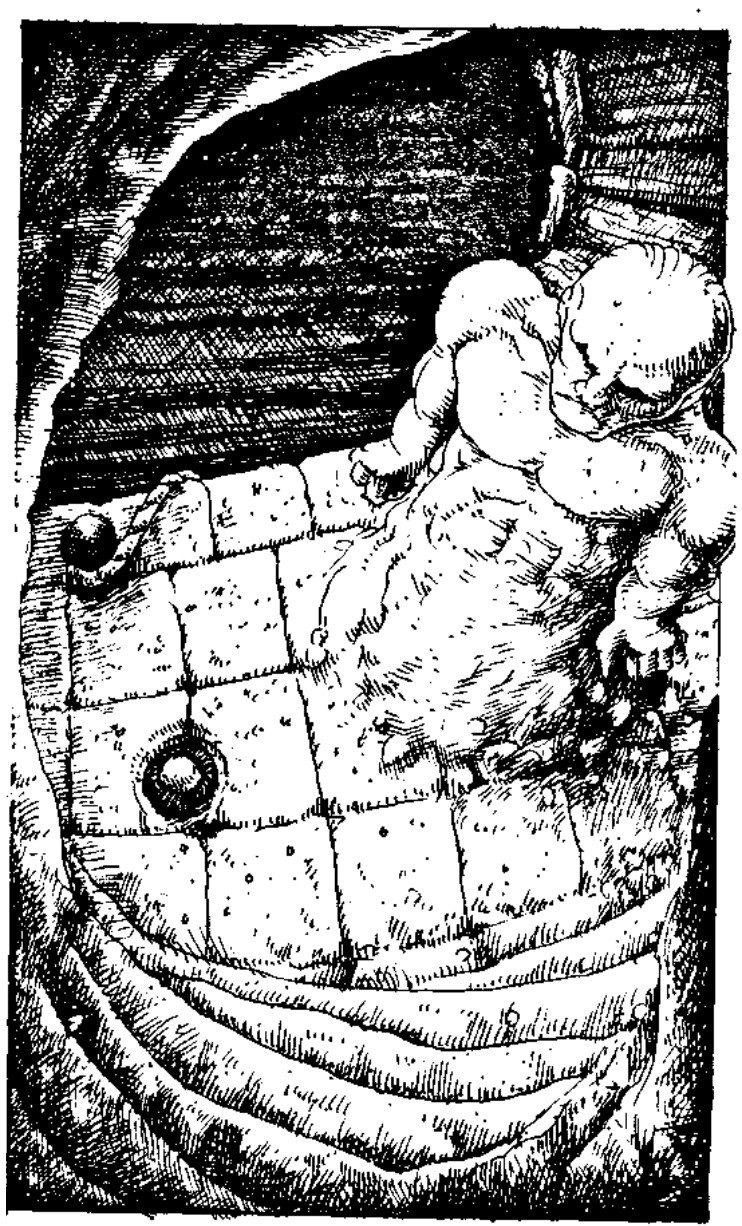
Tearing the throats off random adventurers are all the fun the poor bastard can get.
Further on, a passage leads to a small chapel . Characters will feel peace and comfort here, and any character afflicted by the magic terror that thinks of kneeling in prayer here will be cured from it. The prayer has to be spontaneous: any character that suddenly finds God upon seeing the effects on their companions will continue to be frightened. A passage here leads to a corridor illuminated by red lamps. where lights work strangely: they seem to become dimmer as one approaches them. In fact, they're an illusion created by Mathor, and the "corridor" actually leads to a 10 meter deep pit.
The other exit leads to a T-junction, bright light coming from the northern passageway. Characters will find what appears to be a lady in waiting at the junction, but its true nature will be revealed as soon as they hear the evil hissing from its "coiffure": it's a Gorgon ! Complete with petrifying gaze, and sorcerous powers if you have Book 2. Here is where the mirrored helmet comes in handy: a character wearing it will force the Gorgon to be subject to its own petrifying gaze attack, and even if it doesn't die from it, it will choose to fight blind (with appropriate penalties) rather than risk her own gaze again. The northern passage leads to Vallandar's tomb, while the western exit leads to a treasure room full of skeletons. They should go down soon enough, they're not tough at all. The chest in the room cointains six treasures, but characters will only be able to take one: upon touching it, a tremendous force will blast them back to the entrance of the room along with the object, and the chest will be locked. The treasures are six magic arrows (d6+1, 5 points), a healing potion (restores 7 HP), an Elixir Vitae (it will bring a corpse back to life, with a permanent loss of 1d3 HP and 1 point from each of their stats), a gold clasp worth 120 Florins, an ivory crucifix (a relic of St. Leon that grants +2 to Attack against the Undead and immunity from the fright attack of ghosts and spectres), a scroll (with the Shadowbolt spell) and a silver scepter (150 Florins, and useful as a mace to smite Wights) A narrow passage leads from here to a very long drop, lanterns not being able to break through the dark. There are rungs leading down here, and a character may use them to climb down. There is no danger here other than the drop, and a character searching the bottom will find a dagger with five gems encrusted in the hilt, worth 400 Florins.
And at last, the tomb! Characters taking the northern passage will find themselves on a balcony overlooking a vast hall, full of shadows, not being able to see the ceiling above. At the center of the chamber, in a pillar of green light, there is a tall man on horseback, with both the rider and the horse's head bowed as in slumber. A golden crown rests on the man's head. Around him, there are twelve mighty swords , balanced on their points in a perfect circle. Stairs lead down from the balcony into the hall, towards a massive golden casket. But as the PCs go down, the shadows coalesce into a man-shaped figure, a white visage and eyes full of hatred! The figure draws a spectral sword from thin air and prepares to fight: it is
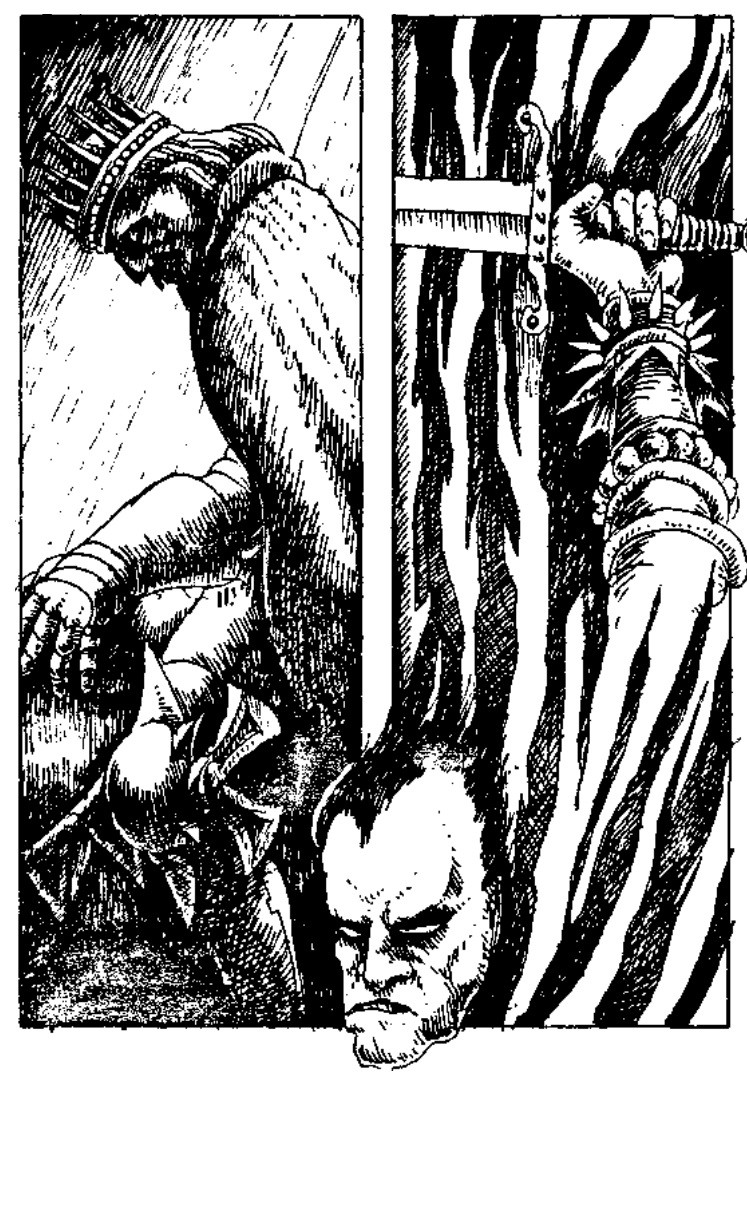
What is WRONG with his face
Let me repeat this: on the very first adventure, Dragon Warriors lets PCs become bannermen of King Motherfucking Arthur, to fight at his side at the End of Days.

Oh, yes, and the swords inflict full damage on undead monsters, such as specters. Convenient! There is no bonus at first, but if characters keep the swords with them and perform truly brave, honorable, selfless deeds, they will slowly gain bonuses up to +3. It is to the GM's discretion when a character performs a suitable deed. The swords can also never be lost: even if seemingly impossible to recover, the sword will make its way back to its owner within a few days. Finally, after Morgrin is dealt with, characters will turn to the massive golden casket, full of the treasures of the kingdom...
...a silver crown , a handful of grain , a simple ploughshare , a wooden cross and a leatherbound book . Bretwald, if he's managed to survive this far, will understand.
quote:
"The treasures of Vallandar's Realm!" he groans. "The King, the Land, the People, the Faith and the Law..." He weeps.
The crown can actually be sold for about 90 Florins. The book is a compendium of laws, and if given to a monastery, it will gain the party the everlasting friendship of the monks. The gold casket is much too heavy to lift, and too solid for characters to break up. Attempting to touch Vallandar is ill-advised, as trying to do so will cause energy blasts to fling characters back for 1d4 damage. And so the adventure ends, with Bretwald a sadder, wiser, somewhat richer man. Characters get 7XP plus whatever they got from fighting the crypt's monsters, but will never be able to find it again: it is Mathor's magic at work, allowing adventurers to find Vallandar's Crypt but once in their lives.
The book ends with advice directed to the players: how to roleplay, adventure and such. Players are advised to pay close attention to descriptions: if the party is hired to kill an Ogre preying upon a village, but corpses drained from blood have also been found, then perhaps the "Ogre" is best tackled with garlic and crucifixes. The GM will not spoonfeed players all the information, after all! There is also some talk on battle formations, because we all need to get our Rainbow Six on in our fantasy roleplaying game. Jokes aside, this is all pretty cool info for someone new to dungeon crawling. And with that, the book ends!
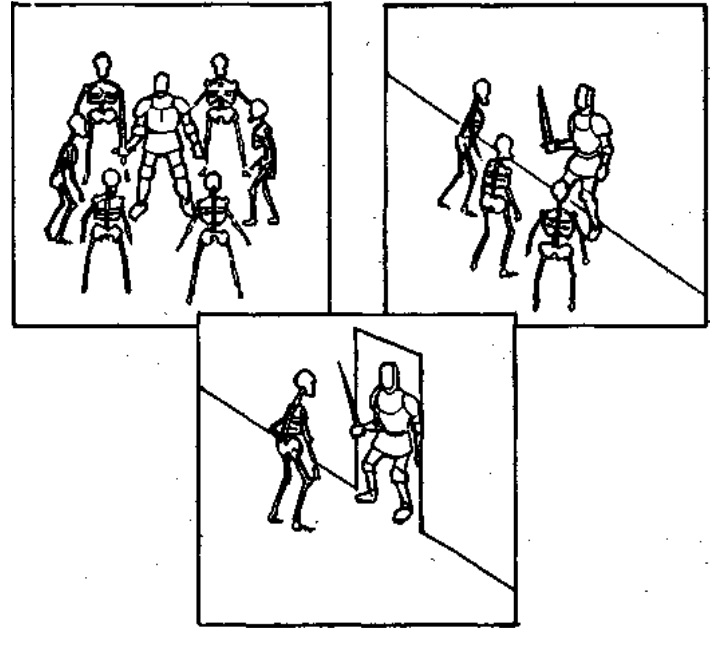
When unnaturally risen from its eternal slumber, Mr. Skeleton is no longer your friend.
Next: Book 2, the Way of
No sense of right or wrong
Original SA post Dragon Warriors: Book 2No sense of right or wrong
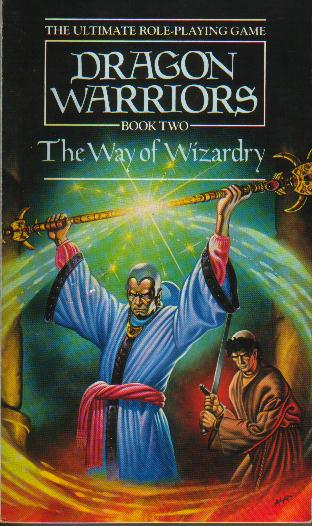
Eggheads, the whole lot of them.
So, second book! The Way of Wizardry is the other half of the basic Dragon Warriors game, introducing the two spellcasting professions, magic items and treasure, as well as a a couple of interesting adventures. The two new classes are Sorcerers , those who seek to master arcane enchantments to draw energy from OTHER DIMENSIONS and channel it according to their wishes; and Mystics , who seek to harmonize themselves with the unseen forces of Nature: perhaps, in modern parlance, we would call them "psionics." Sorcerers are poor fighters but their spells can be quite devastating, while Mystics learn some of the martial arts and many of their spells are meant to enhance their own prowess. Both classes get different spell lists, of course, and the way they cast them is different: Sorcerers have a pool of Magic Points they must spend to cast a spell, and when they're out of points or don't have enough for that particular spell, they're out of luck. Mystics, on the other hand, must make checks every time they use a spell to see if their casting ability has become "fatigued", and when this happens they can no longer cast spells for the day.
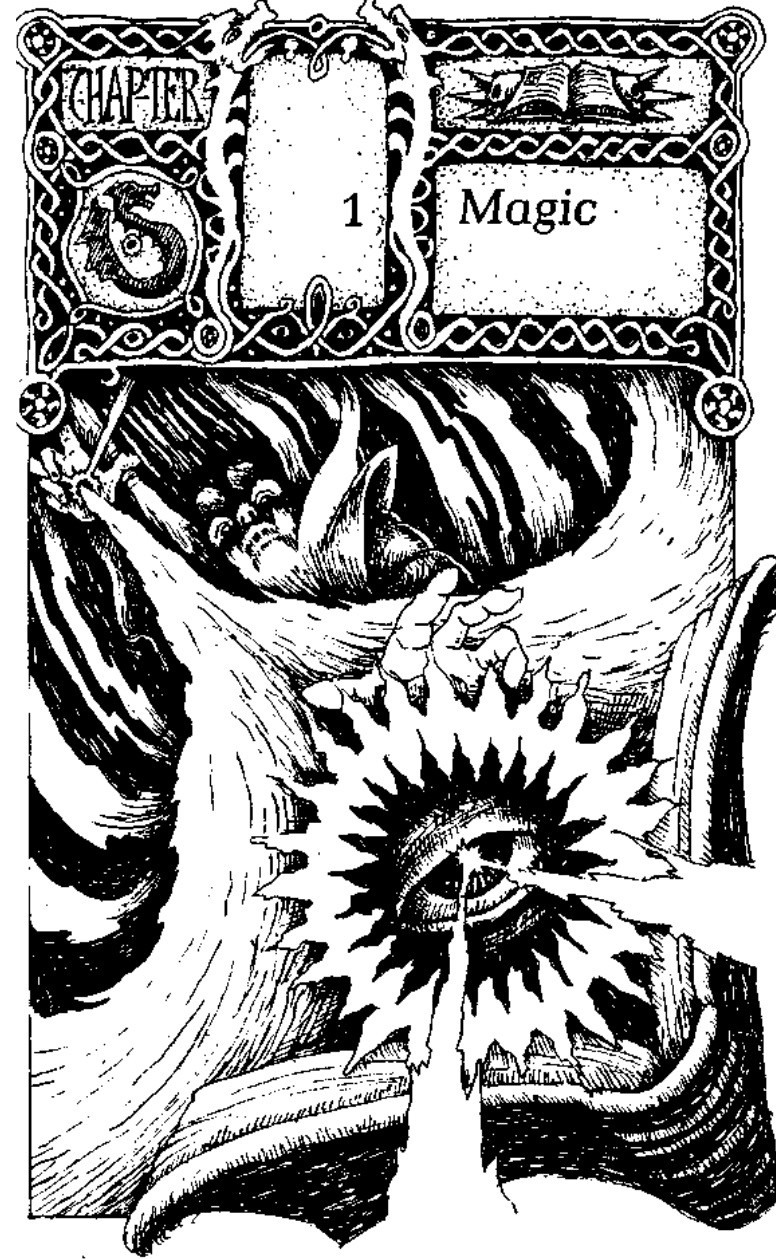
An eye cast from an eye in his hand. This shit is Inception.
The game is upfront about the fact that the spellcasting professions get to unleash a lot of power in a short time, and that a fresh, rested Sorcerer or Mystic going against a Knight or Barbarian of similar rank will probably win. If they had used their spells for the day, though, the opposite would be true, and the game is confident that the whole thing averages out during the course of an average underworld adventure (about four hours). GMs are encouraged to remember that short adventures will favor magic users, while long adventures will favor the fighters.
After a review of magical combat factors that includes this time, Magical Attack for the new classes, starting at 15 for Sorcerers and 14 for Mystics (further modified by Intelligence and Psychic Talent as with Magical Defence) we start talking about spells! They can be instantaneous , a one-shot effect that takes place immediately upon casting, or durational , that operate for more than one combat round. Durational spells either have a fixed duration or are subject to a Spell Expiry Roll : at the beginning of a round, 2d6 must be rolled per spell, and if a 12 comes up the spell wears off. Offensive spells are further divided into direct attack and indirect attack spells: direct attack spells cause a magical effect directly on the target, and thus are normally Magical Attack against Magical Defence rolls. Indirect attack spells, on the other hand, generate an effect that harms the victim in a physical rather than supernatural way: the intrinsic magic resistance of a target won't matter much when the enemy sorcerer casts a Dragonbreath spell to fry their ass. Indirect attack spells are usually Speed vs. Evasion affairs. Spells can also overlap (casting many protection spells on one's person, frex) without limit, but no two copies of a spell may benefit a character at the same time.
So, Sorcerers! They require a minimum Psychic Talent and Intelligence of 9. Casting spells for them, as discussed earlier, requires Magic Points equal to the level of the spell, and they cannot cast a spell of level higher than their Rank. MPs come at a fixed rate per Rank, without any extra MP for high stats: a starting Sorcerer gets 4 MP and increases that number in 4 or 3 per Rank. Expended MP regenerate at midnight. Sorcerers can also add more MP to a spell they cast: indirect attack spells get nothing out of it, but direct attack spells can have a better chance of breaking through enemy magic barriers. They can also will durational spells to end at any time: it takes them one round per spell, and nets them back half of the MP cost.
Sorcerers can wear armor, but it's not a good idea: first, they get penalties to Attack and Defence as discussed in Book 1 (-1 for ringmail, -3 for chainmail, and -4 for plate), and wearing ringmail or heavier armor also carries a percentile chance of miscasting a spell (10% for ringmail, 20% for chainmail, 30% for plate). A Sorcerer armored in such a way rolls a d100 when casting a spell, and if the roll is equal or under to the miscast chance, they pay double the cost of the spell and also have to randomly determine the spell they're casting. Conveniently, each spell level has exactly 6 spells. The target of the spell doesn't change, though: the Sorcerer may be trying to heal an ally only to blast them in the face with a Dragonbreath spell. On the other hand, they can wear up to Hardened Leather (AF 2) without penalties.
And now, Spells! As mentioned before, there are 6 spells in a level, with ten spell levels for a total of 60 spells. There is no provision for creating new spells here either. Some are familiar from D&D, some go off in their own direction, as we'll see.
Level One
-
Dragonbreath
: Basic attack spell, it casts a jet of fire with a Speed of 12, dealing 1d6+6 damage minus target's Armour Factor.
-
Image
: a near perfect visual image is created, no bigger than man-size: only 10% of being recognized as an illusion.
-
Lesser Healing
: heals 2 HP. Yes, in this game it's the mages that do the healing.
-
Moonglow
: a circle of light surrounds the caster. The light is diffuse enough that monsters underground are not alerted by it, giving the party a chance of surprise.
-
Portal
: this spell can either force open any door that a Strength 16 character could force, or lock it. This magic lock can either be dispelled or physically broken.
-
Weaken
: direct attack spell that makes the target lose 2 Attack and inflict 1 less damage per strike.
Level Two
-
Detect Aura
: the caster or someone else they cast the spell on can detect the supernatural aura around enchanted beings or objects.
-
Hold Off The Dead
: a zone 2m in radius is created around the caster: any undead of no higher rank than the caster entering it is subject to a magic attack that will keep them at bay if successful.
-
Inflict Wound
: direct attack spell that causes 5 damage.
-
Peer
: the Sorcerer specifies any point within the spell's 20m range and they can see anything happening in a 3m radius. Walls or floors do not block the spell unless made of metal.
-
Tangleroots
: magical roots sprout up and trap any characters unlucky enough to avoid the spell's Speed of 14. They can hack or force their way out, but it'll take time and they will be trapped until they do.
-
Warding
: -2 penalty to anyone attacking the Sorcerer.
Level Three
-
Banquet
: Create Food and Drink, for five people.
-
Beacon
: marks any invisible object or being within range with a glowing green energy ball.
-
Command
: Charm Person, more or less. Only works in beings of 1st-3rd Rank, and does not make them unquestioning slaves.
-
Greater Healing
: heals 7 HP.
-
Illusion
: an almost perfect illusion (only 5% of detecting it as such, and even then with a thorough examination) that fools all five senses. It can't actually harm anyone or have an actual physical effect, though.
-
Wolfcall
: summons a wolf to fight for the Sorcerer. The game thinks it must note, "for the literal-minded", there doesn't actually have to be a wolf nearby for it to work: it's magic!
Level Four
-
Antidote
: this reduces the potency of poison in the bloodstream: a "roll under your Strength in 3d6 or die" poison, for instance, becomes 2d6. It must be applied within a round of the poisoning.
-
Curse
: direct attack, can hit up to 4 targets, they get a penalty of 2 to everything until dispelled.
-
Disease
: direct attack, victim loses 2 HP per round until cured or dead.
-
Oracle
: the Sorcerer can ask up to three yes/no questions of the
spirit world woooo
. The spirits can't read the minds of others, and only know the answer 75% of the time: they bullshit the other 25%.
-
Shadowbolt
: another magic missile, Speed of 14 and dealing a monstrous 2d6+10 damage, minus AF.
-
Wall or Magic
: the caster or ally is surrounded by a barrier against enemy spells. At least 4 MP must be spent on a Wall of Magic, but more can be spent, and will absorb direct attack spells up to its MP limit. Indirect attack spells are not affected.
Level Five
-
Banish
: direct attack spell and the Sorcerer must also succeed on a touch attack: if successful, the victim is banished to freaking Limbo. Only the Sorcerer that cast the spell or another Sorcerer casting Dispel Magic on where the banishment took place can undo this, and the banishing Sorcerer can talk to their prisoners in dreams.
-
Divination
: like Oracle, but only one question, that can be something other than a yes/no question.
-
Fossilize
: Turn to Stone, motherfucker. Doesn't work on Gargoyles since they're stone already, or non-corporeal entities.
-
Mantlet
: mundane projectiles just drop to the ground, causing no harm to the caster. Magical or very heavy (20 kg or more) are not affected.
-
Reanimate the Dead
: 1d6 corpses are raised as zombies under the control of the caster. Spell Expiry Roll applies, and the zombies are dumb as, well, zombies.
-
Transfix
: direct attack, 2d8 characters suffer a mental BSOD that paralyzes them and muddles their memories of anything that happened 2 rounds before the spell was cast up to the spell's end. Attacking them breaks the spell.
Level Six
-
Armour
: magic jet black armor surrounds the caster. It has an AF of 6 and does not hamper the Sorcerer's casting. Does not stack with regular armor.
-
Cure Disease
: cures disease, of either natural or supernatural origin.
-
Dishearten
: direct attack. The spell's name is literal.


 Even if the painful YOUR HEART ASPLODE effect fails, it deals 1d4 damage.
Even if the painful YOUR HEART ASPLODE effect fails, it deals 1d4 damage.
-
Dispel Magic
: any durational spell that costs equal to or lest than this spell expires immediately. It affects all spells in range, both the Sorcerer's and their enemies'.
-
Phantasm
: the Sorcerer summons ectoplasm to fashion a creature that will do their bidding. It has a Magical Defence of 8, Evasion of 5, an AF of 4, 4d6 HP and 28 points to split between Attack and Defence. Their attacks use 1d10 for Armour Bypass and deal 5 damage.
-
Sword of Damocles
: a magic sword appears over the head of the target. When activated, it falls with a screech on the target's head(Speed of 17, 1d10+2 for Armour Bypass, 4d6 damage). It can be command activated or triggered by a condition of the caster's choosing.
Level Seven
-
Deathlight
: Magic Missile III, Speed of 16, 3d6+10 damage minus AF, can fork and strike up to 4 beings.
-
Enslave
: like Command, but this one
does
make the victim an unquestioning slave. Language barriers are no problem either, but slaves tend to be literal when following instructions.
-
Nova
: like in Diablo II! Any being within 5m that fails against a Speed of 18 is struck by 1d3 beams, 3d8-AF damage each.
-
Spell Screen
: this reduces the strength of any direct attack spell by 5 points. The Screen itself is not affected by this, unlike Wall of Magic.
-
Stasis
: direct attack spell, freezes 1d3 victims in time. They cannot think, act or be harmed in any way until the spell is Dispelled or the Sorcerer wills it over.
-
Vorpal Blade
: summons a +3 sword. It's only for the Sorcerer's use: putting it down will cause it to vanish immediately, and offering it to another will make the sword strike its caster before vanishing.
Level Eight
-
Astral Gate
: a shimmering portal can take the caster and company up to 150km away. It must be a place the caster knows well, with chances of getting lost if they don't know it. Also, the portal vanishes on a roll of 6 in 1d6 for every character that passes through it, and the caster must spend three rounds visualizing the destination or else there's a chance the gate will emerge
elsewhere.
-
Bastion
: an impregnable barrier is created, either in the form of a hemisphere around the caster or a wall.
-
Burden
: a zone 5m in radius and 3m is height sees the local pull of gravity increased so much that any creature in the area will fall to the ground, unable to move. It has a Speed of 16 to represent characters jumping out of the way before the spell kicks in.
-
Destrier
: a
demonic Warhorse
 is summoned. The spell is only usable at night, or in an underworld, and it's the only way a Sorcerer can ride a Warhorse (they're normally restricted only to Knights and Barbarians, because). The Destrier hits like, well, a demonic warhorse, and beings of Rank 1-3 have a penalty of -1 to Attack because it's
that
scary. It can also transport its master up to a hundred kilometers in a single night.
is summoned. The spell is only usable at night, or in an underworld, and it's the only way a Sorcerer can ride a Warhorse (they're normally restricted only to Knights and Barbarians, because). The Destrier hits like, well, a demonic warhorse, and beings of Rank 1-3 have a penalty of -1 to Attack because it's
that
scary. It can also transport its master up to a hundred kilometers in a single night.
-
Evil Eye
: the caster's left eye is touched "by the spirit of the Fomori demi-god, Balor, whose gaze is Death."
FUCK. YES.
Any being meleeing the caster has a 40% of staring in the eye: this subjects them to a 1d12 save-or-die fright attack. The spell does cause a penalty of -1 to Attack and -2 to Defence for the caster due to loss of binocular vision.
-
Rune
: a trap spell that lets the caster store another spell inside of it. When a character comes within 3m of the Rune, the stored spell is cast at them. Only one Rune may be active at any time.
Level Nine
-
Animate Bones
: this spell raises a Skeleton from the corpse of someone the Sorcerer killed with their own hands.
-
Battlemaster
: a supernatural, extraplanar, tough as all hell warrior is summoned to fight for the caster. This spell cannot be cast more than once a day, but more than one Sorcerer can cast Battlemaster at any time: though there only one Battlemaster, it can exist in many planes simultaneously. It's a bad idea to pit it against itself: if ordered to attack a copy, both copies will merge, free from the control of either summoner.
-
Firestorm
: Great Balls of Fire! Speed of 18, 4d10+4 damage, and 4 damage even if they make the save from the peripheral heat. Magic armor of any kind reduces the damage in 3, unenchanted armor does nada.
-
Invisibility
: renders the caster invisible. If the enemy has an idea of their location, they can attack (with massive penalties), or cast spells (direct attack works normally, indirect attack suffers a loss of 1d8 Speed)
-
Miracle Cure
: target is healed to full HP, any diseases are cured, and any missing limbs or organs are regenerated.
-
Raise Fog
: an area 60m across and 5m high is covered in dense fog. The Sorcerer can see perfectly well through it, but other characters can only see about 3m.
Level Ten
-
Doppleganger
: this creates a soulless duplicate of a person. First, the sorcerer makes a clay simulacrum mixed with their own blood (permanent loss of 1d4 HP), then they acquire a favorite item of the person to clone before casting. The doppleganger has all the fighting skills of the original, but not their knowledge. It has no reason or volition, and lacks a soul so they cannot enter consecrated ground or project a reflection (I wonder if the same is true for Elves.)
-
Hecatomb
: direct attack, save-or-die for anyone (ANYONE) within 10 meters of the caster. The Sorcerer must also pay 1d100 XP.
-
Pentacle of Entrapment
: this requires the caster to actually draw or engrave a pentacle, which is then transformed into a trap by the spell. The first 2d6 beings of 5th Rank or less getting within 20m of the pentacle are hit with a magical attack that traps them inside if successful. They can only get out if they know the key password, chosen by the Sorcerer when they cast the spell, or if someone not affected by the trap erases part of the pentacle.
-
Resurrect
: brings someone back to life, with the permanent loss of 1d3 HP. For a week after rising, their Strength and Reflexes are also halved. This spell renders the caster unable to cast spells above Level Five for the rest of the day, so the book says Sorcerers are reluctant to cast it, or charge at least 200 Gold Pieces for it.
-
Scry
: the Sorcerer peers into their "speculum" (a specially crafted obsidian mirror, costing 3d6x10 Gold Pieces, of which the character can only have one) and see images from far off locations. It only shows general views (the Sorcerer can see the tower of their enemy, but not inside of it, for instance) and any Sorcerer or Mystic of equal or greater rank knows when they're being observed, and can cast Dispel Magic to undo the peering and shatter the speculum. The caster can also Scry into past events: they must know the time at which the event took place with a 12-hour margin of error, or have an object present at the scene.
-
Transformation
: the character is transformed into a creature whose Rank-equivalent does not exceed their own Rank. They retain their HP and magical combat factors, but their fighting capabilities become those of the creatures. They do not obtain the creature's magical attacks, and they cannot cast spells unless the creature is basically humanoid.
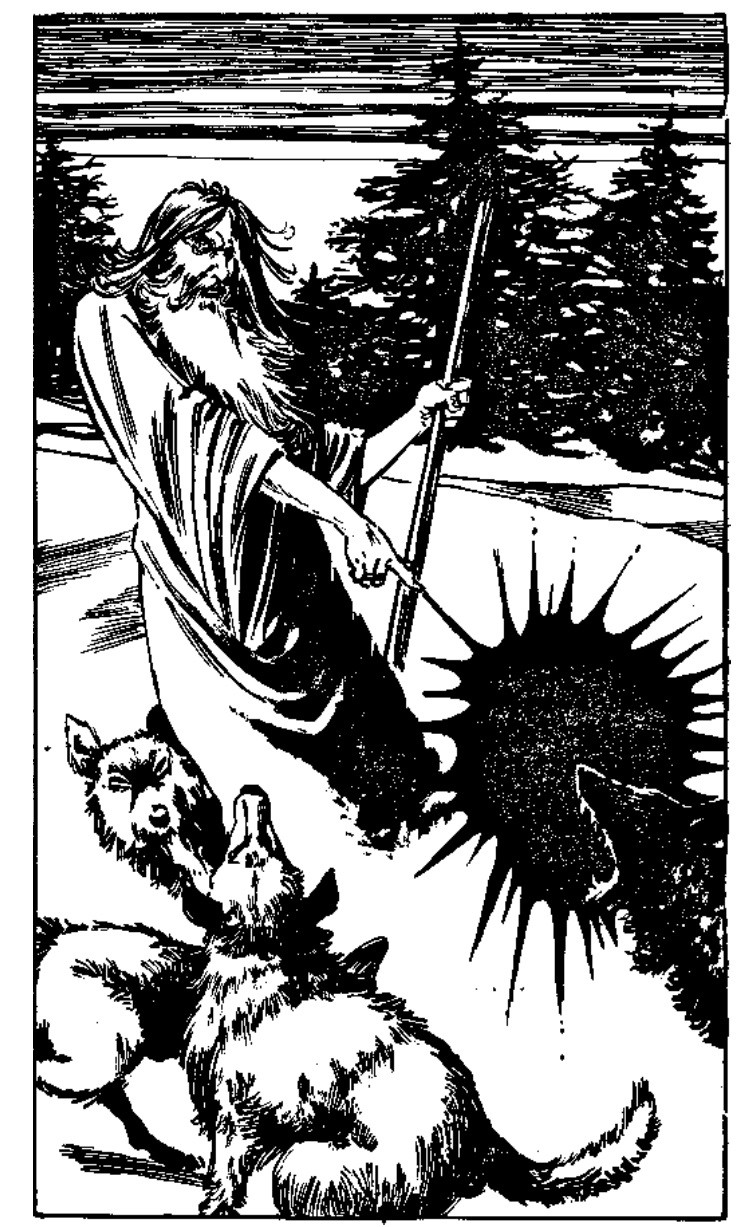
Bad doggie! Eat eldritch death.
Those are all the spells: some oddly placed, some too powerful for my taste, but overall it's not terrible. Sorcerers also have access to Calligraphy at 4th Rank, the ability to inscribe scrolls. This takes a lunar month, costs 3d6 Gold Crowns, and may be for any spell the Sorcerer can cast, with a MP cost equal to their Rank. Each scroll reduces the Sorcerer's MP total in 2 until cast, which is why Level One and Two spell scrolls are rare. At 6th Rank, they get access to Alchemy , the preparation of potions and thaumaturgical compounds. This requires a fully stocked laboratory (around 200 Crowns) and 28 days to make a potion or compound. A character may make up to 10 potions at one time, but must tend the process at all times. The type of potions and compounds they can make increases with experience, and at lower Ranks there is a chance of bungling the process (40% at Rank 6, -10% with every Rank over that). Finally, they learn the tricks of Artifice , the creation of magic items, at 8th Rank. Sorcerers cannot adventure while creating magic items, and must have 20 MP with them at all times to power the necessary enchantments. The cost and time required for a magic item depends on the type: at 8th Rank, they can make one talisman in 7 months for 300 Crowns; at 10th Rank, they can make one amulet in a year and a day for 400-500 Crowns, and at 12th Rank they can make a magic ring in three years (plus one month per ring charge) and with 600 Crowns' worth of materials. At 15th Rank, they can make their own artifacts: this is handled by GM fiat, but it's stated that this might very well take the character's lifetime, and while Artifice is described as a precise science (only 5% chances of failure!), the scientific method is yet to come to artifact making.
Next: Medieval European Jedi.
Medieval European (psyduck)
Original SA post Dragon Warriors: Book 2Medieval European

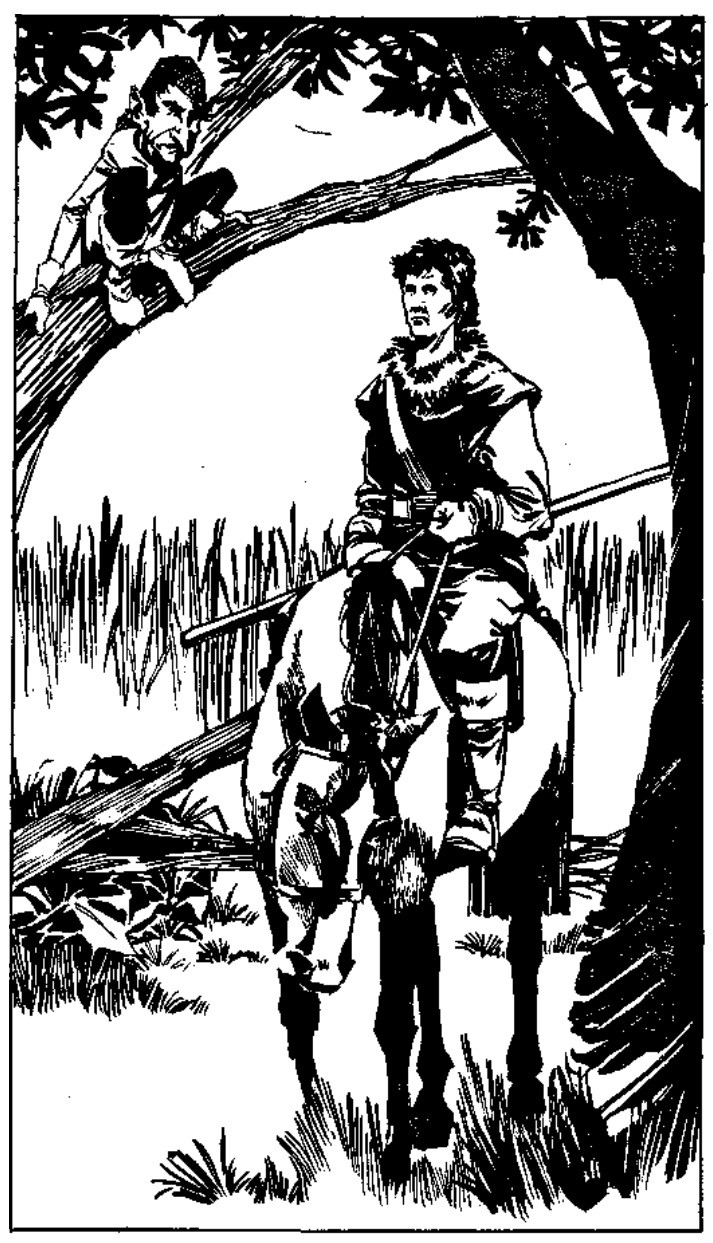
A Padawan in Aquitaine.
Mystics are the last of the basic four professions. They only require a Psychic Talent of 9 for admission: unlike Sorcery, Mysticism is not intellectually demanding. Spells are also ranked by level as with Sorcerer spells, though there are less of them - nine spell levels with four spells each for a total of 36 spells. Of course, Mystics cannot use a spell of a level higher than their Rank. As mentioned earlier, they do not use MP to do their spellcasting, instead resorting to a Psychic Fatigue Check : they must roll 1d20 under 13 + Rank - spell level. Failing this check means that the Mystic cannot cast any more spells for that day, only recovering from the psychic fatigue at dawn, and a natural 20 on the check is an automatic failure. Failing a check does not prevent the spell from being cast, however. They may also choose to cast a spell as if it were of a higher level, with the corresponding increase in the Psychic Fatigue Check difficulty, in order to penetrate magical defenses (Mystic spells are considered to have a MP strength equal to their casting level for these purposes.)
Mystics also have penalties to Attack and Defence for wearing armor they're not used to (-2 for chainmail, -3 for plate). In addition, they can also have armor-induced miscasts, though in this case the miscast is caused by the armor's enchantment rather than its cumbersomeness (10% for every +1 on the armor) as the protective magic interferes with the Force, man. Miscasting a spell means that the Mystic must roll the Psychic Fatigue Check as normal, but the spell fails to operate. Unlike Sorcerers, Mystics may terminate any and all durational spells they're sustaining as a free action, but they don't get MP out of it. Since rolling a Spell Expiry Roll every six seconds may be cumbersome out of combat (no shit) the game suggests allowing the Mystic to make a percentile roll of 75% every minute, which apparently is statistically equivalent to ten successful Spell Expiry Rolls. I guess! They start with lantern and flint-and-tinder, a backpack, a bow, a quiver with six arrows, a dagger, ring mail armor, 2d20 Florins and a sword or staff; Sorcerers, whose equipment I forgot last entry, get a lantern with flint-and-tinder, a backpack, a dagger, a shortsword or staff, 20 florins, and two magic potions inherited from the Master Sorcerer they apprenticed with (a standing tradition, the book says.)
And now, Mystic Spells! While Sorcerer spells tended to be of general utility and offense, Mystic spells tend to be self-buffs and perception enhancers, with the occasional exception.
Level One
-
Invigorate
: the Mystic recovers 2HP.
-
Mirage
: a visual illusion is created. It can be directly controlled or "programmed" to perform an action or set of actions. 10% of recognizing it for what it is at first glance.
-
See Enchantment
: detects powerful concentrations of magic energy, like those on magical weapons and objects (but not temporal enchantments)
-
Suspended Animation
: the Mystic sinks into a deep coma and appears dead to all intents and purposes. They are aware of their surroundings and will wake up at a preset moment, but their thought processes are slowed down by a factor of sixty (how specific.)
Level Two
-
Darksight
: the Mystic can see into the darkness like an Elf, that is to say, perfect clarity under star or moonlight, twilight in pitch underworld black. The Elf entry in the first book could've mentioned this.
-
Dazzle
: flashbang! All but blinds any sighted creature within 5 meters for one round. The Mystic may flee or strike at the incapacitated foes, now at -8 Defence. No save!

-
Might
: the Mystic's Strength increases to 16 if naturally 15 or less; if naturally 16 or more, it increases to 19.
-
Pursuit
: allows the Mystic to follow the psychic spoor of someone they know or have had described to them, tracking them over all sorts of terrain and weather. Lasts for one day.
Level Three
-
All-Seeing Eye
: any invisible object or being within 10 meters is perceived as a featureless silhouette.
-
Mind Cloak
: the Mystic is undetectable by ESP, Scry or similar magic means, and the 'scent' caught by Pursuit is lost.
-
Nourish
: the Mystic is refreshed and nourished for one day.
-
Telekinesis
: can affect objects up to half a kilo in weight. They make for lousy missiles (no damage, Speed 8). The Mystic may wield a dagger with it in combat to melee opponents at a distance, at half Attack and dealing 1 damage less.
Level Four
-
Clairvoyance
: the Mystic can see anything within 5 meters, even through solid objects, and gains a 360° field of view.
-
Enthrall
: Charm Person, Mystic style. Direct attack.
-
Hidden Target
: this one is cool. It lets the Mystic ignore any penalty for poor visibility when attacking with missile weapons. Even blindfolded, or against an invisible target, the Mystic may attack as normal. They have to know there's a foe to strike, though, no preemptive fire in a room just in case of hidden dick wizards.
-
Telepathy
: the Mystic may communicate telepathically with another person (known to them) over up to 10 kilometers. Images may be transmitted so language need not be an unsurmountable barrier, though the book says characters of different cultures may simply be unable to think on the same terms and GAH IT DOESN'T WORK THAT WAY but oh well.
Level Five
-
Force Field
: a thin, invisible barrier protects the character from up to 15 points of damage from mundane weapons. Magic weapons, spells and other forms of attack go right through it.
-
Mystic Blast
:
MIND CRUSH
. Psychic force bolt with a Speed of 16 and 3d6+1-armor damage.
-
Pass Unseen
: the Mystic becomes unnoticeable to enemies, simply not registering in their minds. It's not as good as actual invisibility, as they will still reflect on mirrors, will turn visible at once if they try to attack or cast a spell, and only works in beings up to 4th Rank.
-
Truthsense
: the Mystic gets a 85% chance to determine if someone is telling the truth or not. GM rolls this, obviously.
Level Six
-
Assessment
: the Mystic learns the following about all characters within 10 meters: Profession, Rank (or Rank-equivalent) and current HP. Mind Cloak blocks this and it doesn't work on beings above 10th Rank.
-
Purification
: the Mystic's body is purged of toxins and diseases, and heals 8 HP.
-
Steel Claw
:
THE CLAW
 The Mystic's hand is turned into a metal talon with an Armour Bypass of 1d12 and a damage of 8.
The Mystic's hand is turned into a metal talon with an Armour Bypass of 1d12 and a damage of 8.
-
Survival
: the Mystic may endure extremes of heat and cold, and they may go up to an hour without breathing after drawing a single breath. No protection from direct exposure to fire though. Lasts a day.
Level Seven
-
Duel
: the Mystic must close into melee with an opponent, who then is trapped along with the Mystic on another plane, out of phase (others can only see them as an indistinct blur). They may not move from the spot, and the spell only ends when the Mystic or their opponent are dead.
-
Levitation
: Spell Expiry Roll, so watch out. Levitating is slow (normal walking speed) and the Mystic must concentrate on it, leaving no chance to attack or use another spell.
-
Paralysis
: direct attack spell, paralyzes all the voluntary muscles of the target. Spell Expiry Roll, and a Mystic that falls prey for it may still cast spells - they don't need a Sorcerer's chanting or gestures.
-
Protection
: adds 2 to Magical Defence and to Armour Factor. It may be maintained for as long as the Mystic wishes, but while up it adds an extra point to the Psychic Fatigue Check difficulty.
Level Eight
-
Intangibility
: the Mystic and any objects they are wearing or carrying become intangible. Only magical weapons and direct attack spells may affect them, and if the spell ends (Spell Expiry Roll) while the Mystic is inside a solid object, they die instantly.
-
Mindpool
: this allows two Mystics to combine their strength, allowing them to resist magics with the combined Magical Defence of all and using direct attack spells with the highest Magical Attack of the party. Lasts for five rounds, and may be casted repeatedly for additional Mystics, up to five. JOOOOIN USSSSSS
-
Swiftness
: the Mystic gets two actions per combat round! One takes place at their normal Reflexes order, the other takes place at the beginning of the round, before anyone else. They cannot cast two spells in one round, though, as only their body is accelerated - not their mind.
-
Trance
: the Mystic goes into, like, a trip, man. Their psychic self, or
ka
, is freed from their body and may travel up to five kilometers away. The ka can see and hear, but is ethereal and cannot affect the world, and a being of equal or higher rank will sense it when in its presence. A Mystic may use Pursuit to trace back a ka to its body.
Level Nine
-
Impregnable Sphere
: an invisible force around the Mystic impedes any physical attack, including indirect-attack spells, from entering it or leaving it. Direct attack spells are not affected and the sphere is rooted to the place where it was cast.
-
Phoenix
: the Mystic (or rather, their spirit self) must cast this the round after they are slain. Their body will begin to smoulder and spontaneously combust, only for the Mystic to be reborn unharmed five rounds later. They lose 1 HP permanently, and their belongings are completely incinerated by the fierce fire (only some exceptional magic items may survive, and even then only at the GM's discretion.) The spell can only be cast once a week.
-
Teleport
: well, it's Teleport. 100m range, and the Mystic may only teleport to a place where they have been before or that is in their line of sight.
-
Thunderclap
: the Mystic's voice becomes a killing weapon. No, seriously. Speed of only 12, but 6d6+6 damage and no protection at all from armor (even enchanted armor only protects from 2 damage). It can smash a hole 2 meters wide in stone walls, up to half a meter thick.
Other abilities the Mystic has are manufacturing enchanted arms and armor , starting at 4th Rank for +1 objects. At 6th Rank, this increases to +2, and at 9th Rank they may make +3 weapons or armor. The process takes quite some time and mental preparation on the part of the Mystic (a +2 sword, for instance, will take 500 days of meditation, fastening and actual forging) and there's a chance the Mystic may produce a flawed item, starting at 40% at 4th Rank and decreasing in 10% every Rank after that. Flawed items are cursed, with the exact curse depending on the nature of the object and the GM's call: they may end up forcing the owner into fights they didn't want, make them step into the way of danger, etc. The Mystic always knows when they have made a flawed item, and generally they will destroy it immediately, but not all Mystics are so scrupulous. Strictly speaking, the book tells us, there's nothing stopping a Mystic from setting up shop and churning magic weapon after magic weapon for mad monies, but that's not the Mystic Way, man. Each object should be an unique, custom-made piece. The game has no hard rules against doing this, but it's the player's responsibility to roleplay their character appropriately.

Other Mystic abilities are Premonition , or Sixth Sense. This detects danger (though not its exact nature) on a roll of 35%, +2% per rank. It takes two full combat rounds where the Mystic clears their mind of all distractions, and on the third, the GM makes the roll in secret. Of course, the Mystic cannot know if they have failed the roll or if there is actually no danger in the scanned place or object. They will get the same result on recasts, unless circumstances actually change. They also have access to ESP , or Seventh Sense, the ability to detect the thoughts of other beings within 10 meters. There is no indication of the number or direction of the minds so detected, but the Mystic may tune out their companions' thoughts. ESP has a chance of success of 5% + 3%/Rank, and also requires three rounds of preparation, but the Mystic may do other stuff (like say, fighting) while ESPing. Mind Cloaked Mystics, Ghosts, Gnomes, Goblins, Hobgoblins and the Undead cannot be detected by ESP. Neither can Elves, except by an Elf Mystic. A Mystic of 9th Rank or higher will automatically detect another Mystic of 9th Rank or higher, unless they have a Mind Cloak on them.
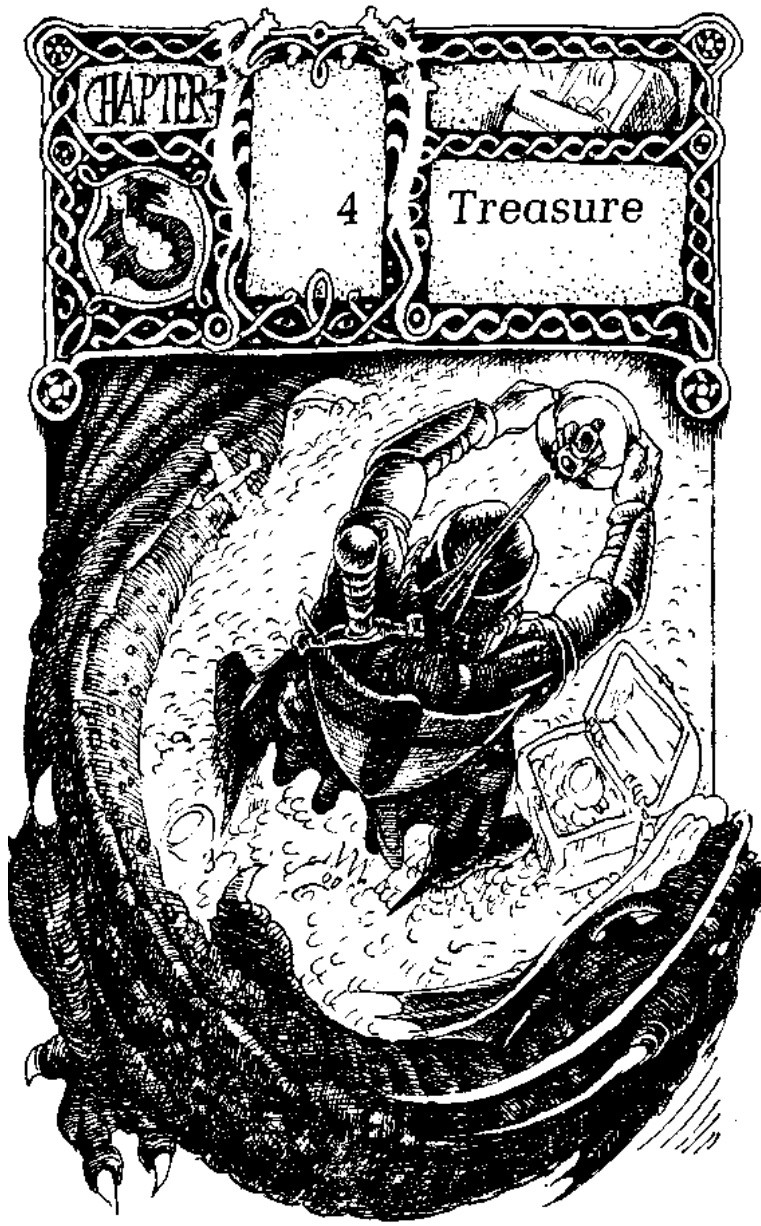
Way to fail your Perception roll buddy--- WHAT DO YOU MEAN WE HAVE TO WAIT UNTIL BOOK 4 FOR PERCEPTION ROLLS
We later get Treasure tables! I'm sure everyone loves them. After some points in trading in magic items (protip: selling enchanted trinkets in Medieval Fantasy Europe isn't the easiest thing) we get to the tables for specific types of magic items, like potions and amulets and whatnot. There's a metric fuckton of them: some are common (Strength or Healing potions, for instance), while others less so (Virus Lunare, an evil potion fed to a prisoner that must then be slain by the Sorcerer's own hands, to make the corpse rise as a Zombie bound in service) There are also many artifacts, and the GM is encouraged to make their own and change the details on the ones already present so that players don't cheat by reading through Book 2
 . There are magic carpets, evil swords with minds of their own, a holy locker that counts as two items for carrying purposes but stores up to ten, the Sceptre of the North ("invented by the Companions of the Ice, reclusive priests of the nemesis-god Angaril"
. There are magic carpets, evil swords with minds of their own, a holy locker that counts as two items for carrying purposes but stores up to ten, the Sceptre of the North ("invented by the Companions of the Ice, reclusive priests of the nemesis-god Angaril"
 ) and Orric's Slates, a pair of tablets that reproduce what is written in the other and
holy crap they're literally Multiplayer Notepad.
Another type of magic object is
relics
, a fragment of a saint's mortal remains. They all share the common power of detecting evil, and depending on their level (holy, saintly, perfect or godly) they may have extra powers, like increased Attack and Defence against the undead, immunity to fright attacks or vampire mesmerism, or the ability to exorcise Ghosts. It's up to the GM whether Sorcerers may use relics or not: they're not evil, but "the power they use is intrinsically pagan." Abbeys prize relics, as they confer status on them, and monks may pay well for them - or, if they see any excuse for deeming the (hopefully not too high-ranked) owner unworthy, they may simply confiscate the relic and throw the owner out.
) and Orric's Slates, a pair of tablets that reproduce what is written in the other and
holy crap they're literally Multiplayer Notepad.
Another type of magic object is
relics
, a fragment of a saint's mortal remains. They all share the common power of detecting evil, and depending on their level (holy, saintly, perfect or godly) they may have extra powers, like increased Attack and Defence against the undead, immunity to fright attacks or vampire mesmerism, or the ability to exorcise Ghosts. It's up to the GM whether Sorcerers may use relics or not: they're not evil, but "the power they use is intrinsically pagan." Abbeys prize relics, as they confer status on them, and monks may pay well for them - or, if they see any excuse for deeming the (hopefully not too high-ranked) owner unworthy, they may simply confiscate the relic and throw the owner out.
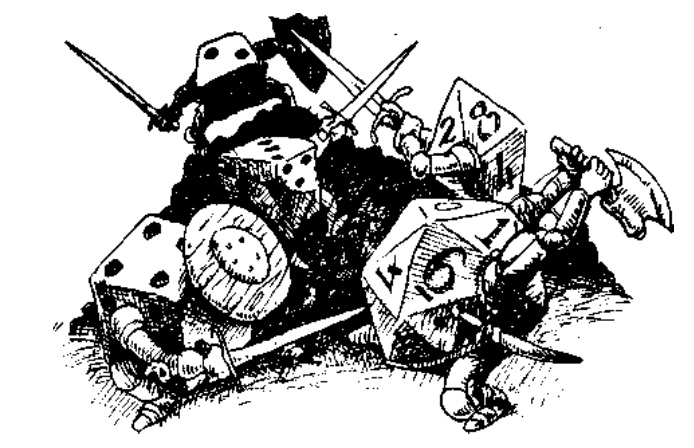
There is absolutely no context for this picture. I am sure you will agree it needs none.
Next: Briton goasts and Sid Meier's Civilization.
Up yours, Fantasy not-Romans
Original SA post Dragon Warriors: Book 2Up yours, Fantasy not-Romans
We end this book with two adventures. In the adventure presented in Book 1, we learned that the local lord was Baron Aldred. We were also told that his lands bordered with those of Baron Grisaille and the "Elfin Earl" Montombre, ruthless lords said to be no friends of Aldred. The intrigues against the Baron are the framing device for this book's adventures.
The first one, A Shadow On The Mist , is a basic adventure for characters of 1st-3rd Rank, best suited for a party with a high concentration of Sorcerers and Mystics. Convenient! Characters will start at their home base of Axbridge, performing their morning combat drills and whatnot, when they are visited by Notker, the lord's bailiff: Sir Beorn , the Baron's steward, wishes to speak with them at once. Notker is a no-nonsense Crusades veteran that loathes people living by their wits (like, say, adventurers), so players should realize something big is afoot. Beorn himself is a gruff man that wastes no time in small talk: the characters have to go to Hob's Dell , a place believed by the locals to be haunted. Beorn needs HARD MEN not scared of old wives' tales to go there, with a reward of 150 Florins and one tenth of the treasure they find there. Beorn is not to be trifled with: he won't accept negotiations, either dismissing the party immediately if they try or simply lowering the reward by 50 Florins.
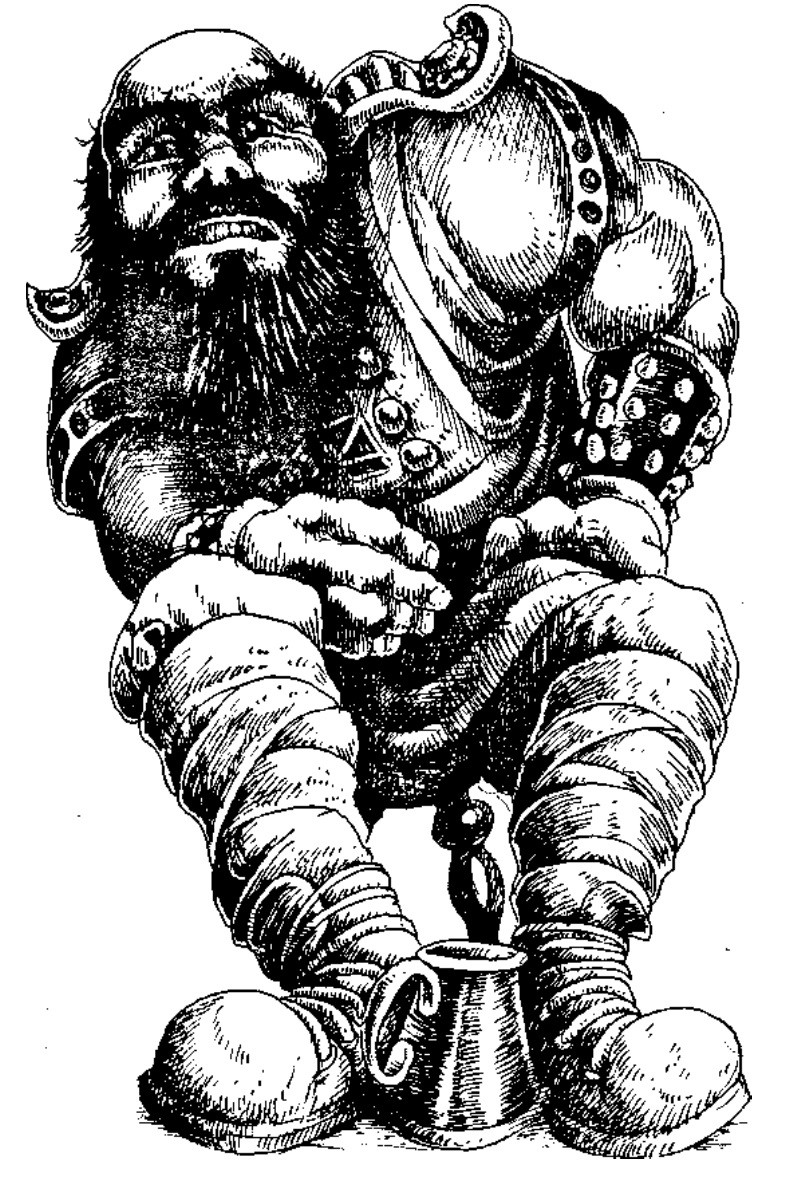
This is Beorn. He's kind of a dick! Also I have no idea how he's sitting.
If they accept, Beorn will tell them that the baron's tax collector passed through the village of Norham from Axbridge a couple of days ago, with four manors' worth of taxes on him. His horse was seen limping back into Norham without him hours later. The taxes were missing, as well as a fine sword Beorn had sent as a gift for his brother. Beorn doesn't care about the tax collector's fate, but he wants that sword back, and if taxes are not recovered the peasants will have to pay twice this year. It's patently obvious that Beorn doesn't give a fuck about the peasants, and characters may spot some flaws in his story: why does he assume the tax collector is near Hob's Dell? The truth is that the sword conceals a message, incriminating Beorn in a plot against the baron. The tax collector, Harald, overheard Beorn talking with his men, realized what was afoot, and departed Axbridge immediately. Beorn and his men pursued Harald , and his horse did throw him near Hob's Dell for reasons we'll learn later: Beorn's men took the taxes for their troubles and slapped the horse back into Norham. Beorn is all but certain that the sword will never be recovered, but he wants to make sure the message is gone for good, and hopefully without drawing undue attention - if his fellow plotters heard of it, they might just decide he is a liability.
A day and a half's journey later, the party will reach Norham. The GM is advised not to use random encounters in this adventure: it will be hard enough. Norham is a sullen place, with little love for adventurers and vagrants. Characters will need to play nice with the villagers and grease their palms with silver if they want to learn what happened, or go into Hob's Dell without critical information. If they get into the villagers' good sides, they'll learn that the tax collector rode into the village some days ago as if the Devil himself were after him, pursued by two men on frothing chargers. Some time later, his horse limped back into the village, shivering and trembling as if it had been ridden all night. The saddlebags were slashed open, and the men passed by the village soon later, nervous in the manner of people that have committed an evil deed. The villages are sure that either the two men overtook the tax collector and murdered him near Hob's Dell, or Gardener Jack took him: either way, he won't be seen in this world again. Questioned on Hob's Dell and this Gardener Jack, the villagers will say that the Dell is a hollow north of Norham Wood, enclosed by a fence of iron built by Saint Ambrosius long ago to keep the evil of the hollow trapped inside forever. It's permanently shrouded in fog, even in the hottest days of summer. Gardener Jack is the name given by the villagers to the monster living there: they are completely convinced of its existence, but each villager has a different idea of what Jack looks like, and in fact no one present has seen it with their own eyes. Jack is also said to lurk near the Dell, luring travelers inside, but at the same time he is trapped by Ambrosius' fence. The villagers are scared, but strangely proud of Jack, as their own local bugbear.
The next morning, the characters will arrive at Hob's Dell. It's a dismal, morose place, covered in fog and enclosed by an iron fence as the villagers said. There are some gaps in the iron railings, but none large enough to squeeze through. Eventually, they'll arrive at a gate, locked by a heavy chain with a large black crucifix hanging from it: they'll also see a bloodied tatter of cloth hanging from one of the fence's sharp spikes. The crucifix is actually tarnished silver, and may be sold for up to 200 Florins if melted, but removing it is not a good idea: See Enchantment powers will detect strong magic coming from it. Climbing the fence is easy, fortunately(difficulty 6, 5 if someone provides a lift up). A path circles the Dell, with one branch leading into its center. Characters may get lost if not following the path (20% chance per minute), and the terrain is rough outside of it (halving movement rates). Finally, the fog restricts visibility to 30 meters, and beyond ten meters things only appear as shadows in the mist. "Gardener Jack", of course, is not affected.
Following the circling path to the left, they will first come across a sarcophagus , with the words QUIESCO MANEO CUSTODIO on it. Lifting the slab will require 35 Strength points, combined. Only a clutch of bones remain inside, and characters have no way of knowing these are the actual remains of Saint Ambrosius, who fell sick as the fence was being built and asked to be buried here to keep the evil of the Dell trapped. However, if any player says this had to be the tomb of a good or holy person, the GM is to take them aside and tell them they feel in their hearts they are looking at the bones of a saint. If Knights are in the party, the GM should remind them it is the custom in Medieval Fantasy Europe for Knights to keep saintly relics: a relic of Saint Ambrosius, stored in a sword pommel, gets +1 to Defence and Magical Defence when under attack from the undead. Further on, they'll find a trail of blood : if it belonged to the tax collector, he must have been badly wounded. Suddenly, a Zombie ! Other than its 15 HP, it's not too tough, and characters may actually run away from it easily. The Zombie will pursue the characters, complete one circuit of the Dell and then return to its grave. The GM should keep track of any monsters they leave behind this way, and the party may end up with quite the entourage if they keep fleeing. The party splits here on north and south branches, that later reunite: the north branch has another Zombie , while the south branch has a sword lying in the field , the weeds and fungi of the Dell seemingly shunning it. It is a +1 sword, pointing inside of the Dell.
Onwards, the characters will find an isle on a stagnant pond , with little of interest except for a swarm of freaking bats that will jump the characters. The bats are weak, but characters bitten by them have a 5% chance of contracting a wasting disease that will reduce their Reflexes in 1d4 unless they get a Cure Disease in a month. Dickish! Following the river at the far end of the Dell (where the fog ends sharply, the far shore almost completely clear), they'll finally come across Harald's corpse , swinging in chains and shackles from a pole. Other than a gaping wound in his shoulder, there is no other mark of injury on him. Harald seems to have died reaching for the sword on his back, which characters may find strange as he had another, more readily accessible sword in his hilt. The sword in the back, of course, is Beorn's sword, with the message revealing the plot against the Baron's life in two weeks hence. The document alone would be enough to have Beorn and his conspirators beheaded. Oh, and because these are PCs, Harald has 20 Florins in his money pouch.

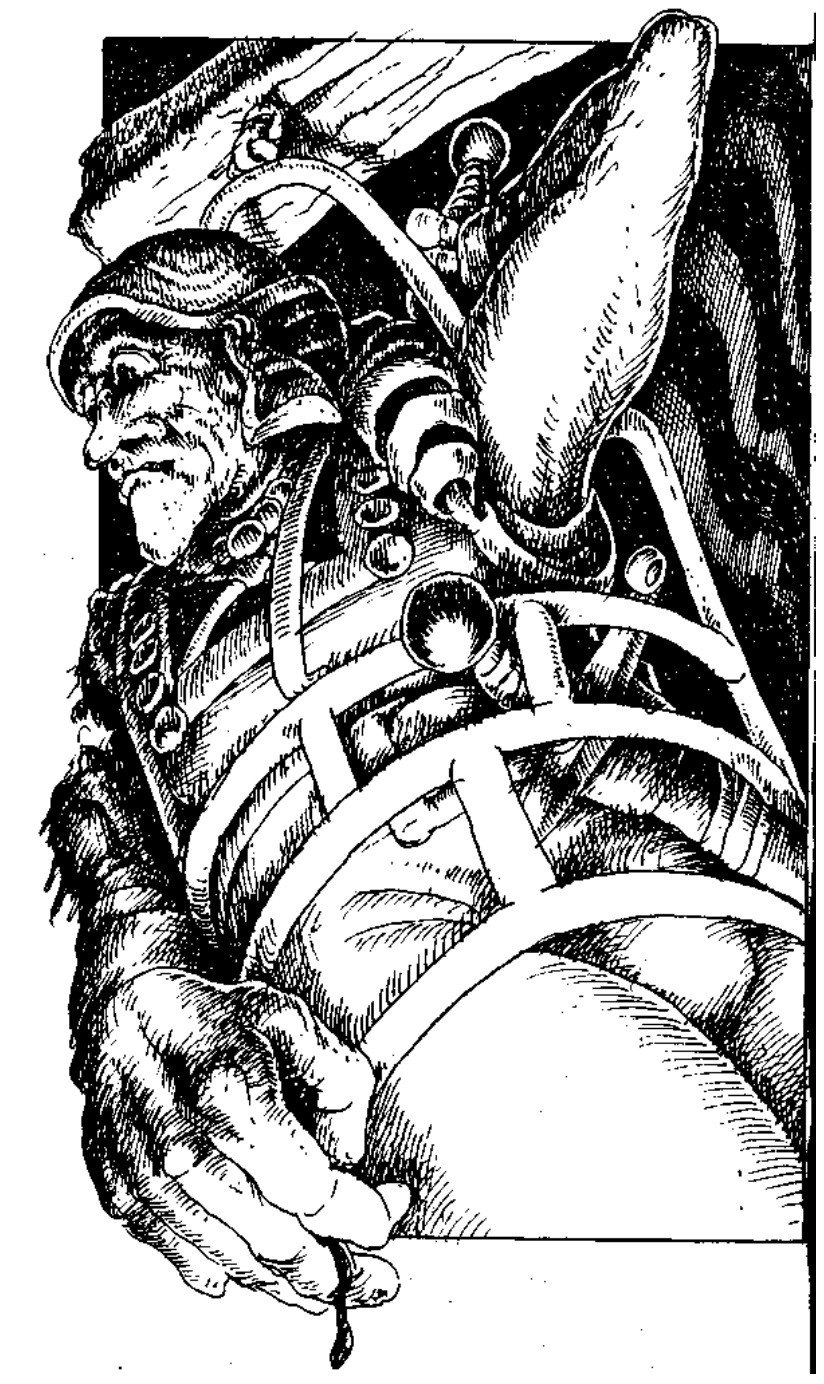
Alas, Harald, we hardly knew ye.
The party may also find an Elf Sorceress, Taliriana , hailing them from the far bank of the river. Taliriana is kind of a jerk (she'll try making the PCs cross the raging river across large stepping stones, some of which are illusions cast by herself) but she knows the real history of the Dell. She may tell them, or the PCs may find out later, that the Dell is "Tuannon's garden." Tuannon Dur was the grim king of these lands, a thousand years ago. When the legions came, Tuannon fought hard, piling the skulls of legionnaires high at the foot of his throne. Eventually, the crack VI Legion under the command of Flavius Venturo broke the back of his army, and he fled into the hills to fight a guerrilla war against the invaders. When Tuannon finally died, his druids and warriors took him to a secluded hollow in the hills, and five of his oldest thanes chose to remain with him. Perhaps some strange magic was worked, or perhaps Tuannon's warrior spirit simply would not rest with invaders in his homeland, but the fact is that he returned as a Wight, haunting the area even as the legions were recalled to defend their crumbling empire. Travelers soon learned to fear Hob's Dell, and four hundred years ago, a man named Ambrosius learned of the evil lurking there. The rest is history. The Wight is still imprisoned there thanks to Ambrosius' works (the lynchpin of which is the silver crucifix - and that's why it's a bad idea to remove it), but it can use its spells a little way beyond the fence. That is how it scared Harald's steed. Even without the crucifix, though, it cannot cross the river: there is a large stone cross monument strengthening the river boundary that the Wight cannot overcome.
Going back to the gate following the fence, characters may find a rusting glaive : it has a curse with a Magical Attack of 20 that will cause characters to dissolve into the fog until they let go of the glaive. It is, incidentally, pointing in the opposite direction of the enchanted sword they found: that is to say, a lichen-covered sundial by the center of the Dell, with carved numerals inlaid with gold. A faint inscription can be read under the lichen: DECUS ET TUTAMEN. Under the sundial's gnomon, there is a sparkling jewel with a band of gold around it. It has these words engraved on it: "Sunlight, banish. Sky-jewel, sear." If the description is recited while the jewel is being held, one of two things happens: during the day, the fog rolls back 20 meters away from the jewel, letting sunlight in. If the Wight is nearby, it will flee back to its tomb in terror. During the night, the jewel bursts into a brilliant flare, stunning any undead within 20 meters for 1d6 rounds. The jewel works only once before turning to ash, and its powers do not function outside the Dell. The gold in the numerals can be chiseled away with a knife, this will net characters some ten Florins.
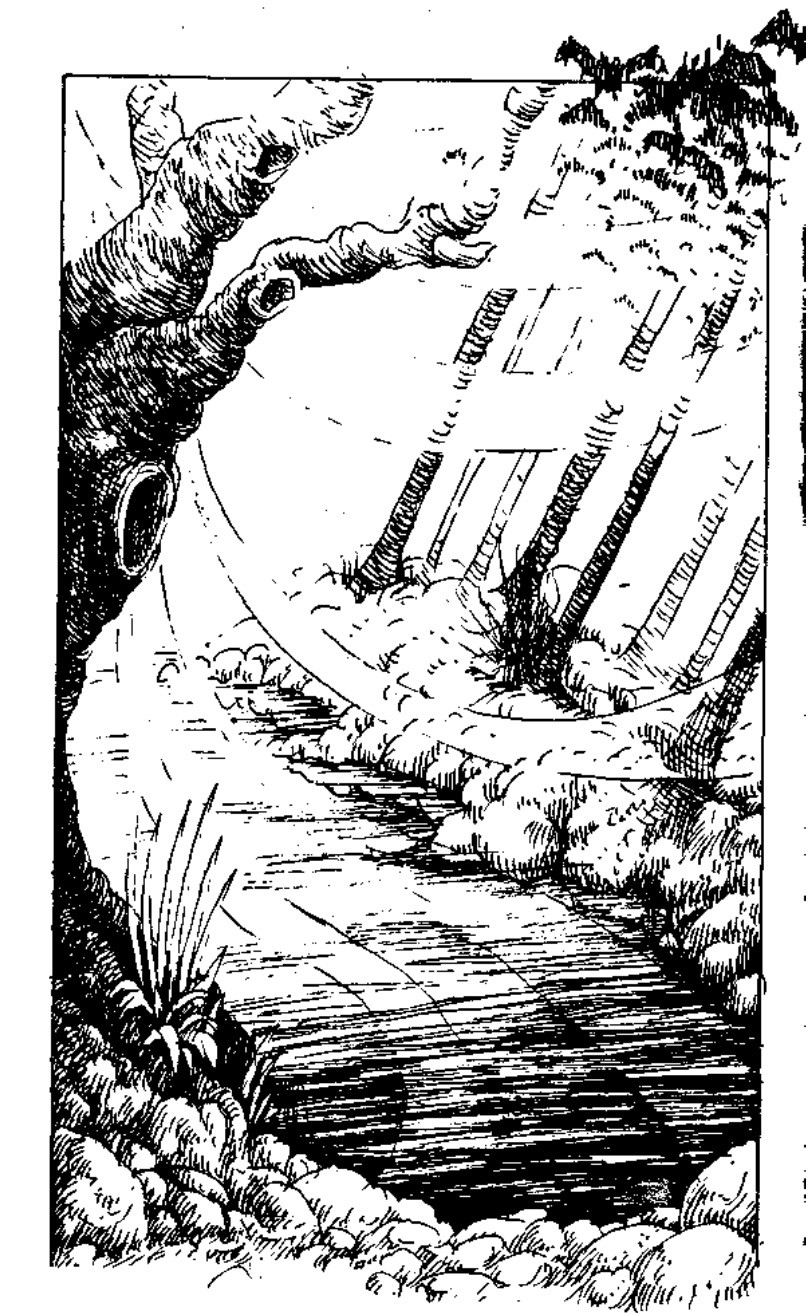
I kind of dig the non-character illustrations.
So, after the characters deal with a couple more Zombies (one of which is buried and will ambush the characters from the ground, oldschool style; the other has 24 HP !), on with Tuannon's Tomb! This is where the characters are most likely to find the Wight, unless they removed the crucifix. The Wight, if they haven't ruined Ambrosius' boundary, will be alerted to their arrival by the five chattering skulls at the entrance of the tomb. Tuannon is a little weaker in close combat than Morgrim, the Spectre end boss in The King Under the Forest, but it has access to spells this time, as well as the partial immunity to non-magical weapons common to Wights (normal weapons only deal half-damage for one blow, then they shatter as if consumed by centuries of rust) It will also summon any surviving Zombies from the Dell to aid it, and if the party flees, it will pursue them - beyond the Dell, if they removed the crucifix. Slaying Tuannon will not get rid of him forever: eventually, it will return as a Ghost, and then as a Wraith. PCs won't be affected by this, as they will be long gone by then, but this is why the crucifix must stay: as long as there are invaders in his land, Tuannon will not rest easy. His tomb has his funerary treasures (about 500 Florins' worth.) and the headless skeletons of his thanes. No worries, they are properly dead and will not rise.
The weary adventurers, after leaving the Dell, will soon come across Beorn and his henchmen. They have to think fast: either they hand over the sword here, as well as the treasure, or they attempt fleeing away from or through them and reach Baron Aldred's castle. Blackmail is out of the question: Beorn will have them neutralized one way or another. Beorn and his men are not that though (the henchmen are two 1st Rank Knights, Beorn is a 3rd Rank Knight, and he rides a Warhorse) but after the Dell, characters will be pretty beat up. If the party flees the men, a cat and mouse chase begins: the adventure leaves the GM to come up with encounters here, but the Baron's estates lie several days to the east, and it mentions that characters traveling cross-country will have to go through either "the marshes around Fenring Forest" or "the menacing Jewelspider Wood." If they somehow get the message to the Baron, they will be richly rewarded: at least 100 Florins each, and the chance to become the Baron's retainers. XP rewards are 5 XP for surviving the adventure, plus monster bonuses, and an extra 3 XP for revealing Beorn's plot.
Next: Sid Meier's Civilization, for real. Don't look at me, it was longer than I thought.
Grognard demigods
Original SA post Dragon Warriors: Book 2Grognard demigods
The next adventure, Hunter's Moon , takes place after A Shadow On The Mist and is meant to be a continuation of it. Baron Aldred is undertaking a dangerous sea journey in the middle of winter, with the accompanying lousy weather and storms, to meet one Duke Carnasse in Port Beltayn in order to strike an alliance against Aldred's enemies in the south. The PCs are on Aldred's ship as well. If they managed to expose Sir Beorn's plot in the previous adventure, they are there at the baron's invitation, and he is considering making them permanent retainers if they perform well on this mission. On the other hand, if Beorn's treachery is still a secret, it is the steward himself who brought the PCs in: he wants to sabotage Aldred's mission, or even kill the baron if the chance presents itself, and he'll either try to bring the PCs into the conspiracy or set them up as scapegoats if necessary.
After riding out one particularly nasty storm, Aldred's ship will lose her mast and start taking water in. The crew oar to shore, as the captain spots some fir trees that would make for good timber for emergency repairs. As the ship reaches a sheltered bay, lookouts spot a ruined, half-flooded citadel by the coast: Aldred orders the characters to explore the citadel while the ship is being repaired, in order to prevent any ambushes while it is vulnerable. They are to salvage anything of value and slay any monsters they find, but they must return and report immediately if they find men or overwhelming forces. And so, off they go!
An hour's worth of travel later, they reach the citadel. It is of strange, alien architecture, and something went terribly wrong here: countless mouldered bones and rusty arms are strewn across the entrance and the plaza. In the shadow of the entrance gate they will find a blind old man , who will tell them he is the gatekeeper of the citadel of Karvala , waiting there until his lord returns. If questioned, he will say that Lord Karvala and his ninety sons were driven from their homeland centuries ago, cursed to wander forever until they could build a hall "not in the earth, nor in the sea, not in fire nor in air." After years of travel, Karvala saw a child build a castle of sand here and, inspired, built this citadel. Here he dwelt with his sons, and the sons of his sons, until a new people came from across the sea, with new laws and new gods. Karvala shut himself in his tower, in order to determine how best to get rid of the "sea-pests", but the invaders bewitched him, causing him to fall into a deep sleep. They set wards on his tower, locked his doors, and slew his people. But the gods were angered, and sent fire, plague, earthquakes, sea and goblins against the occupied citadel. Still Karvala did not wake, and it was decreed that none should live in the citadel until he comes again to choose the worthy. The gatekeeper will not try to stop the characters from entering, but will warn them that death lurks here for those who do not love Karvala: if threatened, he will disappear, and the PCs will see a black dog leaping through the ruins away from them.
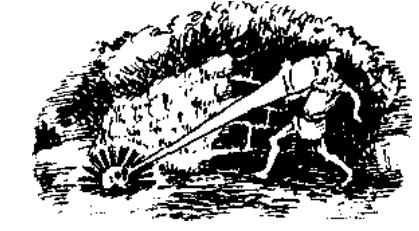
I don't even
The citadel itself is ruined, broken buildings and bones (human and otherwise) all over the place. The main square is dominated by a black obelisk , covered in geometrical patterns and glyphs. There is no obvious entrance, however. The other buildings of interest are a small hexagonal edifice with a domed roof, and a fortress with four massive square towers. And imagine that, the PCs will spot someone watching from a high window in the fortress, who ducks back as they look up.
The fortress is just as ruined as the rest of the citadel, but the towers seem marginally more intact. Going into the northernmost tower, where the window with the someone is, characters will see a decayed staircase leading up to the first floor balcony. A woman in a white gown stands there looking at them, but will turn and move away if called: she is, in fact, a Spectre, and her intention is luring the characters into the unsafe stairs. They will collapse under the weight, and then the Spectre will leap on them, fright attack and all. Climbing into the balcony is risky too: 40% chance of it collapsing. Hidden in an alcove off the balcony is the Spectre's treasure: a black wood drum and a pewter cup . They're both magical: if the drum is taken to a coast and pounded, it will summon a longboat manned by oarsmen with long, seaweed-matted beards and skins blue with cold. The longboat will take the drummer and up to six companions anywhere they wish to go, and the oarsmen are tireless - and not truly alive woooo . As for the cup, there are eight gems set around the rim. Seven are dull, but one glows brightly. The glow moves on from gem to gem as the cup is turned, and with some experimentation, the PCs may find out the cup is some sort of compass, the glowing gem always pointing north. It can be worth up to 4,000 Florins! Aside from this, there is nothing else of importance in the fortress.
As for the hexagonal edifice, it is set over a flat pyramidal base. The feet of a huge statue flank the pavilion, and the door is decorated with a grinning skull over a crescent moon. Two stone hounds guard the entrance: if characters attempt to enter the temple, the Moon Dogs come to life and attack the intruders until slain or the intruders are dead or driven away from the Temple of the Moon they guard. They will return to their original positions and revert to stone if successful: this will restore all of their HP (and they have 23 HP and an Armour Factor of 6 each, so...
 )
)
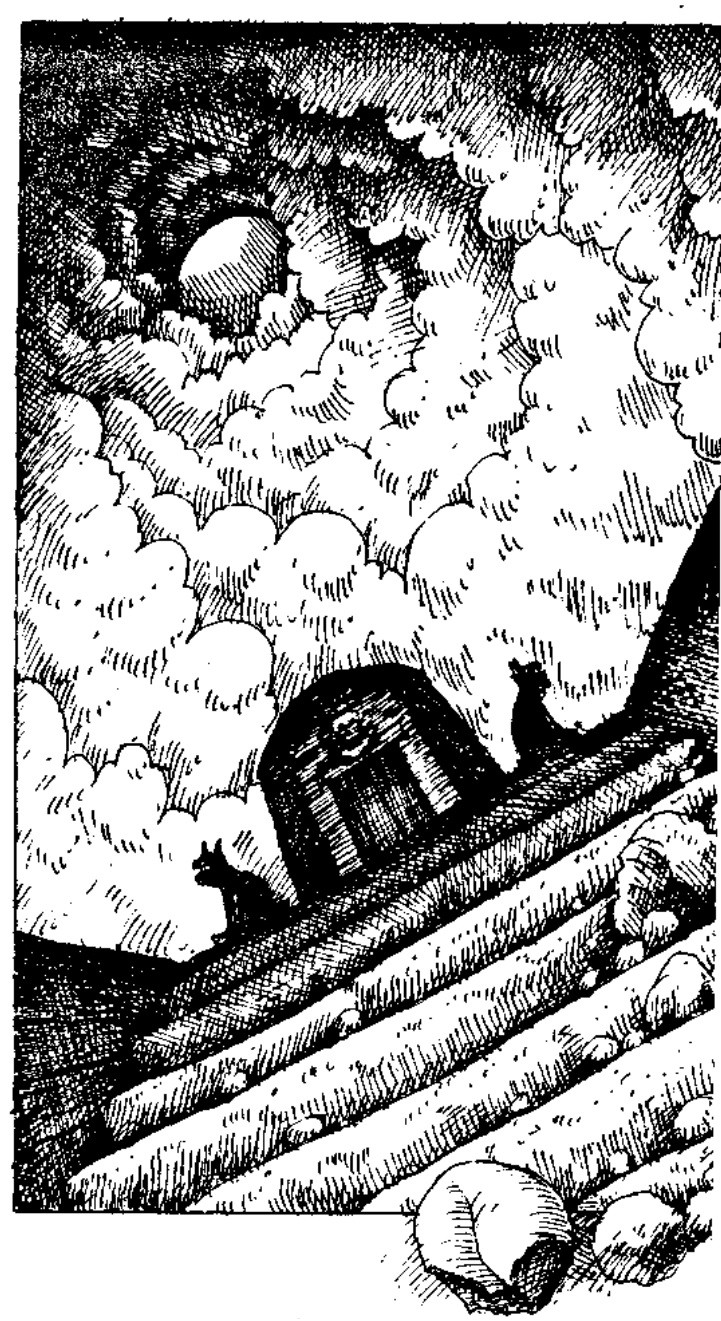
Spooky!
The temple has been obviously ransacked, but it is still impressive: the entrance chamber is elaborately engraved with spiral patterns. There are three skeletal corpses on the floor: one wears scraps of ceremonial robes and holds a staff , which will hit anyone that touches it with a Magical Attack 25 Curse. There are stairs leading down into the priestly quarters and inner chambers of the cult. Looters reached even here: they will find debris and some silver coins scattered as they descend the stairs. Decay has set here as well: one living quarter, for instance, has a chest , booby-trapped to fire a poisonous snake at the would-be thief... only the trap mechanism has rusted, the snake is long dead, and whatever was on the chest has been consumed by mold and time.
 One room shows signs of heavy fighting, bones of invaders and defenders strewn together, and holds a
Ring of Agonizing Doom
(which fires a Speed 16, 2d8-AF bolt) with six charges, along with 500 Florins' worth of silver chalices and bowls. They feel somehow evil to the touch, though, and won't fetch that price until purified by a cleric. Some bad shit was afoot here: there is a set of cells with the mouldered remains of several captives, most likely starved to death. There are carvings of victory in war against barbarian tribes, and one dormitory has a
tapestry
depicting ghastly scenes of sacrifice, necromancy and worse rites conducted before a pale-skinned, androgynous demon. The tapestry is so horrible and evil that anyone trying to burn or slash it will be hit with a Magical Attack of 15 that, if successful, will render them insane until hit by a Dispel Magic, and even then, the moon high in the sky will cause them to be uneasy for the rest of their lives.
One room shows signs of heavy fighting, bones of invaders and defenders strewn together, and holds a
Ring of Agonizing Doom
(which fires a Speed 16, 2d8-AF bolt) with six charges, along with 500 Florins' worth of silver chalices and bowls. They feel somehow evil to the touch, though, and won't fetch that price until purified by a cleric. Some bad shit was afoot here: there is a set of cells with the mouldered remains of several captives, most likely starved to death. There are carvings of victory in war against barbarian tribes, and one dormitory has a
tapestry
depicting ghastly scenes of sacrifice, necromancy and worse rites conducted before a pale-skinned, androgynous demon. The tapestry is so horrible and evil that anyone trying to burn or slash it will be hit with a Magical Attack of 15 that, if successful, will render them insane until hit by a Dispel Magic, and even then, the moon high in the sky will cause them to be uneasy for the rest of their lives.
Other than more ruins, worm-eaten scrolls, and some 100 Florins' worth of tainted gems, the most interesting thing in the temple is the main cult room , where the party will find nine warrior Skeletons standing to attention, pointing their scimitars back the way they came. The Skeletons wear a silver torc around their necks and a serpentine silver wristband around their left arm. The Skeletons will only attack if the PCs attack first or refuse to leave the room: if characters go back, the Skeletons will march on and escort the party to the ossuary (see below). If slain, the wristbands will become real snakes, hissing at the characters - they are harmless illusions, in fact, and the torcs are worth 60 Florins each. The cult room also has two long-dead bodies in ceremonial robes: they seem to have been in the middle of some ceremony, centered around a pattern of painted designs and brass censers. In fact, they had just summoned a demonic entity before the reavers slew them: if characters disturb the pattern, the long-trapped demon will break free, striking the party with a fright attack of 2d6 before returning to its own plane along with the souls of anyone killed by its attack. Any soulless body will arise as a Ghoul three days later, unless cremated or buried on consecrated ground. Loot in this room includes 200 Florins' worth of ritual equipment, just as tainted as the rest of the temple loot, and two staves (spellcheck doesn't recognize staves, but staffs. What gives?) held by the corpses. One is as cursed as the one at the temple entrance, the other can be used by a Sorcerer to cast Illusion and Phantasm at half their MP cost.
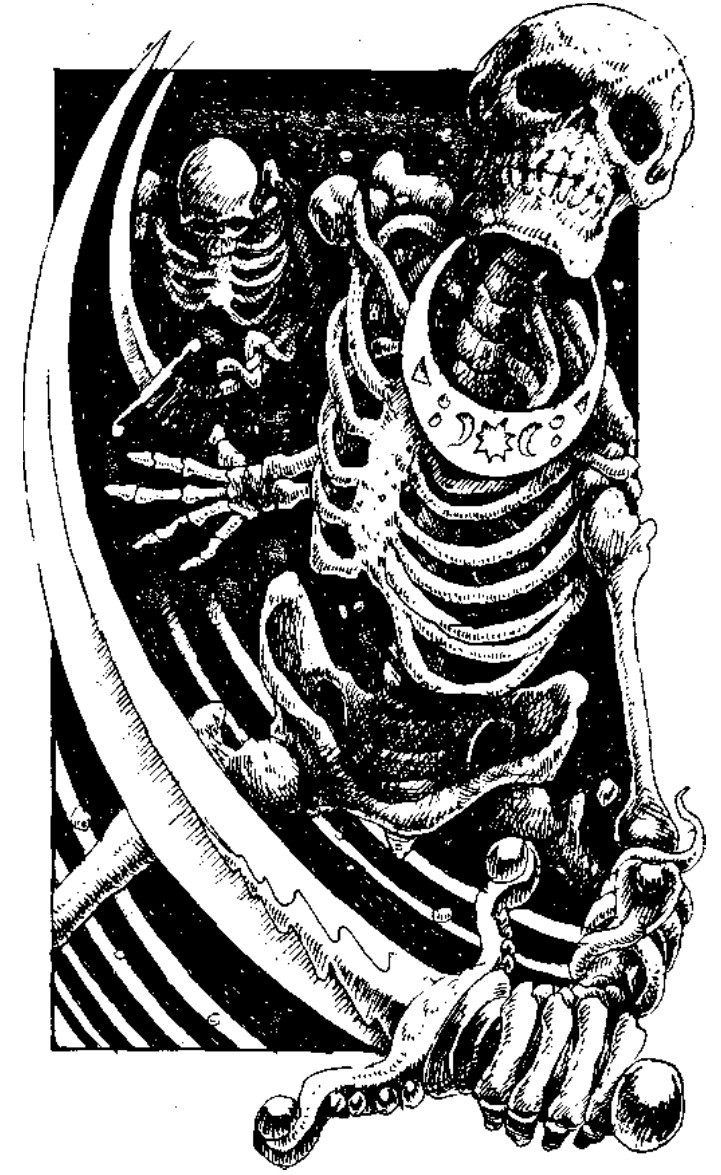
It's okay, they're not entirely bad guys.
The ossuary where the Skeletons will escort the characters if they let them is north of the stairs they used to descend into the chambers. Another staircase leads further down here, towards a twisted door stained by seawater at the bottom. It is blocked by a large black bar , covered in sigils that seem to warn to turn back: if characters do not search, when lifting the bar they will trigger a stone slab of Speed 12 dropping down on their heads. Anyone that fails to jump away will be crushed by it. Further on, a small dark corridor leads to a newel staircase leading up, without any windows or doors. Climbing up, characters will realize after a while they should have broken into the surface by then: in fact, magic has transported them inside Karvala's obelisk.
After a very, very long climb, characters will reach a circular room, moonlight streaming through the windows. There are twelve chairs set around the room, etched with symbols of the moon in its various phases. There is a strange pattern of lines and symbols in the floor, and wooden playing pieces representing men, beasts, cities and forests in seemingly random positions on the pattern. If a character or characters sit on the chairs, they will find out that their non-sitting companions are gone, and that a gaunt figure seems to step out from the silvery moonbeams - Karvala himself! He will welcome them into his Game , in a friendly manner: he seems to be expecting a long, protracted game. Following Karvala's initial moves, characters will realize they can move the pieces with their mind. They must roll their Intelligence or under in 3d12. A success indicates they have won a small advantage, while a failure indicates that Karvala's mastery of the game set them on the backfoot. They may attempt the roll again... the next day. Karvala is only too happy to interject urbane conversation as they play.
To win Karvala's Game, they must succeed on the 3d12 roll ten times in a row.

Meanwhile, non-sitting characters will see the players of the game turn grey and insubstantial on the chairs, staring with rapt attention at the pieces on the floor, gripping the arms of the chair with white knuckles. Karvala will appear to them as well and talk to them as he plays the Game with the trapped characters - he's a demigod, he doesn't care about silly things like only being in one place at the time. Karvala will ask the characters what they would give to rescue their friends : this part is basically pure conversation, no dice rolls involved. Characters have no meaningful way to threaten a being as powerful as Karvala, and earthly pleasures and wealth mean nothing to him - he will demonstrate so by turning moonlight into gold, or making showers of gems fall from his hand and disappear into the floor. However, trapped in his self-imposed exile from the world, he yearns for new experiences, and he is likely to accept if characters promise to bring him some wild new experience from the outside world. Once a bargain has been made, Karvala will release the seated characters, give each a magic torc, and teleport them back to the citadel gates. The torc cannot be removed, and will transport the party to Karvala in a year and a day to fulfill their side of the bargain.
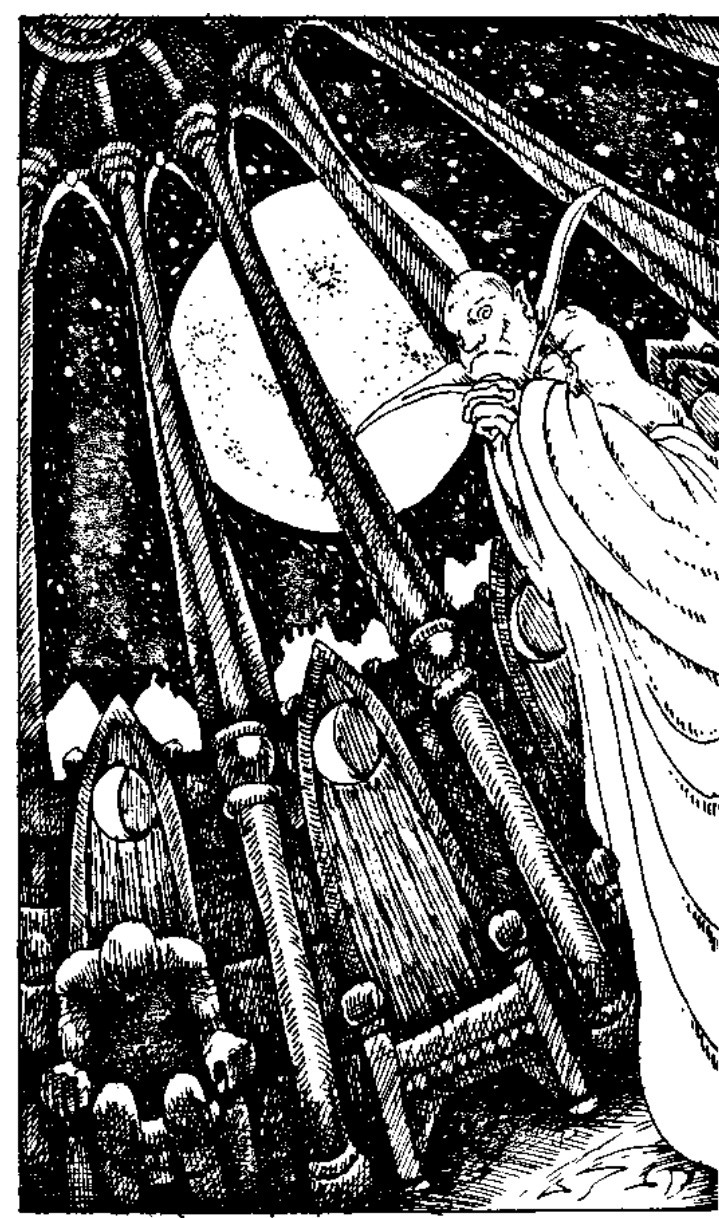
Karvala's eyes are fucked.
As for the baron's ship, it will take two days to return her to seaworthiness. If characters are not back by then, Aldred will set sail without them: his mission cannot be jeopardized. If they manage to return, they will have to hand over the loot they found, but the baron will be kind enough to return the items he deems best suit the party, up to half the value of the treasure they find. As for the torcs, if they are wearing them, the baron will realize powerful sorcery is at work and won't fault the party for not being able to hand them over. However, characters will find out that they can't talk or write about what they saw in the citadel: Karvala keeps his secrets well.
Oh, and if characters cannot think of anything to entice Karvala with, he will suggest to bring him the sword from the tomb of Elvaron the Elf, a powerful Sorcerer of ages past. Guess where we are going in the next book!

Next: Book 3, The Elven Crystals!
A forest of dickery
Original SA post Dragon Warriors: Book 3A forest of dickery
Welcome to Book 3, The Elven Crystals! This book has some extra rules, but it's mostly a scenario book for DW. It is also considered to be the most skippable of the six originals, for reasons we shall soon see.
We'll actually begin at the end of the book, explaining the new rules introduced by the book. First, we now have Morale Checks , made against certain hideous monsters, which is a d20 roll made against a difficulty of (victim's Rank+Strength+Intelligence) - the creature's Attack score. Failing to roll this difficulty or under it will make the victim flee the scene for ten combat rounds before regaining their courage, and will have to roll a morale check (at double the creature's Attack score) next time they come across it, even if circumstances are friendly. Curses are expanded, and we are told characters carrying a holy relic are immune to all curses. There is a new table for curses to roll on, with some of them having delayed effects - for instance, suffering an automatic wound during combat practice. This may happen years after the curse is cast on the character, but it can be avoided if the character does not indulge in activities that may trigger it. They go from the annoying (losing the character's next 10 attempts at gambling) to the whimsical (being turned into a toad for one combat round) to the plain dickish (having the next boat or ship they use to travel sink exactly halfway between departure and destination.) Finally, we have some rules for diseases : characters have a default 5% chance per month of coming down with a disease, a chance that may increase if the character spend time in damp, infested dungeons, or plague-ridden cities. The save against a disease is a Strength roll: failure means they suffer the disease effects (normally, HP and characteristic point loss). They must roll again each day until dead or cured. Some diseases may be cured by normal medicine, others require the character to either shake it off or receive magic healing. After being cured, lost HP and characteristic points return at the rate of one point per week, except for Looks losses which are permanent. The table covers the Black Death, leprosy, pox, swamp fever, the Ague, wasting disease, influenza and the common cold (no mechanical effect for this one!
 )
)
After that, on with the adventures! All of them take place in the Kingdom of Ereworn , a formerly prosperous, peaceful realm once protected by sorcerous barriers erected by one archmage, Elvaron the Elf , in return for unspecified favors. The covenant for the agreement was a magical block of stone that once stood at the king's hall in Castle Ereworn, but one day the block shattered, and a massive storm covered the kingdom for a week. After the storm abated, the king's scouts reported that the land was ruined, crops blighted, people struck with plague, and evil forces infesting the woods and other dark places. A malaise came upon the realm, and little by little the king's men deserted him. The king proclaimed that the only cure was to gather the stone's three shards, opening a gateway to the realms of the dead, and travel to the planes beyond in order to seek the aid of Lord Elvaron. No one would take up his quest: it was said that a fearsome demon wolf roamed those planes, feasting upon the souls of the living. The king died, broken-hearted, and his son was foully murdered soon after. Since then, a succession of weak regents and greedy barons have ruled over Ereworn, but never for long: anarchy and lawlessness are the true masters of the land.
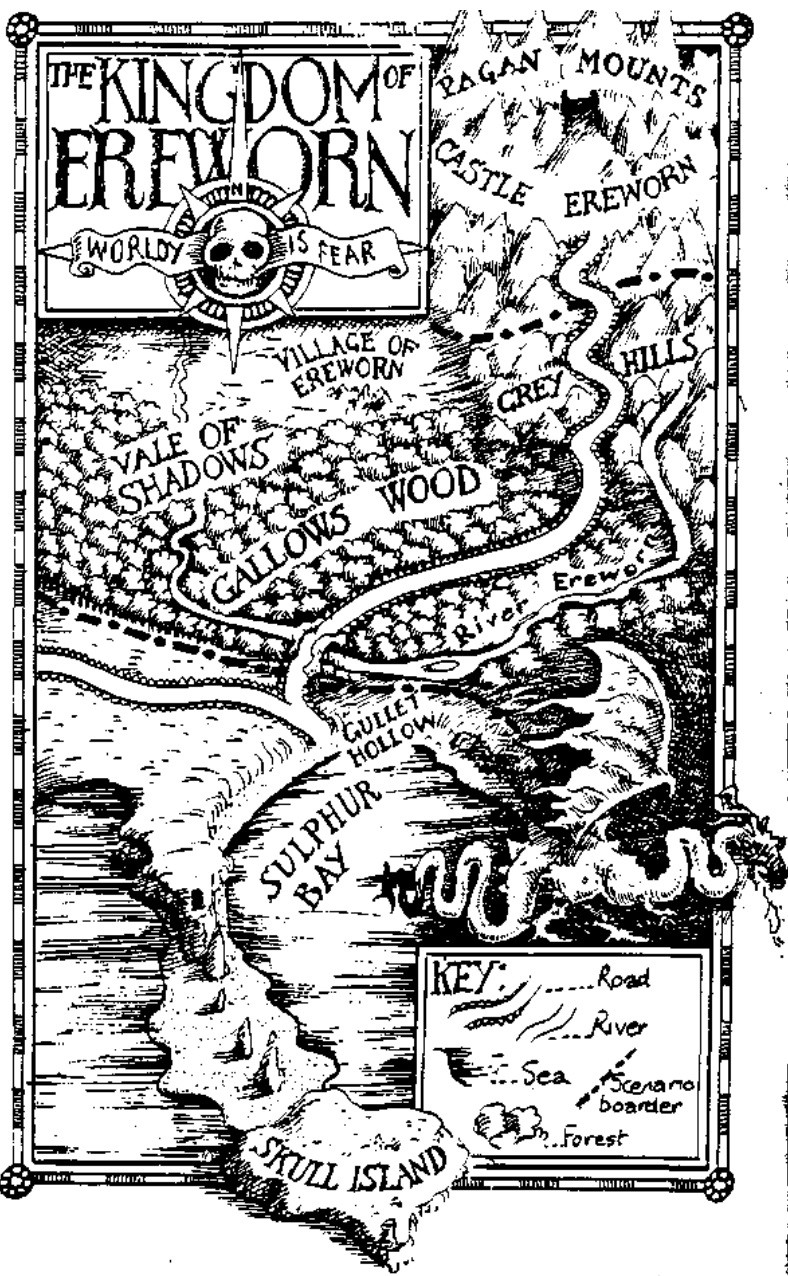
Fuck this country and everyone in it.
The first adventure, Gallows Wood , takes place in and around the eponymous woods, and is a beginner scenario for 4-6 1st Rank characters. Time is important in this adventure: the GM is given a chart to track elapsed time, and specific instructions to use it. It takes the characters half an hour to travel from one section to another, unless the adventure rules differently, and leaving the path will cost them a full hour. Random encounter rolls are made once per hour, and certain encounters are different depending on whether the characters run across it during the day or night.
The Village of Ereworn stands in the Vale of Shadows. It is ruled by the cruel Duke Darian , who has forbidden entrance to the woods on pain of death: he fears someone will find the graves of his elder brother and family, whom he murdered in order to take power. His Black Riders scour the land, extorting taxes, murdering, torturing, and enforcing Darian's rule. The forests were soon infested with vagabonds, bandits and evil monsters, and one particularly dickish Hobgoblin, Old Ned , has chosen the village as target of his trolling, ruining crops, poisoning wells and shriveling cow udders. Most of the villagers are on the brink of starvation, and they're too afraid to brave the woods and the dangers lurking within. Enter the characters!
As the characters enter the sole remaining inn in the place, they are approached by Eldron the village chief. Eldron hires the party to deal with Old Ned permanently, paying them five Crowns in advance (1 Crown = 10 Florins, yes it ruins historical verisimilitude, DW says
 ) and a further 15 Crowns once they return with the Hobgoblin's head. They are served a meal by
Clothilda
, the innkeeper's
buxom daughter
) and a further 15 Crowns once they return with the Hobgoblin's head. They are served a meal by
Clothilda
, the innkeeper's
buxom daughter
 before going off to bed. Characters wake up very early, as they hear Clothilda doing the morning chores, but suddenly they spot through the window Old Ned himself bundling her into a beer barrel and making off with her! The innkeeper offers an extra twenty gold pieces to anyone that brings her back alive, and the chase is on!
before going off to bed. Characters wake up very early, as they hear Clothilda doing the morning chores, but suddenly they spot through the window Old Ned himself bundling her into a beer barrel and making off with her! The innkeeper offers an extra twenty gold pieces to anyone that brings her back alive, and the chase is on!
As they enter the murky, ominous woods, they are beset by a figure wrapped in bandages , moaning and stumbling towards them. They have one round to react: the figure is, in fact, an innocent beggar, and if given the chance (and some alms) he will explain that he served Fabian , a magician who lived in a tower in the forest. The beggar will give the characters a gem and a parchment , saying that Fabian told him to give them to a wise man if he ever fell on harsh times. Oh, and anyone actually touching the beggar has a 10% chance of contracting leprosy.
 If characters ignore or move away from the beggar, though, he'll follow them, moaning all the time and attracting the attention of two
forest harpies
. The horrible stench emanating from them prevents any chance of surprise, but they can force morale checks. They will try capturing one of the characters and fly back with them to their next to devour them, and will flee if one of them is slain. If the harpies are triggered, however, the beggar will disappear along with his stuff. The gem is worth 5 Crowns, but it's meant to be used for a puzzle later on, and the parchment reads: "
Fabian Invites Noble Daring Men: yesterday the other warriors eagerly rode their horses ever nearer the hideous enemy: exhausted yet exalted, men of undaunted trust, hall heroes against nameless darkness, swords wielded over rising doom.
" Take the first letter from each word, and the message reads "
Find my tower, then the eye, mouth, hand, sword.
"
If characters ignore or move away from the beggar, though, he'll follow them, moaning all the time and attracting the attention of two
forest harpies
. The horrible stench emanating from them prevents any chance of surprise, but they can force morale checks. They will try capturing one of the characters and fly back with them to their next to devour them, and will flee if one of them is slain. If the harpies are triggered, however, the beggar will disappear along with his stuff. The gem is worth 5 Crowns, but it's meant to be used for a puzzle later on, and the parchment reads: "
Fabian Invites Noble Daring Men: yesterday the other warriors eagerly rode their horses ever nearer the hideous enemy: exhausted yet exalted, men of undaunted trust, hall heroes against nameless darkness, swords wielded over rising doom.
" Take the first letter from each word, and the message reads "
Find my tower, then the eye, mouth, hand, sword.
"
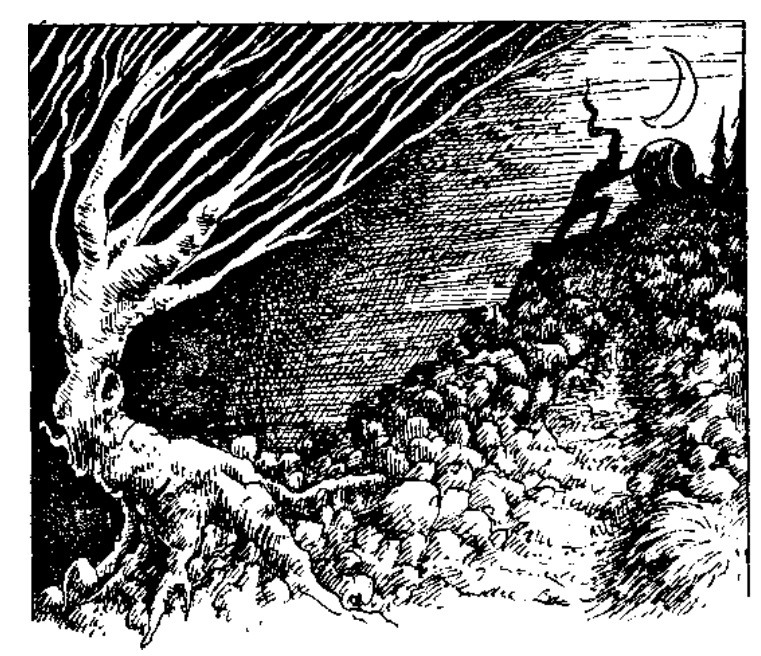
Worst Donkey Kong Country game ever.
They will come across the empty beer barrel in a clearing, and hear a cry from a hollow oak. It's Clothilda, of course, but Old Ned will make off with her before the party can do anything. The path forks East and West: going Wast takes the party to a weeping willow tree , cursed by an evil witch so that anyone stepping under its shade falls into a deep sleep for 12 hours (Magical Attack 20). It takes a 6 MP Dispel Magic to break the curse. A woodgatherer and a wolf sleep under the willow: the man, Garth , will be extremely grateful if the magic is dispelled and he is allowed to wake up, and as a matter of fact he will join the party in their quest. He's slow on the uptake, but a reasonable (if non-Ranked) fighter. Garth also knows some stuff about the woods: for instance, about the mad forester said to live in them. As for the wolf, it will attack immediately once it wakes up. If characters wait until night, the witch will show up: she is a 3rd Rank Sorcerer, who will flee if she sees she can't defeat the party. The road splits again: one road will take them to a notice by Duke Darian, announcing how trespassers will be executed. A forest imp will taunt them with it, as well as telling the characters about Clothilda and the Hobgoblin fleeing south, and then he'll try to get them to fall into a spike trap laid by the mad forester (who will actually arrive after an hour if characters have not escaped the trap by then.) Following further East, the party will come across a clearing without any clear way out: the characters will hear a hunting horn, and then an Unicorn will show up, chased by two of Darian's Black Riders and four hell hounds . The hunters are chasing the unicorn for its horn, which can be used to make potions of Intelligence. Fortunately, the party gets a surprise round on the hunters. If examined, they will discover that the Black Riders are not human, but horrible hybrid monsters, with snouts for noses. They are Wadwos, failed experiments by Duke Darian - who happens to be a Sorceror, incidentally. The unicorn's tracks, if later followed, will vanish into thin air - but it will leave its horn behind.
Further south, the trees turn to a thorn forest, and the path splits once again. Following the path means that the characters will be surprised by Thorn Demons , insect-like beings that easily blend into the greenery. They're not too tough, but three successful strikes will render any leather armor useless. Even after defeating the monsters, progressing through the regular thorn thickets south will take the party a full hour, and 20% chances of the thorns ruining leather armor by 1 point or dealing 1d4 damage to non-armored characters. Going east, the path starts climbing up, cliffs to the left and one long drop to the right: characters will eventually encounter a cave, and 20 killer bees coming for them. They're twice the size of a normal bee, will fight to the death, and their sting counts as a medium strength poison, but at least they're treated as one individual. Inside the cave, there is a massive bee hive, along with the queen killer bee. The hive was grown around a magic lyre , hung there by its elf owner when he slept. He was killed by a goblin, who missed the lyre, and its magic attracted the bees. The lyre, when plucked or when wind is allowed to blow through its strings, attract one random type of unintelligent creature to the lyre: these creatures will be neutral to whoever holds the lyre or stands near it, but will attack anyone else. There is a low passage leading further into the woods through the cave: following it and the giant footsteps they will encounter, they will find a glade with a mad old man , using a crutch with an ape-sized foot stuck to the tip. The old man will rant about "the ghostly monks of Moaning Island," and will claim to know the whereabouts of a treasure cache. If followed, the old man will take them in a circular route back to the glade for a full hour, and his "treasure" is a handful of acorns and nuts. This will also make the characters lose their bearings completely because this adventure isn't done being dickish, no, god knows it hasn't.
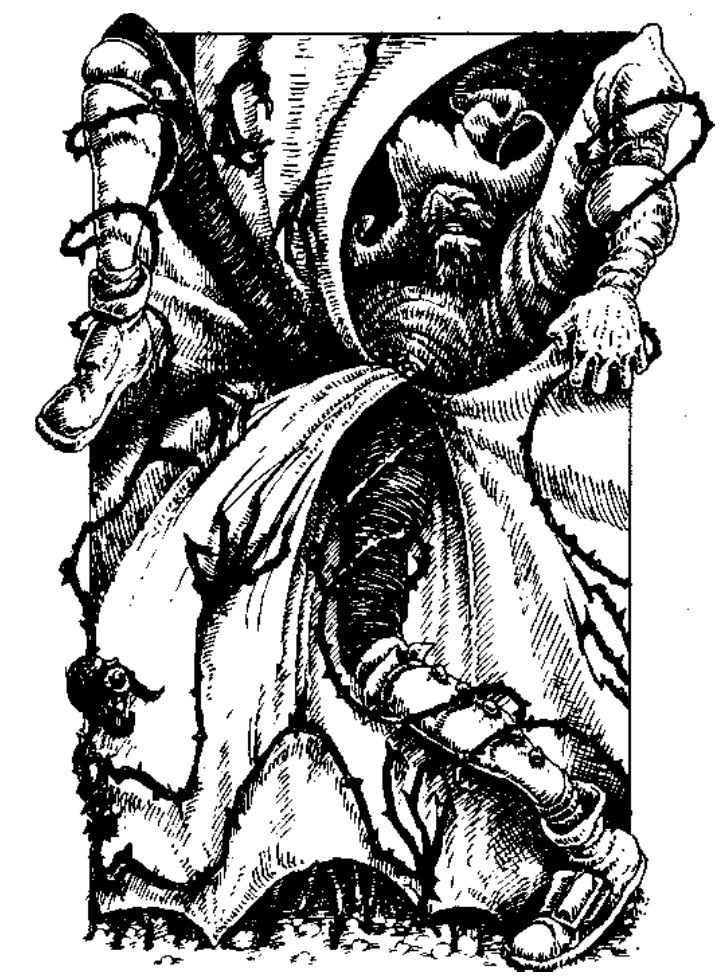
IT KEEPS HAPPENING
South through the thorn thickets, they will find a bubbling quagmire crossed by a rickety-looking bridge. The bridge is actually set up to fall, and will collapse when a combined total of 20 Strength points steps on it. A group of four swamp folk , who are Medieval European Kappa more or less, wait under the bridge to drag any unfortunates into the swamp. They're weak, but fighting them in their terrain is a bitch. Across the bridge, they will find Fabian's tower . Its ruins seem to be all that was left of a castle. A grotesque statue stands guard at the side of the long-vanished doors: it is, in fact, a gargoyle, with 3 in 6 chances of surprising the party. Gargoyles are nigh invulnerable to normal weapons (AF 7) but not so with magic weapons (AF 2), and have a 30% chance of becoming tame if a healing spell is cast on them. A search will reveal stairs leading underground, and if someone looks down the well at the center of the tower during the day they will barely make out a titanic statue holding a sword pointed sky high. There is also a fountain head with one semiprecious stone in one eyesocket, and the other empty. Here is where the characters will need to follow Fabian's instructions from the parchment: putting the gem in the remaining eye socket will stop the flow of water from the head's mouth . Reaching inside it they will find a scroll case with a Dispel Magic scroll inside of it (the stone also disarms a trap that will make the mouth stone teeth to crush the hand of someone reaching inside.) Underground, they will find there is a crypt, skeletons in alcoves and lying under the knee-deep water. Wading through the water will make some animated skeletons grab a character's ankles and try dragging them into the water, as some of the alcove skeletons grab weapons and attack. There is a total of 8 of them. As for the statue, it is the fossilized form of a Titan , and this is yet another Fuck You moment. Fabian summoned the Titan to guard the enchanted sword it holds, but gave him no other instructions. The idea is that characters use the Dispel Magic scroll on the fossilized Titan to bring it back to life and take the sword for him, but the Titan is basically undefeatable by the characters meant to run this adventure (Rank 15, Attack 25 and Defence 20, with a +4 to all Armour Bypass rolls). The adventure wants characters to tie a rope to the sword before casting the Dispel Magic, then pull as the Titan returns to life and then fleeing for their lives until the Titan returns to its own plane (it has less than an hour's worth of time in this world), but there is little to no hints for this little plan. Oh, and the Titan will take the +2 sword with him if he holds it when it's time to go home. The Titan is also pretty much unstoppable by any obstacles in its path, and it will only walk towards the sword, kill anyone who holds it, then return to its original position. Fuck you too, Elven Crystals, fuck you too.

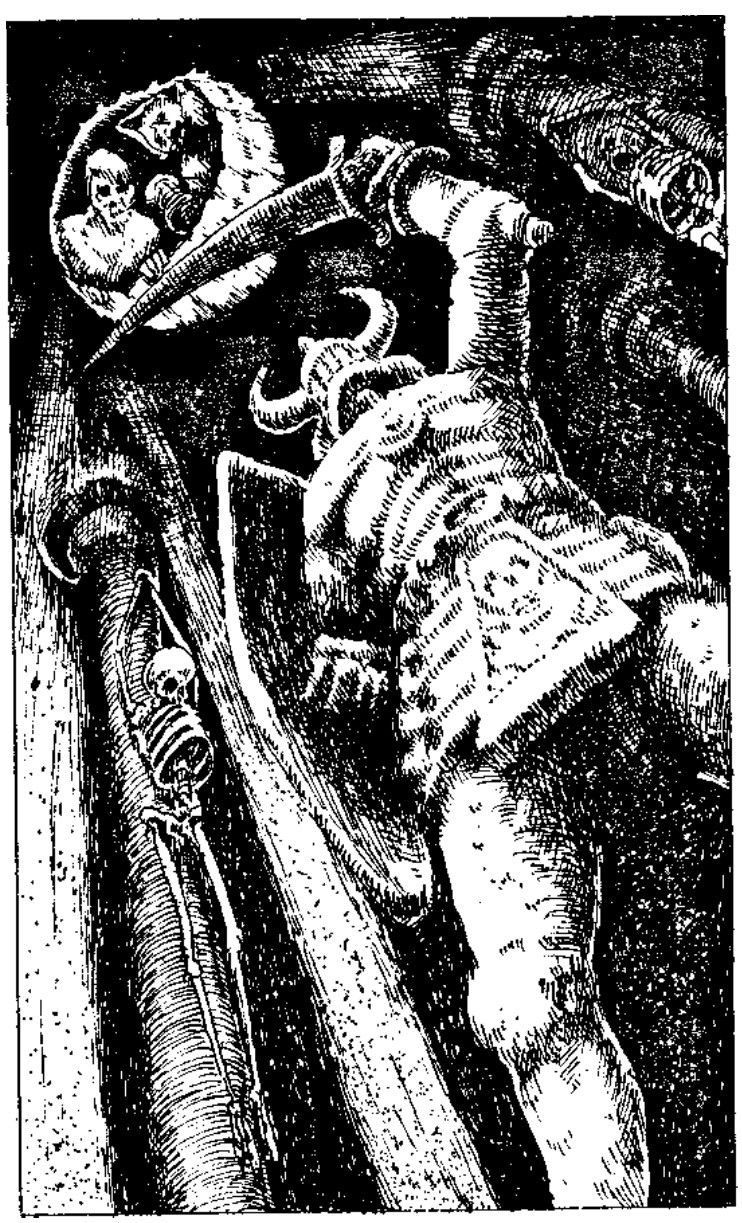
And yeah, the bastard can climb up.
Beyond the tower, there is a clearing reserved by elves for burying the dead, a number of graves protruding from the earth. By day, the burial site is protected by an air elemental , which is of course invulnerable to normal weapons and missiles (fortunately it only has 14 HP). By night, two elf warriors lie in wait to ambush any intruders. The graves have a cool piece of treasure buried in each, like elf boots that make the wearer walk silently at all times, a divining stick that points in the direction of anything or anyone wanted by the user with 80% accuracy, or an elven mirror that improves Looks in 6 points , but if someone desecrates the graves the elf warriors will ambush them wherever they are come next nightfall. Further south, they will find the lair of the forest harpies they may have fought at the beginning of the adventure, with another two harpies defending it. The nest is made entirely of human bones, and some money (9 Crowns and 120 Florins) and a suit of +1 hardened leather armor may be found.
Next: the other half of the Dick Woods.
Gallows Wood, shit, I'm still in Gallows Wood
Original SA post Dragon Warriors: Book 3Gallows Wood, shit, I'm still in Gallows Wood
At the hollow oak glade where the party missed Clothilda and Old Ned by
 and among the remains they will find some coins and a potion of Healing. A path leads south, but they have 20% odds of missing it in the thick mist.
and among the remains they will find some coins and a potion of Healing. A path leads south, but they have 20% odds of missing it in the thick mist.
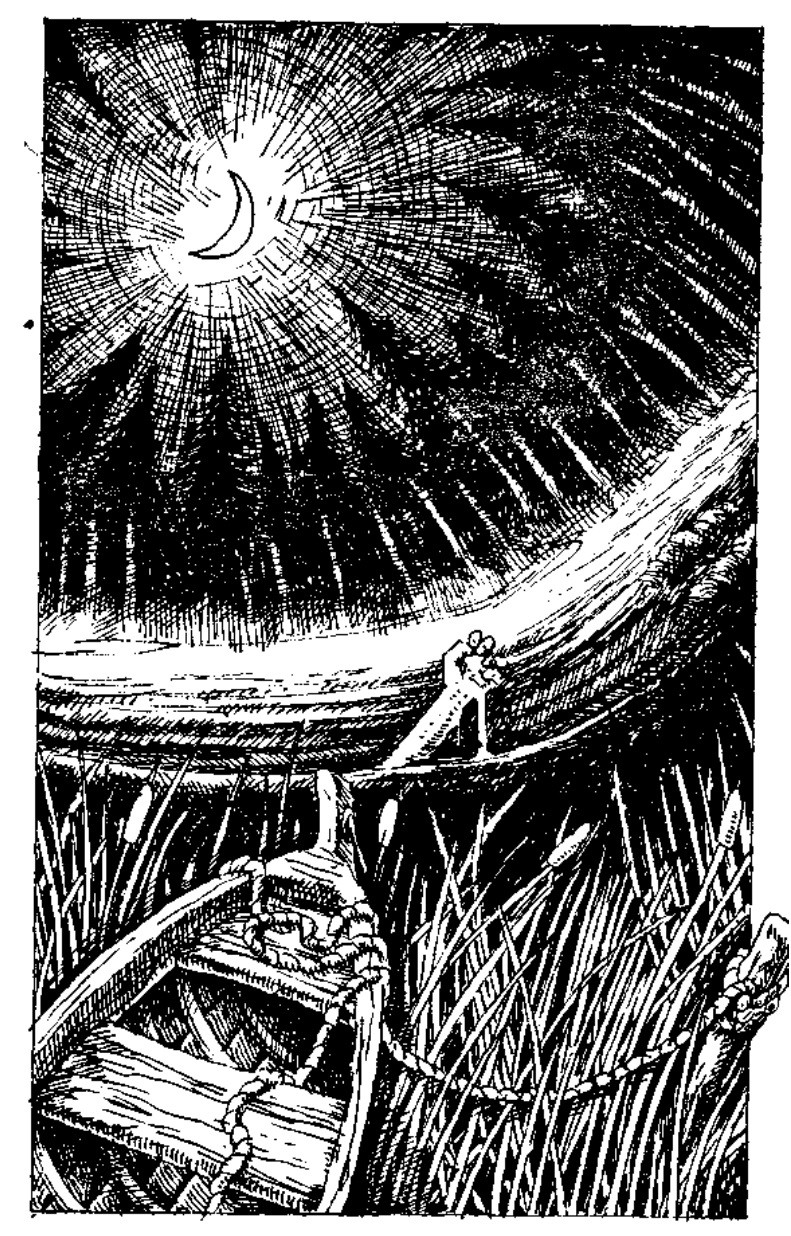
THE CLAWWWW
Further on, the party will reach the all too appropriately named Hellglade . It has a small stream crossing it, and a mere, which Wiki tells me is "a lake that is broad in relation to its depth." Huh! There are three mounds at the edge of the mere, and a small boat moored to a side. The mere's surface is jet black and uniform, objects thrown into it causing no ripples, but on approaching it the party will see a pale hand breaking the surface, clutching a sparkling jewel. If they approach the hand on the boat (carries four people) the hand will disappear... only for a Spectre to jump out of the water! Aaaaaah! Aside from the initial fright attack, however, it won't attack immediately. It will explain that it is the tortured spirit of a woman murdered by Duke Darian, and if one member of the party agrees to go into his castle and kill the duke, it won't attack the party. If someone agrees, the Spectre will cast a Sword of Damocles on the character, triggered to fall should the duke not be killed in a week. The Spectre will also tell the party to collect a magical glove from one of the graves, which will enable anyone to pick up an enchanted spear close to the glade. If the Spectre is defeated in combat, the party will notice they can now see reflections off the mere. A hideous skeleton lies at the bottom of the mere, a golden chain still attached to its neck worth 10 Crowns. The graves belong to Darian's brother, the old duke , and his two children, and if the party hasn't made a pact with the Spectre he will appear before them as they approach the mounds. Fortunately, the old duke is just a Ghost, and won't even effect its fright attack unless characters refuse to aid him. Similar terms as the Spectre deal apply, including the information on the magical glove, buried in the old duke's own grave. The enchanted spear itself is stuck to an old tree, which they can reach through a tunnel of sorts in the thick mist. A bunch of charred, scattered skeletons lie around the spear: anyone grasping its shaft without the glove is subject to a sudden bolt of flame, treated as a Deathlight spell. The spear is a +2 weapon.
Two paths lead south from the Hellglade. One leads to a ruined villa , which characters will recognize as one of the buildings their fathers and grandfathers told them were built by a "god-like race of men who ruled the world long ages past." Man, Tuannon had the right of it, screw the fantasy not-Romans. Sure enough, among the ruins they will find what used to be a stairway leading down into the basement area. The first room they will find is the lair of a giant viper , that will attack the party should they spend more than thirty seconds in it (so, yes). Its bite only has a d3 Armour Bypass, but its bite counts as strong poison because fuck you Elven Crystals. One small room to the north was a dressing room for priests of Mars the war god. There are some old robes and a robed skeleton in the floor, but everything will crumble to dust if touched. The skeleton carried a bronze key in its leather belt. This room leads to a long, rectangular room, with an altar dedicated to Mars on a dais in the north side. There is a mirror hung on the wall over the altar: anyone looking into it will be hit with an illusion depicting one of their companions sneaking up to them, a dagger in their hand. The silver frame around the mirror may be removed: it's worth 5 Crowns, but carries a curse with a Magical Attack of 12. Two exits lie to to the side, back to the dressing room and viper room, as well as one secret room behind a mosaic. The secret room is rectangular, with a small pool filled with some sort of sludge and a menacing mosaic of Mars at the far end. If characters enter, a voice seemingly coming from the mosaic will order them to stop immediately: anyone that actually obeys the command will be right in the way of a stone slab falling on their heads (Speed 13, 3d6 damage.) As for the pool, an evil spirit inhabits it. There are some coins at the bottom as lure, but anyone that touches the pool will be subject to a save-or-die Magical Attack of 12 that will replace their soul for the evil spirit. The spirit will then play along with the party until they are in a dire situation, and then it will stab them in the back.

One section of the northern wall will swing if pushed, barely wide enough for one person. If someone enters, it will slam shut behind them: the air supply will run out in one hour, and anyone remaining outside will hear horrible screams from inside, as if their companion had been crushed. They might just leave them for dead! It takes one man-hour to break through the wall from outside, two from the inside. A similar secret passage is in the south wall, leading to a long corridor with no obvious exits. Behind a thin layer of plasterwork lies a mummy , an old centurion of Mars, that will ambush the characters as soon as two characters cross the corridor. It is tough, and as will all DW mummies, anyone that slays it is subject to a Magical Attack of 18 that will place a Doom upon them, condemning them to death in a month unless steps (6MP Dispel Magic) are taken. Its bronze plate armor is worth 5 Crowns. The far end of the corridor is hollow and easy to break through, leading to a small treasure room with six chests. Roll randomly to see which one the characters open: they hold a magic cup that fills itself with wine once a day, a +1 shortsword, a purse with one gold coin that automatically returns to it five minutes after being taken out, a suit of bronze plate (actually worse than normal plate), an old book that tells how one Master Edas was buried nearby, how his skull was said to have immense magical powers and how a many-headed hydra was placed over its grave to protect it, and (of course) one trapped chest, with poison gas and a poisoned tarantula. Strong poison, ho!
The ruins of a mist-filled orchard can be seen behind the villa: they lead to the grave of Master Edas , guarded by the hydra as the book said. The air is poisonous, and breathing it for more than two combat rounds subjects characters to a mild poison. The hydra will gain surprise due to the thick, noxious mist: it is a nine-headed woman with a serpent's body. While weak (only 9 HP, Attack 13, Defence 2), it sprouts two heads once one is destroyed. To represent this, she gains 1HP from any blow that does not kill her outright: the only way to kill the hydra is to deal damage equal to her HP in one blow, or to use spells. The hydra's gall can be used to poison weapons and arrows. Six feet under the knoll the hydra was magically bound too, they will find the skull of Edas , that will tie itself to the first character that touches it, never straying more than ten meters away from them. The skull is animate, can be used to scout ahead, and is very knowledgeable about sorcerous matters. Master Edas, however, was not a good man, and the skull will give evasive answers to good-natured characters, or try inciting them into chaos and mischief. More evil characters will receive more straightforward assistance, but even then the skull will plan for their destruction. It has no attacks and only 10HP, but it regenerates 1 each round.
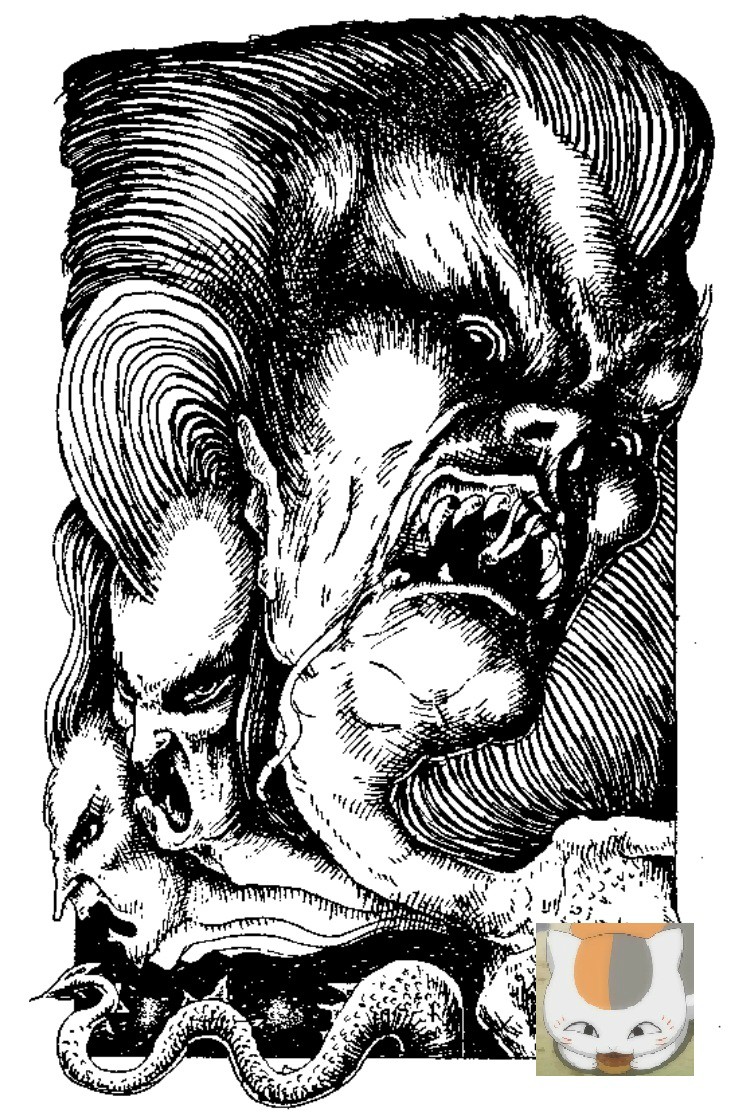
Anime kitty protects you from horrifying hydratits.
Had the characters gone the other way at the Hellglade, they would've come across an apparently disused hut . The entire hut, in fact, is a monster, waiting to devour anyone who enters it with its woody maw. They must roll 14 minus their own Strength to break free from the maw, otherwise the Nightmare Hut will crush them. It has no other attacks, and once it has eaten someone it will stand up on stilted legs and scuttle away. 40 HP, if you care.
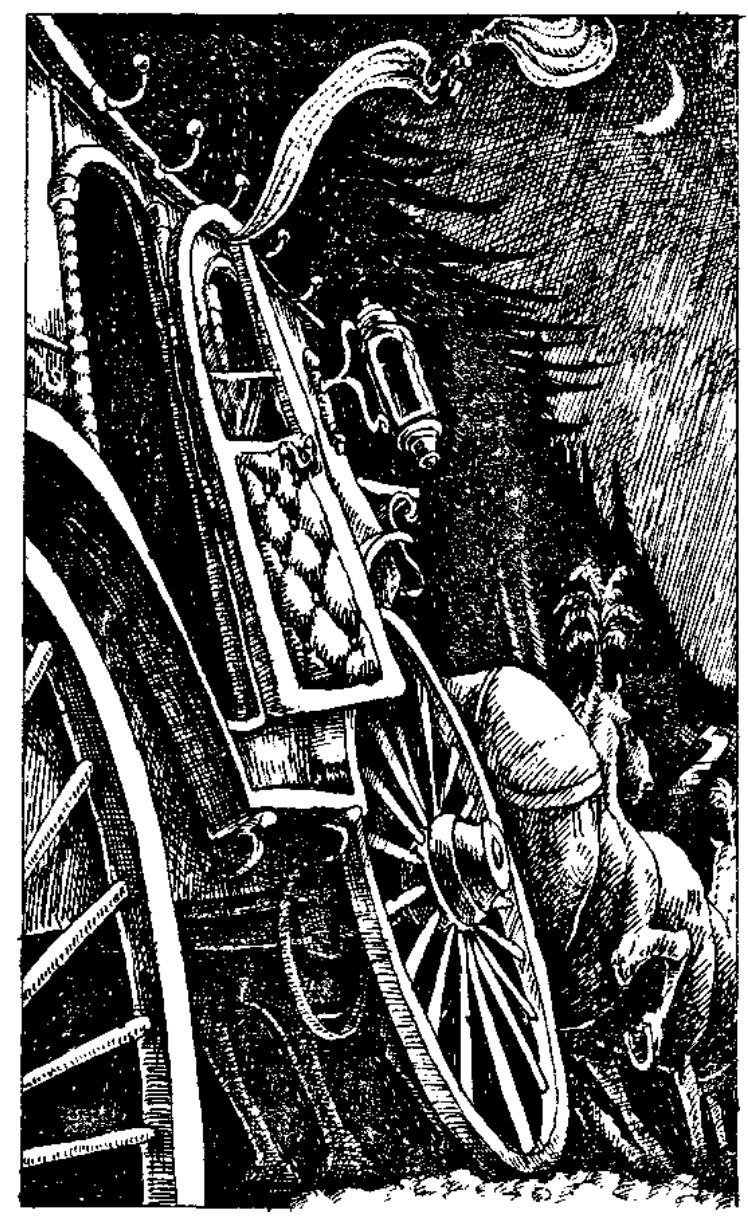
xX360noriderquicktrotzXx
Both routes lead to a partially overgrown road. An eerie carriage pulls up opposite them, pulled by four jet black horses. If someone enters the carriage, it will look to them as if the carriage has taken off at ludicrous speed! In fact, this is an illusion, and the carriage moves at an easy canter. The horses are Hippogriffs, and will attack anyone that tries to stop them. After two hours' worth, it will deposit characters traveling in it in Castle Ereworn itself, the subject of the next adventure. An exit to the east leads to the next scenario, but the party will spot a puddle with the imprints of a hobgoblin foot and a dainty footprint obviously belonging to Clothilda, to the west. Following this trail leads the characters to three gibbets , where the Black Riders string up trespassers and leave them to die. At the moment, only one old man hangs from them. Greedy ghouls are waiting until he dies to feast upon him, and if the party helps the man the ghouls will jump them. Six of them, all of them 4th Rank equivalent, because fuck you. They won't fight to the death, fortunately, and will flee if characters have the upper hand. Before dying, the old man will tell the party that he was journeying to the ruins of a monastery on an island in the river a mile west from their position. The monastery was once a sanctuary, but was finally corrupted and its monks began to lead evil lives. Now only ruins remain, and the ghosts of the monks howl and moan around the last vestige of goodness in the monastery: a holy chalice, said to be a magical, powerful relic.
The party will emerge from the woods by a silent river . They can also get here from the harpy nest from the previous entry. The footprints of Old Ned and the serving girl are imprinted in the river bank, and there is a boat large enough to carry the entire party moored nearby. A Death's Head is around here, and the encounter will vary depending on whether it's day or night. By day, a cloaked man will be standing next to the boat, reeking of perfume. In fact, it's a body controlled by the Death's Head, soaked in perfume to hide its putrefaction. It will attempt to lure one member of the party away, in order to kill them and steal their body. By night, they'll see a man screaming from help in the river, his head barely visible above the water. It is, of course, the Death's Head, who will get a surprise round if the party attempts to help, There is a fishing net on the boat, and if thrown over the Death's Head (Speed 17 attack) it will render the jerk harmless.
Characters may proceed to the far bank of the river, or stop by the ruined monastery . By day, the ruins are deserted, and after some exploring (and a random encounter) they will find a chapel with a beautiful silver chalice standing on an ancient altar stone. Getting there is easy during the day, but during the night the place is packed with the howling ghosts of the monks, who will try to stop anyone moving towards the chalice. It will take some Reflexes rolls to dodge the ghosts and reach the chalice, but any character near it will be immune to their fright attacks. The chalice converts all water put into it into holy water, used to consecrate holy ground, create lines that undead cannot cross, and if given to an undead to "drink" it will automatically slay them. Also, no undead may approach within 2 meters of the chalice.
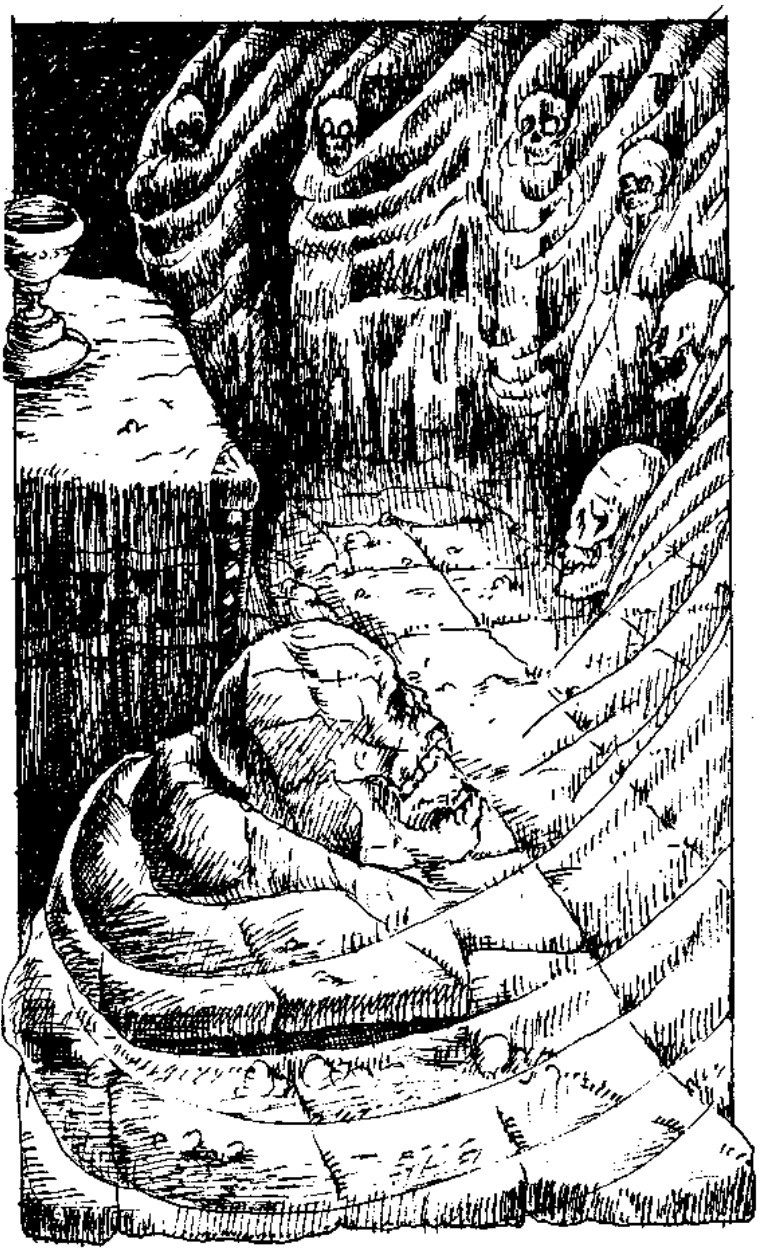
Like that one level in Undying, only without the cool ice dragon weapon thing.
As the party disembarks into the far side of the river, they will be attacked by a pack of wolves summoned by Old Ned. The party should deal with them easily enough. Finally, they'll follow the hobgoblin's tracks to an ancient well . This is Old Ned's lair, and he's got the home advantage. The well looks empty, but the "earth" at the bottom is actually just a thin crust covering a pool of mud that will suck anyone not holding on to a rope or the ivy clinging to the wall in three rounds, unless they manage to get to the side of the shaft (Strength roll.) A moss-covered stone to a side is the entrance to the hobgoblin's lair, and will move if pushed. There are many mysterious boltholes in the walls, and the lair is stuffed with the loot the hobgoblin has stolen from the village (old chairs, iron utensils, some clothes, mirrors, etc.) and the party will hear cries of help from behind a curtain. Clothilda is there, tied to a tree root: she will say that Old Ned escaped through one of the boltholes, but it will be empty if they look. In fact, he's trying to get around the characters and attack them from behind: he will get surprise unless the party was thoughtful enough to leave someone guarding the rear. He will use its entangling spells and other dick moves against them but honestly, a party that can survive all the bullshit in Gallows Wood should absolutely murder the bastard. Ned's actual treasure, buried under the floor of the room where he held Clothilda, is a suit of +1 ring mail, 2 random potions, 1 phial of medium poison, 3 jewels worth 200 Florins total, 68 Crowns, 490 Florins, and a glowing, orange crystal shard. It has a strong magical aura. What do you know, it's an Elven Crystal!
The GM can now let the characters return to the village without any further incident. The grateful villagers will pay them everything they agreed, as well as giving them two horses with saddles, and if the party doesn't murder the assholes for deliberately not informing them about the dangers of the woods , they will tell them about the evil Duke Darian and his castle to the east, along with the incredible treasures hidden inside. And we're done with the fucking Gallows Woods!
Next: you thought that was a dick adventure.
A cavalcade of fuckery
Original SA post Dragon Warriors: Book 3A cavalcade of fuckery
The next adventure, The Castle of Terror , is an "intermediate" level scenario for 4-6 Rank 1-2 characters. Remember how Gallows Wood was "beginner" level?

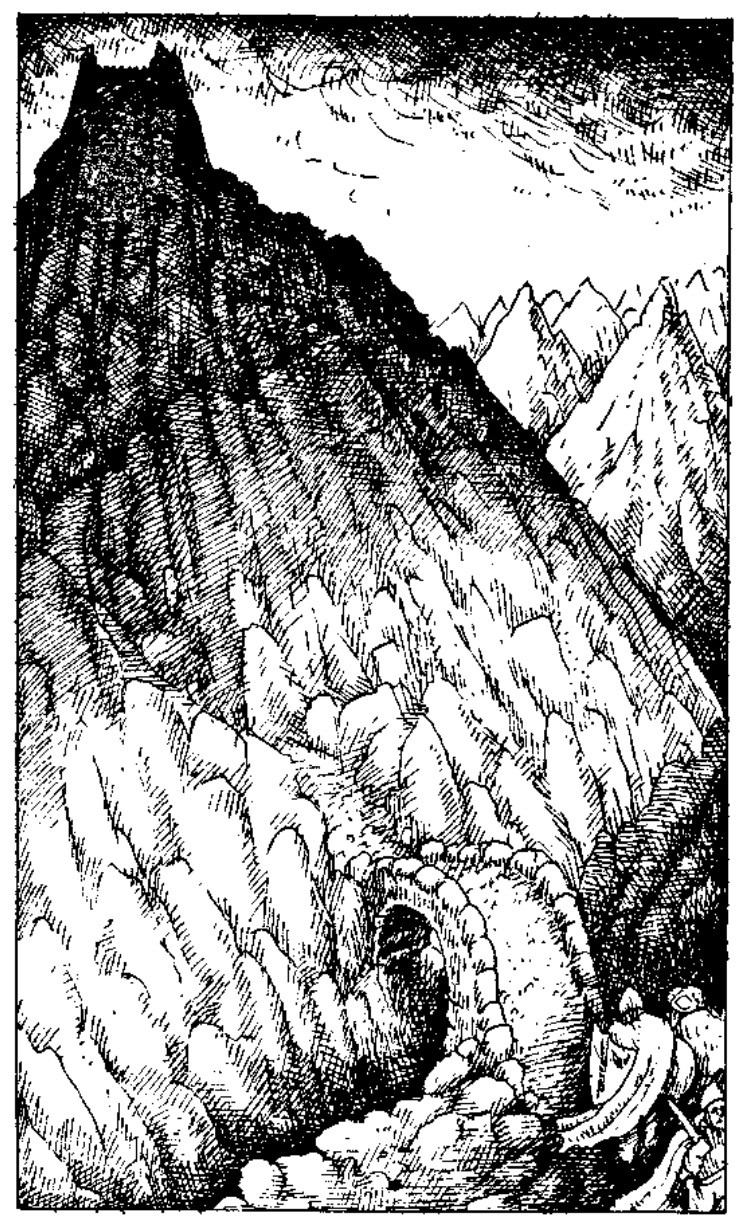
Seems legit.
The adventure acknowledges that PCs will need all the help they can get to survive it, so it stats up two allied NPCs that can join the party before they depart for the castle, show up at some stage of the adventure, or just be run by other players. The first one is Gondric , a 3rd Rank Knight that used to be a local lord. His fiefdom was stripped from him by Duke Darian and his Black Riders, his family and retainers all murdered or scattered, and his ancestral home is now orc-infested rubble. Gondric wants payback, but he's rather dim-witted (Intelligence 5!) and will always insist to be in the front line, throwing himself into the most dangerous situations. The GM may find "that his survival time in the castle is only a few minutes." Their words, not mine! The second NPC, Mazirian , is a 2nd Rank Mystic. He's tough and balanced, and won't shirk away from danger, but he thinks very highly of himself and will demand a quarter of anything the party finds. He will fight for his share if he has to.
As for the adventure, it involves traveling to Castle Ereworn and dealing with Duke Darian once and for all. The three main ways the PCs will get into this adventure are encountering the spirits of the Hellglade and agreeing to avenge them, finding the overgrown road with the enchanted carriage and following East, or having the villagers of Ereworn hire them to attack the duke. If they don't get into the carriage, they will follow the road by foot into the Grey Hills , as a sudden rain squall comes upon them. The rain quickly turns to snow, visibility turns very bad, and then...
... a Yeti.

Well then.
The yeti is tough (5th Rank, 21 HP, Attack 18, Defence 10 and AF 3) but otherwise unremarkable. The snow blizzard is focused around him, and once slain it will quickly abate. Of course, the PCs will have lost their way by then. As darkness sets in, the characters spot a campfire burning next to a cave mouth, and an old man in white robes invites them in. They may choose to ignore him and press onward, which will net them two random encounters and force a Strength save not to lose 1d3 HP due to exposure. If the party joins the old man, he will explain that he is travelling from Castle Ereworn. He had a quarrel with the duke, who set his hounds upon him, but he managed to give them the slip. The old man will tell the characters that he will help them on their quest, only to hit them with a Magical Attack of 22 that if successful will make them fall into a deep sleep. Anyone that resists will see the old man slowly fade from view and disappear. If they search the cave in the morning, they'll find a worn skeleton and a chest opened by a key it was carrying. The chest has an Evaporating Potion (character turns into mist, and then can slip through gaps and be invulnerable to regular attacks), a Healing potion with five doses , a Strength potion, and a Dust of Transformation that if thrown on a character will transform them into a saber-tooth tiger. To top it all off, they're all properly labeled!

Eventually, the characters will see the castle, sitting atop a crag. A thin bridge spans the chasm but guess what, it's an illusion! The usual 5% chance to spot it applies, but characters that approach the bridge with caution will see that the carriage marks on the road disappear on the bridge itself. It will vanish as soon as someone steps on it: the fall down is 10 meters, cut in half by the soft snow at the bottom (1d6 damage.) Thick mist reduces visibility to 2 meters in the chasm, and four hell hounds will attack anyone that falls. Climbing back has a difficulty factor of 11. Eventually, they'll reach the castle gates, that will open at their touch: a steep ramp , covered in ice, leads up to the left. There is a wall covered in spikes at the end of the rap, two skeletons in leather armor impaled on it, and at the top of the ramp there are three stone balls. Sure enough, the balls will fall when the characters reach the midpoint: they're only Speed 9, but anyone failing to dodge will be knocked over and slide down into 1d4 Armour Bypass 2d4, damage 4 spikes, aside from the fall damage. Characters get one chance of hacking a weapon into the ice to break the fall: the ramp is considered to have an AF of 3. Also, doors halfway through the ramp lead to hippogriff stables to the north. Who the fuck would put stables there? If opened, the four hippogriffs inside will bolt, attacking anyone that tries to stop them. There are magical bridles in the stable that, if thrown over one of the hippogriffs (Attack vs Defence roll) will bind them to a rider's will for 24 hours, or until they let go of the bridles. A plinth with a stone bas relief of a cyclops is at the top. It is a spyhole, and characters approaching it stealthily will see a bloodshot eye peering from it.
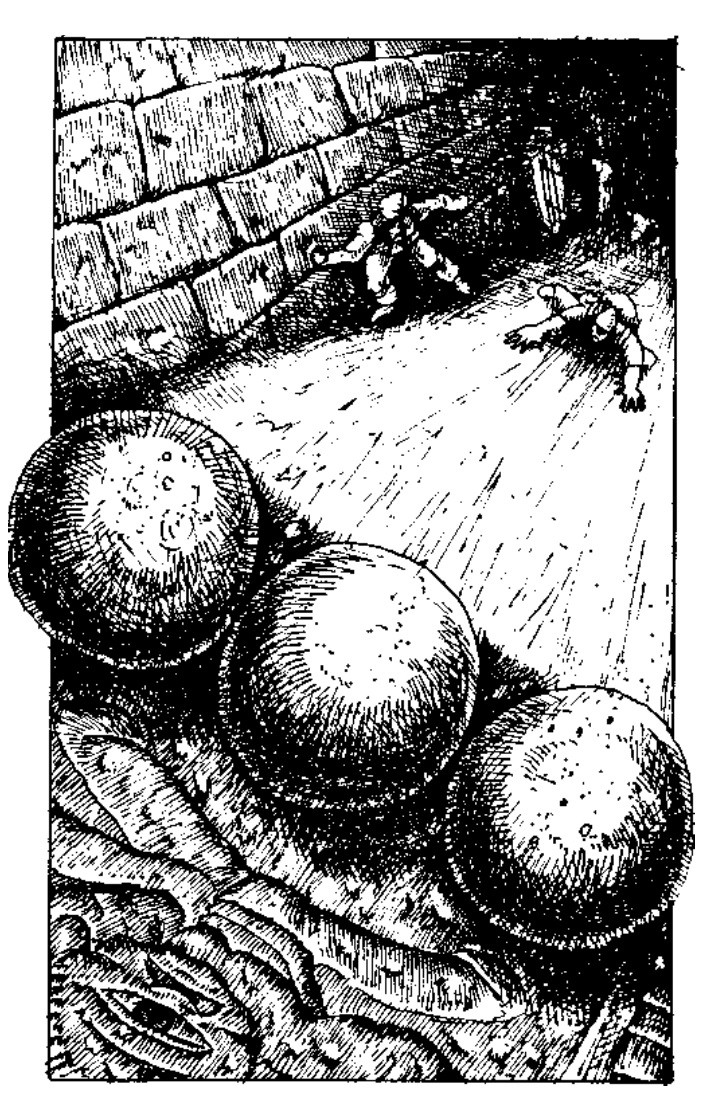
IT KEEPS HAPPENING
At the top, an arched gateway leads into the castle. A guard is lying in wait, and once the majority of the party is inside the gateway he will drop both portcullises, trapping them inside, then rain arrows and burning oil through the murder holes. He can be attacked with ranged weapons or spells. Characters may also bypass the encounter by leaning flat against the walls of the gateway, so that the guard doesn't see them. The gateway leads to the castle courtyard , which is where the enchanted carriage of Gallows Wood will drop the party if they use it. The castle itself is divided in four towers in each corner, with two-story buildings in all sides.
Eight zombie archers on the second floor of the large building north of the courtyard will shoot at anyone below, and two grey gnomes will use their Embog spells to keep characters pinned in place. There is a staircase leading straight into the second floor, with oddly rolling steps that reduce movement rates in half, and if characters get pass the gnomes guarding it the zombies will stop firing and close in with the intruders, wielding short swords. The zombies are only 1st Rank, but with an average of 20 HP a pop. The first floor has an locked door to the NE tower, flanked by two plate armors. Both are, of course, cursed, one with a standard Magical Attack 15 curse and the other with a special Magical Attack 20 spell that will make an evil intelligence (again?) possess the character wearing it, forcing them to attack their companions one turn after wearing it. Fortunately, it will either wear off naturally (Spell Expiry Roll), or if hit by a 7 MP Dispel Magic. The north and west buildings are joined together, with the north section only having broken furniture and the west section being the castle's old banqueting hall, portraits of the dukes lining the walls. If characters spend too much time in the north section, or enter the west section, they will be beset by a freaking demon wolf hellbent on their destruction. 6th Rank, Attack 19, Defence 5, AF 2 and d6+1, 7 damage fangs, and 33 HP to boot. If destroyed, the wolf will reappear fully healed after one exact day: it is an avatar of the demon-wolf Fengris, which was supposed to be stalking the outer planes. The NW tower is enchanted with fearful illusions: characters entering it will see the shadow of the demon wolf pursuing them, even if they have killed it. There is a door at the top with three skeletons lying on the stairs just in front of it, their ribs crushed at the exact same position. Twisting the door handle will trigger a Speed 16 trap, hitting the unfortunate character with 1d6 spears. There's only a blank wall behind the door but hey, at least the adventure warned you about the trap.

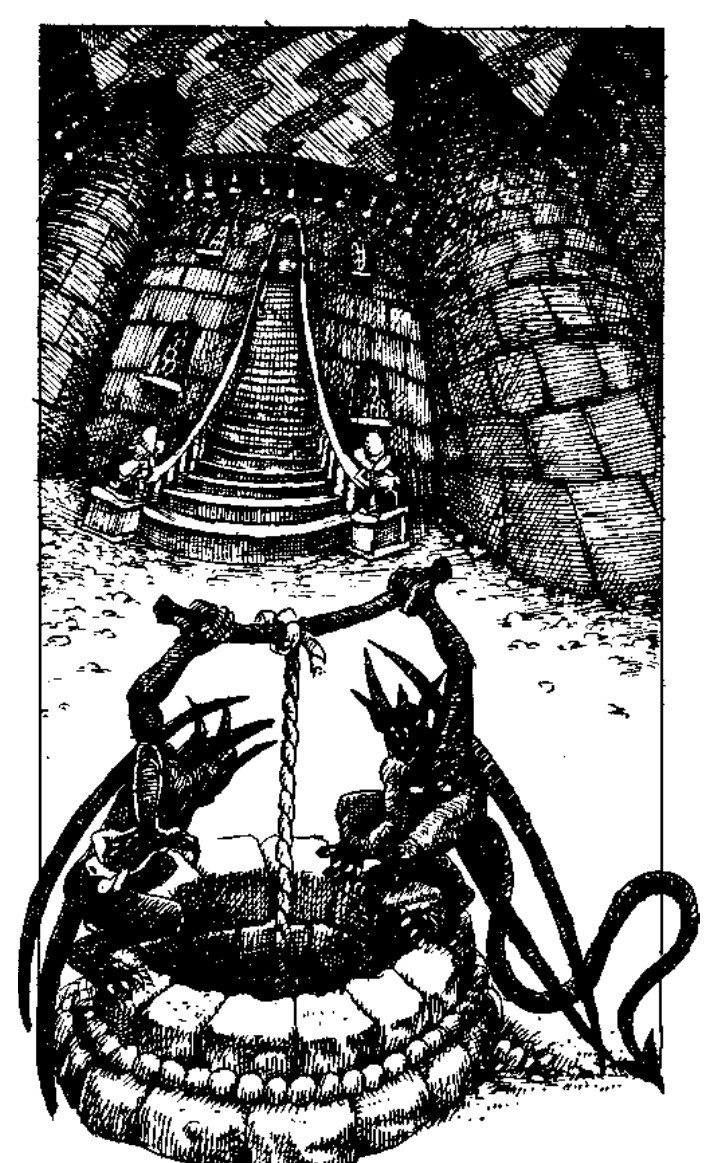
Extremely poor taste in well decor.
Pushing Duke Darian's portrait in the banquet hall will lead to a secret room with four doses of wolfsbane in a jar. Wolfsbane will make any wolf cringe away, even the demon wolf, rendering them unable to approach within 5m for at least one hour. An exit from here leads to the spy hole room where the guard was observing the party as they climbed the ramp, and speaking of the guard, he will hide behind the door to ambush the characters as they enter: he is another Black Rider. The guard room leads to a large armory and target range. There are two Black Rider corpses on the ground, with loads of weapons sticking out of them. If characters try reaching the +1 shortsword gleaming at the far end, they will be attacked by the poltergeist guarding the armory. It will throw the armory's contents at the characters with an Attack of 25: there's a handy table to roll for which weapon the poltergeist uses per round. Another exit leads to a large stone hall with a deserted fireplace, overlooking the mountains to the south. If characters investigate, they'll find a magic horn that controls the hellhounds that are at the bottom of the chasm. One blast will make the hounds return to the bearer, two will make them attack anyone that is not the bearer or those close to them, and three will make the hellhounds vanish forever. Finally for this area, characters may reach the murder holes from where they may have been attacked at the entrance: burning oil and loaded crossbows are there ready for use, along with another Black Rider ready to put a crossbow bolt on the head of the first jerk climbing the stairs. He can be counterambushed by entering through a door in the north side, however.
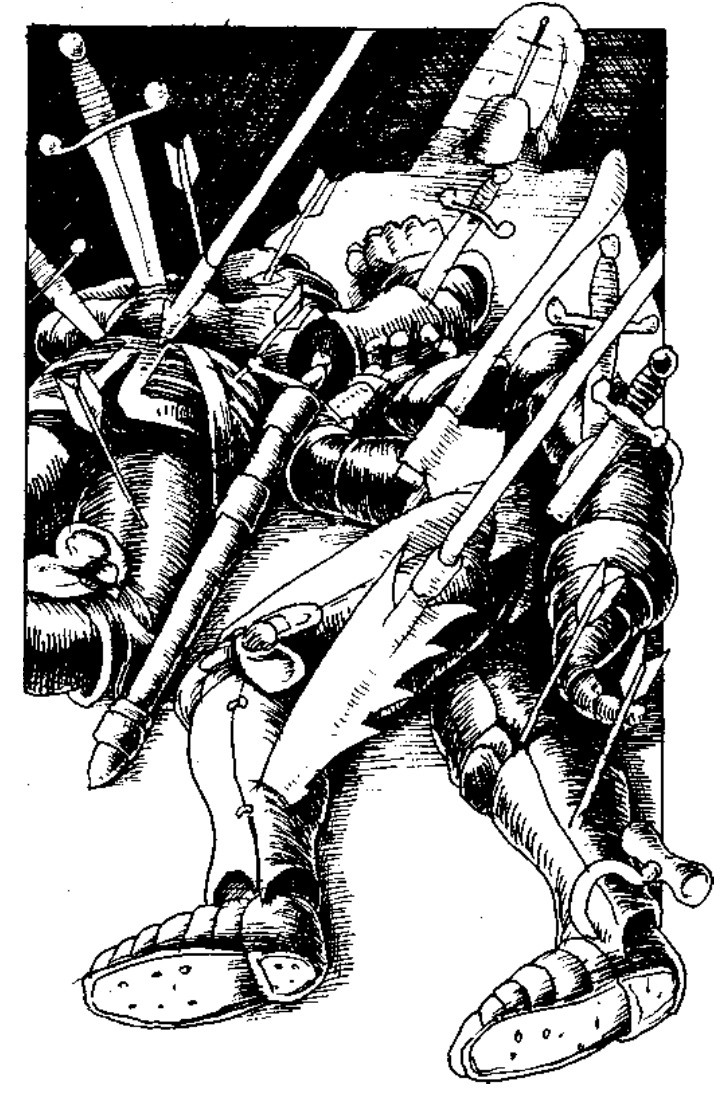
But seriously, poltergeists in armories violates OSHA compliance.
The castle kitchen can be reached from the courtyard. The door is jammed by a pool of evil-smelling mud though, requiring a total 25 Strength points to force it open. When the door is opened, the mud will ooze inside, then coalesce into a mud monster . Spooky! The party may not notice this, as the process is slow (ten rounds), but the mud monster is pretty damn weak. An exit leads into the pantry, where the food is so rotten that anyone lingering in it will be hit with a medium poison attack, and another exit into the SE tower. The SE tower has a cobweb-covered ground floor room, home to a Giant Spider (and yes, Oliver Johnson, we know its bite is save-or-die-horribly, you don't have to spell it out again.
 ) There's not much else aside from 3 Crowns with a skeleton inside a rusty suit of armor, and an equally dusty, unused chamber above the spider's lair.
) There's not much else aside from 3 Crowns with a skeleton inside a rusty suit of armor, and an equally dusty, unused chamber above the spider's lair.
Next: what do you mean one third of the castle is not in the map? This shit is a horror to read.
Meanwhile, under the cellar
Original SA post Dragon Warriors: Book 3Meanwhile, under the cellar
So Duke Darian's castle also has a whole dungeon level under it! Would you look at that. We're told we get there by "two long flights of rickety stairs" mentioned in the kitchen description, though. Anyway, part of this level is still used as a dungeon by Darian's servants... but not even them dare brave other sections, guarded by fierce monsters from bygone ages! 2spooky.
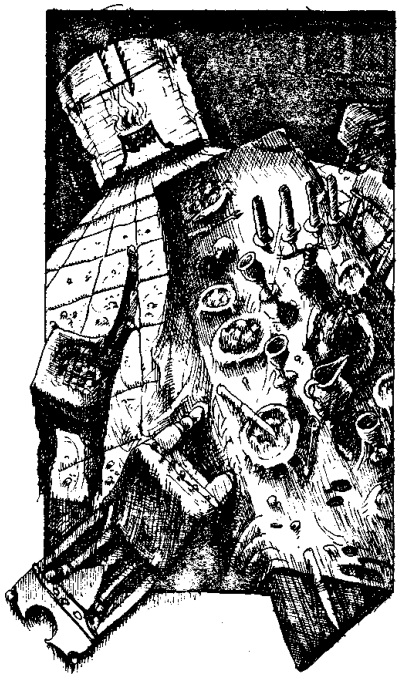
A little century, it's still good!
Down the stairs, we'll find a dining hall , with a magic mirror facing the staircase. It will not reflect undead beings like, say, "undead members of the party such as vampires, etc." Just so you know. The mirror is also a doorway: anyone touching it will find their hand passing through it, and walking through it leads us to the basement level of the castle's northeastern tower - and thus, on the track to ending this fucking adventure. BUT NO, LET ME TELL YOU ABOUT MY DUNGEONS.
The dining hall seems long unused, moldy food left on the table. It seems as if whoever was feasting there left in a hurry. A fireplace is still burning, but the fire still causes damage - 1d6 damage, in fact. There's also a passageway leading beyond it. There are also five pots on the mantlepiece, containing: a white powder (does... nothing?) a blue-black fluid (Night Vision potion), a black powder (pepper) hiding a ring of flame protection (-4 damage from flames, including the fireplace) a grey powder (very strong snuff, throw it at someone and make them sneeze for 2 rounds) and a blue liquid (medium poison.) Characters could also try to steal the tableware (50 Crowns, but counts as ten items for encumbrance) or the halberds hanging on the walls... but there's a catch! A secret room accessed by yanking one of the halbers leads to a small closet with six pale-faced servants standing deathly still. They will continue to do so until summoned by a bell left over the table. They'll attempt to clear the table of dinner plates and such, but will arm themselves with the halberds and attack any characters that try to stop them or steal the tableware. If, however, they're left to do their thing, they'll take the plates back to the kitchen. If summoned again with the bell, they'll continue to obey whoever is holding the bell: their stats are nothing to write home about other than high HP but hey, free zombie henchmen!
Crossing the fireplace, we find a long corridor, wide enough for two people to walk abreast. A pile of skeletons lies in the middle. A trap... well, yeah, the entire corridor is a trap.
 There is a touchplate in the middle of the corridor: if pressed and then lifted, poison gas (strong poison, to make things worse) will fill the room from a hidden bladder, and its deflation will trigger concrete blocks dropping at both ends of the corridor. It takes one man-hour to break through one of the blocks. Fortunately, examining the corridor will reveal the traps, and the mechanism will not trigger if pressure is maintained on the touchplate.
There is a touchplate in the middle of the corridor: if pressed and then lifted, poison gas (strong poison, to make things worse) will fill the room from a hidden bladder, and its deflation will trigger concrete blocks dropping at both ends of the corridor. It takes one man-hour to break through one of the blocks. Fortunately, examining the corridor will reveal the traps, and the mechanism will not trigger if pressure is maintained on the touchplate.
This leads to another corridor, a set of stairs at the far end leading to the ground level. Two doors are set to a side: one leads to a guardroom , currently occupied by a keeper. He is a tough 6th Rank dude that will attack on sight, and is armed with a magic flail and a chain that will pin anyone struck by it unless they roll their Strength. The keeper is, of course, undead, and has keys for all the cells. Most of them are empty except for one, containing one weakened prisoner : all he can tell the party is that he was chased down here by the demon wolf up in the castle, and that he had one companion but he was taken out of the cells some hours ago. The prisoner is feeble, but will accompany the party. And that's all the description we get from the poor guy! The guardroom is connected to a torture chamber where, yes, the other prisoner is kept. Four skeletons are standing around the rack that helds him, and will, of course, attack. The guy is beyond saving, and will only manage to say something about the Elven Crystal (oh, right ) being "at the top of the tower" before dying.
The other door back in the corridor leads to a stone chamber with several dark oubliettes dug in the ground. A voice will call out from one, claiming to be a prisoner of the Duke: if a rope is thrown down, it will climb up... the monster making the voice, that is. It is a Nargut, a "grey, seething, gluttinous" mass with eight eyes, four arms and four legs. It prefers the dark takes 1 damage from each round it is exposed to sunlight but it's not like it makes any difference down here. The other oubliettes hold a skeleton in full armor, an endless pit (Magical Attack of 16 if someone tries to go down, anyone that fails will continue to go down until their rope ends and then drop) and a swarm of six bats (no dick diseases this time though) with a moderate treasure hoard as per Way of Wizardry rules.
There is a shaft leading almost perpendicularly from the torture chamber into a natural cavern , full of the victims of old torturers. Eight of them are undead, natch. They're armed with all sorts of weapons but honestly, even the waiter zombies from the dining hall are tougher. Moving on! This cavern leads into a pool 3 meters deep, a stone sarcophagus in the middle. The pool is
 trapped: it has magic-draining spirits that will
reduce the bonus of any magic weapon or armor that comes in contact with the pool, and render all potions inert.
Only relics will be unaffected. What do we get for braving the Dick Pool and opening the sarcophagus? One skeleton of the regular kind, holding a scepter. A Scepter of Necromancy, in fact, with the powers to revive one person a year as a zombie slave of the user (eh) and speak with the dead once a day (kind of cool but not worth the drain). Another exit from here will have visible sunlight coming from it if it's still day outside: this leads to the bottom of the
castle well
, with a rope hanging in the middle leading up. There's a small casket hidden behind some loose bricks on the northern wall, containing 20 GP and a +1 dagger. You know, considering how Crowns are handed over willy-nilly and are regularly confused with Gold Pieces, I think Johnson forgot this wasn't a D&D adventure. Anyway.
trapped: it has magic-draining spirits that will
reduce the bonus of any magic weapon or armor that comes in contact with the pool, and render all potions inert.
Only relics will be unaffected. What do we get for braving the Dick Pool and opening the sarcophagus? One skeleton of the regular kind, holding a scepter. A Scepter of Necromancy, in fact, with the powers to revive one person a year as a zombie slave of the user (eh) and speak with the dead once a day (kind of cool but not worth the drain). Another exit from here will have visible sunlight coming from it if it's still day outside: this leads to the bottom of the
castle well
, with a rope hanging in the middle leading up. There's a small casket hidden behind some loose bricks on the northern wall, containing 20 GP and a +1 dagger. You know, considering how Crowns are handed over willy-nilly and are regularly confused with Gold Pieces, I think Johnson forgot this wasn't a D&D adventure. Anyway.
There's a passage leading west towards two large blue doors. Characters wielding metal weapons or armor will feel they're attracted to something beyond them. The doors are unlocked, and if opened will reveal a long pillared hall , torchlight not reaching the end of it. Once they advance halfway into the hall, they'll hear a horrible screeching noise, and a monster will jump them! It's an I Can't Believe It's Not A Rust Monster! Aiiieeee! Fortunately, it is not a rust monster and won't ruin your stuff. It is magnetic as fuck though - meaning characters in metal armor cannot run away from it, and any attacks made with metal weapons will strike automatically, but then the weapon will be stuck to the monster and unable to be removed until it is slain. 6th Rank, but the jailkeeper was nastier than it. There appears to be no exits from the hall, but the word "Rimfax" is carved on a wall, and saying it out loud will cause a panel to drop away. Behind the panel there is a shrine room , complete with spooky black candles circle and a silver mask with a leering face on a stand. The mask is safe for people to wear, not so much for someone they look at through it: it will fire lances of flame to the first person they look at through the eyes, like a Dragonbreath spell. Alas, you cannot be Medieval Fantasy X-Man, as it is rendered inert after one "use." 5 Crowns for it, though! The circle works as a teleporter, taking characters that step into it to the NE tower's second floor.
And speaking of that goddamn tower! We'll start at the bottom, which we can get at through the magic mirror at the beginning of the dungeon level. The basement room holds six sarcophagi around a central pit full of sand. There's another magic mirror leading back, with the same properties as the one in the dining hall. One of them holds a vampire, who will attack if the party is about to examine its sarcophagus or if only one person is in the room. It has all the vampire powers, but no Profession ranks. Four of the other sarcophagi are empty, their contents corroded. They are coated with some corrosive sustance that can cause 2 damage or the loss of one AF point, but only with long exposure. The final sarcophagus teleports someone to the floor above... if they think of entering it, then closing the lid. Why the fuck would they do that?
The ground level of the tower has another sarcophagus, into which characters teleporting from the basement will pop. It is set in front of a door to the east. Wouldn't that lead outside if it's the NE tower, though? Walking between the door and the sarcophagus will trigger a trapdoor, though, dropping the character 7 meters down into the basement, straight into the sand pit (half damage). There's also a spiral staircase here, leading into the first floor . The walls of this room are covered with tapestries of demonic flying beings, two of which will pop into the 3D world and attack anyone that steps into the center of the room. There's also a throne with the Ereworn coat of arms carved into the backrest, with a tubular hanging behind it reaching to the ceiling. Pushing one of the throne's arms up will reveal another spiral staircase leading upwards, through the hanging. Spooky chanting will be heard from above!
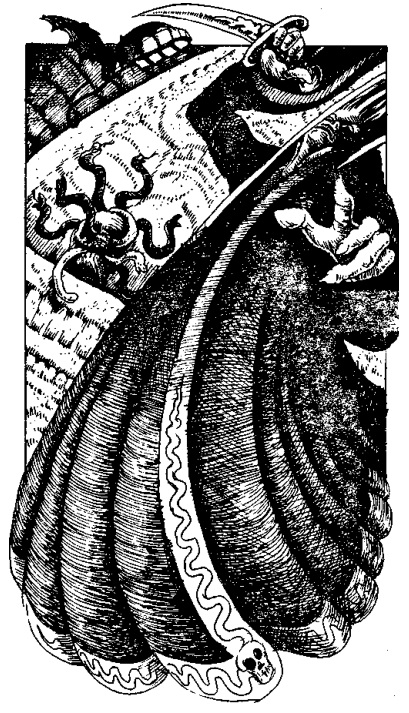
Demon-worshipping Billy Idol! But I repeat myself.
The second floor is a shrine room to Rimfax, which the GM is told is an evil demon represented as "a skeletal horse within a seething mass of small greenish-black snakes." Its primary interests are the propagation of disease and death, and the Duke worships it. Not that the characters need to know that.
 If the characters don't make much noise climbing the stairs and pushing the stone slab that hides the secret entrance, they will have surprise on the priest that is performing his rites here. Rimfax himself is represented by a magical skull placed on an altar. It can cast spells with a Magical Attack of 22 and will inflict a curse of equal strength on any one that touched the skull, but it won't interfere in the battle between the priest (5th Rank Mystic) and the party other than releasing two Hellrots, gargoyle-like, plague carrying, baby-eating (no, literally
If the characters don't make much noise climbing the stairs and pushing the stone slab that hides the secret entrance, they will have surprise on the priest that is performing his rites here. Rimfax himself is represented by a magical skull placed on an altar. It can cast spells with a Magical Attack of 22 and will inflict a curse of equal strength on any one that touched the skull, but it won't interfere in the battle between the priest (5th Rank Mystic) and the party other than releasing two Hellrots, gargoyle-like, plague carrying, baby-eating (no, literally
 ) creatures, from their perches. The skull itself can be rendered inert by touching it, blasting it with Dispel Magic, or throwing holy water at it. Treasure in the shrine includes the priest's dagger (+1, but looks spooky enough that someone carrying it openly may be lynched by fearful peasant), and a hidden alcove behind the altar contains a spare ritual robe, a censer that emits strong poison gas when swung, and a small case with six black gems worth 20 Crowns a piece. They're also all cursed with a Magical Attack of 12, because there's
never
enough curses.
) creatures, from their perches. The skull itself can be rendered inert by touching it, blasting it with Dispel Magic, or throwing holy water at it. Treasure in the shrine includes the priest's dagger (+1, but looks spooky enough that someone carrying it openly may be lynched by fearful peasant), and a hidden alcove behind the altar contains a spare ritual robe, a censer that emits strong poison gas when swung, and a small case with six black gems worth 20 Crowns a piece. They're also all cursed with a Magical Attack of 12, because there's
never
enough curses.
Another staircase will take the party to the third floor , which contains barracks for the Black Riders. Two of them are playing
A final set of stairs leads us into Duke Darian's bedroom , containing one (1) Duke Darian in person! He will jump out of his bed and rush the party, armed with a dagger. He will go down soon enough... but things are afoot. Inspection of the room will reveal a bunch of potions over a table, two of which are marked "Healing." These two are strong poisons, in fact, while the rest cause 1d6 damage. There's an ornate, excellently balanced sword among them... that will snap in two the first time it is used in real combat. There appears to be no exits here, but dowsing the fire in the chimney will reveal a series of iron rungs leading upward. These lead into the rooftop chamber , where the actual Duke Darian is hiding. He's well into his years now, so he lurks in the attic, with the doppleganger the characters killed in his bedroom as a decoy. There's a Pentacle of Entrapment at the entrance for the first two characters that enter the room: the password is, again, Rimfax. The Duke is a powerful 10th Rank Sorcerer, but he doesn't have his full MP complement with him, and he still only has 6 HP.
 Aside from the +1 sword he wields, loot in this room includes Darian's Speculum for scrying, a +1 suit of armor, 2000 Florins, 30 Crowns, 9 gems and jewels worth 500 Florins, a Ring of Teleportation, and the fucking second Elven Crystal, that will neatly fit the one characters should have by now. And that's it!
Aside from the +1 sword he wields, loot in this room includes Darian's Speculum for scrying, a +1 suit of armor, 2000 Florins, 30 Crowns, 9 gems and jewels worth 500 Florins, a Ring of Teleportation, and the fucking second Elven Crystal, that will neatly fit the one characters should have by now. And that's it!
Next: an adventure I actually kind of like, goddamn
No lobstermen, unfortunately
Original SA post Dragon Warriors: Book 3No lobstermen, fortunately
The third and final adventure in this book, Wrecker's Reef (okay, there's a fourth scenario but, you'll see) is meant for five or six 1st-2nd Rank characters, and takes the party westward, to the coast. Now, an issue here is that there's no real reason they would go there in the first place - they only get a hint that a "great treasure" (the third Elven Crystal) can be found there when they get to the coast. That is less of a problem if you just do what the book says and read the first cutscene to the players, narrating how they have decided to go to the coast, having heard that ships depart from there to distant places. Now, DW adventures tend to have cutscene-type paragraphs meant to be read to the players that puppeteer their characters somewhat, owing to its CYOA book heritage, but it's particularly annoying in this book.
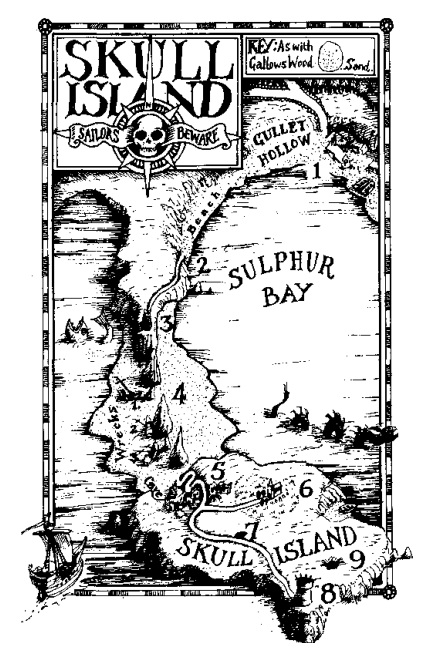
Everything is less of a clusterfuck than fucking Gallows Wood.
At any rate! After a jaunt through Gallows Wood (uneventful, thank small mercies) the party comes across an old man , blind and with a high-pitched voice. The old man will tell them that danger approaches: a storm is coming from the North, and a great treasure is being borne "on the wings of the gale." The old man advises the PCs to go West to the village of Gullet Hollow , where they will find a man that will lead them to this treasure. As the storm begins to suddenly break over the character's heads, lightning will strike and the old man will vanish from sight, leaving his gnarled staff behind. The staff can cast Astral Gate as per the sorcery spell, and burns out after one use. Handy!
After a while, they will find Gullet Hollow, a small fishing village, as well as a peninsula ending on an island to the South. Does it count as an island if it's still attached to the mainland? Anyway, the characters will go into The Silver Halyard , the only two-story building in the village (cutscenes again!), and quickly realize the locals aren't too welcoming. They'll order ale from the barman, who is completely unreceptive to smalltalk and will vanish into the backrooms immediately after serving them. As the characters pick a table, they'll be approached by a cloaked man that was sitting by the fire earlier.
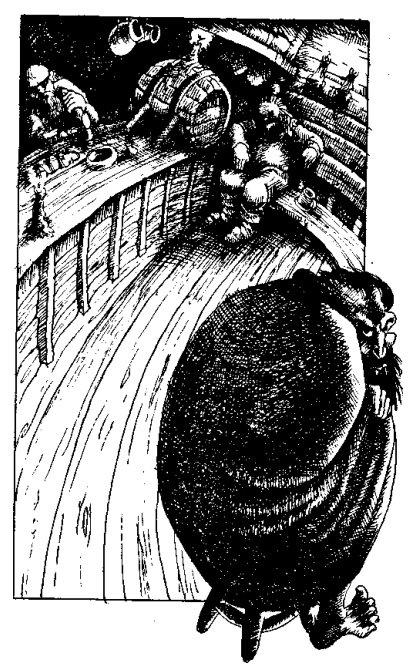
Totally trustworthy you guys
The man, Rakehell , is wet as a dog, has a black beard and a golden earring. ARR, MATEY. He will explain that he was the captain of a ship that very morning, but alas, that damnable storm from the North just went and sank his ship off Sulphur Bay, of which it is said that the fires of hell burn the souls of all the sailors that go down with their ships there. They did see the warning light, but somehow ended up with the ship crashing into the sharp rocks around the island. The ship was carrying no ordinary cargo - Rakehell had been commissioned by someone to take a box to friends in the South and paid him for his troubles. Curiosity piqued, the captain opened the box, only to find this beautiful, glowing piece of rock. He offers half the loot's value to the characters if they go with him this night: the island is connected to the mainland by a sandbar during lowtide, and that's exactly what will happen this night. And not a word to the villagers, eh matey?
That night, the characters will leave their rooms, only to find no sign of the landlord/bartender. They'll meet Rakehell outside: he is a 3rd Rank Barbarian, armed with a saber and leather armor. Rakehell is actually kind of a bad guy and will want to keep the Crystal for himself, but won't betray the party until they actually get their hands on the treasure. The party will leave Gullet Hollow's silent, deserted street, and find a cliff top path leading into the promontory they saw earlier. After a while, goasts! Oh no! They will wail and moan, trying to drive them back... but will draw swords and attack once they realize it's not working. In fact, they're villagers in white cloaks, trying to scare them off. There's six of them, and one is the surly innkeeper. After they're dispatched or driven away, the party will continue to climb the treacherous zig-zag path to the top of the promontory, only to end up facing a landslide of boulders and stones. Speed 11, and if hit the characters will have to roll Reflexes or fall 20 meters down as the landslide knocks them off the path. Once they get topside, they'll find clear signs that the landslide was deliberate.
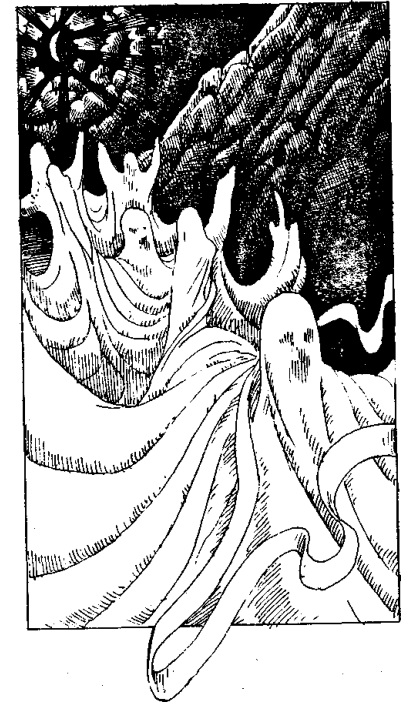
1spooky3me, guys, you're not even trying
There is a tower atop the promontory, and characters will find a series of ropes leading down the cliff towards the sandbar. The tower is old and partially ruined. The ground floor has several stacks of driftwood, with an axe leaning against one that seems recently made. One of the planks reads "The Rogue Prin---": The Rogue Princess was Rakehell's ship, and he will swear loudly at the thought of his baby turned into firewood. There is also a small chest buried under all the wood and rubble: it will take one man-hour to clear the area enough to find it, but it has 12 Crowns and a talisman of Saint Nautilus of the Waves, that will save its wearer from drowning in any circumstance once. Upstairs, there's an observation room with slits in all directions, as well as a bunk, a burnished signalling mirror and a tin full of flint and tinder. A flight of steps leads up, but alas, a gargoyle lurks there, waiting to leap out and surprise the party. Same rules as that other gargoyle apply. The parapet on the rooftop has been pulled down, and a blackened, still warm pile of wood and ash lies in the middle. That was the fake warning fire that lured Rakehell and his crew into the rocks.
Moving on, the characters should have no problem climbing down the ropes into the sandbar, and they will come across the Teeth: the sharp rocks that have claimed so many ships before. There's also fresh footsteps headed towards the island! Mysterious. The characters will come across three wrecks, in order: the Wind Flyer was a medium merchant ship. Three Barnacle Men, rapacious sea undead, are busy looting the remaining treaure in the ship, in order to embed the jewels and gold into their barnacle-covered bodies. They're easy to defeat, and they have 20 Crowns' worth of treasure in their skins, as well as another 400 Florins from the remaining ship's treasure. The second wreck, the Avatar , was a fast pirate ship haunted by the specter of Captain Sabre, its master. There's a corroded iron and wood chest in the wreck: it contains a musical pipe that, if played, will produce a lively tune no matter the skill of the player, and will subject all listeners to a Magical Attack of 8 that will make them dance in a frenzy, ending with a Spell Expiry Roll. The third wreck, the Storm Runner , was a warship that by now has been thoroughly ransacked, nothing of value remaining in it. The footprints lead into a cave mouth into the cliff surrounding the island, and a path leads up to the top, with some ancient ruins visible thee. The tide is racing in - soon, the characters will be cut off.
At the top of the cliff, characters will find an abandoned village . All buildings have fallen in one direction, as if swept by some giant hand - or a giant tidal wave, as was the case in reality. There's a church on top of the only hill in the island, and a tower on the far end of it. One house sports some strange, oversized toadstools glinting in the moonlight: if they investigate the house, they will certainly disturb the toadstools, cracking the tops. Spores will drift away and then turn into a bunch of 2 meter long insects with black carapaces. These Devil Spawns will attack the party on sight, but will not touch anyone bearing a holy relic. They're weak, but there's many of them (2x1d6 of them) and their bite is venomous. Roll Strength as per strong poison rules, and if that fails roll under HP in 4d6 or face horrible death as the character's skin turns into a hard carapace and writhing legs and tentacles burst through it. The Devil Spawn and anyone they manage to infect will slowly turn into an acidic sludge after ten Rounds. In the house, the party will find stairs leading down into a dark cellar, where a Ghoul lives. It feeds on the rotting bodies of the local graveyard, and will try turning the characters into something more palatable to it (i.e., dead). There's a number of ancient chests here, most of their contents turned into dust, but one holds 35 ancient gold coins worth more than modern ones, though the adventure won't say how much, and a magic golden idol that if held by a Mystic or Sorcerer will allow them to cast a special 1st level spell, Light of Truth, that creates radiance equivalent to sunlight anywhere, even underwater or in the middle of a storm. Cool!
The party will have to make their way through a damp swamp, crossing a causeway to get to the church, where they'll be jumped by six skeletons, the remains of unfortunate men and women buried outside consecrated ground. The bones will knit themselves together after an hour if they're defeated and crawl back into the graves they burst from, to ambush whoever else passes by, but they won't get close to the church. The church itself is surrounded by a 3m tall wall with a locked gate at the end of the causeway that will open to anyone bearing a holy relic. A line of bleak yew trees inside the wall will howl and moan to anyone approaching them, and people that get too close will actually be attacked by the trees, with an Attack of 12 and a damage of d6/2. The trees will stop when an old hermit, Aelfric , shows up at the door of the church to see what the ruckus is all about. Aelfric is a tough-looking old man bearing a heavy iron cross, and he doesn't mind using it in combat. Once introductions are made, he will explain that he has lived here all his life, attempting to keep the consecrated ground free from all the evils lurking around. The church is dedicated to Saint Crispin, whose holy well was said to have curative properties.
Aelfric will tell the characters that the villagers of Gullet Hollow are a devil-worshipping lot, revering some ancient sea god that would one day return from the depths of the ocean and consume the land. Oh, shit, we Cthulhu now. He believes that a shrine to this deity is to be found in the tunnel network under the island, that can be reached through the cave they found by the Teeth. He knows about the false light the villagers use to lure ships into the rocks and used to sneak out to light the beacon on the South end of the island, but now it's too dangerous to go there as two giant eagles are using it as their nest. So far, Aelfric has managed to give the villagers the slip: they're too cowardly to go into consecrated ground themselves. The church has a silver cross that Aelfric will not part with for whatever reason: it is magical, and once a day it will heal anyone touching it of one disease or cure 8 HP. There's also a beautifully illuminated book, containing scrolls for a bunch of powerful spells: Hecatomb, Dishearten, Resurrect, Animate Bones, Raise Fog and Dispel Magic. If the characters agree to explore the bottom of St. Crispin's well, Aelfric will agree to join them, taking the book and cross with him.
Well then posted:
The hermit is determined to rid the island of the superstitions surrounding the worship of the sea god. He doesn't realise that there's actually a fearsome monster in the depths below the pool at the center of the island.
Going South, characters will spot a sinkhole . Investigating further, they will find a set of stairs leading into the darkness: this is the route the villagers use to get from the top of the island to the caves. The beacon tower itself has nothing of note other than the two giant eagles (3rd Rank equivalent), that will attack on sight. The only other point of interest in the island top is the large sinkhole at its center, 50 meters deep. There is no obvious way to climb down other than by holding on to the creepers fringing it: roll Strength every 10 meters or fall. Fortunately, damage will be cushioned by the water at the bottom, and the fall will only deal a quarter of its damage.
The tunnels are relatively straightforward, but some areas are covered in water more than two meters deep: characters may find themselves with water over their heads and their swimming chances will be reduced by their armor. Starting from the Teeth cave, they will find the footsteps disappearing into the tunnels, as well as a deep groove leading into the darkness, a number of footprints visible to both sides of it. The groove was caused by the wreck of the Rogue Princess as it was being dragged into the tunnels. One random encounter later (why, adventure? Why?) they'll find a vast underground chamber, illuminated by brilliant green lichen. And what do you know, the wreck of the Rogue Princess is there! Rakehell will call out to his crew, and people will appear on deck - but he'll stop calling once he notices the unnaturally slow way they're moving. Oh, shit, zombies! With no more love for their captain while dead than while they were alive.
 The hold is waterlogged, and the chest with the Elven Crystal is missing.
The hold is waterlogged, and the chest with the Elven Crystal is missing.
Moving on, the tunnel splits in two after a while. The left fork leads to the bottom of St. Crispin's well, which can be reached from the church topside. There's a bunch of corroded coins embedded in the bottom: about 5 Crowns' worth of them can be salvaged. There's also a corroded jewel casket on a ledge: it once held a relic of St. Crispin's that powered the well, but is now empty. The right fork leads to a second fork, the smaller passage of which they'll find a pagan shrine with offerings of rotten fish and human bones before a barnacle encrusted altar. St. Crispin's relic is here, a small fragment of his tibula hidden in a vase of stinking fish oil to a side, but first characters will have to deal with one villager in white robes: this guy was the one that dropped the rocks on them all the way back, then ran here to warn the priest that runs the show about the invaders. He is only 1st Rank, but wields a harpoon coated with a weak paralyzing poison. It doesn't say if it's permanent paralysis or what, though. Aside from the relic (that is obviously magical and very smelly) there is also a jar with about three doses of the paralyzing poison. If the relic is returned to its jewel casket, the spring that feeds the well will burst back to life, and drinking from its waters will heal 1 HP to a wounded or sick character per day.
The final passage opens into a huge underground chamber . The characters will hear chanting from there as they make their way in, and they will find a black-robed priest in front of an altar just above water level. A prisoner is strapped to an altar in front of him, one of Rakehell's crewmen, and the priest holds a glittering knife in one hand and the Elven Crystal in the other. He's almost done with his rituals, and he will place the Crystal on the prisoner's chest before running away from the tidal wave that is to come.
See, the sea god? It's a fucking Kraken.

Characters may surprise the priest if they think of turning off their torches. He's a 5th Rank Sorcerer, but they should make short work of him. It will take ten rounds for the Kraken to show up. If the party is not gone before then, the Kraken will break the surface of the underground pool, causing a wave. Not a word on how it affects the characters, though! The Kraken itself is a 10th Rank monstrosity with a d10/10 attack with a range of 5 meters, as its tongue lashes out and drags people inside its maw. The Kraken will attempt to snatch the sacrifice and the crystal first, but will attack the party if disturbed.
But seriously, just run away you assholes.
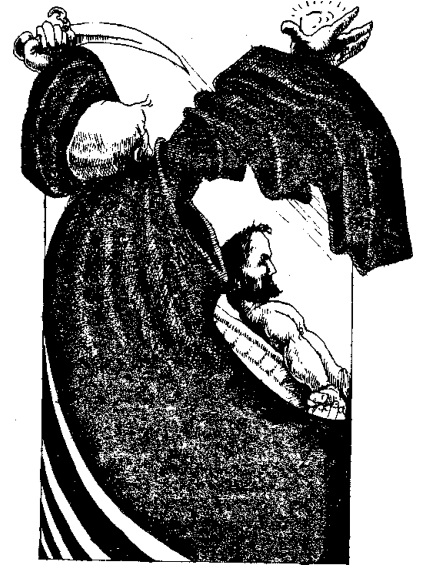
What is wrong with his arm
As for the end of the adventure, Aelfric will tell the party about a fishing boat moored East of the island. Back in the village, any surviving villagers will mass up for one final attack. They also have a treasure cache worth 5900 Florins, as well as two phials of medium poison, one Deathlight scroll, and one Strength potion, one Healing potion and one dose of Sands of Slumber.
And that's it! Honestly, this was a return to form after Castle O'Dickery and fucking Gallows Wood.
Next: Elvaaron's Tomb and---
No, wait, fuck it. This ends here because the last "adventure" is... you know how I was complaining about cutscenes?
Well, The Dark Hill , the final scenario, is just that, one long cutscene. As the three Elven Crystals are brought together, a portal will open into a spooky burial mound, and characters will somehow be able to tell they have time traveled several hundreds of years into the past. But suddenly! Fengris, the demon wolf, will start pursuing them, and characters will have no choice but fleeing into the mound After making their way through Elvaaron's tomb, they will come across his remains, and one huge Golem watching over three shattered crystal shards matching the fragments they have collected. Oh, and the demon wolf is scratching away at the barrow. The Golem is a 7th Rank tank with a d10/8 mallet and an AF of 5. That's not the real problem, though.
If they don't destroy the Golem in 20 rounds? Fengris breaks through and breathes into the barrow. TPK.
No, seriously, TPK right there.
fuck you posted:
One blast of the demon-wolf, Fengris's evil, chilling breath after he has broken the burial chamber will automatically slay anyone within its range.

Agency of the characters other than fighting the Golem and reuniting the crystals needed to open the portal back into their own time? Zero.

Oh, yeah, treasure: a Torc of Continual Restoration (restore 1 HP every round, even after death, except for fire damage), a Ring of the Sentinels (summons 1 tough-ass magic warrior to fight for the user per charge, up to three of them at one time) an Elixir Vitae (resurrection potion) and a +3 sword (Karvala, you fucking asshole.)
What I want to say is that the Kingdom of Ereworn can suck Barnacle Man cock forever.
Next: a much better book.
The Keepers trained you to become one of them
Original SA post Dragon Warriors: Book 4The Keepers trained you to become one of them
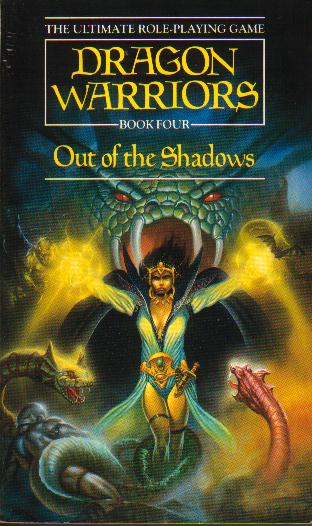
Thank god it's not a Chris Fields book.
Welcome to Book 4 of Dragon Warriors, Out of the Shadows. This book introduces quite a bit of new material to the game, so let's get started!
We'll start with Chapter 2, as the rules here apply to everyone. We now have two extra stats for characters and monsters, Stealth and Perception. These are rolled like Speed and Evasion for characters trying to get past others without their noticing: substract the observer's Perception from the intruder's Stealth, then roll under it in 2d10. The roll assumes there's a dimly lit environment with plenty of cover to work with, with penalties to Stealth if there's too much light, not enough places to hide, wearing heavy armor, or having to step too close to the observer. Perception is also penalized by things pitch darkness, distractions, or being asleep. Invisibility provides a +7 bonus to Stealth and renders lighting modifiers moot. We also get a long list with Stealth and Perception scores for the monsters introduced so far, as well as those introduced in this book. Which is a little annoying as they're not repeated in their writeups, so you have to flip back and forth somewhat. All monsters get Stealth and Perception scores, but the game admits it's mostly for completeness' sake, or in the odd case like having a characters transformed in a monster - there's little chance of a hulking Hydra trying to be all sneaky. Monsters also get one of five new vision types: normal vision sees best in daylight, is impaired by low light, and useless in complete darkness; panoptical vision works perfectly in all conditions; darksight is the reverse of normal vision, blinded by daylight and seeing well in the dark; elfsight sees well in bright and low light, and is only slightly impaired by darkness; and gloomsight is a rare type of vision that doesn't see as well in either bright light or darkness, but works best in low light. Knights, Barbarians and Sorcerers start with a Stealth of 13, modified by very high/very low Reflexes, and a Perception of 5, modified by very high/very low Psychic Talent. Stealth goes up 1 point every 4 levels, while Perception increases in 3 points at 4th Rank, 2 at 8th Rank, and another 2 at 12th Rank. Mystics get a bonus of +1 to these scores, and all Elf characters use the Stealth/Perception progression of an Assassin.
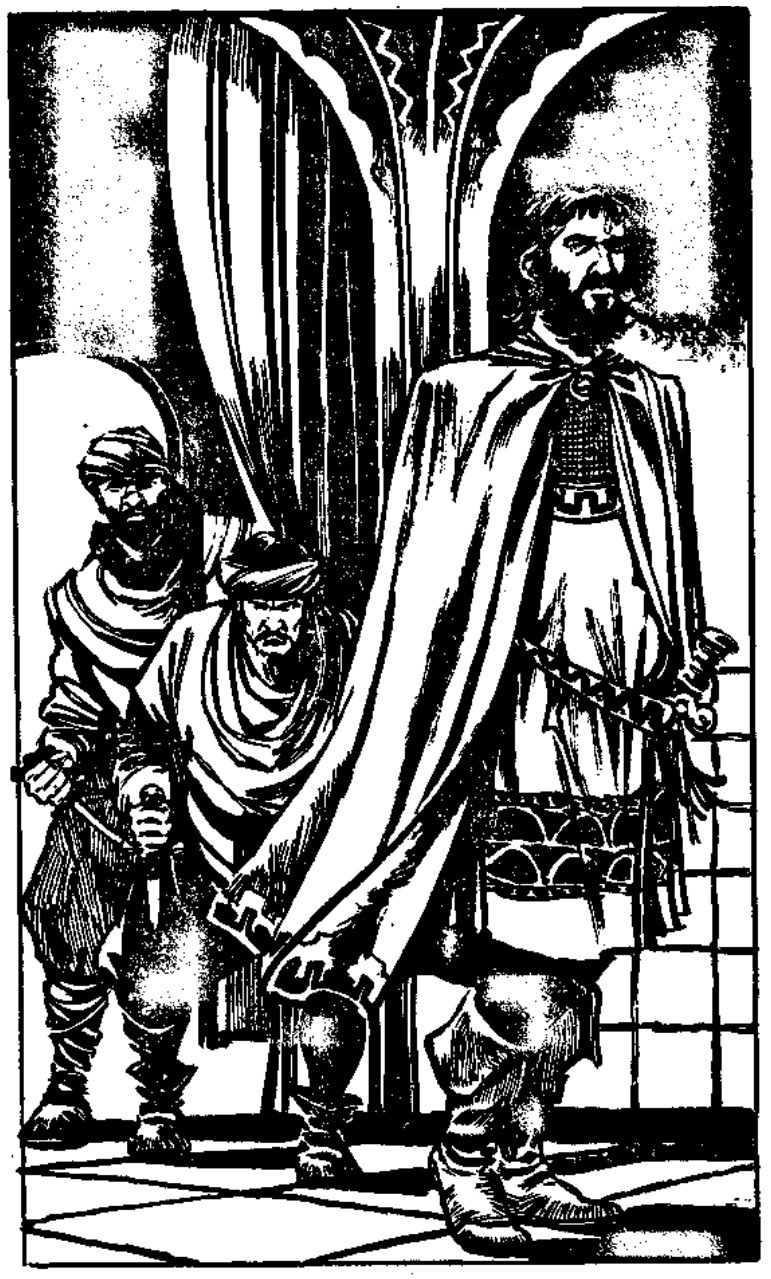
Little did the killers know that two midgets with a mannequin head were posing as a decoy.
What is an Assassin , you ask? It is the new Profession introduced by Book 4, a character that makes a craft out of murder, by stealth, trickery and poison. Of course, they're not in the game just to kill one important NPC after another: adventuring Assassins are tomb robbers, troubleshooters, explorers, bodyguards, thieves, freebooters, even heroes. They are much rarer than other Professions, and even if the requisite stat rolls are made the GM is the final judge on whether an Assassin may join the party. Knights in particular despise Assassins for their 'cowardly' ways, and it may stretch verisimilitude if a group of PC Knights take on an Assassin as a companion. Assassins need a minimum Reflexes of 12, Intelligence of 9, and Psychic Talent of 9. They start with 1d6+5 HP, Attack 13, Defence 5, Magical Defence 3, Evasion 5, Stealth 18 and Perception 8. Except for Evasion which increases 1 point every 4-5 Ranks, all of these scores go up in 1 per Rank. As for gear, they get a backpack, nine throwing spikes, staff, sword, crossbow, case with 5 quarrels, hardened leather armor, miscellaneous gear (rope, lantern, climbing tools, etc.) and 3d10 Florins.
They also get a whole mess of tricks!
-
Combat techniques:
Assassins know the martial arts, yo. When attacking with sword, staff, dagger, shortsword or throwing spike, they add 1 to their Armour Bypass rolls. The throwing spikes (sometimes stars) themselves are d2/2 weapons the Assassin can build on their own, at a cost of 3d4 Florins and two days of work per pack of nine. Up to three can be hurled in one round, even at different opponents, and they may be coated with poison. Finally, unarmed Assassins deal d6/3 damage because they know kung fu. They do get penalties to Attack and Defence for chainmail and plate armor however.
-
Shock attack:
an Assassin that gets within 3 meters of an opponent without being spotted can initiate a shock attack. This grants the Assassin automatic surprise and (if they outrank the target) a roll on the Shock Attack table, leaving their opponent in one of four different states -
stunned,
aghast,
astonished
and
surprised.
Stunned characters have Attack, Defence and Evasion at 0; Aghast opponents recover half their Defence; Astonished characters have their Defence and Evasion at half score; and Surprised characters act as 'normal' (i.e., only Attack is 0). Shock attack victims move on to the next better state with each round, but by then the Assassin has probably made short work of them.
-
Inner Sense:
when an Assassin comes within 1 meter of a pit, obstacle or trap, even in pitch darkness, the GM may roll Psychic Talent for them, Success indicated that the Assassin senses the trap.
-
Meditational techniques:
the Assassin learns several trances as they advance in Rank. They all take three Rounds to initiate and some trances require longer, but the Assassin is never helpless during them: they may cancel the trance and defend as normal. At 1st Rank, they learn the
Light Trance,
which must be maintained for one full day and lets them recover an extra 1d8 HP in natural healing and gives them a 20% chance per day of neutralizing any toxin in their body.
Darkness Trance
, at 2nd Rank, must be maintained by two hours and then duplicates the Mystic spell of Suspended Animation.
Water Trance
, at 4th Rank, must be maintained for one hour, and then it mimics the effects of Mind Cloak on the Assassin for 20 minutes.
Earth Trance
, at 6th Rank, lasts for as long as the Assassin wishes to maintain it (!) and is an improved version of the Survival spell, with an added partial immunity to fire that reduces Dragonbreath and Firestorm spells, as well as an actual Dragon's breath, to 10 HP. At 8th Rank, the Assassin may enter the
Void Trance
for half an hour, which replicates the effects of the Hidden Target spell and lasts for 15 minutes. The
Fire Trance
, at 10th Rank, must be maintained for one hour and then it grants the Assassin the effects of the Swiftness spell, lasting 5 minutes. Finally, at 12th Rank, they learn the
Wind Trance
, which takes an hour to complete and grants Intangibility, Spell Expiry Roll applying.
-
Alchemical techniques
: the Assassin knows how to prepare Assassin's Lotion (normal poison), Smoke Jars (like the Vials of Smoke Sorcerers can make, but a little heavier) and Flash Pellets (flashbang!). They're all relatively cheap and quick to make, but the Assassin is nowhere the equal of the Sorcerer in alchemical matters: each compound has a 90% chance of being useless at 1st Rank, descending in 10% with each new Rank.
-
Climbing:
an Assassin with proper Assassin-y climbing gear (iron claws and whatnot) reduces the difficulty of any climb in half their rank. They can also somersault any obstacle up to three meters tall given 5 meters of run-up, and can fall up to 6 meters without sustaining injury.
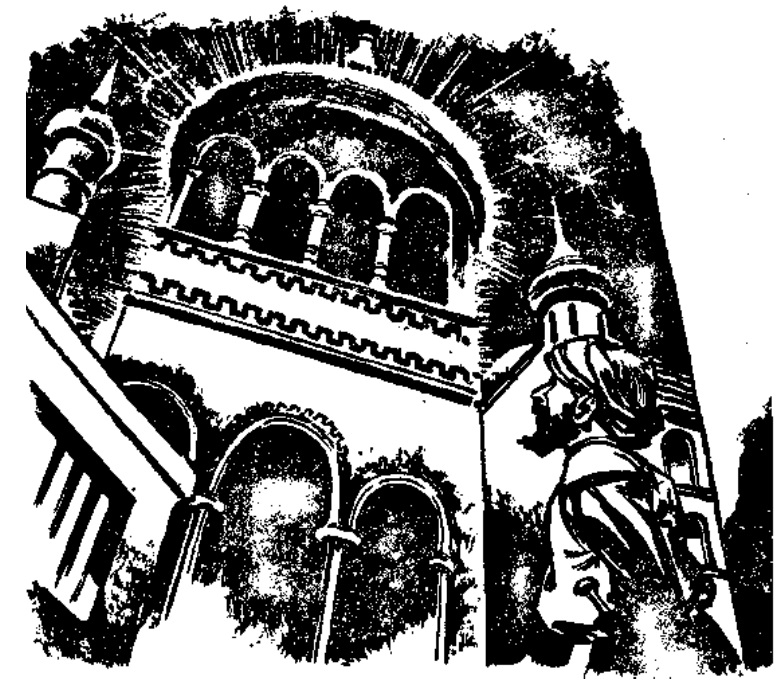
He's got this shit.
-
Disguise:
Assassins may blend into groups to evade pursuit or masquerade as someone else in order to get past guards. They can't disguise themselves as specific individuals, only generic types, and even then only those the Assassin could feasibly pass as (a slender Assassin girl is not going to cut it as hulking Thog Bonebreaka the Barbarian) A successful Stealth roll without modifiers means the disguise holds for ten minutes, and an additional roll must be made if the Assassin engages in conversation.
-
Pilfer:
pickpocketing! Stealth-4 roll to snatch small objects and valuables from someone else. If the Assassin fails, the victim spots the attempt by rolling Perception or less in 1d20.
-
Picklock:
self explanatory. It's interesting how they mention than in most castles people would rather trust a bar than a lock, leaving them to dungeons and such. Treasure chests are often secured with padlocks, though, so an Assassin may find plenty of opportunity to work their skills in the new market towns that are popping up, as well as in the wares of the rising merchant class. World building in my rules, Ho! Speaking of rules, they are kind of annoying. Assassins get a fixed percentile chance of being able to pick the lock, modified by high Intelligence and Reflexes. Now, this only tells whether the Assassin
may
pick the lock: the GM rolls in secret, and then the Assassin tries to roll equal to or under their Rank in 1d100 every Combat Round to determine whether they can open it or not. So yeah, not the thing you want to try in combat. An Assassin may give another shot at a lock after one week.
-
Track
: the Assassin may follow trails up to three days old. Straight Perception roll in 1d20 to maintain the pursuit for one day, with additional rolls required every time the terrain changes or if the quarry crosses a river. After three days, a cumulative 1d4 is added to the 1d20 roll per day, with an 1d8 added if there's a storm or a snowfall.
-
Memorize
: Assassins are trained to have photographic memory. At 4th Rank, they have 20% odds of recalling anything they've seen or heard in the last month. Odds increase in 20% each Rank up to 8th Rank (total recall), and are reduced in 10% for each month after the first down to a minimum of 10%.
-
Deathvow
: finally, at 12th Rank, an Assassin may 'set' their mind and body to kill a chosen target. They must spend a week reviewing and absorbing everything they know about their chosen prey. Once they do, if they ever come within 3 meters of the target, they enter into a berserk fury that won't end until they or their target are dead. The vow grants them
+10
to Attack and +2 to Armor Bypass rolls and damage when active, and they stay conscious until their death at -3 HP instead of getting knocked out at 0 HP. They also need no food or rest while they're on the mission, and may cover twice the daily distance when traveling cross-country. Only one Deathvow may be active at any time, and it takes another week for the Assassin to depsych if they wish to abort the mission.
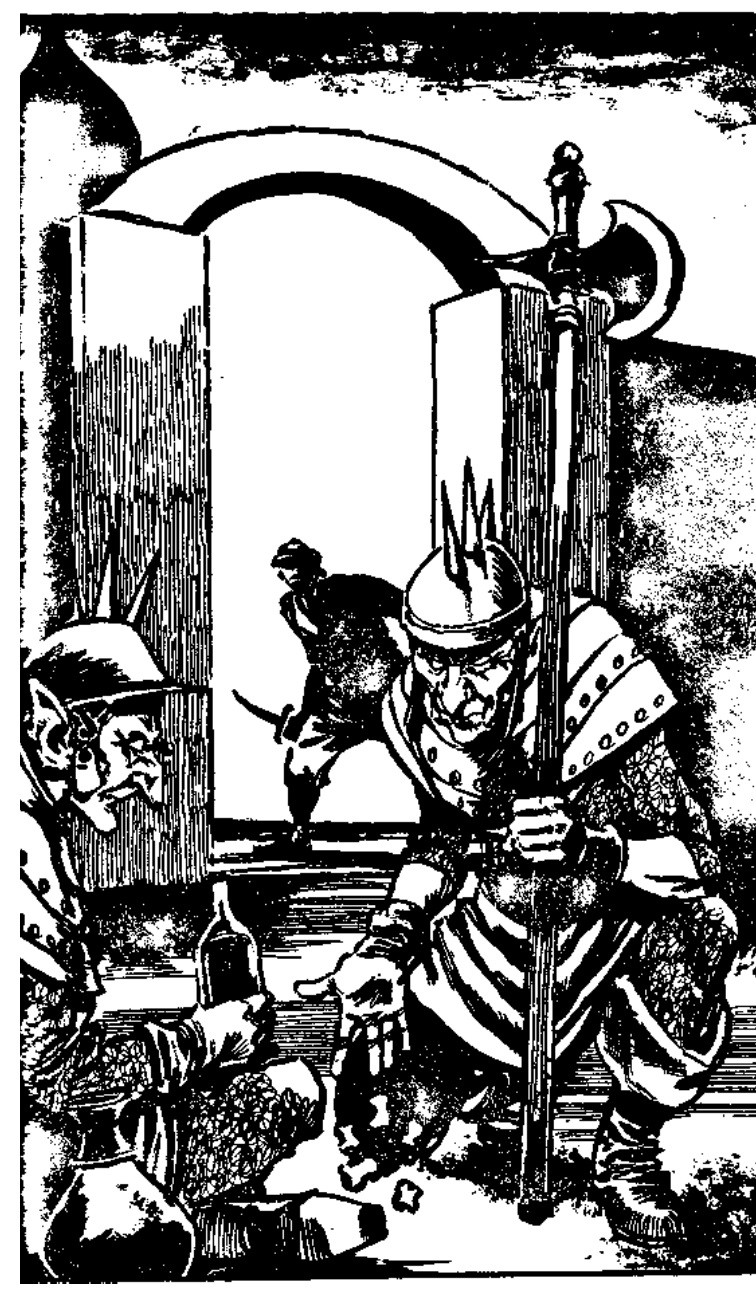
A grognards.txt scout in action.
Next: the other classes are not left in the lurch.
Fighting magic, monster magic, magic magic
Original SA postYoung Freud posted:
There was an old TSR RPG adaptation of the Buck Rodgers property. One of the more striking things about it was that it skirted with the transhumanism that stuff like Eclipse Phase would end up doing better, by having various "races" that have come up from accelerated evolution, mutation, and genetic engineering. For example, the people who could still consider themselves human that colonized and terraformed other planets developed different traits. The "default" "race" was the Earther, who, because of centuries of constant guerrilla warfare and living in a post-apocalyptic wasteland, fighting the Mars-based Russo-American Mercantile and their gene-engineered shark-people supersoldiers, mutant rats and dogs, and each other, developed a superior endurance compared to the Lunarian-, Martian-, Mercurian-, and Vensusian-flavored human.
I really wish someone would cover XXVc. I loved the SSI Gold Box games and yeah, the game did had an early transhumanist vibe with the many human genetic variants and the

Meanwhile!
Dragon Warriors: Book 4
Fighting magic, monster magic, magic magic
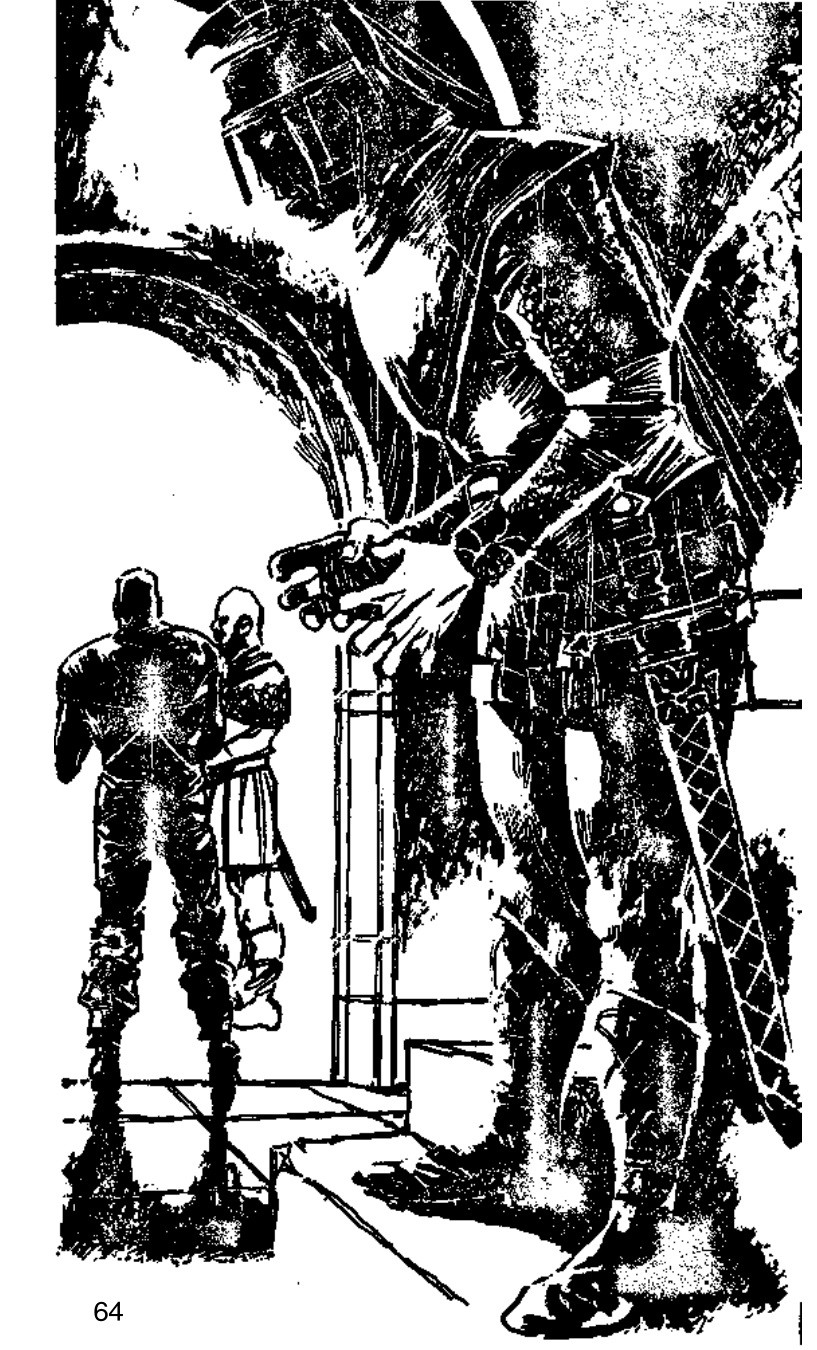
I really need to play Dark Souls some time.
After the killer Assassin class, let's see what Book 4 has for our regular four Professions. All of these new abilities start coming into play at 8th Rank.
Knights gain access to a number of combat skills , gaining one when they achieve 8th Rank and one more per Rank thereafter.
-
Disarm Technique
: the Knight can twist the sword out of an opponent's hand. From the way the skill is written, apparently this only works on sword-wielding foes. When an attacker rolls a natural 20 (an automatic miss) on their attack roll, the Knight rolls 3d6: if they roll higher than the enemy's rank or rank-equivalent, the sword is flung 1d6m away.
-
Expert Parry
: normally, a shield blocks any blow that gets past Defence on a roll of 1 in 1d6. This skill lets the Knight block any blow on a roll of 1 or 2... in 1d10. Strictly speaking this is an increase in odds (from 16~% to 20%) but it doesn't seem like it's worth spending a skill slot in.
-
Main Gauche
: dual wielding! The secondary weapon (a dagger or shortsword) can be used in one of two ways. As a guard, it adds +2 to the Defence score, plus any magic bonuses. Offensively, the Knight can strike with both weapons, forgoing their Defence for the round. Two different attack rolls are made for each weapon, but the target is not penalized in Defence as when defending against two different enemies.
-
Master Bowman
: this skill, that only works with bows and arrows, grants +1 to Armour Bypass rolls, and a 50% chance per round of being able to fire off a second arrow at the end of it.
-
Quick Draw
: this skill only applies to daggers, shortswords and swords, and allows the Knight to take the weapon from its scabbard and strike with it immediately instead of wasting an action to do so. This is explicitly stated to be equivalent to samurai iaijutsu. Fantasy Medieval European Lone Wolf And Cub? Rock.
-
Swordmaster
: this skill lets the Knight score critical hits (automatic armor bypass) on a natural roll of 1 or 2 when using one or two handed swords.
-
Weaponskill
: check it out, Lone Wolf! A separate Weaponskill must be taken for each type of weapon, and it adds +1 to Armour Bypass rolls.
Barbarians get Bloodrage at 8th Rank. In any combat during which the Barbarian takes a wound, they may spend an action to hulk out, roaring and foaming at the mouth. Any non-adventurer that looks at a Barbarian on the throes of Bloodrage has an 80% chance of just running the hell away, and even adventurers of 1st-3rd Rank have a 25% chance of immediate retreat. Bloodraging Barbarians may not use missile weapons, and transfer all their Defence points to Attack: so a Barbarian with Attack 22 and Defence 14 ends up with Attack 36 and Defence 0. They also get +1 to damage, and continue to fight until death at -3 HP instead of falling unconscious at 0. Mind-control spells have no effect on the Barbarian. To shrug Bloodrage off, the Barbarian must roll under their Intelligence on 1d20, otherwise they will continue to fight the nearest possible opponent - even their allies, if no enemies are left. Cool ability, but that's all they get.
Mystics can attempt to attain Adepthood at 8th Rank. They must first find a secluded spot (high mountain cave, bleak island, etc.) and meditate for a week. Game-wise, they get an 1d100 roll per week in which they must roll 96-00 to obtain Adepthood, but the GM may just grant it to a PC if the player roleplays appropriately. Imagine that! The Adept is at the pinnacle of human physical and mental capabilities: Reflexes and Psychic Talent go up to 18, natural rate of healing for wounds is doubled, and they become immune to poison and disease. They're also completely immune to fright attacks, mind control and possession, and no weapon they forge is ever flawed.
Sorcerers can now manufacture Wands. We're told that Sorcerer wands are not like the modern, tiny toy: they are at least a meter long and can measure up to two. Building a wand may cost from a handful of silvers to hundreds or thousands of coins, depending on the particular Sorcerer. A hedge wizard may settle for a gnarled branch of oak, while a majestic court sorcerer may have a pimped out ebony wand with intricate carvings of dragons and other creatures, embossed with gold leaf and studded with rubies. The GM is advised to deal harshly with the normally extravagant PC that sees this as a chance to spend little money on a wand, though. Who will care about the "Master Sorcerer" that lives the noble life yet makes a wand out of driftwood to save money? Enchanting the wand takes three months of work and the Sorcerer may do nothing else during that period. Once it's complete, they must sacrifice some of their power to the wand: each MP permanently sacrificed becomes 1.5 MP for the wand. Each type of wand rules over a number of different spells, and the wand's MP may be used to pay for them. While wielding the wand (which counts as a staff in combat, with no bonuses but magic enough to hit Spectres and Wights) the spells governed by it gain a bonus of +1 to Magical Attack or Speed, whichever is applicable; any other spells suffer a 5% chance of miscast. The seven available types of wands are Mastery (Command and Enslave), Flame (Dragonbreath, Nova and Firestorm), Healing (Miracle Cure, Lesser and Greater Healing, Antidote, Cure Disease), Energy (Shadowbolt and Deathlight), Necromancy (Hold Off The Dead, Reanimate The Death and Animate Bones), Summoning (Wolfcall, Phantasm and Blademaster), and War (Vorpal Blade, Destrier and Armor.) If the wand is destroyed, any MP sacrificed to it are lost forever. Fortunately, only the Sorcerer that built the wand or very powerful creatures like Dragons or Demons can do so.
There's also a list of new monsters! The book tells us they are much rarer and dangerous than the ones in Book 1, and as such should be used sparingly, almost never as just some random encounter. Again, their writeups are for the most part moody and grim, high in the "things that bump in the night" tone. There's some familiar faces from other fantasy games like centaurs, cyclops and such, so we'll skip those.
-
Automata
: artificial metal warriors, built ages ago "by the scholars of the Emphidian Empire - who were themselves drawing on immeasurably older lore from the secret books of Kaikuhuru." Setting! They are 13th-rank equivalent and skilled fighters, but their main draw is their high AF (5) and their 2d6+25 HP.
-
Barghest
: this "faerie hound" lurks in places of death and bloodshed like battlefields and torture chambers. Its eyes have a constant Transfix effect with a Magical Attack of 22, with similar rules as per Basilisks to avoid its gaze. Their spittle is poisonous - but being of a faerie nature, the roll to make is 3d6 under Psychic Talent instead of Strength. Their bark causes an 1d12 fright attack that if successful drains all strength from a character's limbs, and still Weakens them as per the spell if unsuccessful (Spell Expiry rolls apply in both cases.) Finally, it takes only half damage from weapons that are not enchanted or forged of solid silver, and its death howl banishes the soul of any dead character in 20 meters, rendering resurrection impossible.
-
Barudath
: also known as the "Eaves Phantom", this is a sort of vampiric ghost said to appear from the forgotten grave of a suicide. It attaches itself to an out of the way dwelling, trying to feed on the inhabitants' life force, but it may not enter until invited and can only affect the world with a weak 1d4 fright attack until then. Likewise, the Barudath cannot be harmed in any fashion until it truly manifests, except for tracking down its grave and exorcising it. Incarnated, its eyes can Transfix with a Magical Attack of 22, and no armor can stop it from touching a foe for 2d4 damage (minus magic bonuses). In this form, apart from straight using magic and enchanted weapons to harm it, the Barudath can be killed by bringing its mortal remains to the place in which it resides - one look at their own skull, and the phantom will disappear forever.
-
Blue Men
: a favorite tale of old sea wolves, Blue Men are basically undead vikings. They normally attack by showing up in their dragon-prowed warship and sailing next to their chosen prey vessel. Once boarding is unavoidable, the Blue Men chieftain calls to their quarry, describing the terrible fate about to befall them in rhyme. One of the target ship's crew may answer in a couplet refuting their words: if they can think of something appropriate, the Blue Men will refrain from attack, and the characters may counter with their own verbal attack. This may continue on and on until one side falters or gives a lousy response: if the Blue Men fail first, they will depart at once, otherwise they will board the ship. They're 7th rank equivalent, take half-damage from projectiles, and are immune to Sorcerer spells of 1st-4th level.
-
Boggarts
: like Goblins and Hobgoblins, but double the dickery. They achieve automatic surprise against adventurers of 1st-3rd Rank and against higher-ranked ones they get it on a roll of 1-4 in 1d6. They can cast spells like a Sorcerer of 4th rank and have a number of asshole spells of their own, including save-or-die ones like Hoarfrost (the victim starts to freeze: instant 1d8 damage and roll 4d6 under their HP or die instantly, with the effects continuing for another couple of rounds with reduced strength). They can also make all known potions and compounds and will usually be carrying a few of them around for their own use. Fortunately, they're very weak fighters.
-
Cadaver
: a powerful type of undead, Cadavers are the corpses of heroes, elite fighters and warrior saints, resisting decay through sheer willpower and the exalted status they once held. They only wake up when their unearthly nature decrees they must. Principally, this will be profanation of their shrine or tomb, but they're said to wake up when their people or gods have great need of them as well. Cadavers fight with penalties to Attack and Defence in the first five rounds as they shrug off rigor mortis, but at their full skill they're awesome warriors of at least 10th Rank, and normally 12th. They may also have magic items of their own and will use them in combat. Cadavers need not be always hostile, especially if the adventurers are fighting for a cause the Cadaver champions, but as it cannot speak communication may be difficult. Oh, and they're immune to mind control of any sort.
-
Caitshee
: the Faerie Cat lurks in cemeteries, woods and abbeys. It moves with great Stealth and a character below 4th Rank just won't see it in darkness. It likes to attach itself to a party of adventurers and follow them unseen, and its mere presence jinxes the spells of the casters: Sorcerers have 50% chances of miscast, and Mystics bungle their spells 35% of the time. Even spotted, hitting the Caitshee is hard and penalties to Attack and Defence apply unless characters may see invisible creatures or in the dark. Only enchanted or solid silver weapons may hurt it, and its claws ignore regular armor. They have a Weaken effect with a Magical Attack of 17. Also, damage dealing spells only cause their minimum damage on a successful hit. Finally, the character that deals the fatal wound to the cat gets hit with one of a number of special curses, which are basically all assholish - treasure they touch is debased, they have very poor luck in combat, they become deathly afraid of cats, etc. The curse may be lifted by touching a sacred relic or by a 20MP Dispel Magic.
-
Chimera
: with the forequarters of a lion, a serpentine body, ram-like horns and wings halfway dragon halfway eagle, Chimeras are so plain
weird
they achieve automatic surprise against characters of 6th Rank and above, and a shock attack against lesser adventurers. They may use their tail to constrict up to two characters while still being able to fight, and three times a day they may fire Magical Attack 25 rays that render their targets helpless, reducing their Attack and Defence to those of a 1st Rank character and nullifying their spellcasting abilities. This is fortunately temporary, and on a roll of 8 in 1d8 every round after their abilities will return.
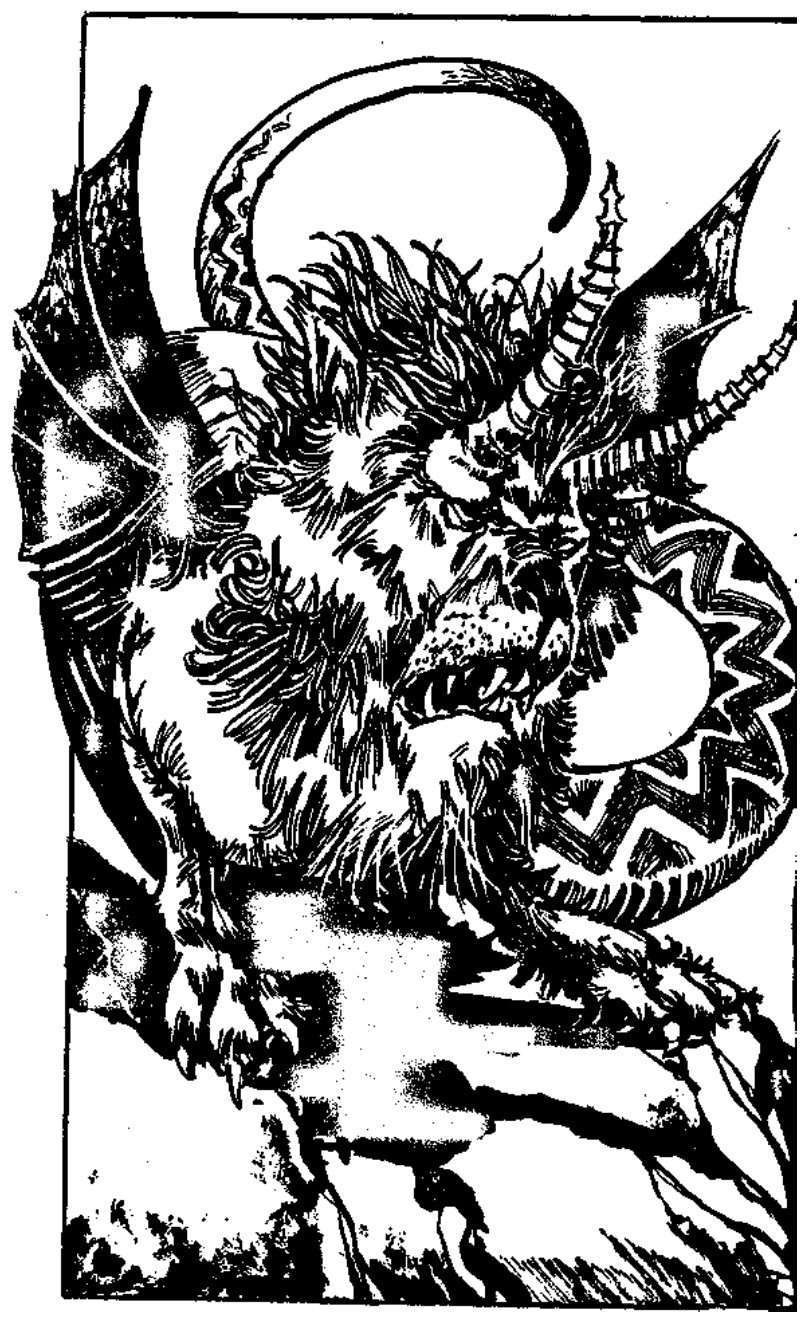
I would be freaked out too.
-
Chonchon
: dang, a creature from my own country! Chonchons are disembodied heads that use their huge ears as wings. They have magical powers (Sorcerer power of 4th to 9th Rank, 6th being average), which has lead to a superstition that they are Transformed sorcerers that cannot return to their natural form. They are invisible to characters below 5th Rank. They may be driven off with a crucifix as with vampires, and there is a special spell that will force the Chonchon to plummet into the ground, helpless until another Chonchon comes to its aid. The spell can be cast by any Mystic or Sorcerer of 5th Rank or higher, but it is not part of the usual canon of spells and finding someone that can teach it will not be easy or cheap.
-
Cloudspider
: a horrible creature that lurks in the deepest underworlds and dungeons. They have a cry with an 1d10 fright attack that drives the victim senseless with fear for 2d6 rounds. They're also surrounded by a mildly corrosive mist that makes the creature's body hard to pinpoint, and will irritate the eyes of anyone trying to engage the beast in melee. Oh and of course, strong save-or-die poison because fuck spiders.
-
Fungus Men
: a sort of but not really undead creature, Fungus Men are skeletons covered by a "saprophytic" mold that consumes the remaining tissues of the corpse (or, more rarely, a living person
 ). The sight of them is so disturbing it that characters fight at -2 to Attack and -1 to Defence unless they roll equal to or higher than their Psychic Talent - psychically sensitive people are particularly affected. There's a 10% chance than spores from the fungus will take root in a character's flesh, and then the character will lose 1d6 HP per day unless they make a Strength roll each day. Only a Miracle Cure or Purification may save the character, and if killed by the fungus it will rise after a week as another Fungus Man.
). The sight of them is so disturbing it that characters fight at -2 to Attack and -1 to Defence unless they roll equal to or higher than their Psychic Talent - psychically sensitive people are particularly affected. There's a 10% chance than spores from the fungus will take root in a character's flesh, and then the character will lose 1d6 HP per day unless they make a Strength roll each day. Only a Miracle Cure or Purification may save the character, and if killed by the fungus it will rise after a week as another Fungus Man.
-
Grave Gaunt
: scavenging, winged undead of unknown origin. They fly and fight with spears, and the wounds caused by their antlers expose characters to the Wasting Disease of Book 3. In addition, damage caused by them cannot be healed by magic, only naturally.
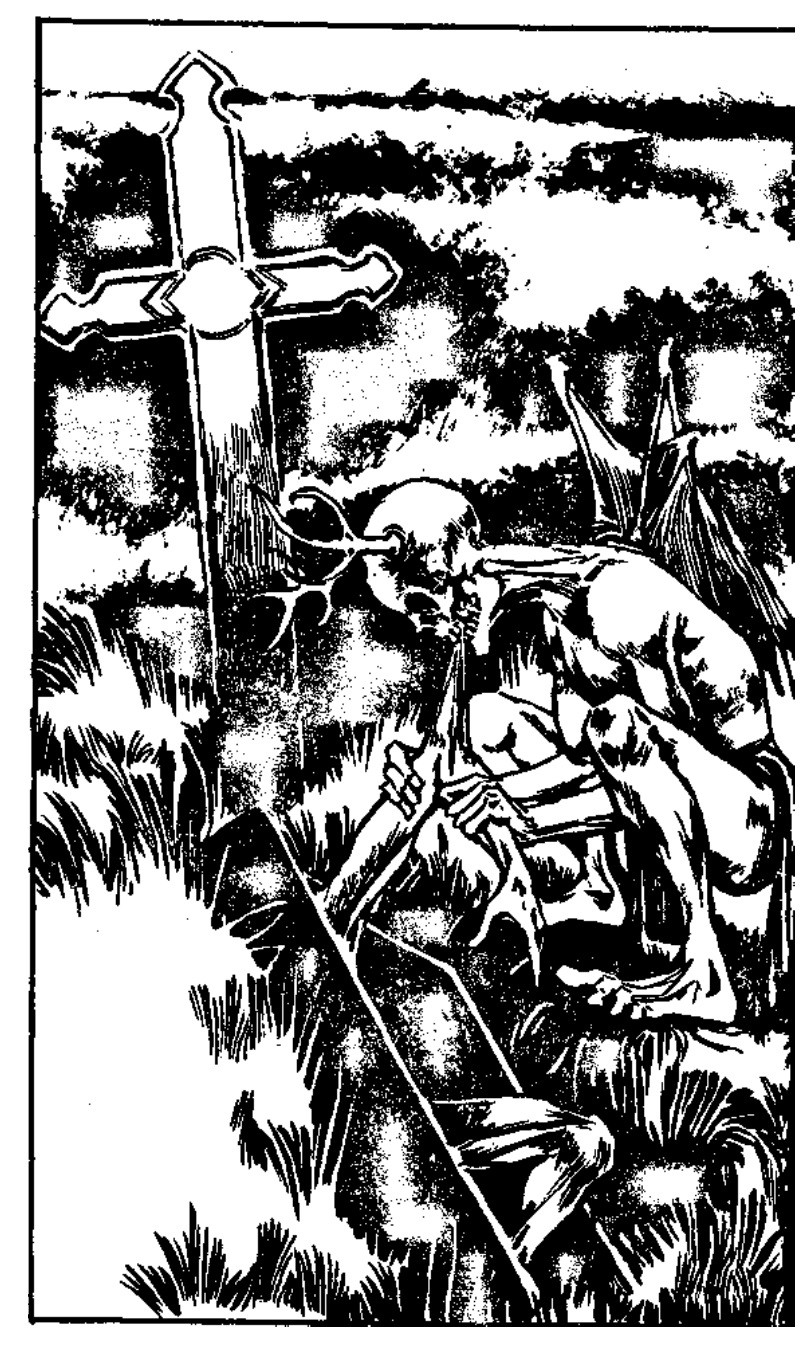
I saw this guy on that one metal album cover art. You know the one.
-
Hag
: of the cackling, screeching, Macbethian sort. A hag has the powers of a 4th Rank Sorceress, but her MP fluctuate with the moon, being at their strongest in full moon and and their weakest during the new moon. More fright attack gazes, stench so bad attackers are at -1 Attack, an hex that strikes anyone engaging her in melee and that if successful reduces Looks to 2 because
fucking warts everywhere
. Oh, and she carries the Black Death. They can fly, too, with a special item, normally a broom or cauldron. Or they can just use a "Night Bridle", encircle it around an opponent's neck (attack roll) and if successful they may turn them into their flying ride! The sight of the cross sends her packing, though, and tricking her into eating salt nullifies her spells. Weapons of iron and steel inflict 1 extra point of damage, too.
-
Hellion
: soulless, cackling monstrosities, servants of the Prince of Darkness! 2spooky. They come to this world to gather souls, either by just murdering someone or by perverting them. They always choose someone already flawed for their attentions, though, and rarely will someone free of vice and blame be troubled by them. Hellions are wildly varying in capabilities and power: they are generated at random, with rolls to be made for attack potential from 1st Rank Barbarian to 15th Rank Knight, for instance. So they may be just mooks with little strength to party-killing beasts. Regardless of their strength, no Hellion may harm or approach within 2 meters of someone bearing a relic, and they can be driven off with crucifixes.
-
Hippogriffs
: only checking them here to say that they can be trained by Knights and Barbarians: they must roll under their Strength+Reflexes+Rank in 1d100 each day for three consecutive days to do so. Failure indicates the character gets to roll in the Hippogriff Wound Table, getting anything from an 1d6 wound to a broken neck.

-
Hydra
: like the one in FUCKING GALLOWS WOOD GODDAMN. New things here are that its heads spit corrosive venom spit that deducts permanently 1 AF point from armor if it hits and may be collected after the hydra's death for two applications of Assassin's Lotion. Nine of its teeth are magical and will show up to detect enchantment spells. If collected, thrown on the ground and infused with magical power (equivalent to casting a 4th level spell for a Mystic or Sorcerer), they will grow into
Fang Warriors
, fearless magic defenders. Spell Expiry Roll done with 2d4 to see how long they last and the tooth becomes inert after it, but they're pretty good fighters.
-
Imp
: these little guys don't get other stats than (very high) Stealth and Perception, as they're not really meant to be fought. They are thumb-sized sprites, with spindly limbs and mead-filled pot bellies. Imps are invisible to characters below 5th Rank, though Elves will always be able to see them. They're irritating, cryptic, and love to play pranks on passing adventurers, but they know everything that goes on in their neck of the woods and someone that shows patience and good nature may bargain for valuable information. If truly pissed off though (like driving them off with crucifixes, which involves calling the imp "Robin" and inviting it to kiss the crucifix - is this part of a legend?) imps can do things like send bees after the characters, or obscuring trails and roads.
-
Ire Goblins
: or Bugbears, as they are also known. They're aggressive hunters, banding in groups of ten to fifteen members, and attack anyone they see. They have no magical powers, but a wounded bugbear starts swelling and growing in size, increasing its Attack and HP and getting bonuses to Armour Bypass. There's also an aside on the etymology of the word "bugbear," for some reason.
-
Jumbee
: a variety of undead that always shows up in groups of three, taking the forms of a young man, a maiden, and a wizened figure of undetermined sex. They cannot be readily distinguished, but they prefer to latch on to a single victim of parties they find, who can see them clearly. If the victim surrenders to the Jumbees' faint whisperings of death, they will absorb their lifeforce and force them to fade forever from this world, leaving the rest of the party unharmed. Any other course of action will make the party suffer the effects of a curse that increases any future fright attacks they suffer by 1d6. In combat, the Jumbees cluster around the victim, touching it through their armor with their ghostly hands. The young man drains 1 Strength point on a successful hit, the maiden drains 1 Reflexes point, and the old figure drains 1 XP - while the other two scores recover at the rate of one per day, XP losses are permanent.
 They can also drive their victim mad with fright - 1d10 fright attack, and this madness is incurable to boot. Physical attacks against the Jumbees have a 40% chance of causing the weapon to shatter, spells have a 40% chance of miscast, and any magic item used against them has a 10% chance of losing its enchantment permanently. So yeah, fuck them.
They can also drive their victim mad with fright - 1d10 fright attack, and this madness is incurable to boot. Physical attacks against the Jumbees have a 40% chance of causing the weapon to shatter, spells have a 40% chance of miscast, and any magic item used against them has a 10% chance of losing its enchantment permanently. So yeah, fuck them.
-
Kappa
: apparently a race once akin to mankind, Kappa inhabited a floating island in the olden days and ruled over the primitive human tribes. They enslaved their gods for power, who retaliated by subtly causing natural disasters that grew in intensity until not even divine intervention could stop them. Terrified Kappa promised freedom to their gods if they would deliver them from destruction, which came with a big price - turning the Kappa into the stunted underwater beings they are today. They are poor individual fighters but good at tactics, their warbands militarily organized. Most dangerously, their generals (Sorcerers of 9th+ Rank) can mesmerize captured foes, turning their allegiance permanently. They'll rarely bother individual parties or travelers - if they come to land, it's for a military assault on a sea fortress or lighthouse. At least there's nothing here about pulling balls from assholes.
-
Krask
: flying manta rays, oh my. It flies well in the still air of underworlds, but will hug the floor in strong winds. It can deal electric shocks with its tail, causing characters to pass out if they fail a Strength roll in 1d20. Their skin can change color to some extent, granting them 1-3 in 1d6 odds of surprise, and they can also produce a disorientating pattern of lights that confuses victims if the Krask rolls equal to or under (3d6-victim's Rank) in 2d10. Random rolls, ho! Befuddled victims are at Defence 0 until they suffer a wound. Its flesh cannot be cut and as such only takes half damage from cutting weapons. Their pelt is highly valuable, and can fetch up to a hundred Crowns.
-
Malgash
: the Balrog. As in, Tolkien's Balrog. The book is pretty open about the fact they took it from the Lord of the Rings, too! 25th Rank, 60 HP, a nasty sword, a fire whip, all the bells and whistles. Hope you have a pipe-smoking wizard with you - or more than one, as the Balrog can just NOPE a single spell (as a free action) up to 9 MP. It must then wait until its dispel magic ability recovers at the rate of 1 MP per round.
-
Mere-gaunt
: weirdass creatures that lurk in stagnant ponds, lakes and canals. They attack with rusty knifes, sometimes spells (1 in 20 Mere-gaunts has the powers of a Mystic) but they prefer to just grapple people and show them THEIR HORRIBLE FACE, which is so horrible it subjects the victim to an 1d8 fright attack. While paralyzed with fear, the victim gets to enjoy the Mere-gaunt's sharp 'tongue' impaling them.

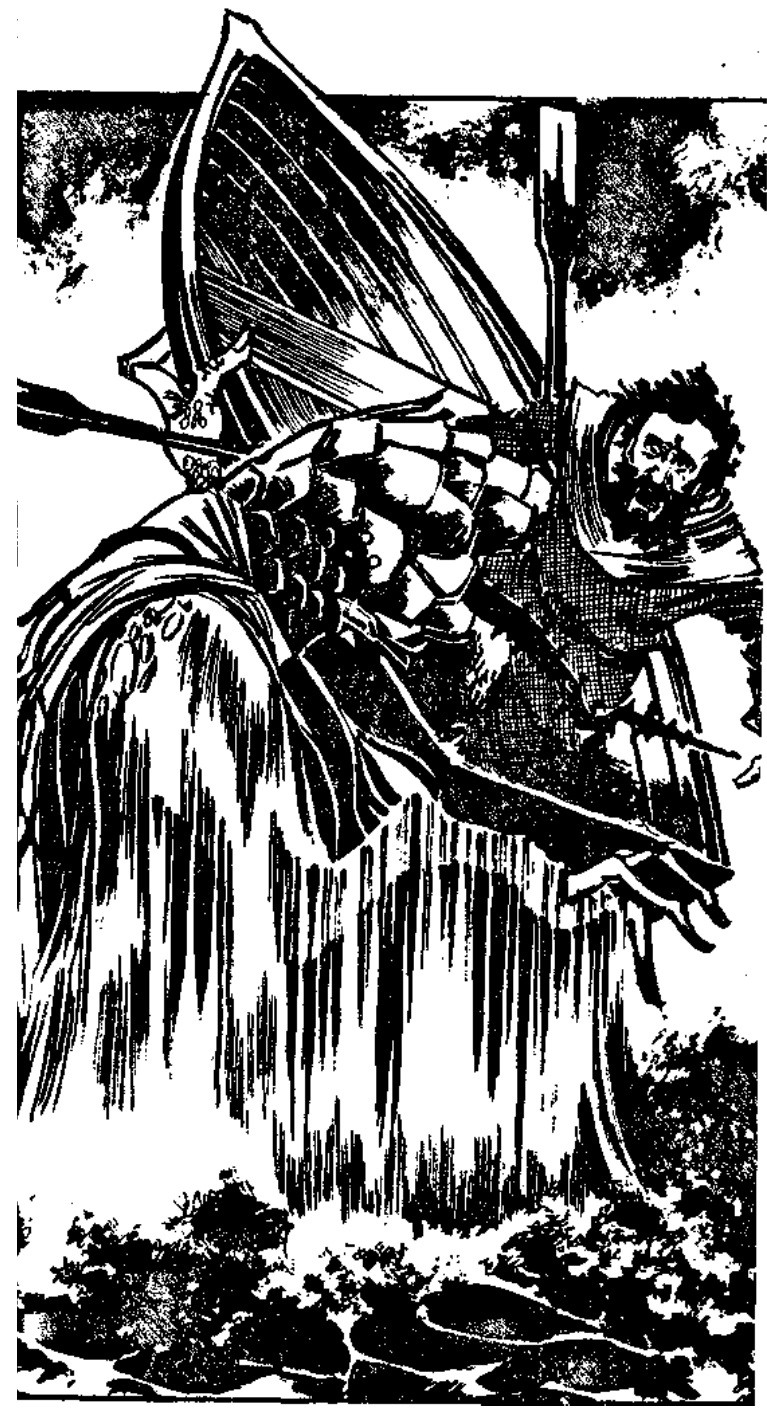
It keeps happening!
-
Mordu
: undead headless warriors AAAAAIIIEEEE. 1d10 fright attack on sight ('rarely fatal', only 10% odds of a heart attack!). Other than that and their AF of 5 with immunity to non-magical weapons, they only have magic two-hander swords and reasonable Attack and Defence scores. Oh, and they're immune to direct-attack spells, and daylight does nothing to them.
-
Necrochor
: wizened undead, "sometimes placed in the pyramids of the God-Emperors of Kaikuhuru to act as tomb guardians." They cast spells as a 6th Rank Sorcerer, but have less MP and always cast their spells at the end of a round as they must perform elaborate sequences of ritual motions and holy fuck we can totally reenact Golimar with these guys. Embalmers of the XIII and XIV Dynasties were fond of filling their bodies with magically dormant scorpions: if struck with an edged weapon, 1d4 scorpions will jump out and strike the offending character with strong poison stingers with 1d8 Armour Bypass rolls. Assuming the character survives, the character can brush them off in one round, and on the ground the scorpions are only a threat to barefoot individuals. You could always burn the Necrochors, though, as fire kills the scorpions in their bodies. They don't have the Doom ability of a 'true' Mummy.
-
Nightmare
: also a creature with no stats. It only has a sleep spell with Magical Attack of 2d6+14 that it uses on watching characters. If everyone in the party is asleep, it enters their collective dream world, toying with them and subjecting them to all sorts of unpleasant experiences. The Nightmare itself takes either the form of a Big Bad, a treasure to find, a secret place, even something more metaphysical as a truth to understand (taking notes for my SLA/Dragon Warriors crossover game), or even as a friend of the characters. A character that dies or otherwise suffers a final fate in the dream must roll to wake up: 1d20+Rank, and roll higher than their Psychic Talent score. Inexperienced, highly gifted characters are thus the most at risk. Characters that fail the roll suffer in reality their dream fate: slain characters die, imprisoned characters become catatonic, and so on. The Nightmare may choose to single out a character instead of a whole party, causing them to sleepwalk and hack away at their companions (monsters in their dream), or visit them again and again, stress reducing Strength and HP in three. Exorcism can drive them away, but singled out characters see their hair turned stark white and all fright attacks directed against them get a +2 bonus, forever.
-
Okemen
: Ents! The game doesn't acknowledge it this time, though.
 They watch over the forest they live in, and have no quarrel with normal huntsmen, woodsmen, Elves or regular good folk - they're as part of the forest as anything else. Monsters and Captain Planet villains get a 7 damage tree punch to the face, though. Fire attacks deal extra damage and have a chance of setting them of fire - if they fail to put them off, Okemen have a final fuck you in the form of calling down lightning with their last breath, equivalent to a Deathlight spell on 2-8 opponents.
They watch over the forest they live in, and have no quarrel with normal huntsmen, woodsmen, Elves or regular good folk - they're as part of the forest as anything else. Monsters and Captain Planet villains get a 7 damage tree punch to the face, though. Fire attacks deal extra damage and have a chance of setting them of fire - if they fail to put them off, Okemen have a final fuck you in the form of calling down lightning with their last breath, equivalent to a Deathlight spell on 2-8 opponents.
-
Oni
: the "Ogres of the East", rarely found in other parts of the world. Oni are invisible by daylight, but they still cast a shadow and thus find little advantage in it. They can take the form of a human or animal, but they're bloodthirsty and not particularly bright, so characters have a 5% chance per minute of noticing something wrong with their disguise when interacting with them. Oni are so ugly that they get a shock attack on anyone below 8th Rank. They can breath poisonous fumes that reduce Intelligence in half if the relevant saving throws are failed, their claws drain 5 XP per hit, and they cast spells as a 6th Rank Mystic only without the Enthrall spell.
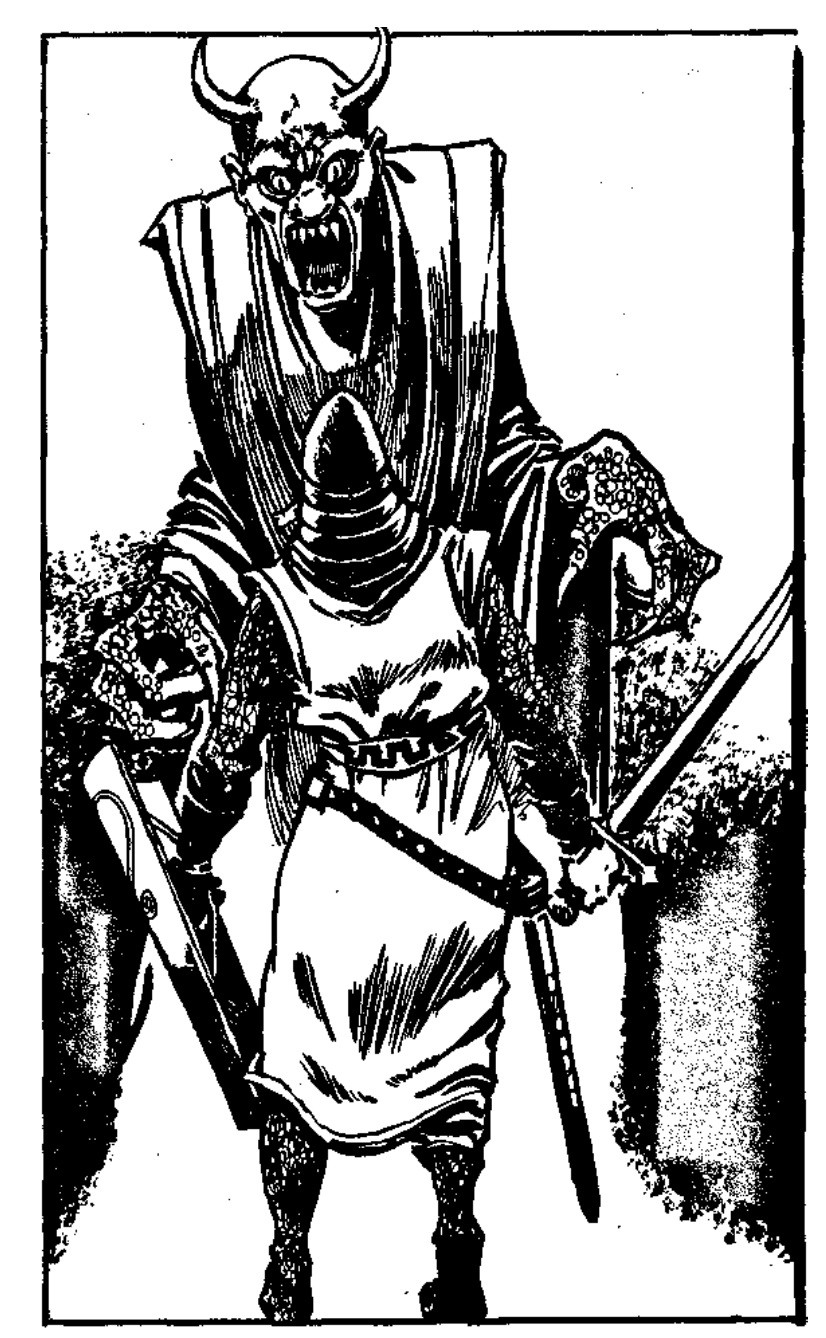
Even in the '80s, ウイックのばか
-
Rakshah
: these guys are, well, they're lion's heads with five legs sprouting out of them. It may adopt a human or animal form, but its disguise is even easier to see through that the Oni, and it won't fool anyone that knows the impersonated character well. The Raksha attacks with 1-3 legs at the time, and every time it hits (max of once a round) it casts a Magical Attack 20 effect that takes the victim straight down to zero HP. It can use Sorcery of 1st to 6th Level, and regains no MP during the day, but 1 MP per round during the night. They can also catch lightning or fire spells (20%) in their mouth fire them back at the caster, and once struck by one spell they're immune to repeated castings by the same sorcerer until the next sunrise.
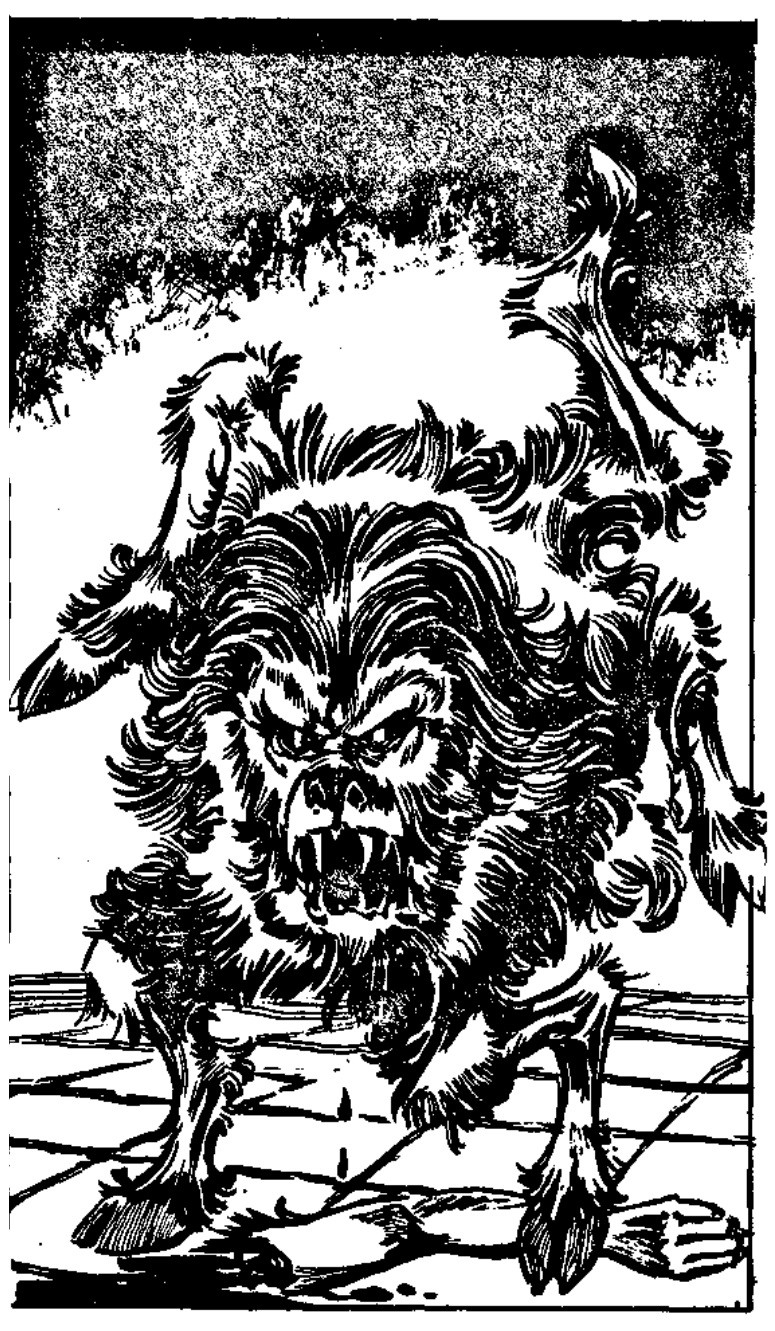
Gaaaah!
-
Shadow Walkers
: strange creatures that lurk "in the half world, where Reality shades into Illusion." They take the form of one character in a party and mimic them completely, right down to their mannerisms and memories. It will then attempt to convince the rest of the party that it, in fact, is the original. It can only take another form if everyone who saw its original manifestation is dead. It attacks with the same stats as the person it copies, and even has the same magic items - that vanish into air if it is slain.
-
Shen Lun
: the dragon species indigenous to the Orient, or so the book says. The Black Dragons fly using magic and can fire lightning bolts. They're arrogant and often violent, but one in four have the abilities of a Mystic. These are the most interesting, because as they grow in power they become more contemplative and pondering of the Mystic Way. Failure to achieve enlightenment at this point can make the Black Dragon sullen and ferocious, but those that persevere will try to find a human teacher and achieve Adepthood. Adept Shen Lun become human and lose all their dragonish abilities, leaving behind their horns (components for magical flying devices) and a magic pearl. Its powers will become clear in Book Six! Man, fuck these metaplotty games.
-
Skullghast
: flying skulls of doom! Usually found as guardians in ancient temples, they have (you guessed it) a fright attack of 1d12 strength that reduces Strength and Reflexes by 3 for the rest of the battle. They attack with halos of spirit fire: damage caused by them doesn't heal with Lesser Healing or Invigorate and reduce MP in 1 for Sorcerers, or force Mystics to check for fatigue as if they casted a 1st level spell. Hold Off The Dead does not affect them for some reason.
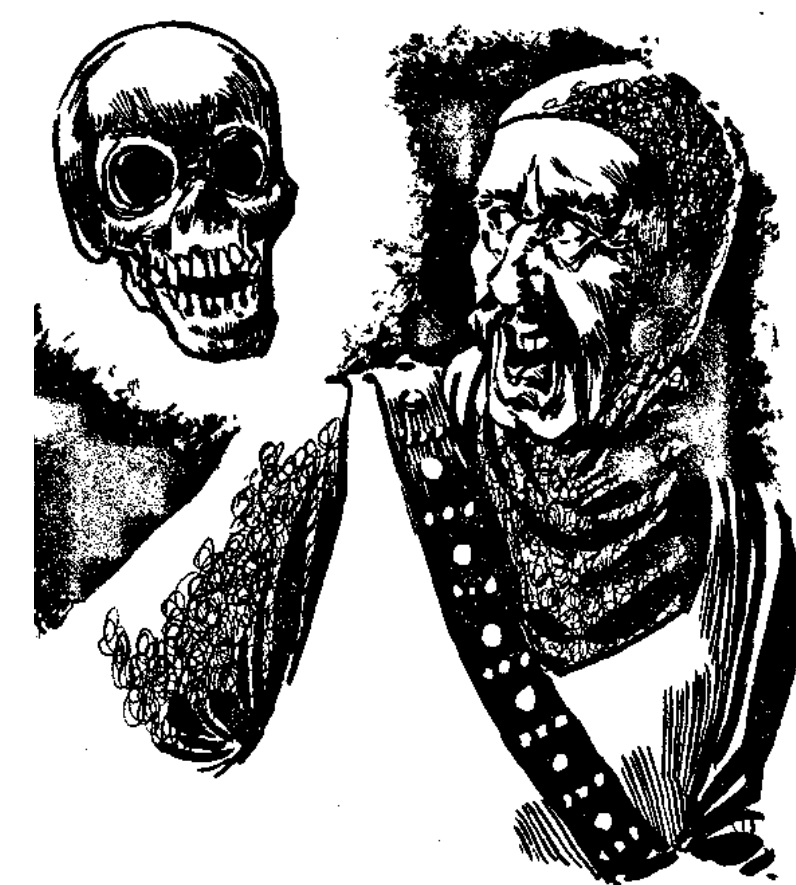
What's eating you?
-
Spriggans
: spiteful little faerie fucks. They prefer to swarm their foes, and they're invisible to characters below 5th Rank, elves excluded. They have some minor spellcasting ability, too, with some quirks - they can Curse, but it only hits one character instead of the normal 1-4, and their Illusions can be three times as big as normal. Wounds they cause take three times as much to heal naturally.
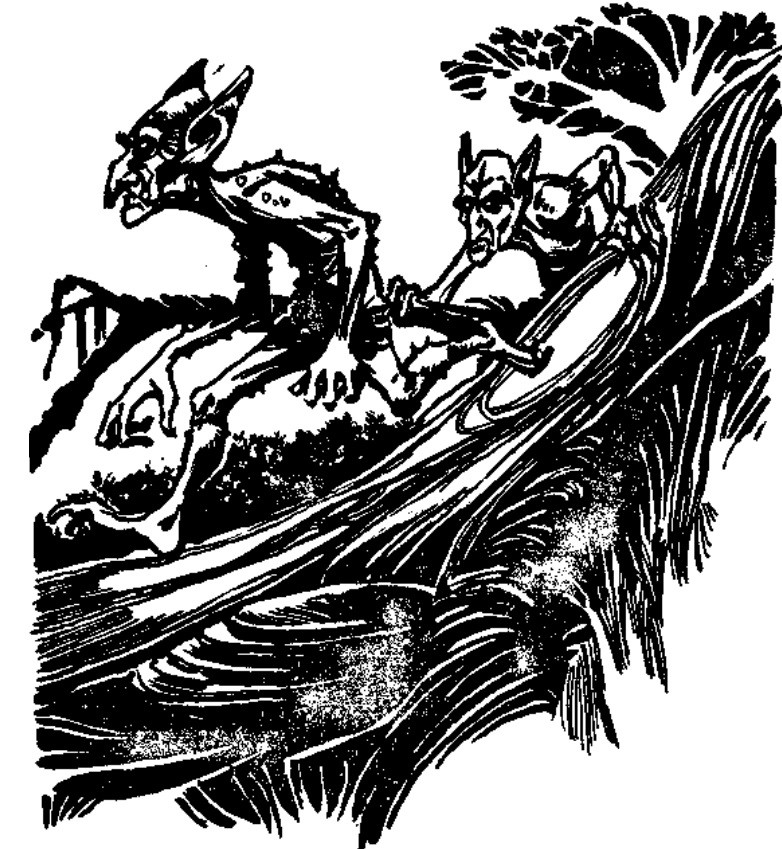
Now imagine fifty of them jumping your ass.
-
Water Leapers
: something like huge, white, limbless toads with leathery wings and a long tail. Their gurgling shriek has a Magical Attack of 20 that if successful turns the victim's bones to jelly. Literally.
 Fortunately, surviving it renders the characters immune to it. Its bite is poisonous, and it may try to swallow characters whole. If they keep their wits about them, though, characters with daggers and shortswords may hack away at the Leaper, which will then regurgitate them.
Fortunately, surviving it renders the characters immune to it. Its bite is poisonous, and it may try to swallow characters whole. If they keep their wits about them, though, characters with daggers and shortswords may hack away at the Leaper, which will then regurgitate them.
Next: let's check on ol' Baron Aldred.
EDIT: there we go.
Medieval Fantasy Those Half Life 1 Levels With The Black Ops Ninja
Original SA post Dragon Warriors: Book 4Medieval Fantasy Those Half Life 1 Levels With The Black Ops Ninja
Let's start with the first of three adventures in this book! These follow on with the Baron Aldred adventures from Books 1 and 2, but also take into consideration the possibility of the party having gone into adventures of their own too (like The Elven fucking Crystals). By my calculations, this should put the characters at around 5th Rank or so. The first adventure, The One-Eyed God , requires GMs to be familiar with the Assassin rules - Assassin PCs will be useful, but more importantly, one of the main villains is an Assassin.
The characters are by now full retainers of Baron Aldred, and it's their turn to be on watch on the battlements at night. Suddenly, the characters hear shouts and commotion, and soon they spot the Baron's eldest son, Almeric (who will be more important in the next adventure). He will inform the PCs that there has been an attempt on the Baron's life - and sure enough, the Baron himself appears before long, fuming and ready to break someone's neck. That someone would be Ulfalder , a knight that had been staying at the castle for some days and that now has conveniently escaped the premises. The Baron orders the PCs to chase the assassin post-haste. Hopefully they'll bring him back alive, as the Baron wants to kill him with his own hands

A Mystic character may use the Pursuit spell to track Ulfalder down, otherwise the Baron will assign Jenks, a trusted servant and experienced woodsman to accompany them. Ulfalder will have left several false leads in his wake to throw off pursuers, but Jenks is smart enough to see through them, and in any case Pursuit renders them moot. Before long, they'll come across Ulfalder's horse, dead. The beast must have broken a leg and the killer finished it off. There are signs that Ulfalder fell too, and if he is hurt he can't have gone too far. There are some hovels around in the moorlands, and their inhabitants won't be too pleased to be woken up at such late hours, but this is official Baron business so they can
 The peasants will inform that they heard their dogs barking an hour ago, but they paid no attention. If that guy was their quarry, they'll say, then he was going in the direction of
Valour Hall
, and thus he is not long for this world. Questioned further, they'll say Valour Hall is a barrow best left alone. The one-eyed "Wooden Man" lives there, sleeping under the mound in the gold armor in which he was buried. Gold and jewels all over his body, they'll say - and a great pit leading straight into Hell next to him.
The peasants will inform that they heard their dogs barking an hour ago, but they paid no attention. If that guy was their quarry, they'll say, then he was going in the direction of
Valour Hall
, and thus he is not long for this world. Questioned further, they'll say Valour Hall is a barrow best left alone. The one-eyed "Wooden Man" lives there, sleeping under the mound in the gold armor in which he was buried. Gold and jewels all over his body, they'll say - and a great pit leading straight into Hell next to him.
Priorities, adventure posted:
Does a lust for treasure shine in the character's eyes at this point?
This is just the local folklore, of course, but the fact is that there is gold in the barrow and people have actually seen the Wooden Man (unlike Hob's Dell and Gardener Jack in Book 2). They hold a Samhain ceremony to propitiate him, and in fact their beliefs may have parts of old myth: Valour Hall being Valhalla, and the Wooden Man being none other than Woden/Wotan/Odin/however the fuck you write it. The truth, however, is of a more mundane (if still supernatural) sort: the barrow is home to a Boggart and six Goblins, and the Boggart uses its powers from time to time to make the "Wooden Man" appear at the entrance of the barrow. Ulfalder is running here because, as an agent of Baron Montombre (Baron Aldred's nemesis), he knows Cynewulf, Montombre's court sorcerer, has set an Astral Gate here for his escape. However, the Boggart and the Goblins blocked the tunnel to the Gate, annoyed at the intrusion, and now the Assassin is busy trying to clear the way to his escape. Not that it will do much good to him: by now Cynewulf knows through his speculum that the hit failed. Montombre does not tolerate failure, so the gate is connected to a second gate that leads right into a inaccessible Gryphon lair.

As for the barrow, its passages and rooms are made of irregularly shaped stone, and there is plenty of pillars and buttresses to hide. In short, Assassin Stealth can be used at its fullest, and Ulfalder (7th Rank Assassin) will make the most of it. He will hide once he hears the characters approach, and the hunted will become the hunter. The Boggart and the Goblins can move freely through the barrow using small tunnels only they can fit through. For the most part, the Goblins want to have fun watching the PCs and Ulfalder kill each other, and will try to extend the fight as long as possible, either intervening for the losing side in a fight or just sniping people at random with their slings. But there are things in the barrow even they fear...
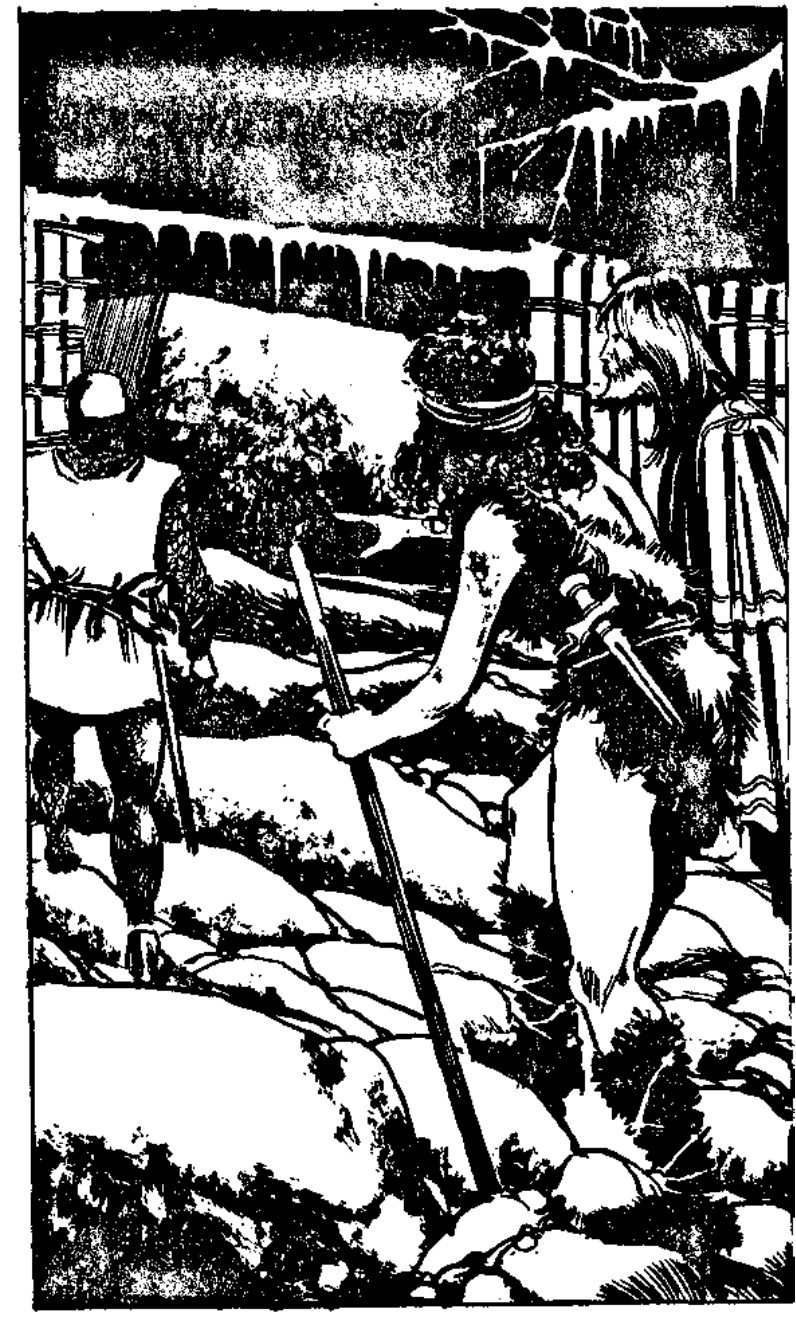
Come out, come out, wherever you are.
The entrance chamber has a lintel with the face of a bearded man with a patch over his left eye. He seems to be staring at a fixed point on the floor, but characters searching there will find nothing. Unless they think of covering their left eye, in which case they'll spot a depression with a bright gold amulet in it (characters that don't cover their eye will see their companion's hand disappear into the floor as they pick up the amulet.) It is an Amulet of the Underworld, and it will come in handy later. Soon, the characters will find a chamber from which the most delicious smells come from: a tall man in white robes is in there. He will introduce himself as Althas , and will invite the characters to partake of his feast. Althas will say he is a priest, and that there is an evil entity in the barrow that only his magical efforts keep in check, and he will also claim to know where Ulfalder the Assassin is hidden, but he will be evasive about everything else. The feast is not poisoned, but is not nearly as tasty as it looks, and if the characters attack Althas for some reason, he will not attempt to defend himself, but any wounds he suffers will heal instantly. In fact, this is all the Boggart's work - the feast is just a magic Banquet, and Althas is an Illusion (5% of spotting it if the characters analyze him carefully). At least the silver tableware is real, worth about 1000 Florins. The Boggart wants to get as many characters as possible inside the dining room, then hit them with his Mist spell, a confusing area-of-effect spell with the added danger of possibly making characters vanish from this world if they're still lost in it when it ends. If some characters stay outside, the Goblins may risk a quick hit-and-run.
Ahead, the tunnel is blocked to the right (the creatures' work). Ulfalder was working here, but he's gone, of course. Three characters should be able to clear the way in about 15 minutes. Behind the blockade, they will find the Gate , as well as five rats of the ordinary kind. They have been commanded by the Boggart to jump into the gate if anyone made it into the room: the Gate has 1 in 6 odds of vanishing every time a rat jumps through it. They will only do so if the Boggart is still alive; otherwise, they will attack the characters for one round trying to escape through them. Little peril here, if you don't count the fact that they carry The Black Death.
 Moving on further into the barrow, they will find a chamber full of
old hunting tools
- rusted arrow-heads, corroded iron spears, hunting horns, mummified dogs. Not much of value here, but the spears are still usable. Another chamber to the right holds a heavy bronze cauldron that once hung from the ceiling, but is now on its side. It has an image of hunters chasing (or being chased, it's hard to tell) by a giant boar and a giant stag. The adventure takes its time to tell us the boar and stag are Helvennian and Garambar, "beast-deities who occupied an ambiguous position in the barrow people's pantheon." Not that it matters as this is just scenery. Moving on!
Moving on further into the barrow, they will find a chamber full of
old hunting tools
- rusted arrow-heads, corroded iron spears, hunting horns, mummified dogs. Not much of value here, but the spears are still usable. Another chamber to the right holds a heavy bronze cauldron that once hung from the ceiling, but is now on its side. It has an image of hunters chasing (or being chased, it's hard to tell) by a giant boar and a giant stag. The adventure takes its time to tell us the boar and stag are Helvennian and Garambar, "beast-deities who occupied an ambiguous position in the barrow people's pantheon." Not that it matters as this is just scenery. Moving on!
There's some sort of burial chamber further on, the floor littered with broken glass cups, drinking horns and so. There are some ancient skeletons wearing scraps of broken armor, but some other bodies look way too recent. These are the remnants of adventurers that were killed by the Boggart and the Goblins, dumped here after being stripped of all valuables. There is a magic item here, though it will take a roll of 1-3 in 1d100 for every round of searching per character to find. This is a magic horn that, if picked up by a male Knight or Barbarian, fills to the brim with mead. The horn holds three liters: the first one does nothing when drunk, but each liter drunk thereafter reduces Attack, Defence, Evasion, Stealth, Perception, Reflexes and Perception in 1 temporarily. Effects vanish after one hour, and if any stat hits 0 because of it the character just passes out. However, putting down the horn while there's still mead in it, or pouring it away, will make a luminous gold warrior appear out of nowhere and strike at the offender with an Attack of 28 and a d10/5 sword. The mead can be shared among several characters, mind you.
At the end of the passage, there is a deep pit , spanned by a narrow spike of rock. There is an intricately carved door beyond the pit, which also happens to be full of fucking poisonous snakes. There is a wooden staff in their midst, and some sort of egg-like object floats above it. The pit is 10 meters deep and it will take Reflexes of 10 to cross the spike of rock without rolling. Using some sort of pole (like one of the old spears) for balance grants +5 to Reflexes for these purposes. To take the egg, a character will need to be lowered down using ropes from both ends of the pit. Any other strategy will end up most likely with everyone involved falling into the pit, the book tells us, which means certain death unless Impregnable Sphere or some other powerful magic is cast on the poor sods. Also, this is just the time for Ulfalder and/or the Goblins to attack. The egg is a magical Serpent's Egg, and its powers can only be used if the character knows what it is (automatic knowledge for 4th Rank+ Sorcerers, 25% chances of knowing it for any other character). The Serpent's Egg can be used to treat poisons (20% chances of working as the Antidote spell or, if used in conjunction with a Sorcerer's Antidote, outright negating any toxins in the patient's bloodstream), warn of danger (20% chances of being alerted to incoming attacks if it's being touched, negating surprise and shock attacks) and nullifying critical hits (again, 20% chances, and the hit becomes a regular hit and requires an Armour Bypass roll)
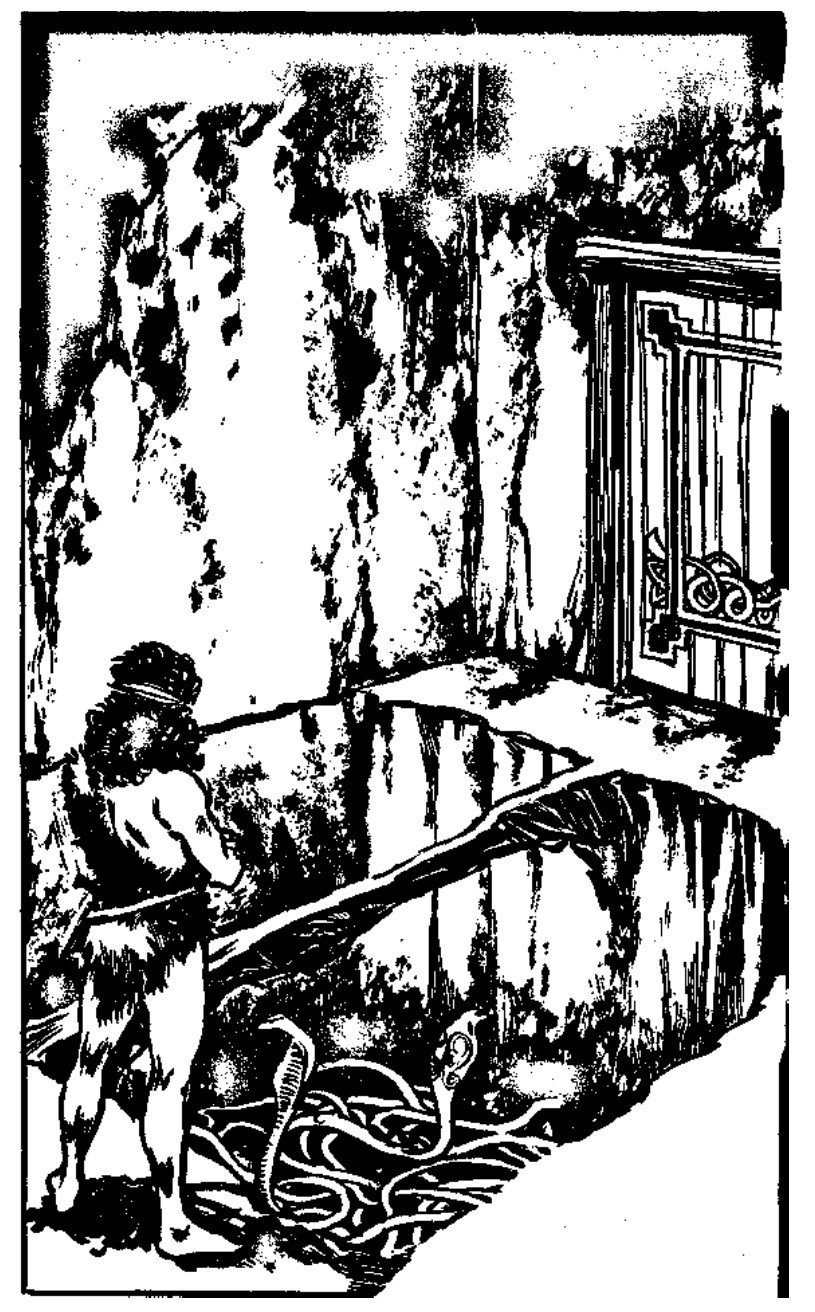
An interesting conundrum.
Beyond the pit, there is a wide chamber with sealed exits west, east and north, as well as three Mummies that are not too pleased at the PCs' intrusion. As each of the mummies falls, they will throw the two-handed sword each of them wields to the west portal, where it will bury itself to the hilt in the stone. This portal cannot be opened until all swords are taken out: it takes little strength to do it, but they carry a Curse (as per Elven Crystals) of Magical Attack 18. This is in place of the regular killer Doom Mummies have. This section is a circular passage surrounding the main tomb through the north portal. Starting west of the mummies room (i.e., through the cursed swords' portal) characters will find the funerary treasures of the pendragon buried in the barrow. There's a staggering 25,000 Florins' worth of plates, goblets, brooches and more: the whole hoard is 60 items' worth of encumbrance (remember, average characters can carry 10), but they can pick the most valuable items for one-third the total value and 10 items' worth of weight. Continuing, characters that for some reason take the time to excavate into the creatures' crawlways will find the Boggart's chamber (1000 Florins, 400 Crowns and three swords with bejewelled scabbards worth 20 Crowns each) and the Goblins' chamber (2000 copper pennies and a jewelled dagger worth 5 Crowns that the Goblins think the Boggart doesn't know about). The next three rooms hold the bodies of the pendragon's wives, servants and entertainers , to accompany him into the afterlife. Then, to a side, characters will find a dark pit , with a passage to a large room. The pit is small enough to easily jump... but there is a catch. A strange force pulls things down into the pit: it is weak enough that any character that knows of it can put extra strength into the jump to overcome it, but someone jumping willy nilly will have to roll under Reflexes in 1d20 or misjudge the jump and fall into the pit.
Unless the poor bastard was tied to a rope or something, so long and thanks for all the fish. The folklore was right: the pit leads straight to Hell.
 Go straight to hell, boys.
Go straight to hell, boys.
Beyond the Pit to Hell, there is a shrine to Lahmfada, the main god of the barrow people. One-eyed, too. Four carvings in each of the shrine's walls represent him in his aspects of hunter, chief, wise man and destroyer. Nothing else here.
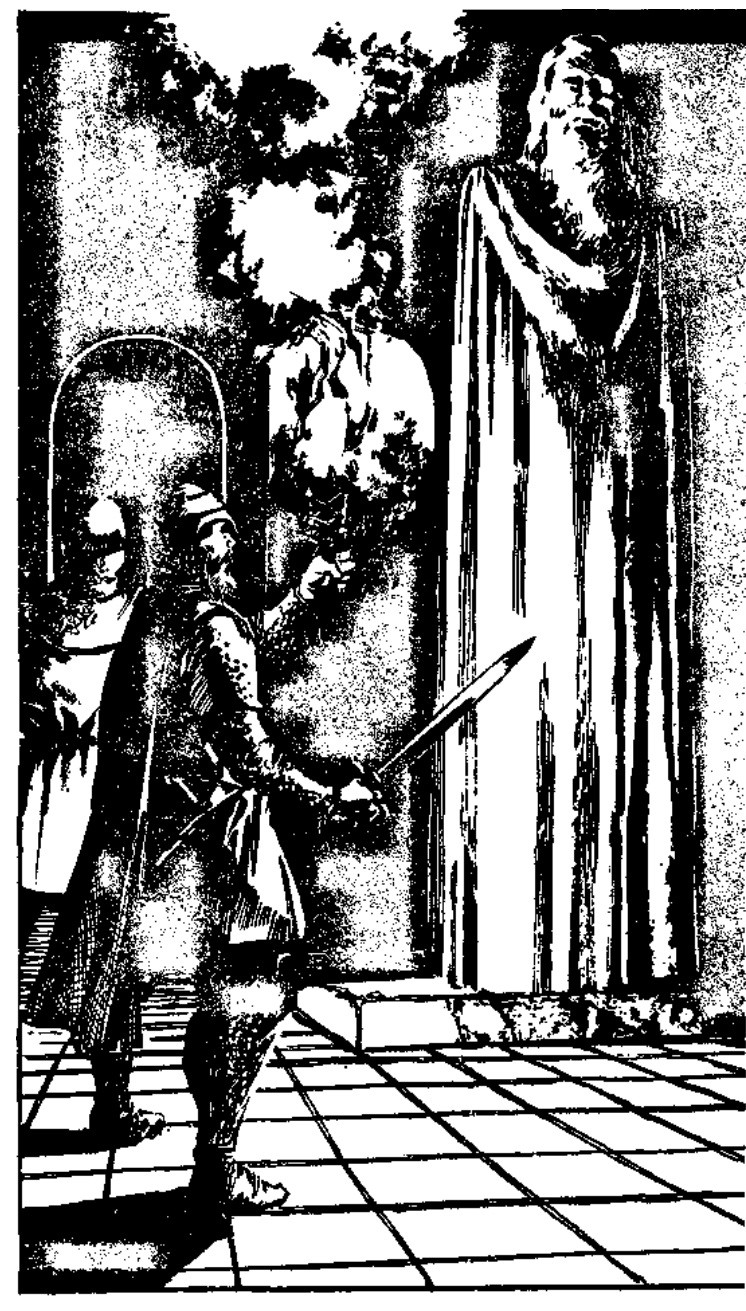
Amerasian Blues.
Finally, the room north of the mummies' chamber holds the main tomb . An embalmed armored figure stands on a dais, gilded sword held in front of him. There's about 15,000 Florins' worth of valuables in the room, and the sword itself is a +3 two-handed sword... but if anyone takes it, the pendragon's spirit will know. It will start clawing its way back into this plane of existence to exact retribution: all torches and lanterns will go out, magical light will only give a murky, blood-red glimmer, a low rumbling will come from the walls and a wind from nowhere will blow carrying the stench of death. The wind will die for a moment... and then the spirit of Ildyr the pendragon will arise from its corpse, wreathed in red flames. 1d12 fright attack for everyone, and the spirit will make a line for the character that took his sword. Ildyr is a 11th Rank spirit that can only be harmed by enchanted weapons, Phantasm, Vorpal Blade, Sword of Damocles, Battlemaster and Steel Claw. Furthermore, it unleashes a Death spell like wraiths once every 3 rounds with a Magical Attack of 3d10. If Ildyr's own sword is used against him, it will deal normal damage once (8 damage) then shatter in a thousand pieces before being used against its master once again. A character wielding the Amulet of the Underworld will find the amulet shining with white light that coruscates around their body, sparks dancing on their fingertips. They will be immune to the Death spell and will be able to hit Ildyr with any weapon, not just enchanted ones. Once Ildyr is banished, the Amulet disintegrates, but if the characters leave the barrow without fighting the pendragon, the Amulet will be good until their next encounter with a Spectre, Wraith, Eaves Phantom or Mordu.
Once back in the castle, characters will be expected to hand over the treasure they got to Aldred. The GM shouldn't have to remind them of this, being that this is Medieval Fantasy Europe and everyone is feudal as fuck. Aldred will bestow between 10% and 50% of the treasure back, magic items included, depending on the success of the mission. Bringing Ulfalder back alive is an extra 7 XP, coming back empty handed should net them just 3-4 XP, and bringing the dead body back should be somewhere in between. And that's it!
Next: all good things...
I See Save-or-Dies
Original SA post Dragon Warriors: Book 4I see save-or-dies
The next adventure, Sins of the Fathers , is remarkable in that it's the end of the PCs' adventures in the service of Baron Aldred. The PCs start on a hunting trip, taking care of his son Almeric (introduced in the previous adventure). Almeric is a brave young man, but too hotblooded for his own good, so the baron makes sure he takes trusted companions to spirit him out of trouble when he's out of the castle. His permanent minder is Sir Grisso , an old knight and long-time retainer of Aldred. As the adventure begins, the PCs had had little to do except vetting a crazed knight whose dispute Almeric accepted, and steering him clear of a pretty nun that took a liking to him
 . One rainy evening, the PCs are sitting at an inn, as Almeric and Grisso are out hunting wild boar (Almeric left them behind because seriously, Dad, he doesn't need nannies worrying about him all day) The food is meh, no one cares about the minstrel, but otherwise things are normal... until Almeric rushes into the inn, wet and miserable. He tells the PCs that they tracked their quarry into "the Bleaks," and though Grisso was of a mind to go back, Almeric wanted his kill. They found an ancient gate in the gloom, and as Grisso approached it to read the inscriptions on the stone posts, shadowy figures took hold of him and dragged him into the grave. Almeric hurled a spear at one of the creatures, that screamed horribly when hit - panicking Almeric's mount and, though it shames him to admit it, Almeric himself. The poor kid is not himself: he is uncharacteristically indecisive, even afraid. He is obsessed about the stain of cowardice in him for leaving Grisso behind, and he is also constantly muttering about the need to retrieve the spear, a magical weapon his eponymous grandfather gifted to him.
. One rainy evening, the PCs are sitting at an inn, as Almeric and Grisso are out hunting wild boar (Almeric left them behind because seriously, Dad, he doesn't need nannies worrying about him all day) The food is meh, no one cares about the minstrel, but otherwise things are normal... until Almeric rushes into the inn, wet and miserable. He tells the PCs that they tracked their quarry into "the Bleaks," and though Grisso was of a mind to go back, Almeric wanted his kill. They found an ancient gate in the gloom, and as Grisso approached it to read the inscriptions on the stone posts, shadowy figures took hold of him and dragged him into the grave. Almeric hurled a spear at one of the creatures, that screamed horribly when hit - panicking Almeric's mount and, though it shames him to admit it, Almeric himself. The poor kid is not himself: he is uncharacteristically indecisive, even afraid. He is obsessed about the stain of cowardice in him for leaving Grisso behind, and he is also constantly muttering about the need to retrieve the spear, a magical weapon his eponymous grandfather gifted to him.
As setting out at once is folly (it's dark, rainy, and Almeric is exhausted) the party waits until the morning. During the night, however, a hunting horn is heard, waking up everyone at the inn but Almeric, and the innkeeper's dogs go crazy barking and howling. If the door opens, they rush outside, barking wildly, only to slink back whimpering after a while.
By dawn, Almeric has recovered a little of his normal self, but not enough. As he leads the PCs back to where he lost Grisso, he tells them of a strange nightmare he had where he was hunting a stag with some strange hounds, but upon examination the quarry was not a stag, but a man with his own face. Oh, and though he has the stats of a 5th Rank Knight, the GM must fudge any and all rolls necessary to keep him alive until a critical point in the adventure.
Yeah, you can guess where this is going.
Eventually, they reach the gate, and they see Almeric's lost spear floating in the air, shining in the sunlight before drifting into the gate. The spear follows a path northwards through the underworld, pausing at the entrance of each room so that characters may follow it. But where? Right after the entrance, there is a trapdoor, with no chance at all of spotting it unless characters are specifically looking for it (and as the adventure notes, why should they?). Reflexes roll to avoid falling, otherwise the character falls 8 meters. Not everything is lost, however! The trap leads to a small room below, from which characters can climb back. There is also a corridor leading to a spiral stair (see below), with an Obsidiak lurking in the darkness and mist. The spear will stop at a large vaulted hall with exits in all four cardinal directions and hover over a murky pool at the center of it before leaving. It will evade any attempt by the characters to grab it, and Almeric will seem oddly reluctant to touch it. After half a minute or so, a pack of seven Rimwolves will set upon them: they are larger and stronger than normal wolves, and have the unique quality that at any given time, only one of the pack is vulnerable to damage - but if that wolf is hit, all wolves suffer the same damage. See Enchantment or Detect Aura spells can point out the vulnerable wolf, and the whole fight is worth 21 XP. About half of that should go to the Sorcerer or Mystic that figured out how to spot the weak link in the pack because caster supremacy.
 The wolves' bodies disappear when they're finally slain, leaving behind a green jewel: anyone approaching the pool while holding it will see their own reflection shine brightly, while those of their comrades become murky. Suddenly, the reflection will turn and appear to walk to the doors north of them before slamming them shut. The image returns to normal after it but Almeric, if he tries this, only gets a still black image and no reflection.
The wolves' bodies disappear when they're finally slain, leaving behind a green jewel: anyone approaching the pool while holding it will see their own reflection shine brightly, while those of their comrades become murky. Suddenly, the reflection will turn and appear to walk to the doors north of them before slamming them shut. The image returns to normal after it but Almeric, if he tries this, only gets a still black image and no reflection.

North of the doors, the spear stops over two chests on a corridor. They're not trapped, for a change, and they hold 900 old silver coins (worth half a Florin each when the tarnish has been cleaned off) and 900 copper pieces worth a Penny each. Further on, they will come across a set of spiral stairs leading down. Characters can reach the Obsidiak room from here, and going further below will take them to a small chamber with a silver wristband resting on a plinth. It will come in handy later. The spear will continue north, disturbing a Giant Spider on the ceiling. It will hide until characters pass by, and then drop its (stronger than usual) web on them. Dickass move but the characters should make quick work of it. Beyond this there is a musty room with embalmed warriors with stag heads in alcoves by the east/west walls. The spear will suddenly flash by and dart away, while the doors north and south of the room slam shut, trapping the characters inside. The warriors are indeed mummified undead, but they won't wake up all at once: two of them will stand to and attack the characters each time someone walks through the imaginary line connecting them. If characters play it smart, they need not fight more than two of the mummified warriors at once. They may also catch fire easily, and they don't have the Doom of a true mummy. Once all are dealt with the doors will open.
Ahead, the road splits at an east-west junction. The spear points east for a while before moving north. There is a thick carpeting of moss, leaves and twigs on the floor: this is in fact a Jack-in-the-Green , a completely asshole monster with 33 HP that engulfs characters one at the time, hitting them with 1d6 d8/3 brambles that never miss and only roll to hit for criticals, an unavoidable 1d4 supernatural damage and the loss of 1d12 XP. The poor bastard engulfed by the Jack-in-the-Green can only use daggers to fight back, but at least hitting with them is also automatic. The other characters can use edge weapons to help their comrade, but it's 50% chances of hitting either the Jack or the victim. After this pointless dickery, the east passage ends in a dead end: a single candle lits Grisso's body , pierced by arrows. His eyes have also been ripped off
 . Turning off the candle subjects the character who does so to an Elven Crystals Curse with Magical Attack 21.
. Turning off the candle subjects the character who does so to an Elven Crystals Curse with Magical Attack 21.
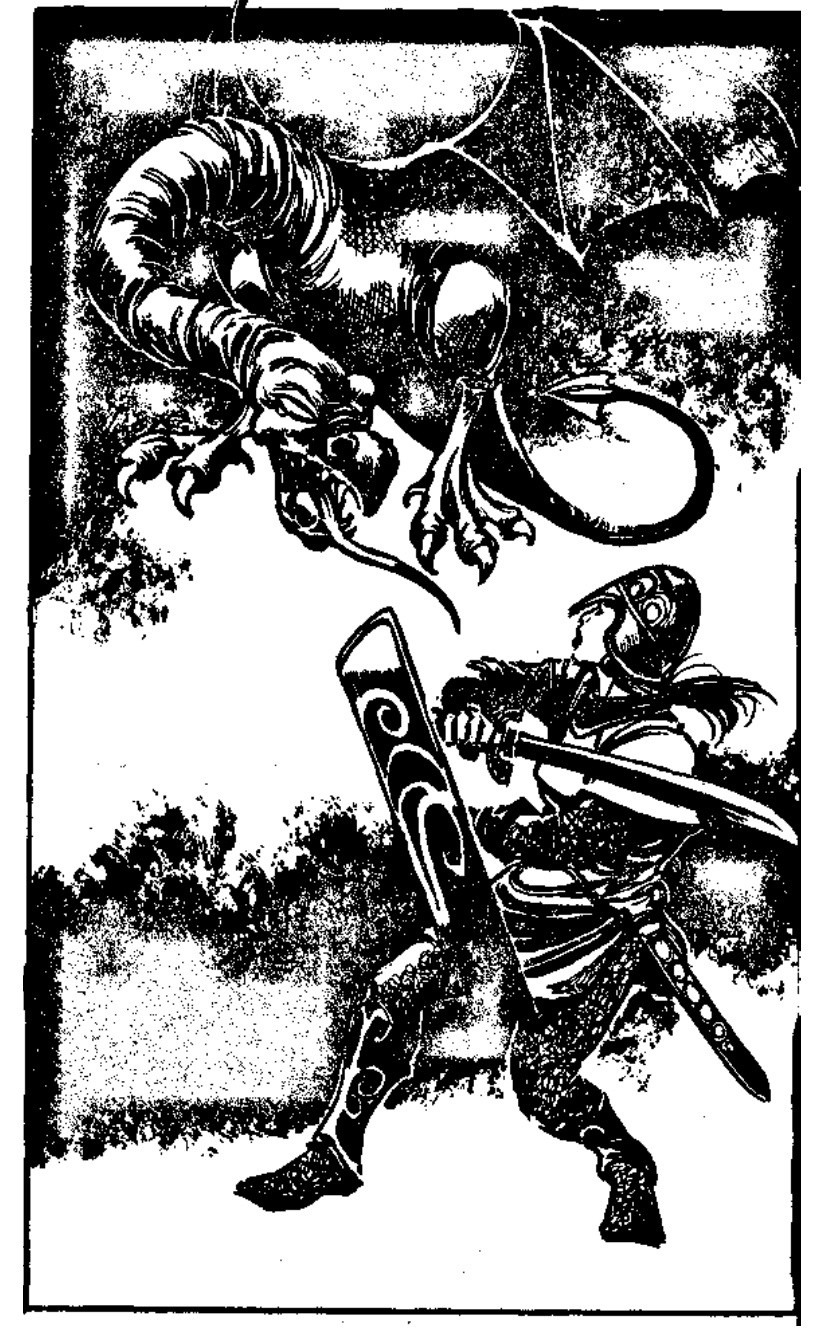
BRAAAAAAK
Had characters gone west at the pool room, they would've found a rusty set of armor against a wall after some steps down, containing nothing by a skeleton full of some blue mold. Guess what, it's strongly poisonous, and spores will fly out as the characters advance. Reflexes roll to avoid breathing the spores, with a -4 adjustment if they were holding their breath, and an automatic success if they cover their nose and mouth with a damp cloth. A 'trophy room' leads north to the spiral stair: dead people are here hung as hunting trophies, and the GM is advised to let the characters find random NPCs they have interacted with earlier here. West, the corridor leads to a small treasure room with 200 small silver coins (worth about 10 Crowns), a crystal spyglass and a gilded key. A corridor north opens into a gallery with three archways barred by black iron grilles. None are locked. The first passage has a silvery winged snake blocking the pass: it is poisonous (its venom is strong and causes the permanent loss of 1d3 Strength and 1 HP) and can spit its poison to blind characters. The interesting thing is that if the silver wristband found earlier is being worn, the snake will turn into another matching wristband: if both are worn at the same time, they will transmute the character's skin, leaving it scaly and silvery. Looks are reduced to 3, but AF is increased by two. The game notes that the world of Dragon Warriors is superstitious, though, so this character could end up on the business end of a crusader's spear before long. At least Dispel Magic cures it. When the second grille is opened, a skeleton on a throne sitting on the passageway will rise to attack! Only it's just a ruse, as a complicated set of pulleys and ropes pulls the skeleton up when the grille is open. No real danger here, only the chance of the characters firing off spells or arrows by mistake. Wonderful treasure can be spied through the third grille... but if observed through the spyglass, characters will see a Redcap, surrounded by carrion meat.
Lousy puns posted:
The illusion of treasure vanishes the moment the grille is opened, revealing the Redcap in all its 'gory'
The Redcap is waiting for characters to open the grille before attacking, but they can shoot it through it just fine
 Beyond the first two passageways, there is a
room of horror
: the butchered bodies of huntsmen are everywhere, hung on hooks or roasted in spits. A wolf walks from one spit to the next, occasionally turning one around with its jaws. The wolf will growl if approached, but won't attack unless the spits are disturbed. There is a door on the north wall, locked. Beyond it there is a dining room where the beastmen that hunt through these woods are gathered, waiting for the wolf to finish cooking their meal as they're too beastly to wait before it's done. If characters have the gilded key, they can open the door and gain surprise on the butchers. There are twelve of them (Rank 1 mooks), and if meat either from the wolf room or from the Redcap's 'treasure' is thrown at them they have to roll 5+ on 1d6 or drop whatever they're doing and start eating the meat. Exits here lead to the junction and to an antechamber where another key to the feasting hall may be found.
Beyond the first two passageways, there is a
room of horror
: the butchered bodies of huntsmen are everywhere, hung on hooks or roasted in spits. A wolf walks from one spit to the next, occasionally turning one around with its jaws. The wolf will growl if approached, but won't attack unless the spits are disturbed. There is a door on the north wall, locked. Beyond it there is a dining room where the beastmen that hunt through these woods are gathered, waiting for the wolf to finish cooking their meal as they're too beastly to wait before it's done. If characters have the gilded key, they can open the door and gain surprise on the butchers. There are twelve of them (Rank 1 mooks), and if meat either from the wolf room or from the Redcap's 'treasure' is thrown at them they have to roll 5+ on 1d6 or drop whatever they're doing and start eating the meat. Exits here lead to the junction and to an antechamber where another key to the feasting hall may be found.
The path north of the junction has a passage to the west leading to a mausoleum with a single large sarcophagus, its sculpted lid depicting a man with the head of a stag. 75 combined Strength points are necessary to lift it, revealing two +2 shortswords. They're cursed, of course: Magical Attack 21, and on effect the character's hands and feet become hoofs and their body becomes hairy, rendering them unable to use weapons until they get a Dispel Magic. The path north descends into an earthy bank , with a man-slug waiting for the characters at the bottom. It's so horrible that gains surprise just because of its appearance (a disfigured man's head in a slug's body), but it has 20% odds of retreating if fire is used against it and salt will send it packing.
Finally, the spear leads the characters into a large circular chamber , a grey sarcophagus at its center. A limp figure hangs in chains here, and the spear will suddenly impale it: of course, it's Almeric's body. The knight that has been with the characters all this time is his revenant, driven by his shame at abandoning his friend. Upon realizing this, 'Almeric' will howl and disappear. A powerful warrior will rise from the sarcophagus, with the head of a boar. This is Garambar , 'Boar King, Overseer of the Forest.' It will tell the characters that Almeric's death seals a long standing grudge of his against his family, as his grandfather killed Garambar's brother and stole his spear. He will command the characters to leave at once: the matter is settled and he has no quarrel against them. If characters choose to fight, he is a 13th Rank tank with a +2 axe and a hunting horn that works as Wolfcall but can also summon boars and stags. It takes 17 Strength and expending 1d3 HP to blow it for a normal character though! Aside from this, he has the +2 spear and a magic shield (that he will not use) that grants +1 to Defence and +2 to Magical Defence against Elven sorcery. Any surviving beastmen will show up in 3d4 rounds to defend their liege. Oh, and as lord of the beasts, anyone that had a hand in killing Garambar will forever be singled out as a target by wild creatures.
If characters survive all of this, there rests the matter of Baron Aldred. He will figure his son is dead before long and have his retainers search for the party. The best course of action here is for the PCs to take Almeric's body back to Aldred and tell the complete truth. The baron's court will scoff, but Aldred will know the tale to be true, and will absolve the characters of his son's death. However, it will become clear that they can no longer remain in the baron's service, and they will have to go.
Next: let's steal a castle.
Holy Hexen, Batman
Original SA post Dragon Warriors: Book 4Holy Hexen, Batman
The final adventure of this book, The Greatest Prize, is the first DW adventure that isn't a more or less straight crawl, dungeon or otherwise. While there is a dungeon, it is completely optional: in fact, the adventure tells GMs not to sweat it if the PCs never even learn of the dungeon, and simply slot it in somewhere in later adventures if they want to run it. The adventure assumes the PCs have just left Baron Aldred's service, and the baronial intrigues still affect the plot, if only tangentially.
As the characters take shelter in an inn in the southern reaches of Aldred's lands, close to his rival Baron Montombre, they meet three knights: Grafven, Ector and Vermal. They are three veteran knights recently returned from the Crusades, and they quickly start talking about local folkore, battle stories and such. The conversation is swiftly turned by Grafven, their leader, to a matter of importance to them and hopefully the PCs. Days ago, the three of them and a fourth companion were riding close to the inn when they spied a castle set on an island, linked to the mainland only by a narrow strand of land. (I still think that makes it not an island, but that's how DW rolls.) They called out at the gates and requested shelter, and the portcullis was raised. At the courtyard, they met an old man wielding a jeweled scepter. Myrkyn led them to rooms he had prepared for visitors, and before long summoned them to dinner. A feast was prepared for them, but the fourth companion, Baldon, shrunk back: he had a talisman that protected against sorcerous mirages, and when waving it over the food it was revealed to be carrion and dross. Myrkyn screamed in rage and kissed his scepter as his (undead) servants threw themselves over the knights, and poor Baldon ate a scepterful of lightning bolt to the face. The knights fought their way out of the castle and fled, with the sorcerer taunting them about their dead companion soon becoming his servant. The knights want payback, and since Myrkyn is known to invite travelers in for later sacrifice, they want the PCs to act as a diversion, as the knights and their henchmen strike from the sea. They promise the PCs twice the portion of the loot the knights will get, as they will be in the greatest danger.
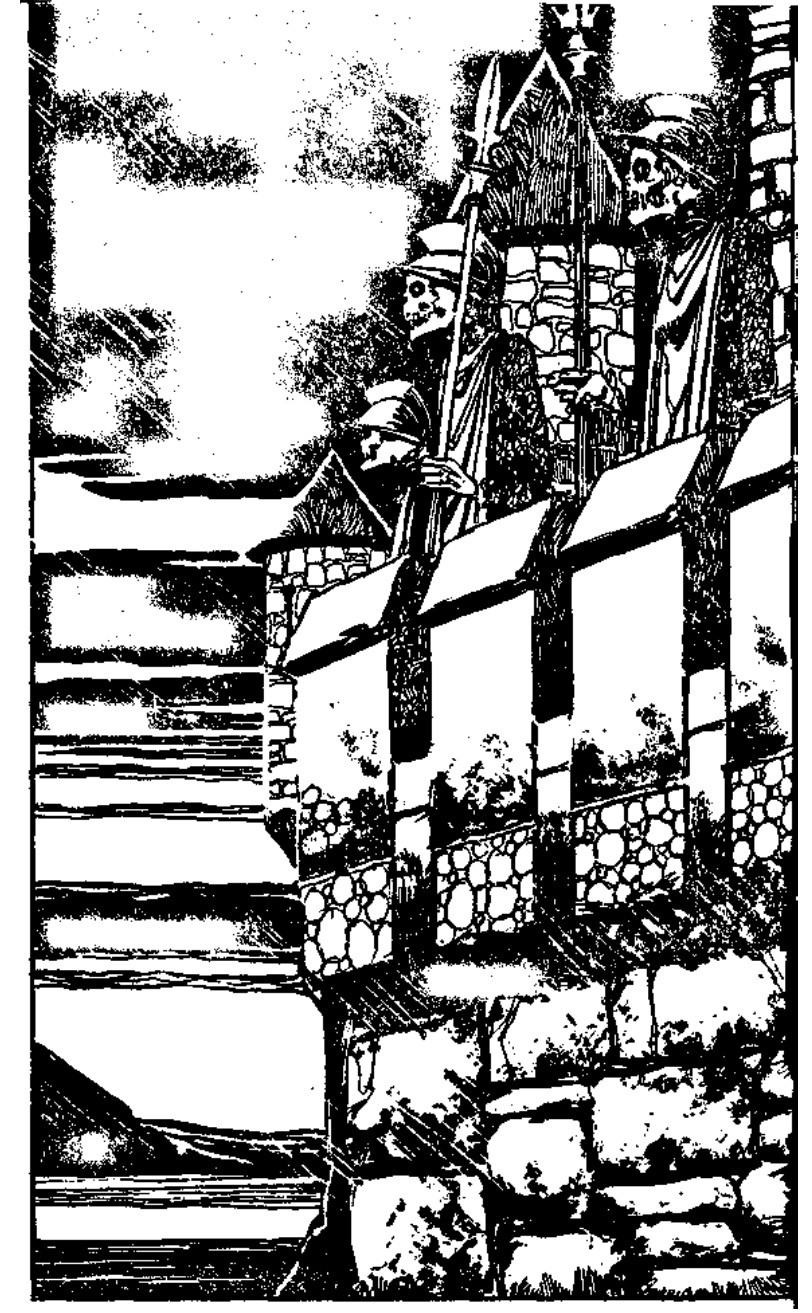
2spooky by design.
But! Not all is as the knights say. For one, they're making Myrkyn seem less dangerous than he is: they say he needs to kiss his scepter to work his magic, but this is not the case. There are more undead servants than the seven they describe. And, for another, Grafven and Myrkyn are no strangers to each other. The castle was originally home to a minor noble called Althor , of which Grafven was one of his greatest knights and Myrkyn his adviser. Grafven was a pious man, so he took to the Crusades ten years ago, and when he returned he learned from locals that Althor had not been seen for seven years. Myrkyn was the master of the castle now, and everyone assumed he had murdered his liege. Grafven and his men collected intelligence around the zone and learned that Baron Aldred had once laid siege to the castle, but failed to secure it. A well-positioned castle is very valuable, so Grafven planned to take the castle, ally himself with Baron Montombre, pull a couple of easy raids and then enjoy the rewards. In fact, he wanted to bring Myrkyn into the plan too, but the sorcerer wanted nothing to do with politicking and refused to let the knights back. It was his castle now. The knights attempted to kill him, but he blasted Baldon dead and they had to flee.
As for the sorcerer, he did indeed kill Althor, but in self defense. The scepter he holds (that, incidentally, quadruples his MP reserves) was hidden in the castle wall, behind a rock loosened by lightning after a storm. It led him to the underworld beneath the castle, and there he learned to use its power. Althor and his men noticed how Myrkyn's power had grown, and began to resent him. Fear turned to hate, hate turned to murder attempts, murder attempts turned to Myrkyn caster supremacing his way through Althor and his retainers until no knight was left living in the castle. Myrkyn was no saint, but he had never killed anyone until that night.
And our PCs are thrust into this clusterfuck just as it's about to blow up. How nice!
After the knights leave the PCs near the castle (Grafven will give them a sour look if someone comments on how well-positioned the castle is; he won't share his prize), they will ride into the castle, where they will meet Myrkyn and a hulking armored knight that always remains at his side. Myrkyn will receive them cordially if a little cold, as Grafven's visit remains in his mind. The armored knight is a Doppleganger copy of Althor, and Myrkyn is fond of jokingly referring to him as "my lord." A long description of the castle follows, but it's not that important except for some details. There are twenty-one Skeletons at his command, wearing decaying ring armor and with red gems in their eyes, set there by Myrkyn for the sole purpose of making them spookier. An extra three skeletons are not counted in this number as they're walled up in the gatehouse and their sole purpose is to raise and lower the drawbridge and portcullis. The castle is kind of empty, but still well equipped, as the sorceror genuinely enjoys visits and conversation. He even maintains the small chapel just as Althor did: although he worships older gods, he respects the faith of travelers. The castle also has a "War Room" with eight Astral Gates (seven of which lead to strategic points in and around the castle, one of which leads right over a chasm
 ) and a metal plate that works as Myrkyn's speculum for Scrying. In a creepy aside, he also has the perfectly preserved body of Jamana, Althor's wife, locked in a sarcophagus in the dungeons. He tried to made her immortal after taking over, but only succeeded in turning her into a zombie. He couldn't bear to destroy her.
) and a metal plate that works as Myrkyn's speculum for Scrying. In a creepy aside, he also has the perfectly preserved body of Jamana, Althor's wife, locked in a sarcophagus in the dungeons. He tried to made her immortal after taking over, but only succeeded in turning her into a zombie. He couldn't bear to destroy her.
Then we get a sequence of events, assuming characters do nothing: Myrkyn will receive them in and invite them for drinks in his great hall before having the skeletons show them to their rooms. He will command the skeletons to warn him if the PCs leave them. He will then go to his tower for an hour or so, and then return for dinner. As the skeletons summon the characters to the hall, Grafven's men advance on the castle, six riders over land and seven others along with the knights using boats and a Water Elemental by sea. Myrkyn meets the riders at the gate, sensing something is wrong, while Grafven uses a Dust of Transformation and flies up the castle walls. He is spotted by two skeletons that quickly fall before him, and he throws ropes for his men to climb. The riders suddenly attack Myrkyn and the doppleganger. Unless characters intervene, Grafven will slay Myrkyn and take over the castle, losing six men in the process. He and his men take 1d8 HP damage. After this, he will try to get rid of the PCs as soon as possible, one way or another: they are no longer useful.
So how will this play out? If they assist Myrkyn against Grafven, which as far as the adventure is concerned is the "right thing" to do, they get the friendship of a 10th Rank Sorcerer, which means spells and magic items on request, and shelter too. If the characters go with the knights' plan and kill Myrkyn, they must act swiftly to to also remove the knights from play if they want to keep the castle. If they side with Myrkyn but the sorcerer dies anyway (unlikely, the book tells us), they must either flee the scene quickly or get rid of the knights. And in these last two scenarios, the scepter comes into play - and the dungeon.
Myrkyn's scepter is currently attuned to work only for him. If he dies, it begins to pulse with a grey light. If touched by a Mystic or Sorcerer, nothing happens, but if touched by an Assassin, Knight or Barbarian the "scepter" alters to become their favorite weapon. Magic detection will reveal it to be powerfully enchanted, even though it confers no powers on the wielder. If a character lifts the scepter and concentrates on it, they will get a mental image of a room in the castle dungeons, and there the scepter will lead the characters to one of the flagstones. The flagstone lifts up to reveal a large glowing crystal: touching it teleports all characters within 10 meters to...
...the dungeon! Or rather, its upper level. The dungeon is shaped in the form of a pentacle, with one central room and five others at each of the points. The rooms have alchemical symbols in their doors: a Sorcerer of 6th Rank will recognize them automatically, while one of 3rd-5th Rank has (rank*15%) chances of recognizing them. The first room, the Chamber of Night , has the alchemical symbol of Darkness and is an empty, dark room. So dark that no light, natural, magic or otherwise, can pierce its darkness. There is nothing here other than a black stone amulet in an alcove opposite the door. The second room, the Chamber of Ice , has the alchemical symbol of Water and a smaller one meant to represent an ice crystal. The room is freezing cold, and a small casket of grey metal can be seen inside a huge slab of ice. The ice regenerates, so trying to icepick the slab will not work. The casket holds a sparkling green jewel amulet and a key made of ice, that will not melt as long as it is kept in the casket (which works as a freezer of sorts). The next room is the Chamber of Conflagration. Fire symbol, in case you were wondering. It is, of course, a hellhole, with a path of cinders the only safe-ish route to a gateway of red-hot iron sealing an alcove with another talisman, a red spinel. The gateway cannot be opened by spells or anything, and neither can the talisman be taken by Telekinesis or such other trickery. Oh, and there's also a fucking Ifrit here. 10th Rank, characters trying to melee him suffer heat damage, flame attacks up the wazoo, etc. The following room is the Chamber of Stone , with the symbol for Earth. It's irregularly shaped, like a cave, and it holds a tall pillar, carved to resemble a man, and behind it a large chest with a key next to it. The pillar is in fact a Telamon, a stone guardian that will activate only when a character steps into the room, but will then try to destroy the party until they or it go down. The walls of the room are also made of magnetic lodestone, and a character in metal armor will suffer -1 to Attack, Defence and Armour Bypass as the magnetism ruins their balance. The chest holds a large pestle and mortar, and yet another amulet, a cube of chalcedony. The key opens it, of course, but the magnetism prevents anyone of less than supernatural Strength (19) to lift it. The final room, the Chamber of the Unseen , has the symbol for Air and shimmers with blue light. Oh, and there's an invisible monster, too. It's called an Anaxagor, and it can be briefly seen (one Round) if hit by an indirect attack spell. It's not as tough as the other monsters, but it is invisible and thus characters fight it at -4 to Attack and -8 to Defence. Upon death, it will become a visible, shapeless mass of clay, and a small box inside of it contains another elemental talisman, a cabochon moonstone.
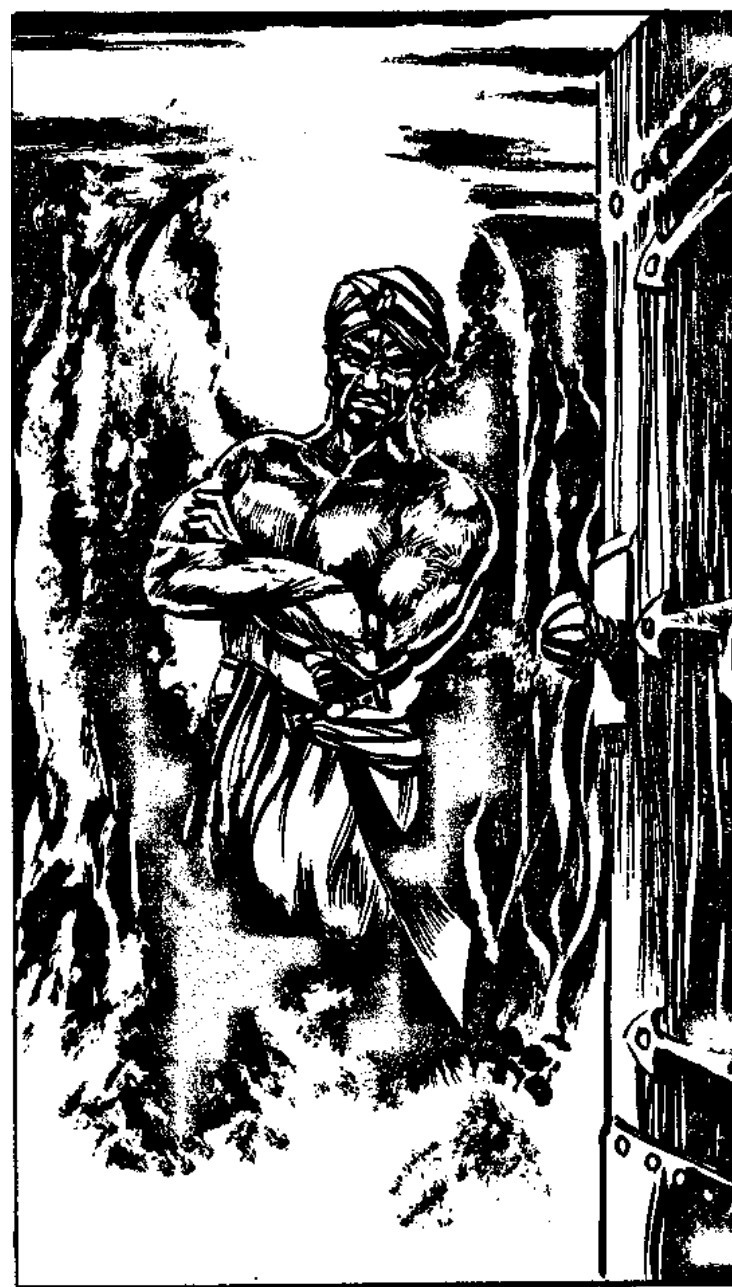
Sup.
So how to solve this? Well, the Anaxagor can be lured into the Chamber of Night, where it will fight at the same disadvantages as the PCs. The ice of the Chamber of Ice can be either melted by luring the Ifrit in, or killing the Telamon, grind it into powder with the mortar and pestle, and then scattering the resulting salt over the ice. The magnetism in the Chamber of Stone can be defeated by luring the Ifrit in too and goading it into using its AoE flame attack, as heat destroys magnetism. However, only a Sorcerer of 3rd Rank or better would know this, and if no such character is present the characters cannot deliberately use this trick because mah verisimilitude. As for the Chamber of Conflagration, the deal is that the ice key from the Chamber of Ice opens the gate, but it would never survive the heat. So, what characters are supposed to do is kill the Anaxagor, take its clay, use it to make a mold of the ice key, then make a duplicate key with the molten lead present in the Chamber of Conflagration and open the padlock. Easy peasy.
The central room has a pit with a column of grey light emanating from it, and the character bearing the scepter feels that is the way to go. Stepping into the light gently takes characters down... through five elemental barriers. The barriers cause a number of damaging effects on the characters that touch them without the appropriate talisman, which can be resumed to "character dies or is nearly killed." Oh, and each time one talisman protects against the barrier, it teleports back to its original position, because.

If characters do all of this somehow and go down the barriers together, they reach the lower level of the dungeon. The light elevator drops them on a dais in a pentagon-shaped room with exits in all five walls. The dais has three sets of stairs down to the floor, and is actually the roof to a portico with a large, flickering gemstone inside. It's not a good idea to approach it, though, as being under the portico drains 1 HP per round and approaching within 2m of the gemstone flings the offender back with a crack of lightning, causing 2d6-AF damage. As for the rooms, each of them has a chime over the archway leading to it, which cannot be physically moved or made to sound. The rooms are matches to the ones in the upper level, but they represent the five Professions here: Darkness for the Assassin, Water for the Sorcerer, Fire for the Barbarian, Earth for the Knight and Air for the Mystic. Not that the characters need to know the exact symbolism or anything, this is all "mentioned only as special background information for the GM." If you say so, DW!
The first room is The Eyes of Ineluctable Scrutiny.
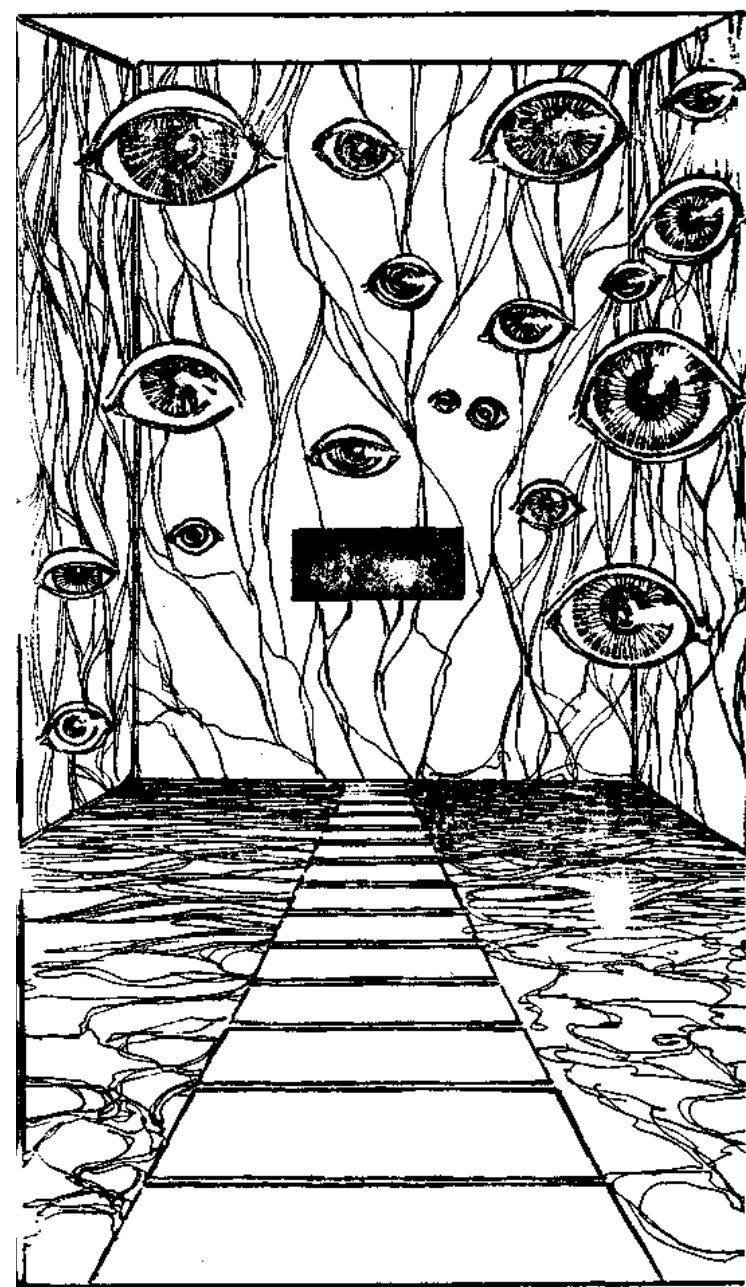
Fuuuuuuuuuuck this shit.
The room is made of green marble and the archway is covered by a green drape. It has a plaque of black stone at the far end, and it's full of disembodied eyes everywhere. They cannot be struck out of the air with weapons, and while they could be shot down with arrows, there's so many that the characters will run out of ammo before making any progress. A character stepping into the room becomes the object of attention of more and more of the eyes as they pass by: they suffer a fright attack of rising intensity with each step, starting at 1d4 and increasing in an extra d4 per step. The fright attack is not fatal, but forces the character to run back to the entrance. Six strides clear the room and at the end the largest of the eyes shoots 2d4 green beams with Speed 18 that deal 1d20 damage, no armor protection. This will happen any time the character tries to touch the plaque, but the trick here is that the eyes cannot see in the green part of the visible spectrum, so a character wrapped in the drape from the archway can step through the eyes and touch the plaque safely. Once they do, the chime at the entrance of the room rings.
The next room is The Challenge of the Unreal. It looks empty, but as characters enter the room mist seeps from the walls and takes the form of a repulsive monster, constantly shifting its shape to even more horrifying forms. It has an Attack of 27, Defence of 12, AF 5, 38 HP, a d10/6 attack, causes an 1d12 fright attack every round... if you believe in it. It is not real, in fact. The characters' own minds make it real, as well as the damage it inflicts, but figuring out the monster is an illusion grants characters an Intelligence roll to disbelieve, recovering half the HP lost to the creature in the process. The encounter can be bypassed by covering one's eyes and ears: it cannot hurt a character that doesn't know when the attacks are supposed to come. There is a similar plaque to the previous room here, making the corresponding chime ring upon touch.
The following room is The Gantlet of Skulls. The moment one of the characters enters this foggy room, a bronze grille falls behind them, separating the character from the party. Two lines of stakes make a way across the room, a skull on top of each. As the character walks between two of the stakes, they become warriors in blue paint and attack. The character must walk through the stakes and fight all the warriors to succeed, but they can do so two at the time. If the character tries to run the gauntlet, step outside the stakes path or if the party uses spells or projectiles through the grille, all eight warriors attack at once. They're 1st Rank mooks. Again, there is a plaque that makes the room's chime ring.
The next room is The Swords of Swift Execution. It looks like an armory, with many shields and swords lining the walls, and banners of forgotten knights. Once a character enters the room, the swords begin to sparkle with blue light and rise into the air to block their path. If the character persists, 1d6 of the swords attack with Attack 17. They're skilled, but have little strength, so they deal d10/2 damage. The character may make their way slowly through the room, parrying up to three of the swords per round, or they may take one of the shields from the walls, which grant +12 to Defence against these swords only. The swords suffer no damage from attacks, but the character may try snatching one of the air with a successful hit roll against Defence 10 and a Reflexes roll. Using one of the swords against the others causes them to fall when hit, and when seven of them are knocked out all go down. The weapons can be taken off the room for later use, but they count as normal swords and shields.
The final room is The Key That Lies Within. It is made of sky-blue stone and, though serene, it's completely empty. Characters that enter the room hear a voice in their heads, asking: "How can a thing be in plain sight and yet impossible to find?" A white radiance envelops one of the characters, preferentially a Mystic but the character with the best Psychic Talent will do in a pinch. This character may escape now, but if they stay they begin "soul combat" against the spirit of the room. Soul combat works just as regular combat, but the HP analogue is calculated with Intelligence+Rank+Psychic Talent. Attacks are made by rolling under Psychic in 1d20, dealing 1d6 in "soul" damage. The spirit has 25 spiritual HP and a Psychic Talent of 14. The combat cannot be broken off willingly by the character (though the rest of the party may cart the character off to end it, causing a psychic backlash that reduces the character's Psychic Talent and Intelligence by 2 for 1d6 days) Losing the soul combat means the loss of 3d6 XP, while winning it makes the relevant plaque appear right in front of the character, with the voice saying wise-sounding stuff. If the winner of the fight is a Mystic, they also get +10 to their Adepthood rolls.
When all five chimes sound, the characters may now approach the portico and touch the crystal, teleporting back to the castle. Whoever is holding the scepter at the moment the last one rings becomes attuned to it. In the hands of a Sorcerer, it quadruples their MP like Myrkyn; a Mystic subtracts 4 from Psychic Fatigue checks; both may wield it as a d6+1/5 enchanted weapon, but Knights and Barbarians see it turn into a 2d8/8 weapon that also grants +10 to Attack and Defence and +2 to AF; Assassins can use it as a +3 magic weapon that grants +8 to Stealth and Perception and makes them perfectly invisible from 1st Rank characters. The only reason this doesn't break the game over its knee is that the scepter draws its power from the rock the castle is built upon, and loses it at more than a mile away from the castle. If still alive and asked about it, Myrkyn speculates that it is a relic of the Sithi Danu, a race of high elves worshiped as gods by the local tribes. They were fond of mystical challenges, "objets d'art magique," and strange, intricate puzzles. But for what reason, he doesn't know.
But I guess we all know: elves are dicks.
Next: Book 5, The Power Of Darkness!
Medieval Fantasy Captain Planet
Original SA postPurpleXVI posted:
I rather like this adventure, even if it's somewhat short and even if the dungeon is just a tad "lol fuck you, hope you like logic that sounds like it's from a Sierra adventure game." The only thing that kind of bugs me is, "how the hell are the PC's supposed to figure out reasonably that Myrkyn isn't the huge cock that Grafven paints him as"? It kind of seems like the only clue towards it is "Grafven is a bit abrasive and Myrkyn makes good dinner company and is only mildly paranoid."
Also, are there any further adventures that build on whatever relationship the PC's might end up having with Myrkyn or Grafven or if they take over the castle after killing both? Or is it just "'sup you've got a sorcerer buddy and/or a sweet pad now"?
There are some hours between the PCs' arrival at the castle and Grafven's raid, so I take it the GM is meant to show that Myrkyn isn't the baby-eating monster the knights paint him as during that period, probably by telling his side of the story if pressed and the PCs don't go aggro on him instantly. And this adventure line stops here, as now we go to...
Dragon Warriors: Book 5
Medieval Fantasy Captain Planet
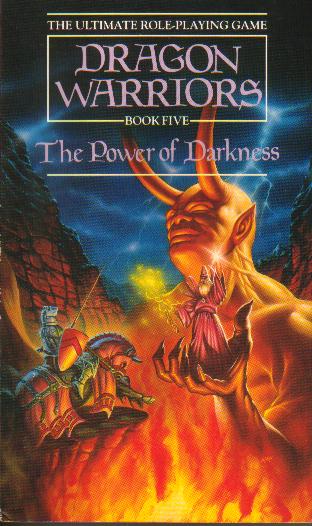
Horsie doesn't want any of this shit.
The Power of Darkness is the fifth book in the line, penned by Oliver Johnson (of The Elven motherfucking Crystals fame). This book introduces a new Profession, some extra rules, and a lengthy campaign. Oh, what wonders we will see!

The new Profession is the Elementalist. Description? None! To become one, a character must have at least 9 in Intelligence and Psychic Talent, like Sorcerers, and in fact they share some rules like the advancement scheme, putting extra MP in spells to punch through magic barriers, Spell Expiry rolls, and terminating durational spells prematurely to recoup MP. Elementalists must choose one of the five elements ( Fire, Air, Water, Earth and Darkness ) as their main element, and two others that do not oppose their main element as subsidiaries. So, for instance, a Fire Elementalist can also cast Earth and Air spells. Darkness is not opposed by any element but cannot be taken as a subsidiary, only as a main element. Elementalists have three different MP pools for each of their elements: at 1st Rank, they get 3 MP for their main element and 1 for each of the subsidiaries, adding +3 to the main category and +1 to the subsidiaries per Rank. Elemental MP can only pay for the relevant element's spells, of course. Furthermore, MP does not recover naturally, but by performing a Ritual of Recovery at the appropriate time per element (Fire/sunrise, Air/noon, Water/moonrise, Earth/moonset, Darkness/sunset). The Ritual restores the MP of the relevant category only, can be performed once every 24 hours and it cannot be performed until all the MP for that element have been expended. Their basic stats are 1d6+4 HP, Attack 11, Defence 5, Magical Attack 15, Magical Defence 5, Evasion 3, Stealth and Perception who the fuck knows because the book doesn't say.

To cast spells, Elementalists also need to carry an article of basic equipment relevant to the element they want to use. This is specifically not part of the starting gear and must be bought or obtained in-game, and not having it means the element's spells are cast at twice the MP cost. Earth and Fire Elementalists get off easy, needing only a vine root staff and a piece of volcanic rock respectively that cost 5 Florins each, but Water Elementalists need a crystal phial of pure spring water costing 1 Crown and Air Elementalists need an Aeolian harp costing 10 fucking Crowns what the hell. Darkness Elementalists need a special artifact that cannot be obtained in the market, only from another Darkness Elementalist, and can only be constructed at the Lost City of Nim by an Elementalist of 8th+ Rank. Incidentally, guess where we're going in the book's campaign! To further reinforce the message that Darkness Elementalists are not good people, they cast spells of other elements in a twisted version, usually more powerful, and the Darkness spells proper carry geases , penalties "for their perverted ways."
On with the spells, then! 1 spell per Rank per Element. I am assuming that Elementalists may only cast spells that are equal or less than their Rank, because it doesn't come out and say it. 50 spells in total, 10 per Element.
Earth
-
1.- Abundance
: cast on a soft patch of ground upon which the staff is thrust, it makes any fruit of the caster's choice spring next to it at the rate of 1 fruit per round, Spell Expiry roll applies.
Darkness
: the fruits are even more delicious than the original, but they carry medium poison.
-
2.- Spider Magic
: a concealing spell that makes well-worn paths look as if disused, cobwebs spring out of nowhere to make it look as if an archway has not been used for a long time, etc. 10 meter radius.
Darkness
: the effect expands at the rate of 1 meter per Round, until a Spell Expiry roll fizzles it. Plant growth and spider webs created by it are acidic and causes the loss of 1 HP or 1 permanent AF damage to armor.
-
3.- Forest Murmurs
: the caster may communicate with wayside plants for ten minutes. Plants have only a memory of 24 hours and have no sight, but can describe the number of people that have passed by, pieces of conversation, etc. 10% chance of the information being false.
Darkness
: makes it so that if another Elementalist casts the normal version of the spell in the area, they only get false rumors.
-
4.- Create Bog
: Speed 12 spell that turns the ground to a viscous sludge, trapping opponents. Strength roll to break free. Spell Expiry roll.
Darkness
: the bog keeps pulling the character in until swallowed completely, never to be seen again, unless they break free or get help.
-
5.-
Roots
: causes roots to spring and trap opponents' ankles. The exact number will depend on the terrain: a forest may yield up to 10 roots, a desert gets you nothing. Roots are Speed 16, and immobilize when they hit; if 4 hit a single character, they are considered to be pinned down and helpless. They have 4 HP each for hacking purposes.
Darkness
: the roots also deal d6/4 damage to their victims.
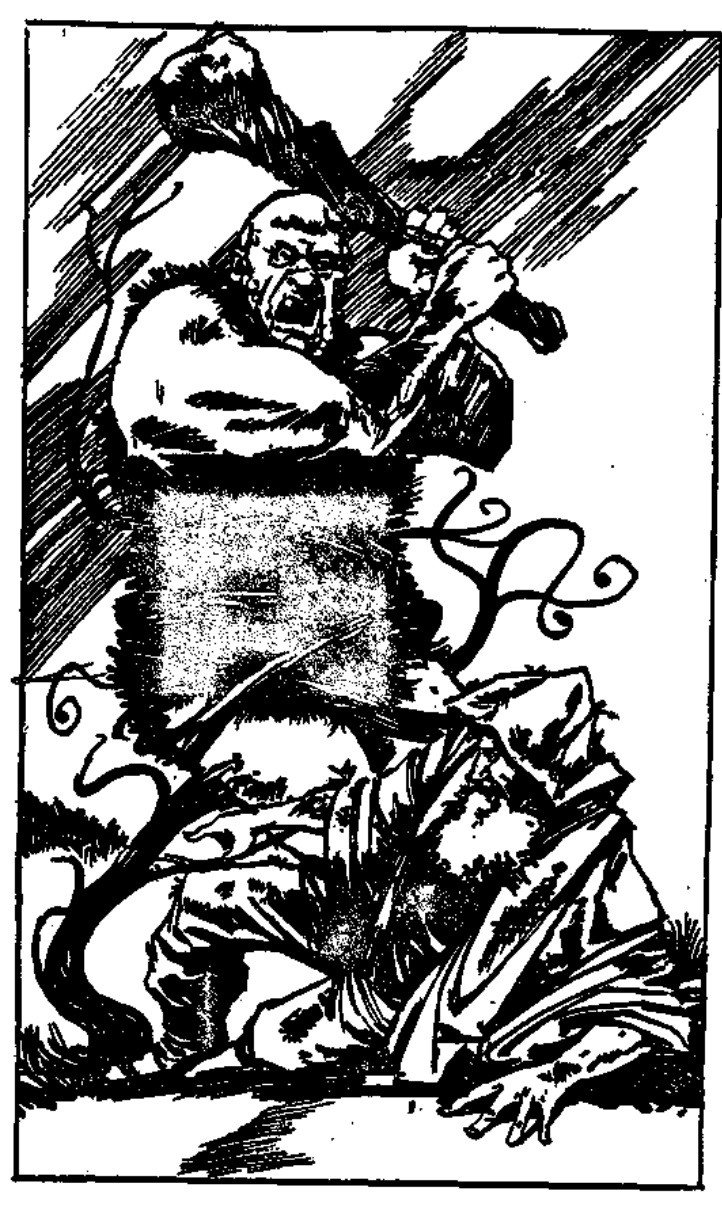
Quick, turn its torso into an old TV!
-
6.- Rock Wall
: the Elementalist may cast this spell on any rock they could lift by themselves and make it grow up to 10 times its size. They keep their shape until a Spell Expiry roll gets through.
Darkness
: the transformation is permanent.
-
7.- Fissure
: a 3 meters wide, 5 meters long, 5 meters deep fissure opens in front of the caster. Speed 18 to avoid, 1d6 damage if this fails. Reflexes roll to jump over, and the effect is permanent.
Darkness
: the pit is full of churning "teeth" of rock, making fall into the pit instantly fatal. However, the teeth disappear with a Spell Expiry roll (the pit remains, though)
-
8.- Give Up The Dead
: man, it's like I'm playing Ultima 8! The caster calls up the remnants of all those interred within 10 meters. They are basic skeletons for humans, animals get half the Attack, Defence and Magical Defence of a living member of their species. Chances and number of raised dead depend on the terrain: it's easier to cast this spell on a graveyard than in random open ground. Spell Expiry roll applies.
Darkness
: the necromancy is permanent.
-
9.- Tremor
: earthquakes, ho! Spell Expiry roll applies: while the spell is active, the tremor grows in intensity with each round, starting with a slight shaking and ending in total destruction of the 10-meter area in which the spell is cast 6 rounds later, if it manages to last that long.
Darkness
: there is no Spell Expiry roll, so total destruction is assured.
-
10.- Summon the Man of Stone
: cast on a rocky area with lots of free-standing stone, the caster summons a titanic warrior to serve them until a Spell Expiry roll gets through. It has Attack 30, Defence 24, Magical Defence 17, 24 HP, an AF of 6 and d8+2/8 fists. Once free from the caster's control, it will travel in one direction straight, breaking through walls and everything, until it disappears in exactly one hour.
Darkness
: this Man of Stone is a sadist man-eater, delighting in grinding men's bones with its stony jaws. It could decimate a settlement in a matter of minutes. Other than that, it's the same spell.
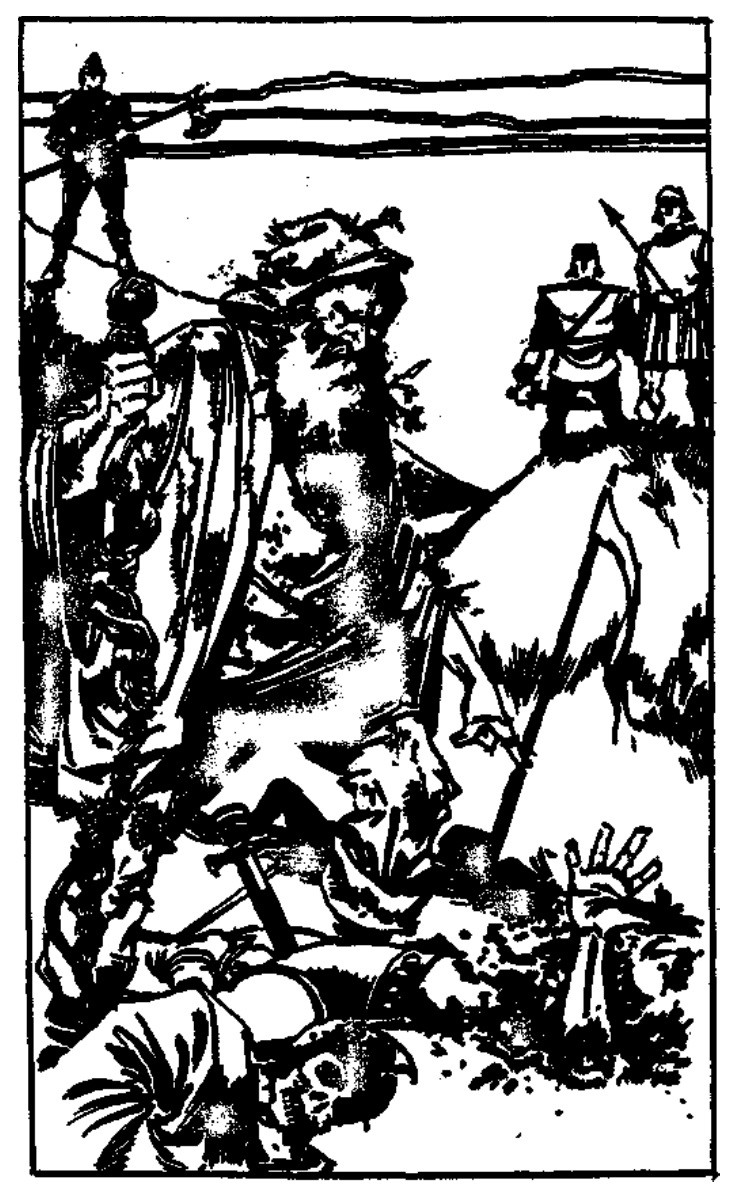
"Sir, we wanted to talk to you about complaints made by your neighbors about---" "YOU'LL NEVER CATCH ME ALIVE! RISE, O PUTREFACTOUS SERVANTS" "...nevermind."
Air
-
1.- Create Light Breeze
: the caster may affect the strength and course of air, allowing them to listen on to whispered conversations, snuff out candles or lanterns, and so on.
Darkness
: if reversed, the breeze carries false rumors and conspiratorial whispering to a person of the caster's choice.
-
2.- Stargaze
: this oddly named spell reduces the effects of hardship in the caster's mind, allowing them to stay conscious even after their HP is reduced to 0 (they still die at -3, mind you) and letting them hold their breath underwater for twice the normal time, endure twice the heat or cold as any normal man, etc. Spell lasts for one day.
Darkness
: the spell negates all kinds of adversity, not taking wounds for damage, fire, lack of air. The flipside is that food acts as a poison and they become intangible, not being able to even open a door. At the end of the day, they must save against a Magical Attack of 1d6+10 or find their bodies vanishing into vapor until they become a thin wraith of ethereal smoke.
-
3.- False Rumours
: the caster creates aural illusions to confound the enemy.
Darkness
: the sound they create is always a demonic moan with a fright attack of 14 that if failed drives the listener mad. Also, did I mention the new rules are Madness rolls?

-
4.- Windwall
: the caster may cast this spell around them or directly in front or behind of them to block a corridor. It's 1 meter thick and stretches for 10 meters, and anyone stepping into it takes 1d8 damage from the typhoon per Round until they break through (roll under Strength in 2d20). Spell Expiry roll applies.
Darkness
: the wall advances at the rate of 1 meter per Round, useful to trap enemies in corridors and such.
-
5.- Summon the Host of the Air
: the caster summons flying creatures to do their bidding. The exact creatures to be summoned depend on the terrain and GM's fancy, but there's a small d6 table that gets you anything from a couple of bugs to a flight of birds of prey that can easily lift the caster.
Darkness
: the caster always summons a swarm of insects and a flight of birds of prey.
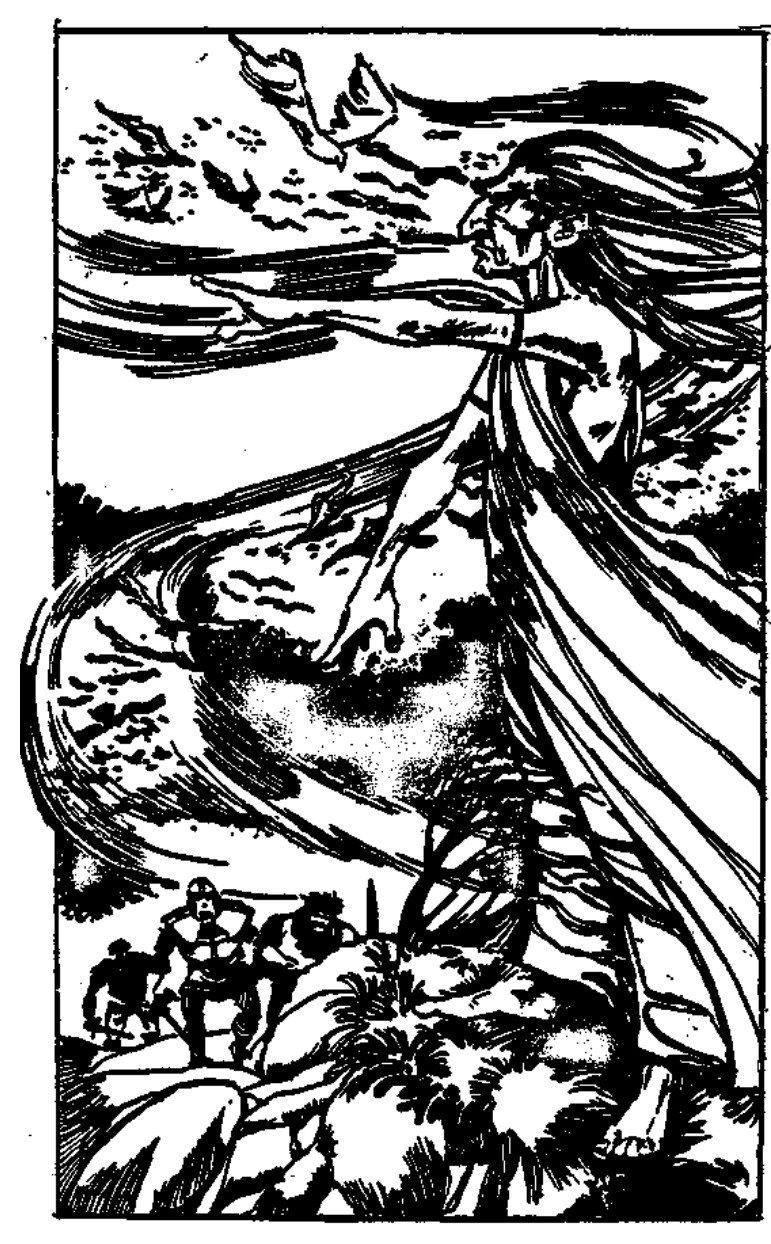
"Guys, let's make sure Bob's toga doesn't flip up like last time. Do you remember last time? I still see it in my nightmares."
-
6.- Intangibility
: the caster becomes intangible, big whoop. Spell Expiry roll, and if the spell ends while the caster is still inside solid ground they die a messy death. Touching enchanted metal deals 1d6 damage but other than that the caster cannot deal or be dealt damage in combat.
Darkness
: the caster may use this spell offensively on an enemy, rendering them useless in combat. Magical Attack vs. Magical Defence roll.
-
7.- Garrote
: apology accepted, Captain Needa. Speed 19 spell that causes a band of air to constrict on the target's throat. 3 damage per round until they break free (Strength roll in 3d20) or they die.
Darkness
: if the victim doesn't evade, the air implodes around their head, rendering them deaf and dealing 1d20 damage.
-
8.- Flight
: up up and away~. It lasts for one hour, and the caster may move through the air at twice their normal movement rate. They may carry anything up to their normal encumbrance.
Darkness
: the spell may be cast on others (Magical Attack vs. Magical Defence) but the caster may only control their flight while they're still in sight. The controlled person can never control their flight, so they're left at the mercies of the Darkness Elementalist.
-
9.- Spin
: the spell, uh, makes the target spin. They have a chance to resist their effects, which I assume is their Magical Defence roll. Spell Expiry roll applies, but the spin is so fast they take 1d2 damage per Round until they eventually fly apart limb by limb.
Darkness
: the victim now also bores into the ground, taking 1d6 damage per Round.
-
10.- Banshee
: the Elementalist summons a violent vortex of wind, deafening anyone in a 10 meter radius apart from the caster. The Banshee may be directed to attack one opponent, and if successful in catching them it will implode, instantly killing the victim. It has an Attack of 17, a Defence of 12, a Magical Defence of 16, an Evasion of 8, and 18 HP with immunity to non-magical weapons.
Darkness
: the Banshee will run amok, feeding on the screams of its victims. It will only disappear when it has claimed 100 victims

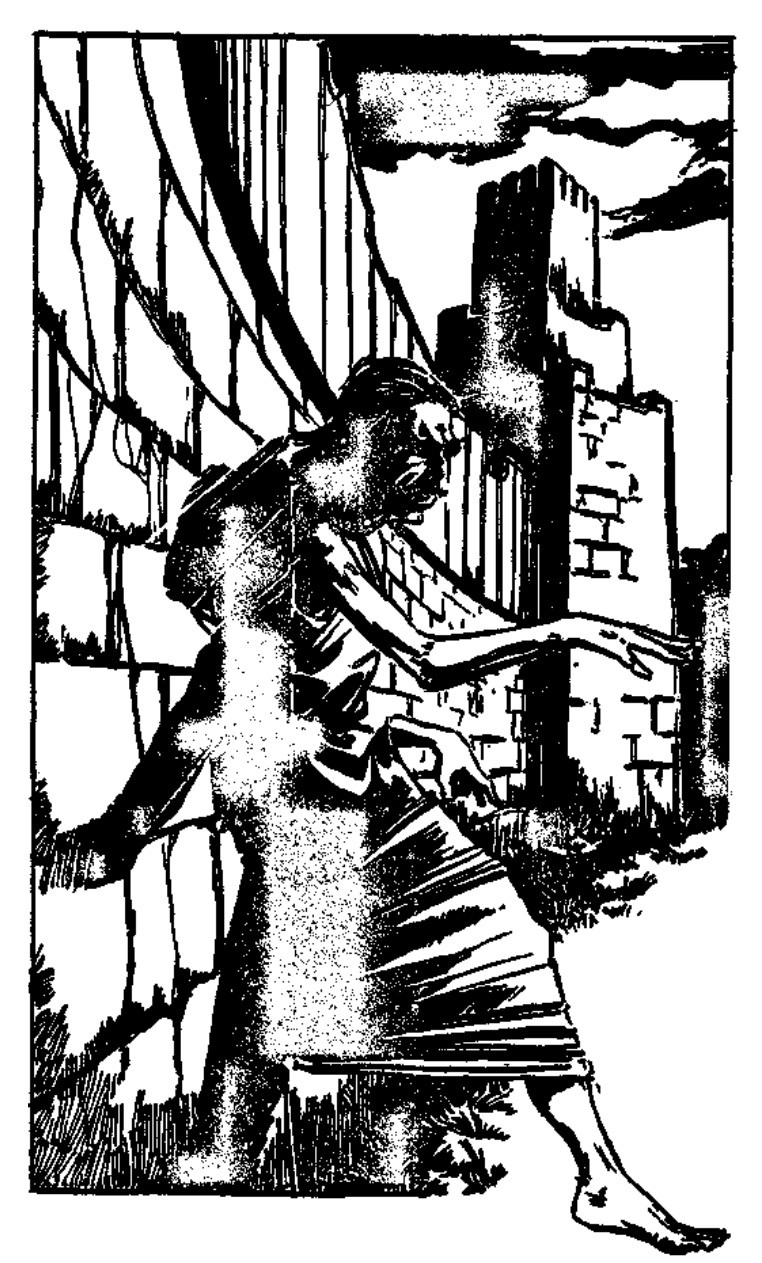
Defying the laws of physics all day erryday
Next: Water, Fire, and Darkness.
By your powers combined
Original SA post Dragon Warriors: Book 5By your powers combined
Now for the rest of the spells.
Water
-
1.- Rain
: light rainfall in an area of 5 m. radius, lasts for five minutes. It's normal rainwater.
Darkness
: the water is slightly acidic. It's not immediately noticeable, but treat as mild poison if drunk, and will corrode armor and other objects if exposed to it for a long time.
-
2.- Wave Mastery
: unfortunately no, this doesn't make your Elementalist a radical d00d. It allows the caster to control the movement and direction of waves, propelling ships in any direction of their choosing or becalming waters in a 10m. radius around himself.
Darkness
: the Elementalist can now propel other ships away and summon a 6m. tall tidal wave offensively, this will swamp any small craft and cause the loss of 1d6 Ship Points in larger vessels. What are Ship Points, you ask? Wait for Book Six!
-
3.- Icewall
: the caster summons a wall of ice around their person, in front of them, or around an opponent. Speed 10 if used offensively. It will take one man hour to break through the ice with a suitable weapon, and it will melt in six hours in temperate climates.
Darkness:
the ice does not melt and it will take a full day to break through the barrier.
-
4.- Walk on Water
: self-explanatory. Caster only, Spell Expiry roll applies.
Darkness
: no Spell Expiry roll, spell lasts exactly one hour.
-
5.- Ice Spear
: summons a magical throwing spear. The caster's Attack is always 20 with it, and it deals d10/8 damage. It dissolves on impact.
Darkness
: the spear carries a Paralysis effect, as per the Sorcerer spell.
-
6.- Breathe under Water
: Guybrush Threepwood.
Darkness
: the Elementalist can cast an offensive reversed version, causing the target to become unable to breathe normal air and need water before suffocation. Same duration as the original (10 minutes) and it needs a Magical Attack vs. Magical Defence roll.
-
7.- Blizzard
: the Elementalist summons a thick blanket of ice, 20 meters across. There's a 5 m. sphere of clear air at the center of the effect. The blizzard halves movement rates and reduces visibility to extreme darkness, but the Elementalist may always see through it. The caster may use it in personal defense or offensively, blinding enemy parties up to 20 meters away.
Darkness
: the ice is razor sharp, dealing 2 damage per Round to naked flesh or stripping away 1 Armour Factor point per Round.
-
8.- Freeze
: a Speed 16 effect that covers the target in ice and renders them immobile in ten Rounds. Victims must also roll under their current HP in 1d20 or they will die of shock.
Darkness
: Speed is now 20.
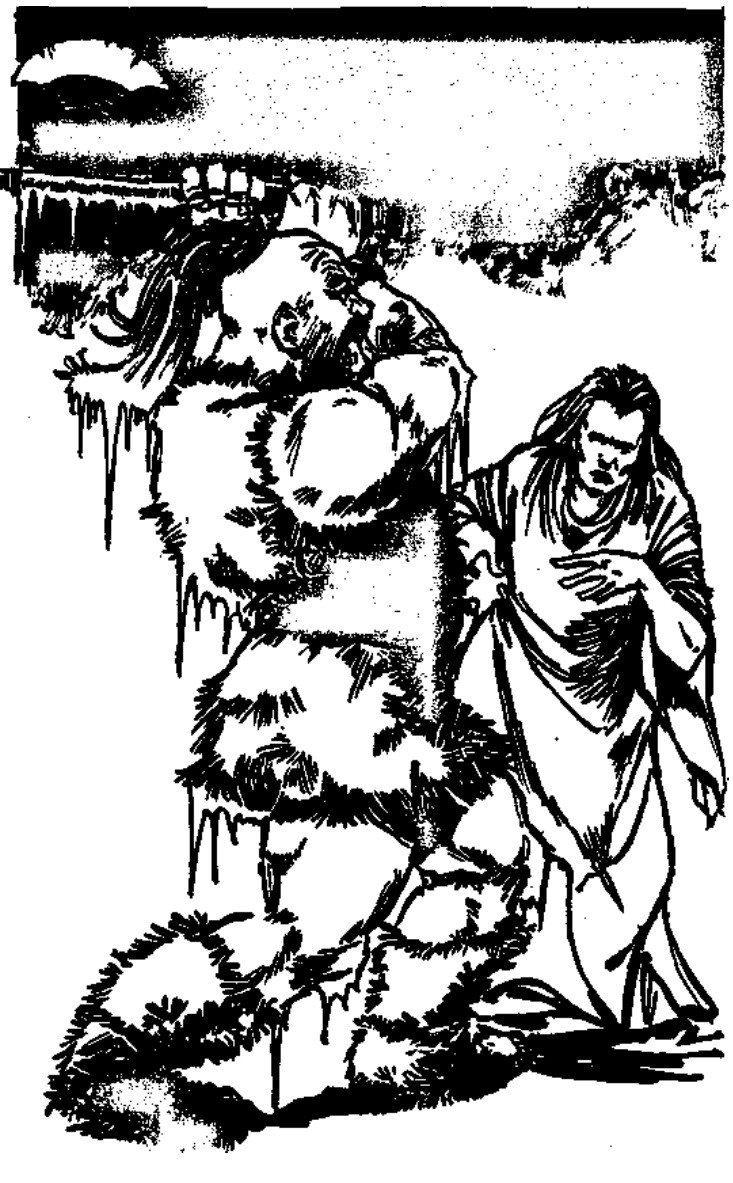
Ice burn. Literally.
-
9.- Lightning
: yes, a Water spell. During a storm, the caster holds up a copper rod and casts this spell. This will attract a lightning bolt to the rod, charging it up. The rod now has three charges for firing bolts at opponents (Speed 20, 12 damage and roll under current HP in 1d20 or die of shock), animating corpses (touch rod to corpse and it becomes a Zombie for a day) and creating force fields (20 m. radius around the caster, anyone entering the field loses 3 HP per Round, effect ends when the caster moves).
Darkness
: five charges-
-
10.- Summon Tidal Wave
: what it says on the tin. 10 meters tall, deals 2d10 Ship Points damage, penetrates about half a mile inland. Ranked characters may survive inundation by rolling equal to or less than their Rank in 1d12, but still they take 1d6 damage. Each casting costs the Elementalist 1d4 HP permanently.
Darkness
: dark powers propel the wave forward at a speed of 20 mph. Dissipates on a Spell Expiry roll.
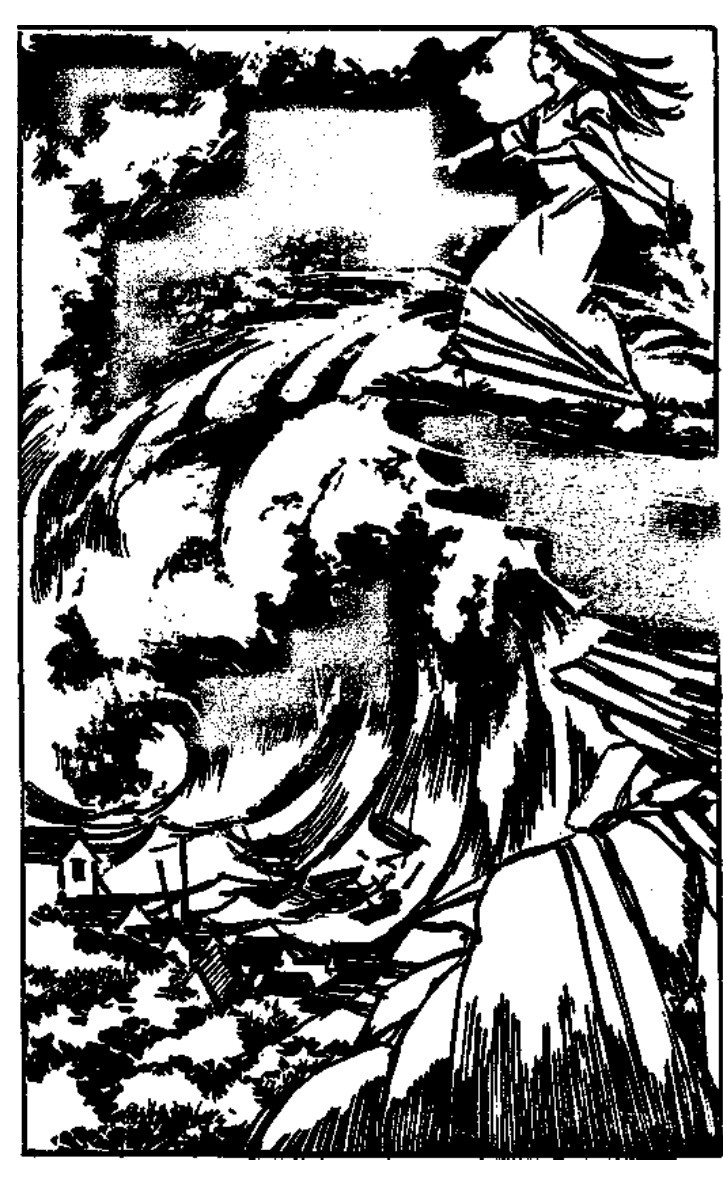
Admit it, you thought that was her face too.
Fire
-
1.- Candle
: magical candle that does not go out in water. Its light is only visible to the caster. Lasts one hour.
Darkness
: the caster generates a zone of magical darkness around their person, blurring their shape. +3 to Evasion and Defence.
-
2.- Pyrotechnics
: the caster may create any kind of illusion involving light and fire. 5% chance of disbelieving, Spell Expiry roll applies.
Darkness
: the caster may create monstrous illusions, which I guess are extra spooky? Same chances of disbelief.
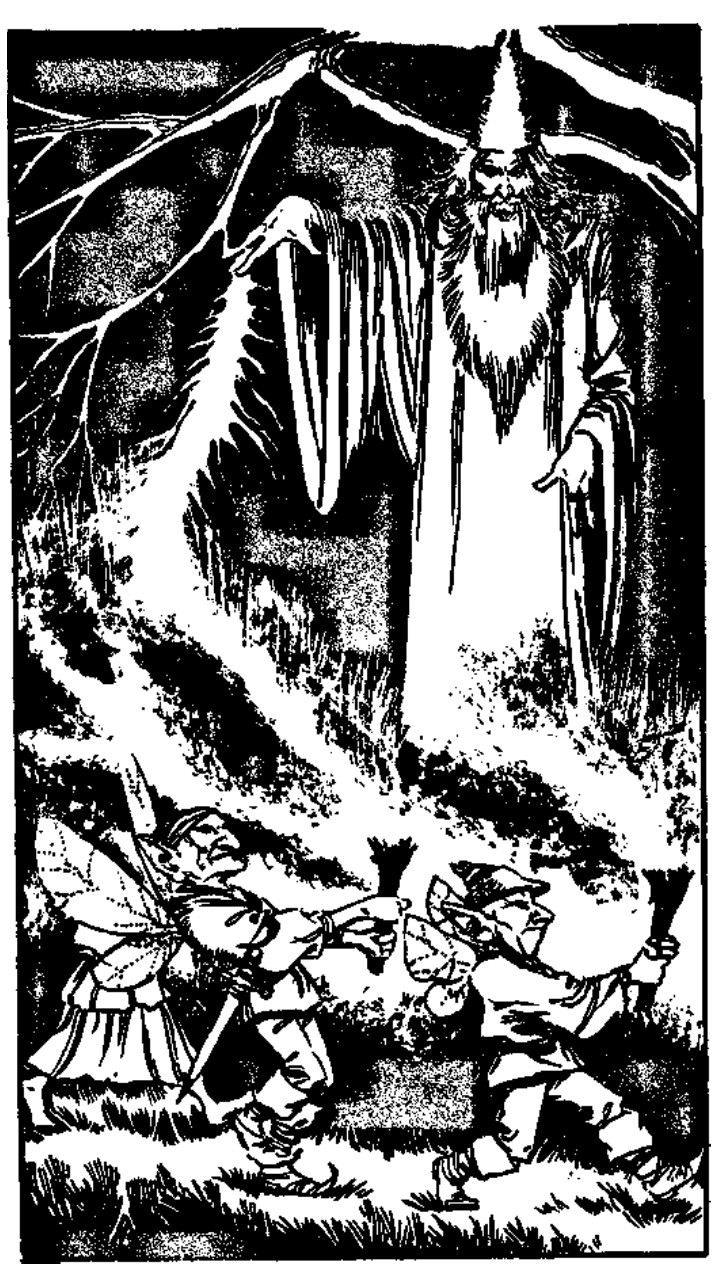
You can now use your mana to power SWEET RAVE PARTIES
-
3.- Fire Arrow
: a literal one, the caster needs a bow to shoot it. Attack 20, d10/10 damage.
Darkness
: the arrow is made of
darkness of mah soullll
but is otherwise the same.
-
4.- Sheet of Flame
: wall of fire! Spell Expiry roll applies, same casting modes as Icewall. It deals 8 damage to anyone trying to cross it, but if cast around the Elementalist they will pass out in six rounds as the fire consumes all the oxygen. Speed 14 to avoid if it's used offensively.
Darkness
: the firewall can now move forward at the rate of 1 meter per Round.
-
5.- Protection from Fire
: caster becomes immune to all fire damage. Duration? Who knows, the book won't say.
Darkness
: any fire-based offensive spell bounces back at the enemy caster with their own Magical Attack. BUT IT WOULD BE SPEED BASED MOST OF THE TIME OLIVER JOHNSON YOU DINGBAT
-
6.- Extinguish
: caster may douse all light in an one-mile radius, while still being able to see as if it were broad daylight. It can also put down fires.
Darkness
: the spell is also accompanied by a dank, dismal rain.
-
7.- Flash
: blinding flash of light, visible at a distance of ten miles during the day and fifty during the night. Reflexes roll or be blinded for 2d10 Rounds (-4 Attack, -8 Defence).
Darkness
: blindness is permanent until cured by a Dispel Magic.
-
8.- Fire Weapon
: magical fire heats up a weapon, granting +2 to damage and Armour Bypass rolls.
Darkness
: the heat is so fierce no armor can protect against it: all AF is considered to be zero. Wait, even magical armor? Daaaang.
-
9.- Conflagration
: the caster can start up fires up to a mile away just by looking at the place where they wish the fire to start, or by picturing a location they've been to in the last week. The fire has the strength of a roaring bonfire.
Darkness
: if cast on a building, all doors and windows mysteriously jam or lock, preventing escape

-
10.- Summon the Holocaust
: make your own Nazi joke, I'm tired. The Holocaust is a fire titan with Attack 32, Defence 26, Magical Defence 19, Evasion 8, 28 HP and hits with d10+2/10 fists of fire. The caster needs the bones of people that have died by flame to cast this spell. The Holocaust disappears under one hour.
Darkness
: instead of disappearing after one hour, the Holocaust is released from the caster's control, wreaking havoc as it pleases. It vanishes after one day.
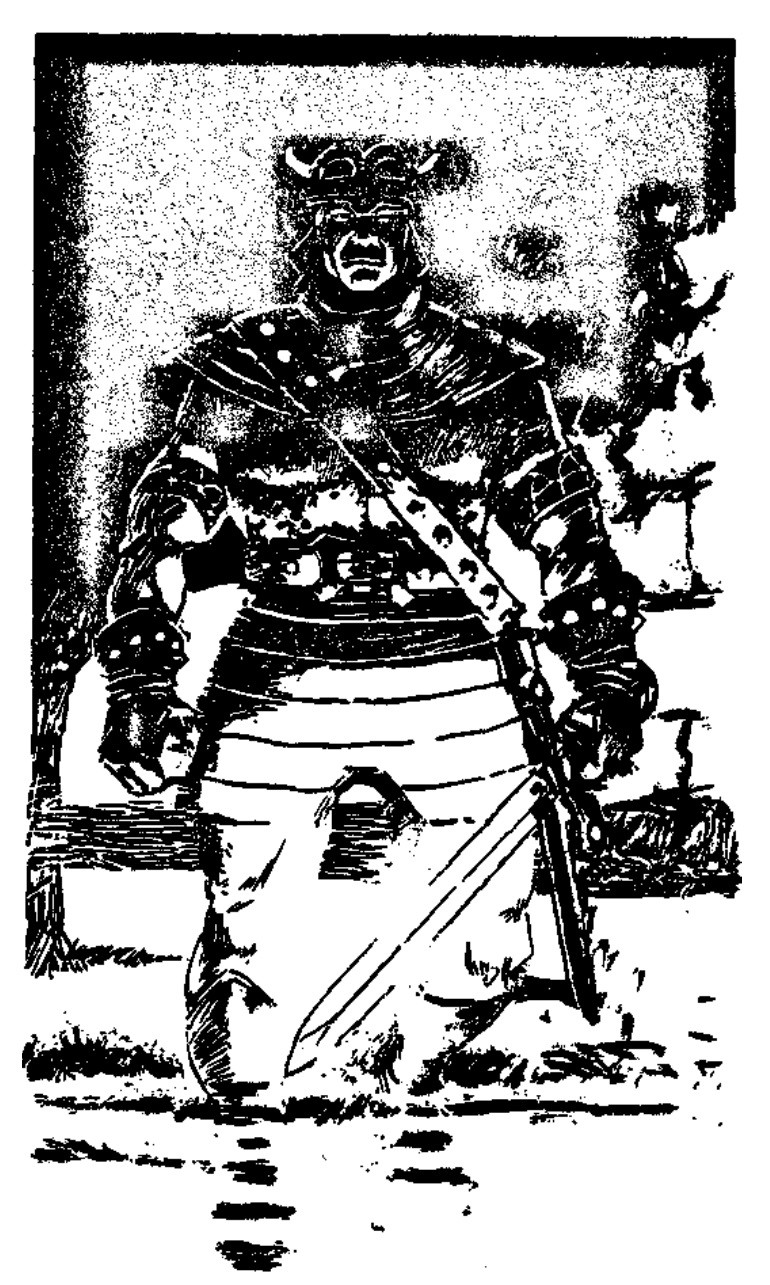
No, seriously, make your own joke in poor taste.
Darkness
As mentioned before, Darkness spells have geases , penalties for using them.
-
1.- Catspaw
: caster moves with absolute silence over all surfaces. +1 Stealth for every two Ranks. They also lose their shadow. Lasts ten minutes.
Geas
: after ten uses, the shadow loss becomes permanent.
-
2.- Darkeyes
: caster may see perfectly well in pitch darkness. Lasts for one hour.
Geas
: if a sudden light is produced in front of an Elementalist under this spell, they're blinded for 1d20 Rounds.
-
3.- Benight
: caster summons a zone of darkness 10 meters across, which may then be directed towards their opponents. Speed 20, anyone in the area fights as if blind and must resist a Magical Attack of 15 or become prey to nameless dread. Roll on the Madness table!
Geas
: if no one succumbs to the madness, the spell is reflected back on the caster with double the Magical Attack.
-
4.- Curtain of Night
: caster summons a barrier of darkness in front of them. They may see and cast spells through it, but no one can see back and no hostile magic may reach them. In fact, any fire or light-based spell cast through the barrier is reflected back at the caster.
Geas
: if the caster passes through the Curtain more than three times, they must resist a Magical Attack equivalent to their own or become permanently intangible. But why would they do that?
-
5.- Javelin of Darkness
: summons, well, that. If thrown at an opponent, they must roll Magical Attack vs. Magical Defence or become blind. Duration? Who knows. The javelin may only affect one opponent, but it has a 10 meter radius of effect.
Geas
: after three successful uses, a black, star-shaped patch appears on the caster's hand.
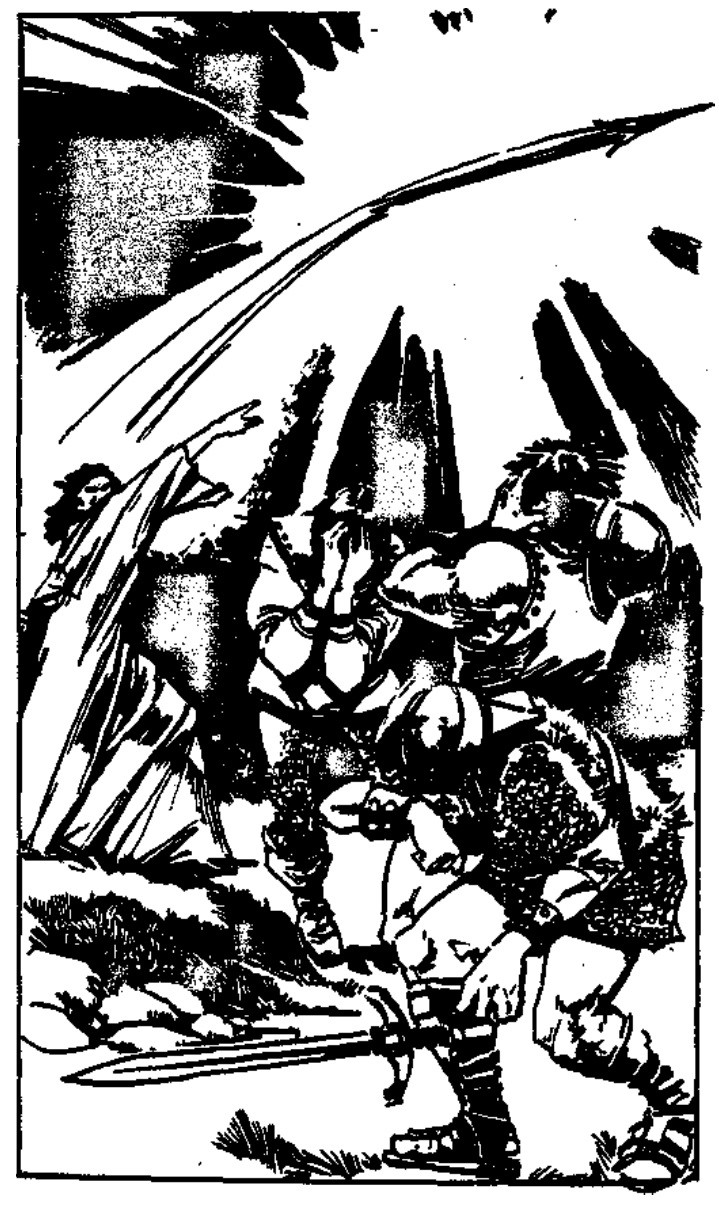
MY EYES ARE BLINDED BY YOUR FLYING PHALLIC SYMBOL
-
6.- Shadowfall
: an one-mile radius area is covered by premature twilight during the day, or utter darkness during the night. Anyone in the area is hit by an attack of Phobia (see Madness) that makes them flee the epicenter of the spell for 2d6 hours.
Geas
: after three successful uses, the Elementalist becomes subject to random bouts of sunlight phobia.
-
7.- Summon the Creatures of the Night
: summons phantasm versions of Bats, Giant Spiders, Ghosts, Hags, Wraiths or Specters (d6 roll to see which). The phantasms affect opponents as their normal versions until disbelieved.
Geas
: every time this spell is used the caster must save against a Magical Attack of 2d8+1 or become an insubstantial wraith.
-
8.- Eclipse of the Moon
: temporary eclipse of the moon, lasts ten Rounds. Fright attack of 12, anyone affected by it becomes permanently phobic of darkness.
Geas
: a shadowy half-moon will appear on the caster's forehead after three uses of the spell.
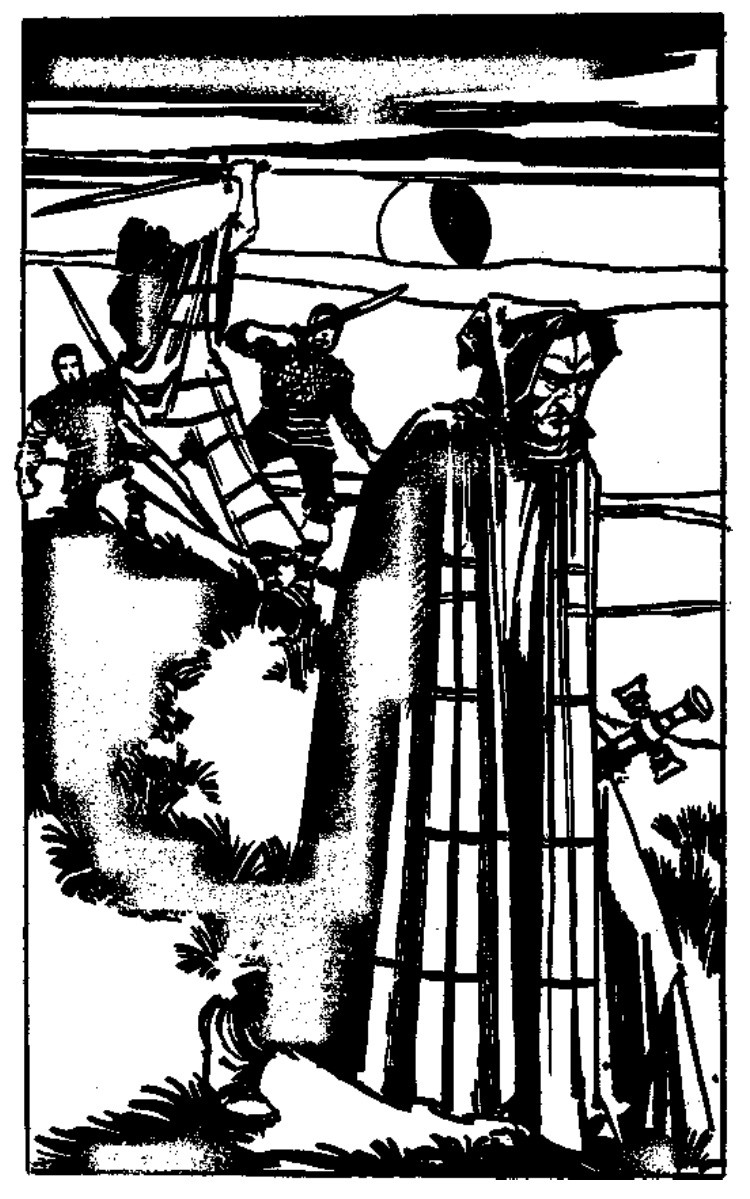
If that's a scarf, this dude should be put to the torch on principle.
-
9.- Shadow Self
: the caster separates their shadow from their body, which later slips away. At a suitable distance, it reforms into a corporeal duplicate with the sentience of the caster (permanent loss of 1 HP). The original body can still perform actions for up to 10 Rounds, but it cannot cast spells, and at the end of the duration it pops and deflates like an old balloon.
Geas
: the 1 HP loss.
-
10.- Summon Balor, Prince of Darkness
: the gaze of Balor is death and no one has lived to tell about it. Casting this spell kills the caster and all of their opponents in a 20 meter radius.
Geas
: welp.
As for madness, we now get a nifty table detailing severity (mild, character suffers one bout then fully recovers; intermittent, roll 1d6 in a situation where it could take effect, and it triggers on a roll of 6; acute, it always triggers) and type. We have things like schizophrenia (treated as if a new character of a different Profession is now inhabiting the characters' body
 ) varied phobias, megalomania ("This madness is the most fun to roleplay."), etc. They're all crippling (though megalomania renders the character immune to mind control), and they may be healed by appropriate role-playing, which should net the character some XP, or by being blessed by a priest in front of an altar bearing a relic of a saint because Medieval Fantasy Europe.
) varied phobias, megalomania ("This madness is the most fun to roleplay."), etc. They're all crippling (though megalomania renders the character immune to mind control), and they may be healed by appropriate role-playing, which should net the character some XP, or by being blessed by a priest in front of an altar bearing a relic of a saint because Medieval Fantasy Europe.
Next: Sweet Balor and Hella Darko Badguys.
This is going to be so boring
Original SA post Dragon Warriors: Book 5This is going to be so boring
Alright fuck, I better start writing this or I'll never get this book done.
The seven adventures in Book 5 collectively form a single campaign, for characters of 5th-7th Rank. The campaign begins in the fief of Glissom , north of Sulphur Bay and the damnable Kingdom of Erewon from The Elven Crystals. Glissom has rich, arable land, bordered north by the Mountains of Brack , from which cold winds from the northern wastes blow. It is said that the earth was once ruled by Balor , the incarnation of Darkness, until the other elements rose up against him and buried him along with his city of Nem beyond the northern mountains. The farmers and old men that tell this legend will also relate how once a prince of Glissom named Fengil once sought Balor's lost city, never to return, but one shepherd claimed to have found the wicked city and a gold pectoral with the prince's name on it. They will also say that when the legions came one of their centurions, Drajan , also searched for the lost city, but never returned. Surely none of this is relevant to anything!
Okay, bullshit, it totally is. Fengil exists still and he is an undead servant of Balor, plotting to steal the Hearth Fire from the King's tower in Glissom for his master. To do so, he made a pact with the Steward of Glissom, Kilnded , to murder the King and animate his corpse to convince the people that he had retired to a private life. Kilnded did so with gusto, and people don't know the King has been dead for many years. Now, Fengil is going to send the eeeeeevil Hawks of Balor to steal the Hearth Fire at the Spring Festival, and Kilnded will send a messenger north to confirm the bargain. Not that the Prince has any intention of holding his side of the bargain, that was... uh. I don't think Kilnded has put much thought in this plan.

The first scenario, The King's Tower , puts our characters standing guard at the eponymous tower because of a custom that holds that strangers must stay watch at the King's tower during the Spring Festival while the people celebrate the parting of winter. The PCs obviously know nothing of the plots being hatched, only that the king, Durindar , renounced affairs of state two years ago to retire to a life of contemplation and solitude and that only his steward talks to him now. The PCs are employed to guard the King and the sacred flame that burns in the tower and that according to legend was taken from Balor's own smithy - if the flame were to return north, it says, Balor will be released upon the world once more. As the PCs take up their posts at the base of the tower, Kilnded will show up and announce (very emotionally, mind you) that the King has decided to nominate him heir to the realm over his nephew Doron , notorious rake and troublemaker. Kilnded will then go to the elders awaiting the King's speech and give them the surprise news... and then everything will go pitch black. Hawk-like silhouettes will be able to be seen barely up in the sky, and two of them will make for the balcony while another two dive towards the PCs! There are six Hawks of Balor total, 7th Rank creatures but not that impressive in combat. Their big trick is trying to catch a character (successful attack roll that scores less than half the required number, then a Speed 12 attack for the character to avoid) and fly up with them at the rate of 6m/round. They're not too strong, though, and they won't be able to carry off anyone once they take more than 50% damage. As the PCs fight off the hawks, they will notice the two that attacked the balcony make off with a glowing brand and a limp human shape...
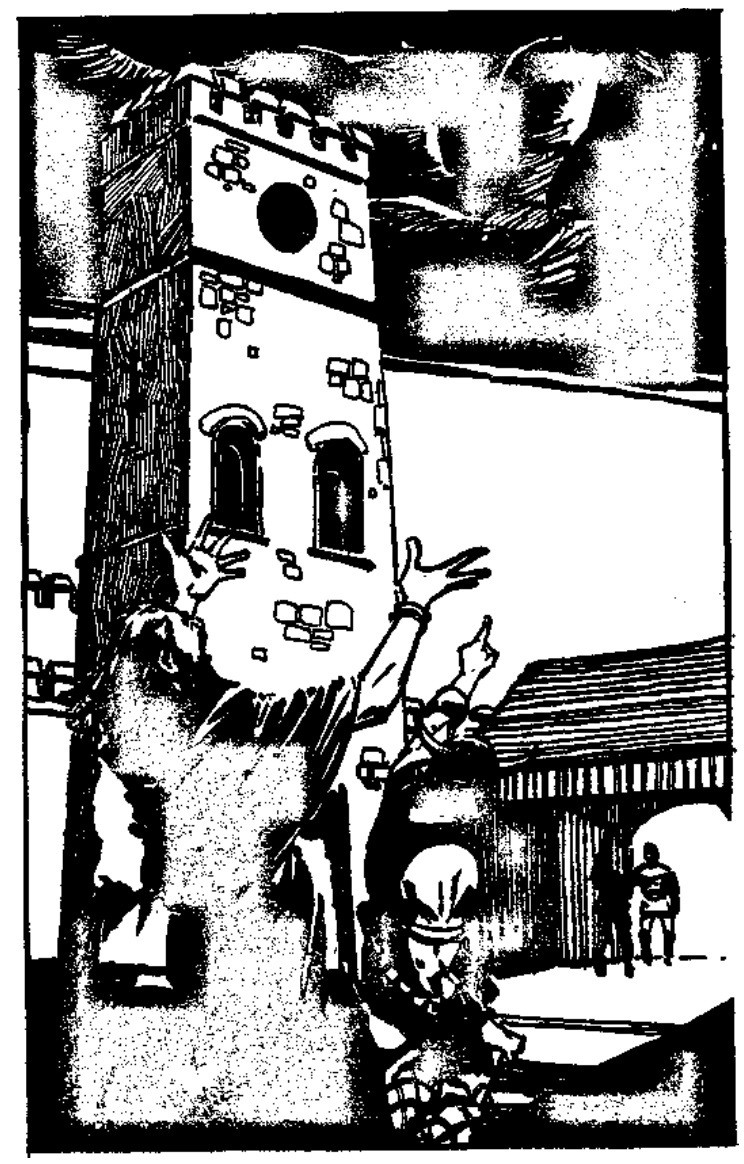
SWEET JESUS I CAN'T MAKE OUT SHIT
Kilnded and two heavy-set Barbarians will show up and he will unlock the tower before rushing up. Mysteriously, no one can seem to turn on a light or torch! His goons' demeanor will make it clear that the PCs are being implicated in the hawks' attack, but - in credit to the campaign - PCs actually have a chance to uncover the plot here and now. All the elders support Kilnded and won't go against him unless the PCs have a smoking gun (or if the Steward and his goons are dead
 ) but observant PCs may notice how the two scrolls that hung from his belt are missing (Kilnded is a Darkness Elementalist that just used Extinguish), and one beggar that was around trying to score some alms is also gone (this is the Emissary the Steward is sending north). In the short time PCs will have between Kilnded climbing up the tower and coming down to accuse them, they may just launch an attack on them or search the tower for evidence. The ground floor seems pretty disused and the first floor has a library on which the books seem pretty disused except for two: a genealogical survey of the King, Prince Fergil's name marked down, and a book of myths and legends concerning Balor and the lost city of Nem. The second floor, where the balcony is, is what has the interesting bits: they will find feathers of the Hawks here, obviously not those of a normal bird, a smashed box once full of cosmetics and heavy perfumes (used by the Steward to prettify the King's zombie) and a room from which an unbearable stench emanates, full of rotting meals (where Kilnded stashed all the food the King was supposed to eat). Finally, the third floor is where the Hearth Fire used to burn, but aside from more Hawk feathers it is empty now.
) but observant PCs may notice how the two scrolls that hung from his belt are missing (Kilnded is a Darkness Elementalist that just used Extinguish), and one beggar that was around trying to score some alms is also gone (this is the Emissary the Steward is sending north). In the short time PCs will have between Kilnded climbing up the tower and coming down to accuse them, they may just launch an attack on them or search the tower for evidence. The ground floor seems pretty disused and the first floor has a library on which the books seem pretty disused except for two: a genealogical survey of the King, Prince Fergil's name marked down, and a book of myths and legends concerning Balor and the lost city of Nem. The second floor, where the balcony is, is what has the interesting bits: they will find feathers of the Hawks here, obviously not those of a normal bird, a smashed box once full of cosmetics and heavy perfumes (used by the Steward to prettify the King's zombie) and a room from which an unbearable stench emanates, full of rotting meals (where Kilnded stashed all the food the King was supposed to eat). Finally, the third floor is where the Hearth Fire used to burn, but aside from more Hawk feathers it is empty now.
Anyway, the party will be summoned to the Council of Elders soon, and Kilnded will accuse them of negligence. His goons will be holding Doron, who was supposedly lurking suspiciously around the tower at the time of the attack (though no one remembers having actually seen him.) With the agreement of the Elders, he will exile the party and Doron, only contemplating their return if they come back with the King's body and the Hearth Fire. To do so, he will send his two Barbarian bodyguards, Phon and Mut , to "help." A full-scale battle may break out now if the PCs have enough evidence. If the PCs try returning later to Glissom, they will have to fight off all of Kilnded's henchmen, unless they get damning evidence (like the message his Emissary is carrying), in which case the Elementalist will be on his own. Even if the PCs off the Steward now, though, the elders will still beg them to undertake the mission, though now with the promise of no less than 100,000 Florins as a reward. Stats are given for Kilnded (10th Rank Darkness Elementalist minoring in Fire and Earth), the Barbarians (7th and 8th Rank respectively) and generic men at arms (3rd Rank average), as well as Doron (6th Rank Knight). Doron is a a party beast that spends most of the time drunk and has had to be bailed out of the town jail more than once by the Steward, but he is also fearless and loyal to those who aid him.
The second adventure, The Inn of Chang , assumes the PCs got exiled along with Doron. The north wind is getting more and more bitter, and Phon and Mut suggest they get out of the road and track down an inn. They will do everything they can to get them to accompany them - they've been tasked to make sure the party and Doron are dead by morning. At the inn, the Barbarians will introduce the PCs to the strangely-named-dude-given-the-European-Medieval-Fantasy-setting/innkeeper, Chang , who will charge them 1 Florin for food and two for a room. Phon and Mut will claim to have eaten already and retire to their room, while the PCs have their food. Then Chang (who will also eat with them) will show them to their rooms. Oddly enough, the doors have two keyholes. Chang, if pressed, claims that his predecessor managed to lose all the keys and he had to had them replaced. Anyone that tries opening the door half an hour after they've retired to rest will find them locked from the outside. Anyone that is still awake, that is, as the food was drugged (Strength on 4d6 or go down like a sack in the next 1d20 minutes for 1d6 hours).
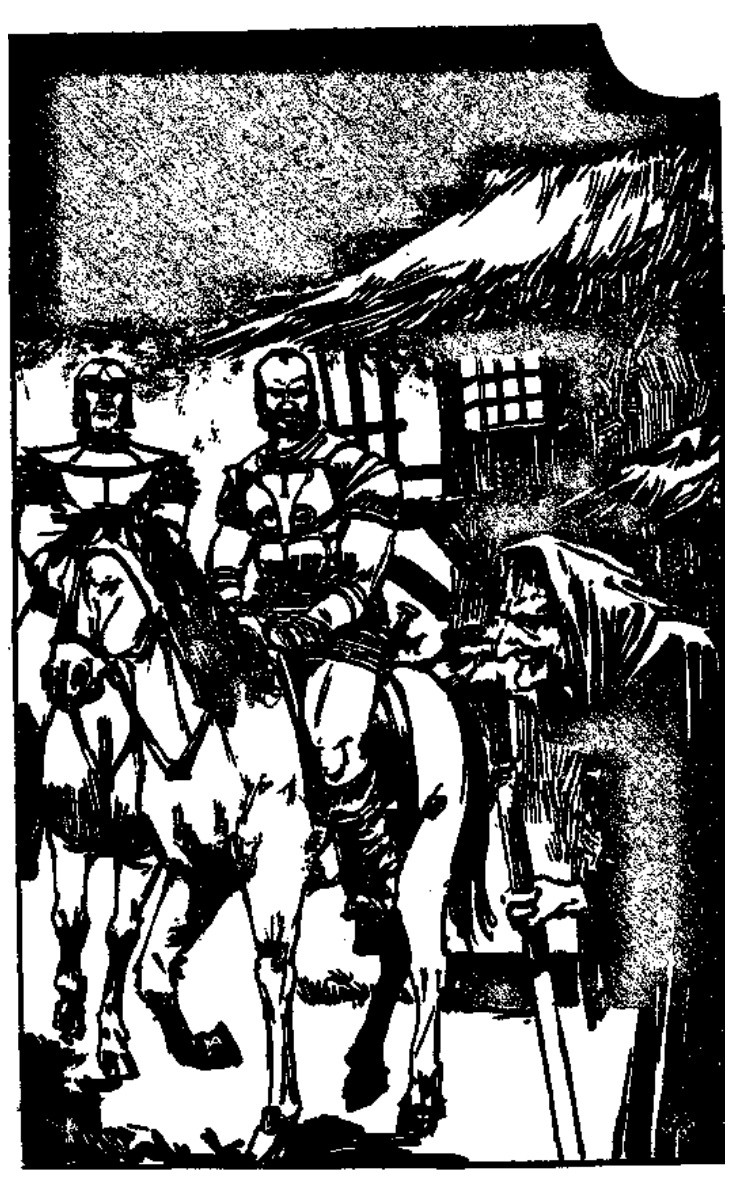
Legit as fuck, this guy.
Chang isn't affected, of course. He is a 10th Rank Vampire.

So basically, if everyone blows their saves, TPK right here. Chang will attempt to lure a PC into his kitchen and sit on a booby-trapped chair that traps anyone sitting in it, then kill them quickly; he will activate a trapped bed in one of the rooms and wait for the PC sleeping in it to fall through to where he is waiting; and then he'll just transform into mist, creep through the fireplace in each room and kill any drugged party members left. Meanwhile, Phon and Mut will be long gone, along with the PCs' horses. Fortunately, this means that Chang is alone, and though he is strong and has all the vampire powers he is completely unarmored - he has a +1 suit of plate, but he obviously won't be wearing at first and he will only use it if things go seriously south for him. The rest of his treasure are 350 florins, a Theriac potion, and a Potion of Strength. Even if they win, the PCs are now without horses, and returning to Glissom will almost certainly get them thrown out of town by the guards. Or they may continue north...
Next: oh fuck no more woods please
Trudge trudge trudge
Original SA postPurpleXVI posted:
On the one hand, I suppose it's reasonably fair that the bad guys are a bit clever about things here, and the PC's do seem to be given enough chances to realize something is fucked and not just go along mindlessly with things, but on the other hand, any situation where the PC's can be screwed entirely by dice rolls that way seems kinda malicious.
And is there any provision for particularly clever players somehow foiling the theft of the flame entirely?
Not really, the PCs are going to be shooting at -9 penalty at the birds for the short time they'll be in sight, they have enough HP to tank a couple of arrows, and even if they manage to take out the two that are going for the flame while fending off the ones directly attacking them there are another two hawks flying high as reinforcements.
Dragon Warriors: Book 5
Trudge trudge trudge
So, next scenario! The Siren Woods has our heroes going north, following the trail of Kilnded's Emissary. Eventually, they reach a regular village and The Silver Stag , a regular inn without pseudo-Oriental vampires for a change. The innkeeper will be very surprised if they tell him that they intend to go further north, and tells the PCs about another black-clad rider also going that way. The villages tried to warn him, but he wouldn't listen! And no one comes back from the mountains. Next morning, the PCs will have to go without a local guide because the villagers aren't idiots. The innkeeper does warn them, though, that they should stay in the trail through the woods that separate them from the mountains - if they stray, they're doomed. In fact, the woods are home to dickass wood elves, and a party of them will attack the PCs if they stray from the path.
The first encounter they'll happen upon is an ivory tower , with an arched entrance at its base. It has a spiral staircase leading upwards, and at the top of the tower there is a wooden chest with a +2 two-handed sword... but the tower itself is a trap, shrinking as the character(s) climb it. Characters that stay outside will be able to shout warnings at those who enter the tower, and if they get out before the shrinking is complete they will suffer no harm, but those who stay for the entire process will end up really, really tiny. And the sword will be tooth-pick sized, rendering it useless. The effect is permanent until the afflicted characters receive a 7 MP Dispel Magic; this also restores the sword to an useful size.
A few miles after the tower, the characters will be ambushed by dickass elves, a swarm of darts narrowly missing them. If they give chase, they will end up trapped in a cobweb of elven strands (Strength in 2d10 to break free), while the elves freely fire more darts at them. The darts are d6/2 weapons coated with poison (the more darts that hit a character, the greater the strength of the poison), and they also have hallucinogenic effects: afflicted characters get to roll on a table to see if they fall in love with the first character of the opposite gender they meet, believe the next creature they see is a Basilisk, and other stupid shit. Fucking elves! The war party comprises one 6th Rank Sorcerer and three 5th Rank warriors, who will always be able to flee unless the characters can take one out in ranged combat (-7 adjustment to missile fire), in which case the elves will circle around their fallen comrade.
Further on, the PCs will come across a beautiful pool , with singing birds and all that peaceful stuff. There are a number of scantily clad, beautiful men and women bathing in the pool, who will call out to the characters and point at a tree in the middle of the pool, golden apples hanging from it. The beautiful people will throw the PCs some apples and invite them to get more. There is a bower of climbing roses separating the road from the pool, and characters that cross it will be hit with a Magical Attack of 10: if successful, the characters instantly age, halving their Attack, Defence and HP, and reducing their Looks to 5. The effect will wear off in 1d12 months. The beautiful people will disappear if this happens, but characters will be free to pluck the golden apples. They're magical, and someone who eats one a day will not grow old. There are about 100 apples worth 1 gold piece each, but it's up to the PCs to figure out how to cart them away. If the characters turn around the bower to get at the pool, the beautiful people will screech and reveal themselves to be Ghouls, scooping up hidden weapons and attacking. The tree will also wither and die in seconds as this happens.
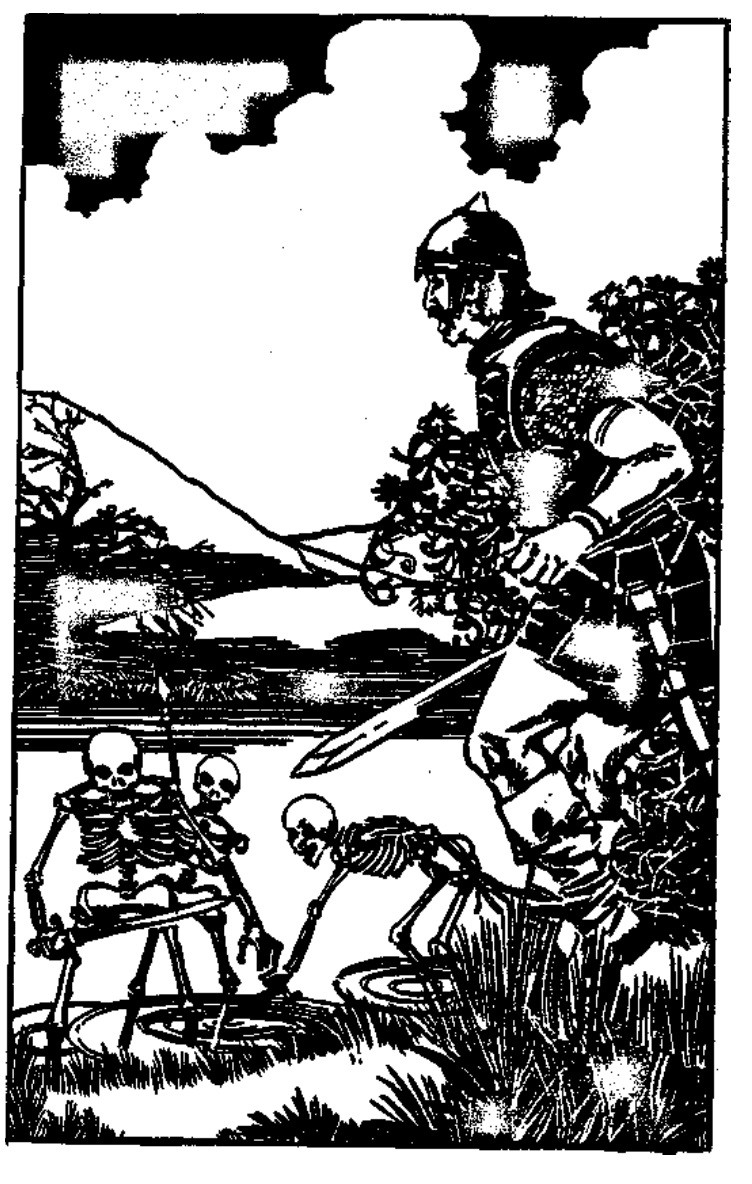
Those are clearly skeletons, not ghouls COME ON

A couple of miles north of here characters will find a burial mound , with a king and... yeah, yeah, undead Revenant, big fucking woop. A thick mist will rise from the ground as the Revenant rises, forcing the characters to fight blind. Its treasure is a magical crown that absorbs the first offensive spell cast against the character in a day (recharges at dawn) and a staff that casts the Burden spell if banged on a solid piece of ground (again, once a day).
Finally, characters will find a village in habited by fay, blond haired people, distantly similar to the wood elves. They are peaceful folk, but as it happens, the Emissary is here, torturing the village elder for information - the secret passage in the mountains, which the villagers hold in sacred awe. Little did he know that the elder was an Air Elementalist and is using Stargaze to no-sell the hot coals the Emissary is applying to his feet.
 The rest of the villagers cannot do anything about it, but enter the PCs! If the characters approach they will be spotted by the Emissary's warhorse, who will snort loudly to warn its master. If warned, the Emissary will be waiting in ambush with his crossbow as they approach the village's moot hall. He is a 7th Rank Knight with a +1 two-handed sword and plate armor and will fight to the death, but the characters should make short work of him. He's carrying the damning note from Kilnded to Fengil, enough evidence to put the Steward to the torch. The villagers will be grateful for their assistance, and characters will find them to be very wise, if physically slow and sluggish. It's because of their well's water: it increases Intelligence in 3 and reduces Reflexes in 3, if a liter or so is drunk in a day. The effect wears off after a day, too. The elder will tell the PCs that they are in the village of
Mimir's Well
, named after Mimir the God of Knowledge, said to have lived there before Time began. Before Balor's reign, the people of Mimir were said to be powerful and have dealings with the denizens of the lost city of Nem. He will also tell them that a long time ago, the "Bronze Chests" came searching for Nem, with a sorcerer legend calls Fabius with them. The day before the expedition set out, Fabius, a companion and a scribe set off to search for the ruins of a nearby temple to Mimir, but never returned. The leader of the legionnaires was worried and went out to search for them himself, but all he found was a map scribbled by the scribe, along with a strange riddle copied from a stone monument in the ruins. And the grey ghost of Fabius still can be seen in the woods at night...
The rest of the villagers cannot do anything about it, but enter the PCs! If the characters approach they will be spotted by the Emissary's warhorse, who will snort loudly to warn its master. If warned, the Emissary will be waiting in ambush with his crossbow as they approach the village's moot hall. He is a 7th Rank Knight with a +1 two-handed sword and plate armor and will fight to the death, but the characters should make short work of him. He's carrying the damning note from Kilnded to Fengil, enough evidence to put the Steward to the torch. The villagers will be grateful for their assistance, and characters will find them to be very wise, if physically slow and sluggish. It's because of their well's water: it increases Intelligence in 3 and reduces Reflexes in 3, if a liter or so is drunk in a day. The effect wears off after a day, too. The elder will tell the PCs that they are in the village of
Mimir's Well
, named after Mimir the God of Knowledge, said to have lived there before Time began. Before Balor's reign, the people of Mimir were said to be powerful and have dealings with the denizens of the lost city of Nem. He will also tell them that a long time ago, the "Bronze Chests" came searching for Nem, with a sorcerer legend calls Fabius with them. The day before the expedition set out, Fabius, a companion and a scribe set off to search for the ruins of a nearby temple to Mimir, but never returned. The leader of the legionnaires was worried and went out to search for them himself, but all he found was a map scribbled by the scribe, along with a strange riddle copied from a stone monument in the ruins. And the grey ghost of Fabius still can be seen in the woods at night...
Next: an unnecessary detour.
Lods of emone
Original SA post
Oh, it can't be any more unfiltered than Houses of the Blooded.
See, when I did my writeup of Blood and Honor? I didn't know better. Blood and Honor is as filtered from Wickness compared to Houses of the Blooded as the first edition of L5R is filtered compared to Blood and Honor.
But before diving into that...
Dragon Warriors: Book 5
Lods of emone
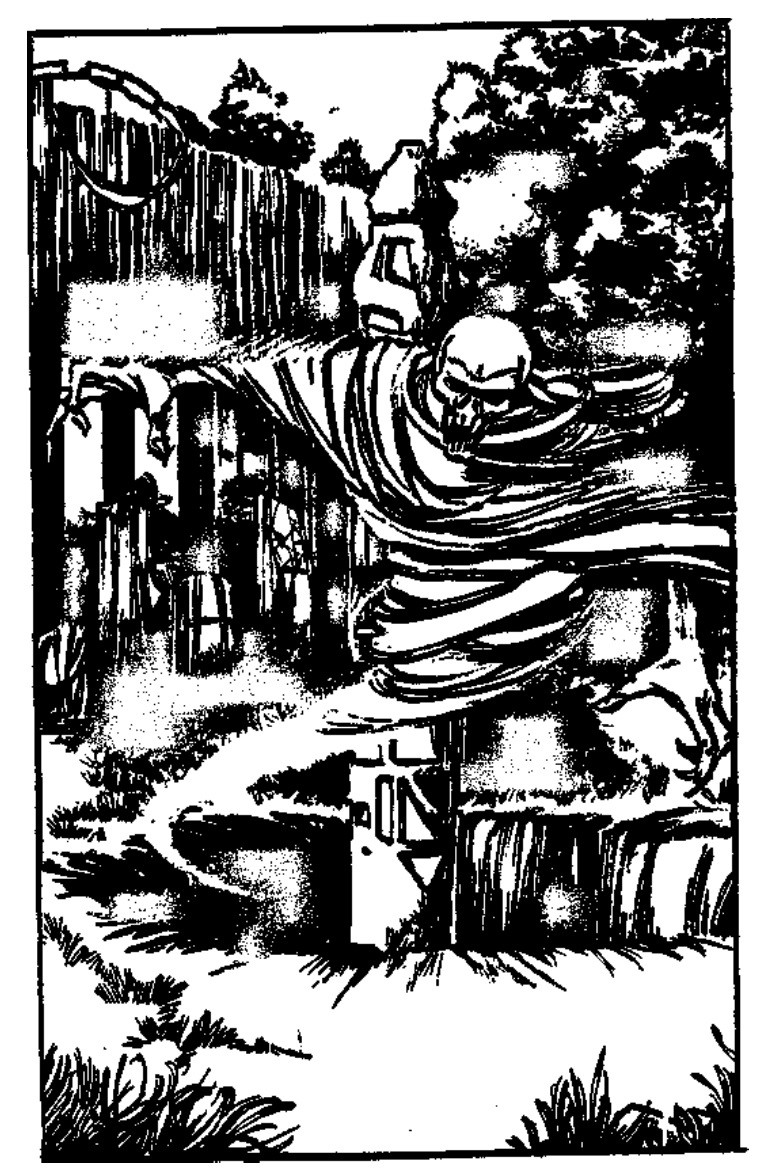
2spooky, 2useless.
Assuming the characters go visit the ancient ruins (and really, why would they do that?), the Elder of Mimir's Well will accompany them, though he will not enter the ruins themselves. If the party sets off at night (and again, why would they do that?) they will come across the
scribe's ghost
: fright attack, of course. Anyone not dead or fleeing in terror will hear the ghost repeat softly to himself: "
Mimir: enter the pit, kneel there, bid me enter."
This does not happen during the day.
Either way, the characters will soon arrive to the
ruins
, remains of large buildings and pillars around them. At the center square, there is a 10m deep pit with stairs leading down to a giant stone idol, presumably Mimir himself. Clearly etched in the bottom of the statue there is a message characters will recognize as written in an ancient form of their own language!

Go on,
solve the puzzle.
I'll be waiting.
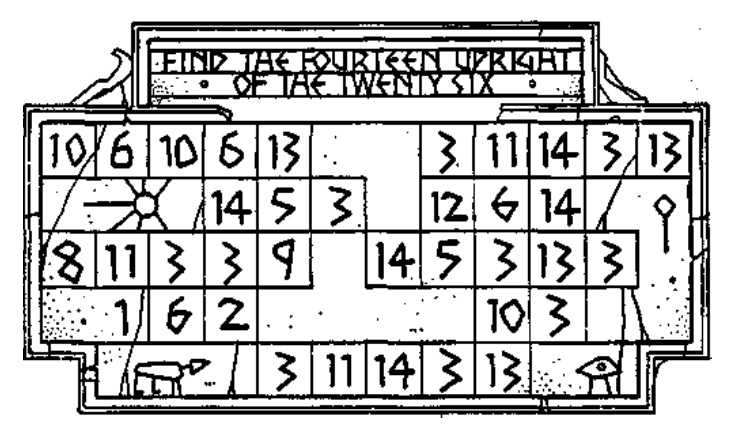
The "Fourteen Upright" are the fourteen letters of the English alphabet with vertical lines in their capital form. The SEKRIT MESSAGE is what the ghost was repeating to himself. If someone enters the pit, kneels, and bids Mimir (or Knowledge) to enter, a stone slab will slide open, revealing a passage into the darkness...
The party will enter a
plain rectangular vestible
, with a stone plinth right in front of them. There are two iron pans on either side of it and the characters will be able to make out the remains of some sort of powder in the plinth's depressions. Suddenly, two mummies will enter the room, bearing an iron dish and a shortsword. The idea is that characters take the powders in the dishes and throw them at the plinth at the same time: this will open the way forward. If the party takes too long or throws the powders one at the time, the mummies attack (6th Rank jerks) and in the latter case, the powders have noxious effects, with one filling the room with fog that the mummies have no trouble seeing through, and the other being strong poison because sure let's have a TPK right here. One of the alcoves from which the mummies pop out from has a large amount of the ritual powder: if disturbed, it will boil up and blow (Reflexes roll, strong poison again) but it hides 17GP, 164 GP (what?), 225 GP worth of gems and an Eye of Foreboding (prevents the bearer from being surprised)
Onwards, the characters will find
the scribe's body
. Nothing too remarkable about it other than the top of its skull has been neatly removed. Also, the panel through which they came will start closing: Speed 14, and characters that manage to jump back can open it again by using the mummies' powders. Otherwise, it will take several hours of work or a Portal spell to return. There's nothing of interest in this hall other than some blood, scratch marks, and an almost blunt sword - as if it had been used to strike something extremely hard.
There's a door at the north end. First character that crosses it...
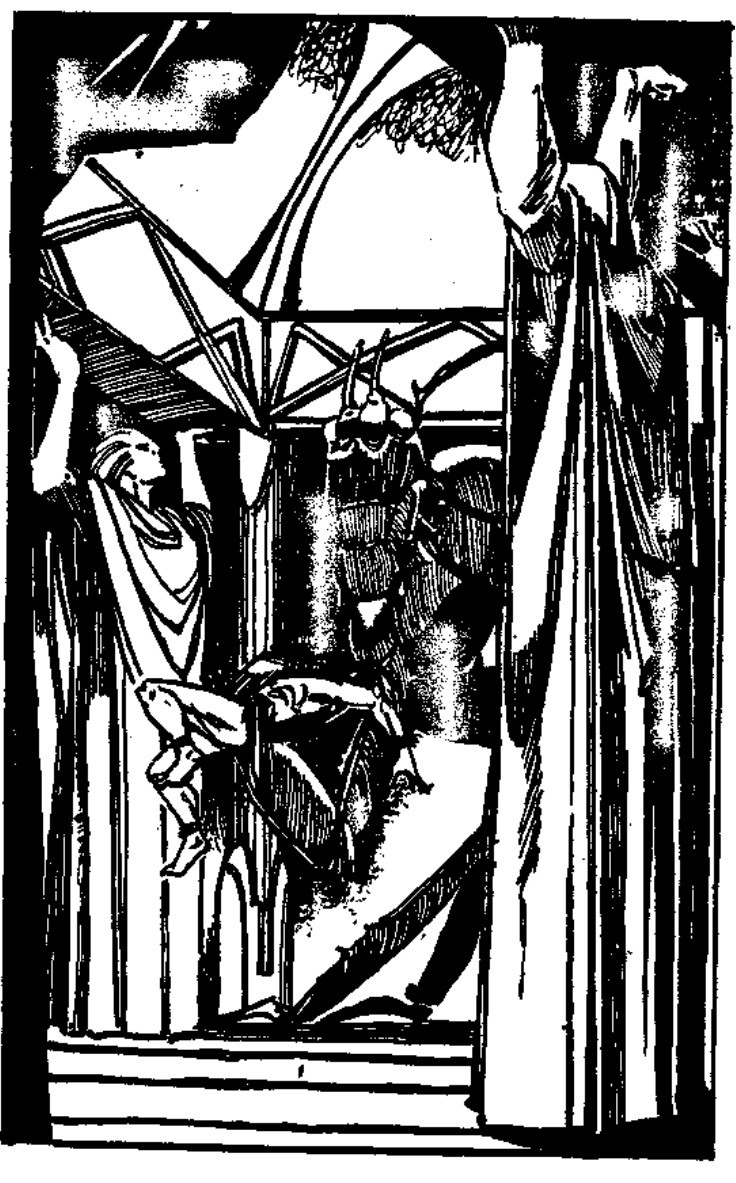
...gets a faceful of this motherfucker.
Necrophobius
, the giant mantis over there, is a demon. It will try to seize the first character with its forelegs (attack roll, then a Strength-4 roll for the trapped character to break free) Then it will try sawing the top of their head off with its d8/10 mandibles
 , succeeding once the character is dead at -3 HP. It will then disappear into thin air. It has an AF of
8
, but it can be turned away with a relic. The ceiling of this room is supported by eight pillars resembling women. They are called
caryatids
, representing the Arts. Each of the pillars represents Music, Philosophy, Poetry, Navigation, Dancing, Rhetoric, Painting and Animal Training ("the ancients had strange ideas about art!") If touched, they will start emitting a babble no character will be able to recognize... yet. If more than one pillar is set off, the babble will soon become unbearable, and if three or more are set off characters will have to roll under Intelligence in 3d10 or get a nice juicy Madness Table roll. The pillars shut up after five minutes. A door north leads out of this place. If characters return with the helmet from Treasure Room 3, the babble becomes modern language and characters may benefit from the caryatids' knowledge:
, succeeding once the character is dead at -3 HP. It will then disappear into thin air. It has an AF of
8
, but it can be turned away with a relic. The ceiling of this room is supported by eight pillars resembling women. They are called
caryatids
, representing the Arts. Each of the pillars represents Music, Philosophy, Poetry, Navigation, Dancing, Rhetoric, Painting and Animal Training ("the ancients had strange ideas about art!") If touched, they will start emitting a babble no character will be able to recognize... yet. If more than one pillar is set off, the babble will soon become unbearable, and if three or more are set off characters will have to roll under Intelligence in 3d10 or get a nice juicy Madness Table roll. The pillars shut up after five minutes. A door north leads out of this place. If characters return with the helmet from Treasure Room 3, the babble becomes modern language and characters may benefit from the caryatids' knowledge:
-
- Poetry: the character becomes able to memorize any piece of verse, no matter the length.
-
- Philosophy: the character becomes more skeptical, particularly about occult shenanigans. How can you be skeptical when undead are actually A Thing in your world? Anyway, the character gets +2 bonus against fright attacks, vampire mesmerism, etc.
-
- Music: the character becomes adept at playing the viol, lute, pan pipes or drum (roll randomly) and can charm animals if they can roll under the difference between their Ranks in 1d20.
-
- Navigation: the character can identify any constellation or single star at night, or judge their surroundings by the angle of the sun and the time of the day. The character never strays more than five degrees off course during ocean trips, or ten miles by day.
-
- Dance: the character becomes adept at any of the current dances at court. They also get a +1 to Evasion!
-
- Rhetoric: the character can charm others of lower Rank by rolling under the difference in 1d20. Charmed folk will perform one act on the character's behalf as long as it doesn't entail danger to the charmed person or friends, or the loss of property.
-
- Painting: the character can paint good semblances of anyone they have seen for at least five minutes.
-
- Animal Training: animals will respond to the character as if under the Command spell, but if wild the animal must be captured first.
The next passageway has runnels running the length of the passage with what appears to be blood coursing through them. A character that stares at the blood gets hit with a Magical Attack of 15: if successful, the character loses 3 HP as invisible hands seemingly attempt to strangle them. The character may attempt to save again each round at -2, -4, -6, and so on (are the penalties against the Magical Attack or their own Magical Defense? Who knows) but once they do, all the damage caused by the magical attack will disappear. The blood also counts as a mild poison. The source of it seems to be a large bronze head at the end of the corridor, and characters approaching it will be hit with a Magical Attack of 8 that will make them get close to the head, believing it to be a benevolent deity. Suddenly, succubi will pop out! Are they sexy, you ask? Fuck no, they're naked, yes, but they're also pink-skinned, four-armed, and have a tail and a monkey-like face. They get two attacks per round with their shortswords and will attempt to grapple a character with their free arms. It's a Strength+Reflexes minus the character's Reflexes in 1d20 roll for the succubi... only they have no Strength or Reflexes score listed. Reflexes is randomly rolled for all monsters, true, but still.
 Held characters can be stabbed automatically without hit rolls. They also regenerate 1 HP per Round if wounded by non-magical weapons, but a relic pressed against their skin will turn them to ash.
Held characters can be stabbed automatically without hit rolls. They also regenerate 1 HP per Round if wounded by non-magical weapons, but a relic pressed against their skin will turn them to ash.

Halfway through the corridor there is a double door leading to the treasure rooms of Mimir. There are six in total:
-
i) this room has a vase with a sealed top. A Peer spell will reveal an amulet at the bottom of the vase, and a small Wraith over it. If the top is punctured, the Wraith will escape, take two rounds to grow to its full size, and attack. But there's also a jar with a lid next to the vase: if placed over the vase as the top is punctured, the Wraith will fly into it, and the lid can then be clamped shut to prevent its escape. The Wraith only has 3 HP though, so it's a Dragonsbreath away from biting the dust.
 The amulet is one of Sovereignty over Violence, halving damage when activated (Spell Expiry roll applies)
The amulet is one of Sovereignty over Violence, halving damage when activated (Spell Expiry roll applies)
-
ii) a high, vaulted room, with a dark pit at the center and its ceiling lost in the shadows. Anyone entering will find something is taking them up, up and away! Reflexes roll to grab on to something, else the characters end up pressed against the ceiling, where there are also a bunch of skeletons and a number of upside-down chests, some open and some not. Each character may open one closed chest next to them: if done so carefully, they will find a Ring of Flying, which allows characters to fly around for up to one minutes per charge (d20 charges per ring.) If the chests are opened recklessly, the rings will fall: Reflexes roll to catch them. The skeletons didn't manage to catch them.
 If characters explore the bottom of the hundred-feet deep pit, they will find the treasure of the adventurers trapped up in the ceiling. Moderate Treasure Hoard, except that all rings found will be Rings of Flying.
If characters explore the bottom of the hundred-feet deep pit, they will find the treasure of the adventurers trapped up in the ceiling. Moderate Treasure Hoard, except that all rings found will be Rings of Flying.
-
iii) the
Helmet of Tiphon
that they need for the caryatids is here. If put on, the character will get hit with a Magical Attack of 12. If successful, the character will be assaulted by a host of babbling voices inside the helmet, like the world's worst Teamspeak server. They will also start speaking gibberish, and only a Dispel Magic will allow them to remove the helmet. If the attack is resisted, the character will find out they can understand any spoken tongue, including the caryatids' babble. There's also a copper box with a folded card inside that will be useful in the sixth room.
-
iv) this room is slimy, with moss-covered walls and a muddy floor. There is only a Portal spell in this room: if read inside, the door through which they came will shut closed and water will start filling the room. Ten rounds to escape, but actually no escape is possible unless one of the PCs is a Sorcerer that can cast Portal.

-
v) another muddy room. There is a Good treasure hoard in here (like
16,000 Florins
, a Shadowbolt scroll and +2 chainmail), half under the mud, half in the Mud Wyrm's lair. Mud Wyrm? Yeah, it's like a large, brown eel whose bite causes paralysis and will try to make the characters drown in the mud. There's also a +2 sword next to a skeletal hand, that will shoot for the throat of any character that tries to take it (Speed 12) Further hands will appear to choke the character and friends out at the rate of d4 per Round. They deal d6/2 damage, but they only have an AF of 1 and 2 HP. And no Defence from the looks of things
-
vi) if characters swim through the mud and the Wyrm's lair, they will reach this room. It has no features at all, being perfectly square, but if characters check the folded card from the third room they will realize that 12 of the bricks in this room are loose. It's extremely unlikely they will find the treasure in this room otherwise (2% chance). All in all, this room has a solid gold core worth 500 GP, 2 doses of Occult Acuity, 2 of Night Vision, 2 of Healing, 2 of Strength, an Ankh of Osiris, a Ring of Agonizing Doom with 4 charges, a +1 dagger, a solid silver core (
20,000 Florins
), a Resurrect scroll, a Pentacle of Entrapment scroll, and a Ring of Sentinels with 4 charges.
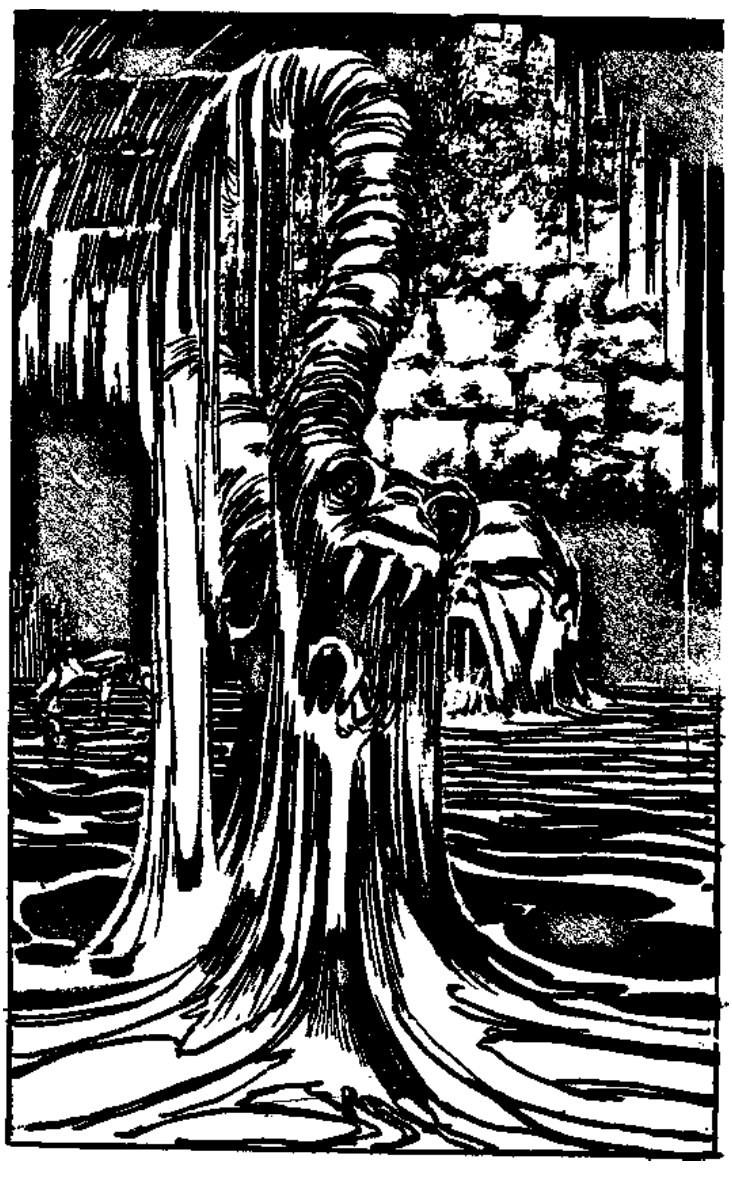
With your parts in sea-dark, awaiting the day the fang-fish will bite.
The last room can be reached from the blood passage. See, the god Mimir never existed actually. It was a demon, Shader , who demanded tribute from the worshippers. Necrophobius is its physical incarnation, and it is here that it will be found if it manages to get away with a dead character from the first encounter. The corpse of Fabius will be found there, also with the top of its skull removed. Only the face of the demon is visible, and anyone that looks at it directly gets hit with a Magical Attack of 15. Madness Table rolls, ho! There is nothing else here, so characters may just grab the treasure and leave...
...or, you know, just never take this detour. Don't they have a sacred flame to save or something? An evil god to stop?
Next: Vertical Limit was a shitty movie.
Ice climbers
Original SA post Dragon Warriors: Book 5Ice climbers
After a night of feasting, the Elder comes to wake the PCs up and tells them he will show them the way to the Lost City of Nem. No one has returned from the path he will show them, but he will make them a gift he hopes will be of use: 30 meters of elven rope , effectively increasing the Reflexes of anyone that uses it in 5 for climbing purposes. The party may at this point choose to return to Glissom with the Emissary's letter and confront Kilnded the seneschal, or press on. If they continue on to the city, it's time for the next scenario, The Mountains of Brack.
The elder will take them to a cavern entrance he calls The Mouth of the Gods , on a cliff face above which the aforementioned mountains of Brack loom. The elder is clearly freaked out by the ghostly wailing of the wind, and after mentioning again that no one has ever returned, he leaves the party alone. Moving on! Not long after they enter the cavern, they will start coming across the armored skeletons of the Bronze Legion, long since dead. Soon after they encounter them the ghosts of the legionnaires will appear, emitting the same wailing they heard outside. No fright attack though, and anyone casting an Oracle spell will hear them talk about their sad fate.
 A dark funnel leads upwards through the rocks, and a rotten rope climbs them. The rope is useless, but the pitons it is secured with can be used with a fancy new rope (difficulty 6 climb with a rope, 16 without one) There's also another skeleton here with a note saying to his comrades not to follow - only death awaits above.
A dark funnel leads upwards through the rocks, and a rotten rope climbs them. The rope is useless, but the pitons it is secured with can be used with a fancy new rope (difficulty 6 climb with a rope, 16 without one) There's also another skeleton here with a note saying to his comrades not to follow - only death awaits above.

At the end of the tunnel there is a huge monolithic carving of a melancholic-looking figure, with a crown of stone, an eclipsed moon on its forehead, its arms stretched out and bearing discs with the shape of a stylized sun and moon in each. The sun-bearing arm is stretched upwards and the other downwards: if the sun arm is pulled down (total 25 Strength points to do it), the other will rise, the light will dim... and the 20 Skeletons in the area will rise to attack. Also, a panel will open with the way forwards, blocked by a Shadow Gaunt. Gaunts are creatures of darkness made of literal shadow, with the powers of a 6th Rank Darkness Elementalist. It has no hit points and any attack made against it has a 25% chance to simply fail even if the hit roll succeeds. Furthermore, the Gaunt will appear behind the attacker and be ready to strike the next round with full surprise, even if the attacker is aware of the Gaunt. Also, its claws ignore armor because fuck you. Fortunately, a hit that does succeed with a magical weapon will banish the Gaunt, but not before hitting the offender with a Magical Attack 22 Curse
 and any damage it has dealt will be recovered, unless the Gaunt managed to kill someone. The room in which it was hiding holds four treasures: a
Mace of Darkness
, which is +1 and generates magical darkness on a successful attack that the victim cannot see through, but the wielder can; a
jar
with a loathsome-looking pink lizard suspended in a grey liquid solution, that if poured over any food will make the lizard appear
inside the innards
of whoever ate it and gnaw them to death from the inside
and any damage it has dealt will be recovered, unless the Gaunt managed to kill someone. The room in which it was hiding holds four treasures: a
Mace of Darkness
, which is +1 and generates magical darkness on a successful attack that the victim cannot see through, but the wielder can; a
jar
with a loathsome-looking pink lizard suspended in a grey liquid solution, that if poured over any food will make the lizard appear
inside the innards
of whoever ate it and gnaw them to death from the inside
 ; a
coin
whose owner will always know the exact location of if given to another person; an a
grappling hook
with 50 meters of rope that makes no noise when used and reduces the difficulty of all climbs in half. To open the panels that have these treasures, a silver sword in the center of the room must be used as a key, other than that the sword is only worth a hundred Florins.
; a
coin
whose owner will always know the exact location of if given to another person; an a
grappling hook
with 50 meters of rope that makes no noise when used and reduces the difficulty of all climbs in half. To open the panels that have these treasures, a silver sword in the center of the room must be used as a key, other than that the sword is only worth a hundred Florins.
The climb upwards is actually pretty damn boring so I'll summarize some of it. Assume there are caves, twists, passages and dead legionnaires all over the place.
- One room has five spell scrolls and an Ice Statue defending the chest they're in. It takes double damage from fire attacks, as all good ice creatures do.
- Another room has a small pile of treasure protected by a Frost Djinn. It has a Speed 10 attack that deals 5 damage, but after three rounds it will vanish and anyone that survives the attack will find that their armor has gained 1 AF.
- There is a frozen pool with a bunch of frozen warriors around it. There's also a stone step. Anyone stepping on it will make the freezing effect disappear, melting the warriors and unleashing an Ice Octopus on the party. Leaving the step means everyone will be hit with a Magical Attack 17 Freeze. If the octopus strikes the character in the step twice with its tentacles, it will drag them into the pool, and the instant freezing will cause immediate death.
 Fortunately the octopus has no Evasion or AF whatsoever, and cutting off its four tentacles will make it disappear into the pool forever along with the freezing effect. There's a bunch of gold rings around for the character's troubles.
Fortunately the octopus has no Evasion or AF whatsoever, and cutting off its four tentacles will make it disappear into the pool forever along with the freezing effect. There's a bunch of gold rings around for the character's troubles.
- The legion's standard bearer still holds the standard, and there's also eight Vampire Bats for no raisin. They have high Armour Bypass with their razor-sharp teeth and their bite is poisoned (strong poison, if it doesn't kill it makes the victim's skin deathly pale and turn them averse to sunlight) Only one HP though. The standard itself is magical, counting as a Warding spell for everyone in 2 meters, and it repels undead too, but it must be held with one hand (movement and Evasion reduced in half) and if the flag is removed from its pole, the magic is lost forever.
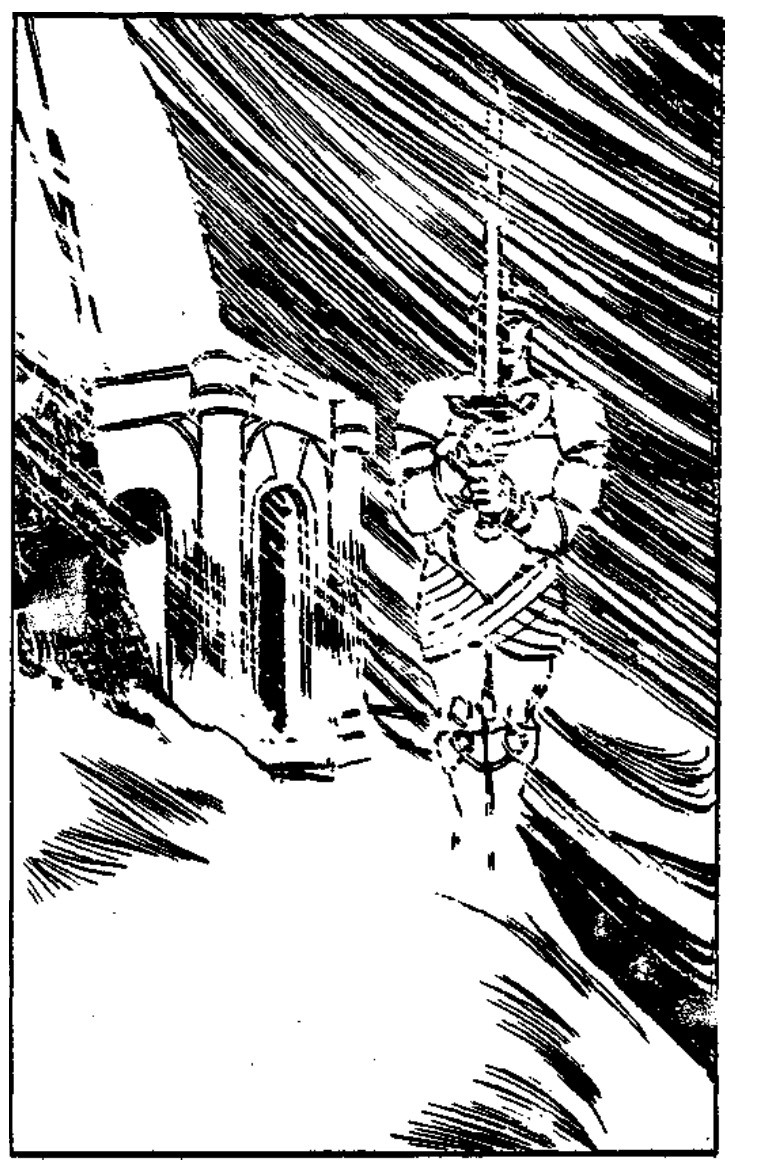
There's also the wraith of a forgotten warlord. Not too interesting, does the same BAMF trick as the Gaunt.
Eventually the PCs will come across an ice barrier. After smashing it, they will be attacked by six huge mastiffs with cold breath and hollow, sepulchral barking (morale check!). The mastiffs always go for the throat, so they have very low Attack but their bite deals 6 damage and ignores armor. And there are six of them. Ouch! They will fight to the death unless called by their masters, the two Frost Giants that live in the area. The giants live off the corpses off unfortunate travelers that met their end in the mountains: the climate provides adequate refrigeration.
 They're tough 10th Rank customers, but any character may remember (default 10% chance) that frost giants never turn down a duel challenge and may call them out. One of them will accept, armed with a trident and a hunting net, and if defeated fair and square his buddy will award the winner 500 gold pieces, a potion of Control and the Snow Gem, which allows Water Elementalists to cast any cold-related spell at half the MP cost. There's also assorted treasure in the giants' home if things turn out differently, including a skeletal hand belonging to a saint that heals any wound or malady once. Nifty! Next to the giants' home, there is a treacherous path descending towards...
They're tough 10th Rank customers, but any character may remember (default 10% chance) that frost giants never turn down a duel challenge and may call them out. One of them will accept, armed with a trident and a hunting net, and if defeated fair and square his buddy will award the winner 500 gold pieces, a potion of Control and the Snow Gem, which allows Water Elementalists to cast any cold-related spell at half the MP cost. There's also assorted treasure in the giants' home if things turn out differently, including a skeletal hand belonging to a saint that heals any wound or malady once. Nifty! Next to the giants' home, there is a treacherous path descending towards...
Next: The Temple of Balor, and the end of the campaign!
It's 106 miles to Glissom. We got one undying god, half a healing potion, it's dark, and we're wearing cloaks
Original SA post Dragon Warriors: Book 5It's 106 miles to Glissom. We got one undying god, half a healing potion, it's dark, and we're wearing cloaks
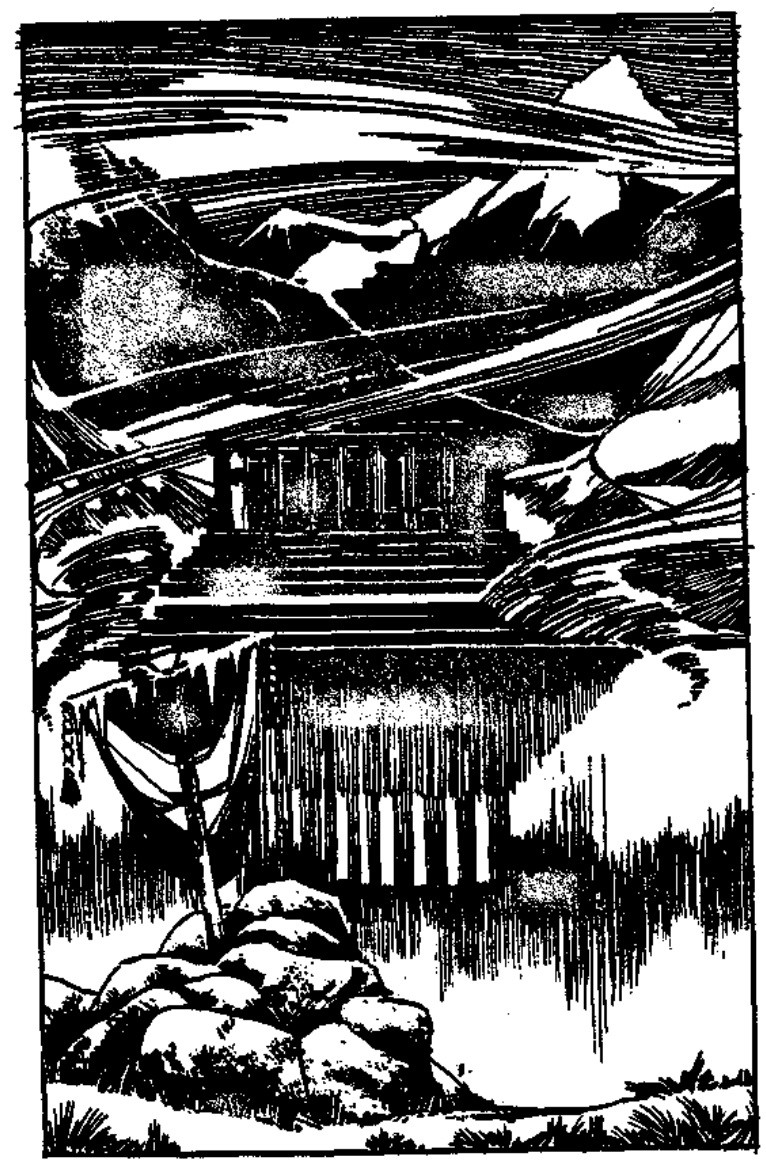
Hit it.
Down to the final adventure, The Temple of Balor! The climb down to Lake Nimmur and the remains of the Lost City of Nem is difficult, with a rating of 14 and death for anyone that slips and falls several hundred meters down. We also get some spot rules for tying the party together and hauling characters that have lost their grip back up, but hey. It will take the party six full hours to descend the mountain, with 20% chances of a random encounter. They're mostly Book 1 goons, with the exception of Ice Snakes, 2nd Rank monsters with a freezing bite and AF of 6, and a Yeti from The Elven Crystals. One of the possible random encounters is that of the ghostly legionary Drajan. If they survive his fright attack, Drajan will tell the party how only he and his lieutenant Servitus managed to cross the mountains and get here. Unfortunately, Servitus was injured by ice in the caverns and perished soon after. After burying him properly ("may Mars be propitiated!") Drajan marched on, treacherous whirlwinds and dreadful black hawks not aiding his mood, until he arrived at a maze he solved by taking "the sinister way." What he found inside he cannot say, but there's spooky horrors and also don't go into the room of the Black Star because that's a terrible idea. With that, the ghost is gone, and the party will find Servitus' frozen corpse under a low mound of stones close to the location.
The party may cross Lake Nimmir, which is perma-frozen, in which case they'll run across two Sufiriads (the whirlwinds Drajan was talking about), or only one if one was already rolled in the previous random encounters. Or they could take the long way around the lake, which will take them another three hours with 25%/hour encounter chances. Either way, as they approach the temple, the Hawks of Balor will appear and, though they will not attack, the atmosphere is so full of dread and spookiness characters will effectively get hit with a Magical Attack of 12 that will force them to roll on the Madness Table. And on top of that, someone will cast Shadowfall with a Magical Attack of 28! They're definitely not welcome. The top of the temple is a maze , and its southern entrance has a message written on it: "Touch the hand of darkness." The way to solve this maze is to follow said "hand of darkness" or, as Drajan said, the "sinister" hand - left hand rule, in modern terms. The someone that casted Shadowfall on the party was none other than Fengil himself, a 15th Rank Darkness Elementalists with almost all of the geases active and running, but he won't bother with the party beyond that - he's got a god to resurrect! He will flee through the maze, casting Javelin of Darkness at any character that gets too close. Also, there is a number of Darkness cultists (Assassins) wearing black cloaks that give any missile attackers a -3 hit penalty and playing the Half Life game of hit and run too.
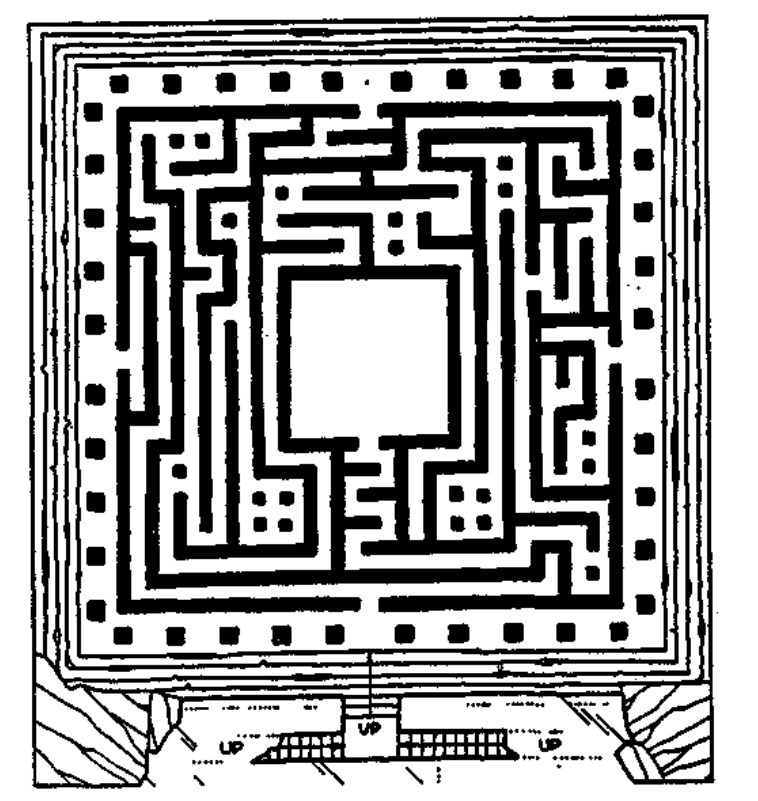
Yeah, the PCs are expected to actually solve it.
Eventually the party will arrive at the center of the maze, a courtyard with a pool and four pillars at its four corners. The pool is covered with acid scum that causes damage or armor loss on contact, and is also hiding an Obsidiak. Inside the pool there is a casket with a scroll containing a super-powered version of the Freeze spell, affecting an area of 20m. radius. The four pillars represent each element except Water, and there are small openings through which someone may pass. The Fire, Earth and Air pillars will cause damage and are generally useless, but the Darkness one hits the character passing through it with a Magical Attack of 12. If successfully resisted, the pillar ejects the character into the pool, but if not (or if the character is willing) it will teleport them into the dungeon below.
The room characters start in is a vaulted hall with a spooky pool fill with viscous, dark liquid. The exit is through an archway that seems to be obscured with some form of grey energy, and it's not possible to see through it but it seems to be the only way out. The pool ends where the archway begins, so characters could conceivably stretch their legs and cross it without touching the liquid... but that's the trap. Wading through the pool is actually the safe way, and characters that don't do so will find the barrier turning into a hood over their heads, that will then try to suck out their life force.
 The
Grey Hood
will try to get inside the victim's brain and replace it with its own grey matter. This is, of course, fatal to the victim, and is represented by a Magical Attack of 16. If successful, the victim will seem perfectly fine as the Hood hides inside the head, with only a grey film over their eyes as sign of its possession. Once it has a body, the Hood will try to kill as many people as possible and then return to the surface to lure more victims in. Bare flesh passes through the Hood harmlessly but metal does the trick; however, slicing it off someone's head is hard (Reflexes roll or the victim takes double the damage of the attack). A mailed glove is the safest way to remove it and deals 2 damage a round. The water acts as a repellent, and anyone crossing the archway while covered in it will leave a man-sized hole through it.
The
Grey Hood
will try to get inside the victim's brain and replace it with its own grey matter. This is, of course, fatal to the victim, and is represented by a Magical Attack of 16. If successful, the victim will seem perfectly fine as the Hood hides inside the head, with only a grey film over their eyes as sign of its possession. Once it has a body, the Hood will try to kill as many people as possible and then return to the surface to lure more victims in. Bare flesh passes through the Hood harmlessly but metal does the trick; however, slicing it off someone's head is hard (Reflexes roll or the victim takes double the damage of the attack). A mailed glove is the safest way to remove it and deals 2 damage a round. The water acts as a repellent, and anyone crossing the archway while covered in it will leave a man-sized hole through it.
The next room is a large, mist-covered sacrifice hall to Balor. There are a couple of rooms to the sides: one is a literal cloak room, with black cloaks embroidered with the sigils of Darkness and iron circlets. One of the cloaks has a key that is used to open the room right in front of it, which is a holding cell for the sacrifices. A note left by one of them says that black-cloaked priests with iron circlets and staffs with blue lights took his brothers. He could hear them scream in the pit, but the priests were unharmed. Hm! There are blue-lighted croziers in the sacrifice hall and characters would be wise to get some along with the cloaks before proceeding into the pit, as the mist gets thicker and all other light sources become dim. Suddenly, shrieking! Characters wearing the circlets will see the half-formed skulls of the pit demons. The black cloaks render characters invisible to the demons - otherwise, they'll have to run 3 rounds through the pit towards the exit at full speed, with 2d6 demons attacking with d10/3 claws each round. There is a large throne of bronze and gold at the end of the pit, large enough that a human could easily walk through its legs. A small wooden doorway is hidden under the throne, slightly ajar: this is where Fengil went.
Beyond it there is a small corridor. A crozier, circlet and cloak lie here, dropped hastily, and a barrier of darkness is ahead. Any Elementalist can tell it's a Curtain of Night. Crossing the Curtain will reveal a central exit north, but careful examination will show that the dust here hasn't been removed in a while. In fact, the Curtain was meant to block the exits left and right of this corridor, and for good reason. Going left will get the characters to a storage room that contains, among other bric a brac, the death masks of the temple priests: they have a ventriloquism effect that allows them to imitate any voice perfectly as long as the wearer has heard them talk once. There is a small passage on the west wall, but a Giant Spider guards it: due to the confined space, only two party members may engage it. There are two strange black halberds here, with star-shaped ends, and a strange chart scribbled on a wall. The chart (which is in base 5 for reasons) describes five successive stages and, in fact, it shows the Speeds of the tests the characters will follow in the next room. As in, the actual game mechanic Speeds.
 The test takes place in the
Hall of the Passing Shadows
, divided by five red lines. Each time a character crosses one they get hit by a shadowy batlike creature at Speed 12 (+1 for every line). If hit, the bat explodes for 2d8-AF damage, but if the character's Reflexes are better than 14, they get one shot at killing the bat with a long weapon, like the black halberds. The bats only have one HP, so any hit is a kill. The following bats deal an additional d8 damage, by the way. The prize to the first character that crosses the fifth line is a suit of plate armor that will fit them perfectly, is +3, absorbs all spells directed to the wearer up to 3rd level, and only has the encumbrance of a suit of hardened leather. Beyond it is, guess what, the room of the
Black Star
, with attending undead Drajan wielding a huge black sword. The door back will only open once he's defeated, and the sword attempts to take over the soul of anyone who wields it (as per Amulet of Soul Storing) Had the party gone right instead, they would've arrived at a
square room
that may have been a sorcerer's study. There are three scrolls here, one has a Rune trap with the Stasis spell (Magical Attack 23), the other two are regular scrolls of Sword of Damocles and Nova. There are stairs leading to a
cold passageway
. It seems the lake water broke through somehow. There are a number of alcoves here, some full of dangerous chemicals (1d8 damage explosion if naked flame is brought near them) that can, in a pinch, be used as firebombs. There are chemicals for about ten firebombs, each dealing d8/6 damage. An explosion will also flood the room up to the exit back to the study, and there may be other interesting potions around.
The test takes place in the
Hall of the Passing Shadows
, divided by five red lines. Each time a character crosses one they get hit by a shadowy batlike creature at Speed 12 (+1 for every line). If hit, the bat explodes for 2d8-AF damage, but if the character's Reflexes are better than 14, they get one shot at killing the bat with a long weapon, like the black halberds. The bats only have one HP, so any hit is a kill. The following bats deal an additional d8 damage, by the way. The prize to the first character that crosses the fifth line is a suit of plate armor that will fit them perfectly, is +3, absorbs all spells directed to the wearer up to 3rd level, and only has the encumbrance of a suit of hardened leather. Beyond it is, guess what, the room of the
Black Star
, with attending undead Drajan wielding a huge black sword. The door back will only open once he's defeated, and the sword attempts to take over the soul of anyone who wields it (as per Amulet of Soul Storing) Had the party gone right instead, they would've arrived at a
square room
that may have been a sorcerer's study. There are three scrolls here, one has a Rune trap with the Stasis spell (Magical Attack 23), the other two are regular scrolls of Sword of Damocles and Nova. There are stairs leading to a
cold passageway
. It seems the lake water broke through somehow. There are a number of alcoves here, some full of dangerous chemicals (1d8 damage explosion if naked flame is brought near them) that can, in a pinch, be used as firebombs. There are chemicals for about ten firebombs, each dealing d8/6 damage. An explosion will also flood the room up to the exit back to the study, and there may be other interesting potions around.
Had the PCs been fooled by the Curtain and charged straight ahead, they would've entered a circular room with yet another pool. This one is also acidic, and swirling. If characters stay here long enough, suddenly a giant octopoid creature will rise and attempt to drag them into the acid (d10 damage!) The Ganglion has 80 HP, but no Defence or AF and characters that risk getting to the pool's border can hit it freely. It will die if it loses the full 80 HP, or if it loses 40 HP from its body (its eight tentacles have separate HP totals). Two rising tunnels lead north away from here, and after three Rounds of climbing the party will feel a tremor and get hit by a blast of fetid air (medium poison plus Madness Table roll) They will also hear what appears to be a sigh. If they persist, another breath will hit them in six Rounds. They will reach a large, sealed door that screams DO NOT ENTER so hard they will get hit with a 1d20 fright attack. Behind it is guess who? Yes, Balor himself - or rather, his head. The idiot that opens the door and stares straight into his coal-red eyes will get hit with a Magical Attack of 30 that automatically disintegrates the unfortunate soul. Balor will then take another breath, and characters will need to roll under their Strength or get sucked into his maw for good. There is absolutely nothing they can do to harm Balor. At least, not here.
From either the bat hall or the sorcerer's lab the party will arrive at the Hall of the Bronze Chest , which has a, well, a huge bronze chest at the center, embossed with depictions of demonic rites. There are two doors at the center of the east and west of the chest, with the inscription "both together or not at all" on top of them. The doors each depict half of a hideous monster, and if opened together they block the pit where the real thing is. If not, Krang the Flesh Eater , a creature fettered here by the cultists, will spring up and pursue the characters. Krang has an AF of 6, d8+2/7 pincers, acid spittle that damages by either 2 HP or 1 AF point, and 46 HP, and once it catches the scent of flesh it will never give up its prey unless a Dispel Magic is cast. Yikes! If characters defeat or bypass Krang, they may follow through the doors and down the steps into a dark hallway . Ancient wooden doors appear to have been blasted open, and inside the hallway (where are statues depicting the four normal Elements, only defaced) they will find none other than King Durindar of Glissom ! Only within 10 meters will the characters notice his mechanical gait and dead eyes. The zombie only has 2 HP, but if it gets too close it will launch a darkness attack that's similar to Dragonbreath, only with an AoE of 5 meters. Either way, once the zombie is down, better take cover because other zombies will start firing on the party with heavy crossbows. They bar the way to the final room where Fengil is completing the last rites!
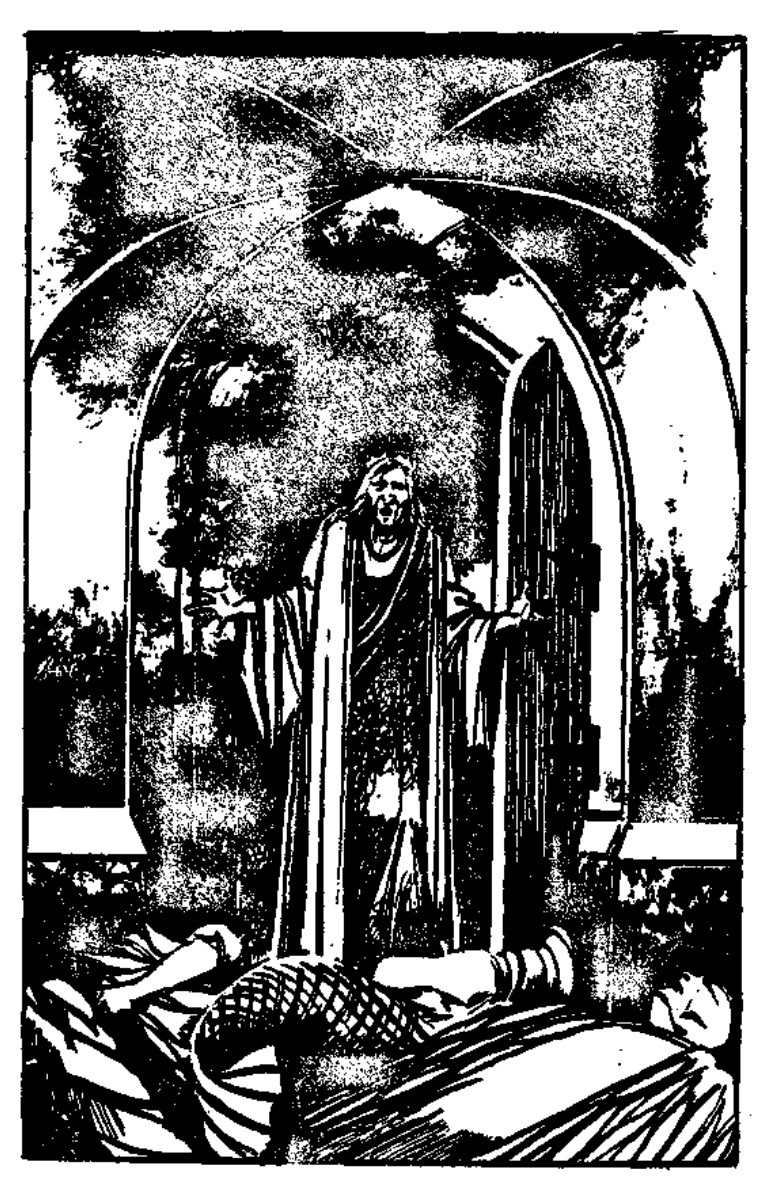
I wonder if there's any group of players that have gone through this campaign, survive all the bullshit thrown at them, and not put down the zombie king as soon as they see him.
Once the zombies are down, the party may open the last door, leading towards Balor's frozen body . It's trapped in the ice and reeks of sulphur. There are five fires around his trunk surrounded by pentacles, and Fengil moves from one to another with a burning ember: the Hearth Fire! Fengil will attack once he sees the party, but if things get too dicey he'll use Shadow Self and flee the scene. The party can put out the fires and thus ruin the ritual: whatever ice the Hearth Fire has managed to melt will quickly recover, and Balor will stop breathing once more.
The party can now return safely to Glissom. If Kilnded is still not dead, the evidence they have now is enough for immediate execution. If Doron (the prince, remember him?) is still alive, he'll take over the kingdom and reward the PCs lavishly. Otherwise, the grateful elders will offer the throne to the party's MVP. It's suggested that they have no random encounters on the way home, though GMs may want to extend the adventure and roll for them.

And that's it!
Next: Book 6, The Lands of Legend!
Just imagine the Chrono Trigger theme for the next few updates
Original SA post Dragon Warriors: Book 6Just imagine the Chrono Trigger theme for the next few updates
Just in case you didn't play Chrono Trigger.
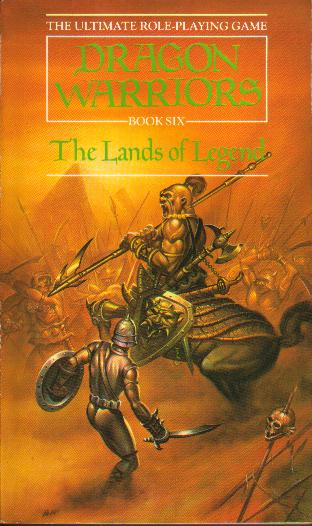
Aw fuck it's the centaurs
The sixth and final book of the original Dragon Warriors run is titled The Lands of Legend. As the introduction tells us, every role-playing campaign needs a setting, as without a fantasy world as backdrop for their escapades, players lose nine tenths of their roleplaying experience. Gadzooks! So as to make GM's lives easier, here is this book. Of course, no single book can go far towards describing every detail of a fantasy world, so it's up to the GM to fine-tune the campaign to the group's style. Perhaps the players will roleplay brave Crusaders marching south against the pagan hordes? Or brave Ta'ashim warriors defending civilization against the northern barbarians? Perhaps they will want to be involved with skulduggery in Ferromaine, or the power struggles of the Tamorian Senate. Or maybe they want to go off map, to the theocracy of Batubatan, the majestic land of Minj, the bureaucratic, timeless empire of Khitai, or war-torn Yamato where the haiken swordmasters follow their honor even if it leads them to ritual suicide! Maybe the campaign will take a turn for the antique, set in the days of the Selentine Empire or ancient Kaikuhuru - or even move forward to the Age of Discovery, as musket and rapier replace bow and sword, class divisions crumble and ships open a new world in the western ocean! The point is that the campaign is there for the GM to make it their own, and they shouldn't feel constrained by the book.
We'll see what those names mean later on but I imagine you can make out what most of them are standing in for. Yes, Legend is pretty much Fantasy Medieval Europe. But more than that, it is a world of ADVENTURE. I'll be upfront about this: I honestly and unironically love Legend and the way Dave Morris writes about it. After all these years it might sound generic, even quaint to modern audiences but goddamn, if I'm gonna be full rose-tinted goggles grog about something it might be about this.
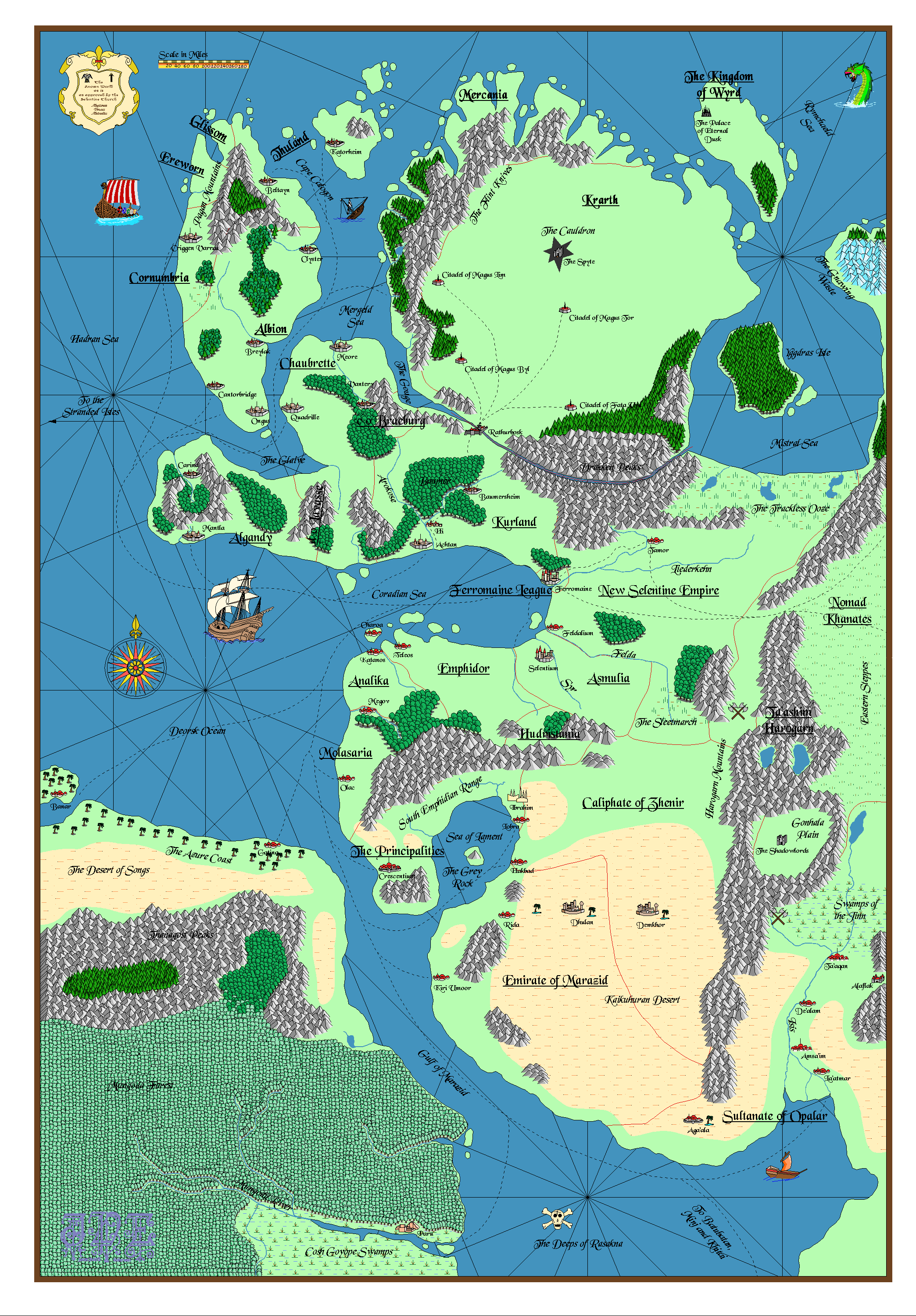
Yes, not from the book, but it's pretty~
The lands we've explored so far are part of a small section of the world, Ellesland. The island comprises five different nations. Cornumbria is one of the nations where the original Elleslander natives predominate, along with Ereworn. In the days of the Selentine Empire, the legions broke the natives, and when they returned to defend their dying homeland the Elleslanders became prey to attacks from the mainland, only to be finally driven back here. Authority here is centered on the chieftains and thanes that rule the land from their hill-forts. They elect a High King at an assembly, and may even strip him of his rank if they so decide. Cornumbria is converted to the True Faith, but perhaps harkening back to old traditions of wild, solitary priesthood, the Church of Cornumbria opted to be decentralized and monastic. The monks live in inaccessible, uncomfortable places, and priests of neighboring nations look on them with suspicion as the Cornumbrians are effectively independent from the Selentine Church.
quote:
Though the occasional accusations of black magic or even devil worship are surely unfounded!
Albion is a nation we have explored quite a bit already - it's where our friends Barons Aldred, Montombre and others live. The people of Albion descend from mainlanders from the region of Chaubrette, who used to worship the same gods as the Thulanders but are now converts to the True Faith. Albion is a feudal, rich place, with lots of trade going on south and west, but the King Hadric in Ongus is weak and a poor judge of character. With him surrounded by self-serving sycophants, loyal servants have had their lands stripped, unworthy sorts have been ennobled, and peasants have suffered hard taxation. Moreover, the merchant class is on the rise, and there are cities like Port Clyster that are free of any lord's influence. Barons like Aldred and Montombre in the north do not care about the King's power, and turn to their own petty squabbles.
Thuland is north of Albion, a high, craggy nation split by deep valleys and cold lakes. The people are settlers from across the Mergeld Sea, and they are warlike and fierce. The rugged geography prevents any real centralization of power: the King of Thuland rules his island of Katorheim, but the Thulan lords are effectively semi-autonomous. They sit the winters out in smoky mead-halls with their housecarls as wandering priests brave hostility and harsh weather in order to bring the True Faith to the people. Some of the lords have converted, and other still worship the gods of their ancestors: Wotan, Tor, Loge and others.
Ereworn should eat a tactical nuke to the face. I'm sorry, what was that? Yes, it is a lawless, evil place, full of brigands and robber knights. Most of them are native Elleslanders, with some Mercanian and Algandian blood. The gods worshiped here are the strange, shadowy deities of the old druids - Lahmfada, Kernanu, Morkaan. The True Faith discredited them as demons, of course, so to say the average Cornumbrian the northerners are devil worshipers, but strictly speaking the old gods are elemental and uncivilized, but not evil. Not that there aren't evil deities, like Rimfax from the Elven Crystals or Balor from the previous book. As we know, all the lords of Ereworn are either evil or insane, continuously fighting between themselves and against the neighboring nations. Assassination is such a common tool that there is an entire subculture catering to it: the Clan of Harbingers, that can basically be considered ninja. Yes, the game actually equates them to Japanese ninja. The countryside is bleak, peasants suffer all over the place and look, it's a shitty land.
Glissom is... well, it's already described in book 5, so this book skips it. Next!
Finally, the Stranded Isles west of Ellesland deserve a mention. They are permanently covered by mist, as the winds become completely still at the point where they are. There are all sorts of unreliable mariners' tales about them, of wild naked things dancing on the shores and seas like panes of blue glass. Surely drunk sailor stories!
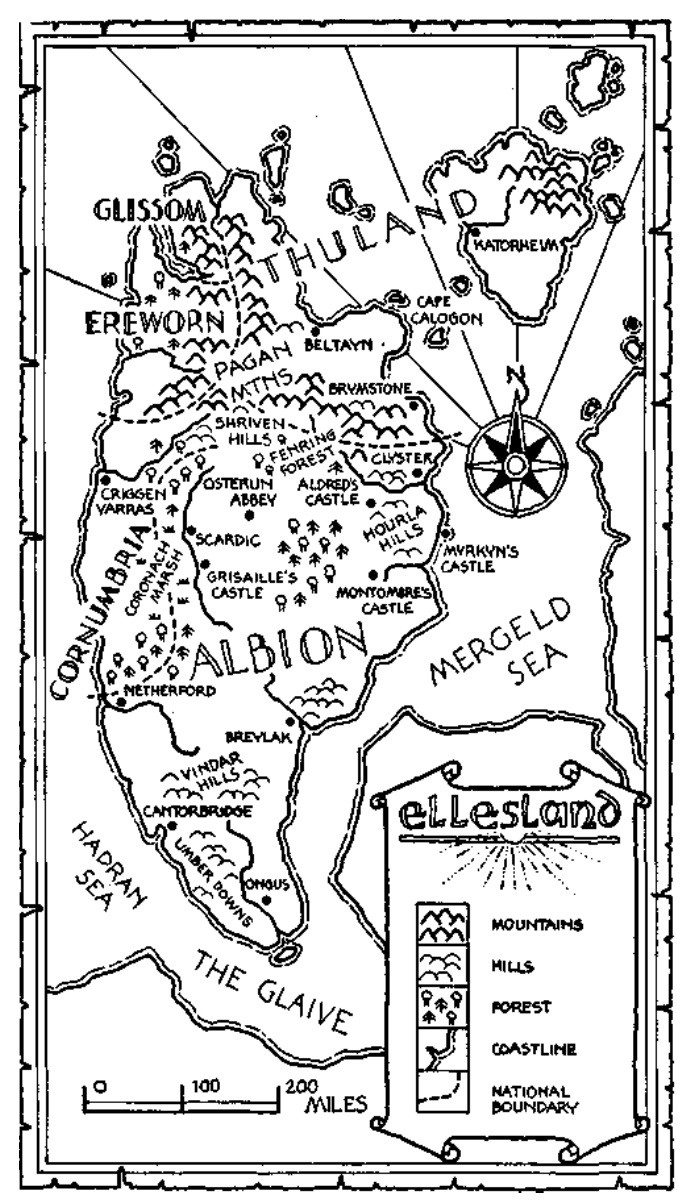
A closer look of Ellesland.
Next: that's a nice low-fantasy setting you have there, LET'S TURN IT UP TO ELEVEN.
Blasting soon, fellow Sorcerer
Original SA post Dragon Warriors: Book 6Blasting soon, fellow Sorcerer
Let's cross the
 The lands here are generally higher and more mountainous than Ellesland as well as more densely populated , and large tracts of forest have been cleared for farming. Even so, 10-30% of the countryside is wild forest, and it's entirely possible for a traveler to find ruins enclosed by woods barely a ride's day away from a town. In Algandy in particular the forests have ill repute, and there are times of the year when the moon raises luminous ground mist from the rotting leaves, and faerie sorcery drips from the boughs of old oaks...
The lands here are generally higher and more mountainous than Ellesland as well as more densely populated , and large tracts of forest have been cleared for farming. Even so, 10-30% of the countryside is wild forest, and it's entirely possible for a traveler to find ruins enclosed by woods barely a ride's day away from a town. In Algandy in particular the forests have ill repute, and there are times of the year when the moon raises luminous ground mist from the rotting leaves, and faerie sorcery drips from the boughs of old oaks...
Going east, we find The Gouge , a very deep rift valley that cleaves through the Drakken Peaks. This valley separates the land of Krarth from the rest of the continent, and no boat has ever navigated the length of the Gouge, but it can be crossed at a particularly narrow point by the Rathurbosk, which is a city-sized bridge.
Read that again. It's a city-sized bridge. With a city on top of it.
Rathurbosk was built by the magi of Spyte (later) to facilitate trade between Krarth and the mainland, and there are elaborate laws to entice merchants to come here. Travelers to Krarth first reach the township on the south side of the Gorge, which trade with the bridge dwellers and offer their daughters in marriage
 . The bridge only opens from dawn until dusk, so you'll have to wait in the township if you arrive by night. Once the gates are open, visitors sign in their name (or have it signed for them, most likely) at the gatebook, check their weapons and enter the sprawling bridge city, housing such wonders as the Central Tower, supported by flying buttresses and containing a timekeeping device - the only mechanical clock in all of Legend, in fact. Visitors are normally directed to the Flynt Ridd tavern, a tall building across the plaza that is filled by a perpetual haze of smoke: not just from the hearth, mind you, but from all the people smoking
tahac
, an evil-smelling Krarthian narcotic weed.
. The bridge only opens from dawn until dusk, so you'll have to wait in the township if you arrive by night. Once the gates are open, visitors sign in their name (or have it signed for them, most likely) at the gatebook, check their weapons and enter the sprawling bridge city, housing such wonders as the Central Tower, supported by flying buttresses and containing a timekeeping device - the only mechanical clock in all of Legend, in fact. Visitors are normally directed to the Flynt Ridd tavern, a tall building across the plaza that is filled by a perpetual haze of smoke: not just from the hearth, mind you, but from all the people smoking
tahac
, an evil-smelling Krarthian narcotic weed.
The keepers of Rathurbosk are organized in a number of ancient clans, and the duul Guidor clan is the most important, handling administrative and security duties. Since the Blasting of Spyte most of these clans have become slightly inbred and kind of mad. Along with the tahac addiction, it explains why the people of Rathurbosk seem to be colorful (if you're feeling generous) or of dubious sanity (if otherwise). Word has it that the great-grandfather of the current Collector, head of the duul Guidors, once allowed an outlaw to cross the bridge in exchange for the most outrageous lie he could invent, then he charged 1 gold piece for each of the soldiers sent to pursue him!
What about Krarth , you ask? Well, great heroes seeking treasure or magic power might come here. Few others would have any reason to do so. Krarth is a desolate expanse of tundra, bleak marshland in summer and icy wastes in winter. People live miserable, cheerless lives, feeding themselves on stringy plants and eels and warming themselves with sputtering peat fires. There are things on the wastes best left unmentioned, too. All Krarth can offer in trade is timber (and lots of it), furs and slaves, and merchants in any case do not venture beyond Rathurbosk. In the old days, Krarth was ruled by magus-lords that derived their power from the demonic gods they worshiped. They gathered every ten years in the eldritch fortress of Spyte to commune with their gods and renew their sorcerous energies, but at the last convocation two centuries ago, something went wrong. Beyond the sealed gates of the city, the servants heard non-human voices raised in anger and screams, as strange lights danced in the walls. Some servants fled for their lives as lightning streamed up into the sky from the towers of Spyte, others merely retreated some miles away. Days of silence passed, then the ground began to crack, and a moat of flame opened around the fortress. There was no way to cross, and none of the masters ever returned.
The apprentices or heirs to the various magi took over, but they're no match for their forebears. The ancient demonic energies are long gone, and the current lords pore over the dusty grimoires and chant the old words to no avail. By the original masters' standards, these are mere dabblers, no more competent than any common sorcerer, and some not even that. Some of the remaining magi are: the Magus Byl , Aytarn, who is a young and inexperienced sorcerer. He assumed the title after his father's disappearance into the tundra, but he's fat and lazy. The Byl manuscripts are rich with potent spells, and one of their line even managed to chain the
As for Spyte itself, it's still there. Many adventurers have journeyed to the Cauldron (the chasm around the ruins) through the wastes, an arduous trek where hunger, beasts, disease and the elements take their toll. Then there's the issue of actually crossing the Cauldron, and reaching Spyte itself... but no one has ever returned from that.
Recapping: in this low-fantasy game world, there is a land that is Magical STALKER Zone, ruled by dickass magi, and whose only link to civilization is a city-sized bridge full of 420 BLAZE IT dudebros.
See why I love this setting?
Krarth also had some vassal states in the old days. One, the Kingdom of Wyrd, has been independent from the magi's authority since the Blasting of Spyte. The Witch-King of Wyrd refuses to acknowledge the 'pretenders' and continues to rule from his Palace of Eternal Dusk, as he has done so for the last five centuries. Nature bends to his will within the borders of his land and peasants live in fear of him, as he can send nightmares to any of his subjects for no raisin. There is an elaborate caste system at work in Wyrd, with three main castes holding sway: the Armigers , the hereditary warrior caste; the Solons , administrators; and the Seers , who wander the land freely and act as mediators with the common folk. The ancient gods of Krarth are worshiped here, and no missionary of the True Faith may bring it to the people as long as the Witch-King rules. Another vassal land is Yggdras Isle , where the people are famed for their overweening arrogance in the face of adversity. They pay the magi a yearly tribute of gold and iron. Ancient ruins stand here, reminders of an earlier, prouder culture, but the locals do not live in them. Legend has it that the great Tree of Life is somewhere in the island. Eating of its fruit would grand the wisdom and mystic insight of a god! The legend also says that the last one to do so was none other than Wotan himself, Father of the Heavens, and he would probably not readily permit others to reach it.

Next: Vikings, senators and delicious tadpole men.